Tapwave 001 Zodiac Bluetooth Handheld PDA User Manual Tapwave Zodiac User Guide
Tapwave, Inc. Zodiac Bluetooth Handheld PDA Tapwave Zodiac User Guide
Tapwave >
User Manual

Using Your Zodiac™
Handheld

Copyright
Copyright © 2003, Tapwave, Inc. All rights reserved. Portions copyright © 1996 - 2003, PalmSource, Inc. and its affiliates. All rights reserved.
This documentation may be printed and copied solely for use in using the Zodiac handheld. In addition, two (2) copies of this documen-
tation may be made for archival and backup purposes. Except for the foregoing, no part of this documentation may be reproduced or
transmitted in any form or by any means or used to make any derivative work (such as translation, transformation or adaptation) without
express written consent from Tapwave, Inc. and PalmSource, Inc.
Tapwave, Inc.reserves the right to revise this documentation and to make changes in content from time to time without obligation on the
part of Tapwave, Inc. to provide notification of such revision or changes.
TAPWAVE, INC. AND ITS SUPPLIERS MAKE NO REPRESENTATIONS OR WARRANTIES THAT THE DOCUMENTATION IS FREE OF ERRORS OR
THAT THE DOCUMENTATION IS SUITABLE FOR YOUR USE. THE DOCUMENTATION IS PROVIDED ON AN “AS IS” BASIS. TAPWAVE, INC. AND
ITS SUPPLIERS MAKE NO WARRANTIES, TERMS OR CONDITIONS, EXPRESS OR IMPLIED, EITHER IN FACT OR BY OPERATION OF LAW, STAT-
UTORY OR OTHERWISE, INCLUDING WARRANTIES, TERMS, OR CONDITIONS OF MERCHANTABILITY, FITNESS FOR A PARTICULAR PURPOSE,
AND SATISFACTORY QUALITY. TO THE FULL EXTENT ALLOWED BY LAW, TAPWAVE, INC. ALSO EXCLUDES FOR ITSELF AND ITS SUPPLIERS
ANY LIABILITY, WHETHER BASED IN CONTRACT OR TORT (INCLUDING NEGLIGENCE), FOR DIRECT, INCIDENTAL, CONSEQUENTIAL, INDI-
RECT, SPECIAL, OR PUNITIVE DAMAGES OF ANY KIND, OR FOR LOSS OF REVENUE OR PROFITS, LOSS OF BUSINESS, LOSS OF INFORMATION
OR DATA, OR OTHER FINANCIAL LOSS ARISING OUT OF OR IN CONNECTION WITH THIS DOCUMENTATION, EVEN IF TAPWAVE, INC. OR ITS
SUPPLIERS HAVE BEEN ADVISED OF THE POSSIBILITY OF SUCH DAMAGES.
Tapwave, the stylized Tapwave logo, and Zodiac are trademarks of Tapwave, Inc. in the United States and/or other countries. Palm OS,
Graffiti, HotSync, and PalmSource are registered trademarks of PalmSource, Inc. or its affiliates. Palm, the Palm logo, the HotSync logo,
Palm Powered, the Palm trade dress, are trademarks of PalmSource, Inc. or its affiliates. All other product and brand names may be trade-
marks or registered trademarks of their respective owners.
IF THIS DOCUMENTATION IS PROVIDED ON A COMPACT DISC, THE OTHER SOFTWARE AND
DOCUMENTATION ON THE COMPACT DISC ARE SUBJECT TO THE LICENSE AGREEMENT AC-
COMPANYING THE COMPACT DISC.
MPEG Layer-3 audio decoding technology is licensed from Fraunhofer IIS and Thomson Licensing S.A.
P/N:

Using Your Zodiac Handheld 3
Table of Contents
About This Guide 10
1 Introduction to your Zodiac Handheld 11
System requirements . . . . . . . . . . . . . . . . . . . . . . 11
Connecting the cable or cradle . . . . . . . . . . . . . . . . . . 12
Charging the battery. . . . . . . . . . . . . . . . . . . . . . . 13
Charging tips . . . . . . . . . . . . . . . . . . . . . . . . . 14
Battery life . . . . . . . . . . . . . . . . . . . . . . . . . . 14
Starting your handheld for the first time . . . . . . . . . . . . . 15
Palm Desktop software . . . . . . . . . . . . . . . . . . . . . 15
Installing Palm Desktop software . . . . . . . . . . . . . . . 16
Using your handheld with another desktop organizer . . . . . 17
Zodiac components . . . . . . . . . . . . . . . . . . . . . . . 17
About the front panel . . . . . . . . . . . . . . . . . . . . . 17
About the back panel . . . . . . . . . . . . . . . . . . . . . 19
Removing the stylus . . . . . . . . . . . . . . . . . . . . . 20
Connecting the headphones . . . . . . . . . . . . . . . . . 20
Adjusting the screen orientation . . . . . . . . . . . . . . . 21
Adjusting the speaker volume and screen brightness . . . . . 21
Opening applications . . . . . . . . . . . . . . . . . . . . . . 22
Learning to navigate . . . . . . . . . . . . . . . . . . . . . . . 23
Status Bar. . . . . . . . . . . . . . . . . . . . . . . . . . . 24
Input Area . . . . . . . . . . . . . . . . . . . . . . . . . . 25
Entering data . . . . . . . . . . . . . . . . . . . . . . . . . 26
Navigation controls . . . . . . . . . . . . . . . . . . . . . . 27
Menus . . . . . . . . . . . . . . . . . . . . . . . . . . . . 27
Command toolbar . . . . . . . . . . . . . . . . . . . . . . 28
Tips. . . . . . . . . . . . . . . . . . . . . . . . . . . . . . 29

Using Your Zodiac Handheld 4
2 Entering Data in Your Zodiac Handheld 30
Entering data using Graffiti 2 handwriting software . . . . . . . . 30
Learning to write Graffiti 2 characters . . . . . . . . . . . . . 30
General Guidelines for Graffiti 2 Writing . . . . . . . . . . . . 31
Graffiti 2 tips . . . . . . . . . . . . . . . . . . . . . . . . . 32
The Graffiti 2 alphabet . . . . . . . . . . . . . . . . . . . . 33
Writing punctuation marks and other special characters . . . . 34
Using Graffiti 2 Gestures . . . . . . . . . . . . . . . . . . . . . 36
Using Graffiti 2 ShortCuts . . . . . . . . . . . . . . . . . . . . 36
Using the onscreen keyboard . . . . . . . . . . . . . . . . . . 37
Using your computer keyboard . . . . . . . . . . . . . . . . . 38
Using an external keyboard . . . . . . . . . . . . . . . . . . . 39
Importing data . . . . . . . . . . . . . . . . . . . . . . . . . 39
3 Managing Applications 41
Using the Home screen . . . . . . . . . . . . . . . . . . . . . 41
Customizing the Home screen display . . . . . . . . . . . . . . 43
Arranging icons on the radial menus. . . . . . . . . . . . . . 43
Organizing applications . . . . . . . . . . . . . . . . . . . . 43
Setting Home screen preferences . . . . . . . . . . . . . . . 45
Viewing information on an application . . . . . . . . . . . . . . 46
Installing add-on applications . . . . . . . . . . . . . . . . . . 47
Removing add-on applications . . . . . . . . . . . . . . . . . . 48
Removing Palm Desktop software . . . . . . . . . . . . . . . . 49
4 Using Music 50
Opening Music . . . . . . . . . . . . . . . . . . . . . . . . . 50
Deleting songs . . . . . . . . . . . . . . . . . . . . . . . . . 52
Conserving power while playing songs . . . . . . . . . . . . . . 53
5 Using Photos 54
Opening Photos . . . . . . . . . . . . . . . . . . . . . . . . . 54
Setting the slide show interval . . . . . . . . . . . . . . . . . . 56
Deleting pictures . . . . . . . . . . . . . . . . . . . . . . . . 57
Copying pictures . . . . . . . . . . . . . . . . . . . . . . . . 57

Using Your Zodiac Handheld 5
6 Playing Games 59
Playing multi-player games . . . . . . . . . . . . . . . . . . . 60
7 Using Clock 61
Opening Clock. . . . . . . . . . . . . . . . . . . . . . . . . . 61
8 Performing Common Tasks 64
Creating records . . . . . . . . . . . . . . . . . . . . . . . . . 64
Editing records . . . . . . . . . . . . . . . . . . . . . . . . . 65
Selecting Text. . . . . . . . . . . . . . . . . . . . . . . . . 65
Using the Edit menu . . . . . . . . . . . . . . . . . . . . . 65
Deleting records . . . . . . . . . . . . . . . . . . . . . . . . . 66
Purging records . . . . . . . . . . . . . . . . . . . . . . . . . 67
Categorizing records. . . . . . . . . . . . . . . . . . . . . . . 67
Moving a record into a category . . . . . . . . . . . . . . . . 68
Displaying a category of records. . . . . . . . . . . . . . . . 68
Adding or editing categories . . . . . . . . . . . . . . . . . 69
Finding records . . . . . . . . . . . . . . . . . . . . . . . . . 70
Finding Address Book records . . . . . . . . . . . . . . . . . 70
Using the Find dialog box . . . . . . . . . . . . . . . . . . . 71
Using Phone Lookup . . . . . . . . . . . . . . . . . . . . . 71
Sorting records . . . . . . . . . . . . . . . . . . . . . . . . . 72
Sorting To Do List records . . . . . . . . . . . . . . . . . . . 72
Sorting Address Book and Memo Pad records . . . . . . . . . 73
Making records private. . . . . . . . . . . . . . . . . . . . . . 74
Hiding private records. . . . . . . . . . . . . . . . . . . . . 74
Displaying private records. . . . . . . . . . . . . . . . . . . 75
Attaching notes . . . . . . . . . . . . . . . . . . . . . . . . . 75
Deleting a note . . . . . . . . . . . . . . . . . . . . . . . . 76
Choosing fonts . . . . . . . . . . . . . . . . . . . . . . . . . 77
9 Using Address Book 78
Opening Address Book. . . . . . . . . . . . . . . . . . . . . . 78
Adding and using Address Book entries . . . . . . . . . . . . . 79
Creating an Address Book entry . . . . . . . . . . . . . . . . 79
Viewing an address entry . . . . . . . . . . . . . . . . . . . . 81

Using Your Zodiac Handheld 6
Duplicating an entry . . . . . . . . . . . . . . . . . . . . . . . 81
Selecting different types of phone numbers and addresses . . . . 81
Editing Address Book entries . . . . . . . . . . . . . . . . . . . 82
Changing Address Book display . . . . . . . . . . . . . . . . . 83
Adding custom fields at the end of Address Edit screens . . . . . 83
10 Using Date Book 85
Opening Date Book . . . . . . . . . . . . . . . . . . . . . . . 85
Scheduling events . . . . . . . . . . . . . . . . . . . . . . . . 86
Scheduling timed events for the current date . . . . . . . . . 87
Scheduling a timed event for another date. . . . . . . . . . . 89
Scheduling untimed events . . . . . . . . . . . . . . . . . . 89
Adding Address Book information to an event . . . . . . . . . 90
Rescheduling events . . . . . . . . . . . . . . . . . . . . . 90
Scheduling repeating or continuous events . . . . . . . . . . 91
Changing repeating or continuous events . . . . . . . . . . . 91
Setting the alarm . . . . . . . . . . . . . . . . . . . . . . . . 93
Setting an alarm for an event . . . . . . . . . . . . . . . . . 93
Snoozing the alarm . . . . . . . . . . . . . . . . . . . . . . 94
Setting alarm options . . . . . . . . . . . . . . . . . . . . . 95
Changing the Date Book view . . . . . . . . . . . . . . . . . . 96
Working in Week view. . . . . . . . . . . . . . . . . . . . . 96
Working in Month view . . . . . . . . . . . . . . . . . . . . 98
Working in Agenda view . . . . . . . . . . . . . . . . . . . 99
Spotting event conflicts . . . . . . . . . . . . . . . . . . . . .100
Changing the Date Book display . . . . . . . . . . . . . . . . .100
Changing the displayed Start and End Times. . . . . . . . . .101
11 Using Memo Pad 103
Opening Memo Pad . . . . . . . . . . . . . . . . . . . . . . .103
Creating memos . . . . . . . . . . . . . . . . . . . . . . . . .104
Reviewing memos . . . . . . . . . . . . . . . . . . . . . . . .105
Arranging the Memo List. . . . . . . . . . . . . . . . . . . . .105

Using Your Zodiac Handheld 7
12 Using To Do List 106
Opening To Do List . . . . . . . . . . . . . . . . . . . . . . .106
Creating To Do List items. . . . . . . . . . . . . . . . . . . . .107
Setting To Do List priorities. . . . . . . . . . . . . . . . . . . .108
Checking off To Do List items. . . . . . . . . . . . . . . . . . .109
Changing priorities and due dates . . . . . . . . . . . . . . . .110
Sorting To Do items . . . . . . . . . . . . . . . . . . . . . . .111
Setting To Do List preferences . . . . . . . . . . . . . . . . . .111
13 Using Calculator 113
Opening Calculator . . . . . . . . . . . . . . . . . . . . . . .113
Using the Calculator buttons . . . . . . . . . . . . . . . . . . .114
Displaying recent calculations . . . . . . . . . . . . . . . . . .115
14 Setting Preferences 116
Opening the Preferences screens. . . . . . . . . . . . . . . . .116
Bluetooth . . . . . . . . . . . . . . . . . . . . . . . . . . . .117
Calibration . . . . . . . . . . . . . . . . . . . . . . . . . . .118
Connection . . . . . . . . . . . . . . . . . . . . . . . . . . .118
Date & Time . . . . . . . . . . . . . . . . . . . . . . . . . . .120
Formats . . . . . . . . . . . . . . . . . . . . . . . . . . . . .122
General . . . . . . . . . . . . . . . . . . . . . . . . . . . . .123
Graffiti 2 . . . . . . . . . . . . . . . . . . . . . . . . . . . . .124
Network . . . . . . . . . . . . . . . . . . . . . . . . . . . . .124
Network Details. . . . . . . . . . . . . . . . . . . . . . . .127
Login scripts . . . . . . . . . . . . . . . . . . . . . . . . .128
Connecting to your ISP or dial-in service . . . . . . . . . . . .131
Owner. . . . . . . . . . . . . . . . . . . . . . . . . . . . . .131
Phone . . . . . . . . . . . . . . . . . . . . . . . . . . . . . .132
ShortCut . . . . . . . . . . . . . . . . . . . . . . . . . . . .133
Sound . . . . . . . . . . . . . . . . . . . . . . . . . . . . . .134
15 Synchronizing Data 136
Performing a cable or cradle HotSync operation . . . . . . . . .136
Selecting HotSync setup options . . . . . . . . . . . . . . . . .138
Customizing HotSync application settings . . . . . . . . . . . . 139

Using Your Zodiac Handheld 8
IR HotSync operations . . . . . . . . . . . . . . . . . . . . . 141
Preparing your computer for infrared communication. . . . . 141
Configuring HotSync Manager for infrared communication . . 143
Performing an IR HotSync operation . . . . . . . . . . . . . 143
Returning to using the cradle for HotSync operations . . . . . 144
Creating a user profile . . . . . . . . . . . . . . . . . . . . . 144
Using a profile for the first-time HotSync operation . . . . . . 145
16 Security 146
Masking and hiding records. . . . . . . . . . . . . . . . . . . 147
Masking private records . . . . . . . . . . . . . . . . . . . 147
Hiding private records . . . . . . . . . . . . . . . . . . . . 147
Assigning and editing passwords . . . . . . . . . . . . . . . . 148
Locking your handheld . . . . . . . . . . . . . . . . . . . . . 149
Turning on and unlocking your handheld. . . . . . . . . . . 150
Recovering from a forgotten password . . . . . . . . . . . . 150
Deleting a forgotten password . . . . . . . . . . . . . . . . 150
17 Using the Attention Manager 151
Insistent alarms . . . . . . . . . . . . . . . . . . . . . . . . . 151
Using the Reminder dialog screen . . . . . . . . . . . . . . 151
Setting alarm sound effects . . . . . . . . . . . . . . . . . 152
Using the Reminders list screen . . . . . . . . . . . . . . . 153
Subtle alarms . . . . . . . . . . . . . . . . . . . . . . . . . . 154
Understanding the blinking alarm indicator . . . . . . . . . 154
18 Using Expansion Cards 155
Inserting and removing an expansion card . . . . . . . . . . . 156
Accessing applications on an expansion card . . . . . . . . . . 156
Displaying information about applications on an expansion card. 157
Copying an application from an expansion card . . . . . . . . . 158
Beaming or sending applications from an expansion card . . . . 159
Deleting applications from an expansion card . . . . . . . . . . 160
Using CardInfo . . . . . . . . . . . . . . . . . . . . . . . . . 161
Renaming an expansion card. . . . . . . . . . . . . . . . . 162
Reformatting an expansion card . . . . . . . . . . . . . . . 162

Using Your Zodiac Handheld 9
19 Beaming and Sending Information 163
Creating a business card . . . . . . . . . . . . . . . . . . . . .164
Beaming a record . . . . . . . . . . . . . . . . . . . . . . . .164
Beaming an application . . . . . . . . . . . . . . . . . . . . .165
Receiving beamed information. . . . . . . . . . . . . . . . . .165
Sending information with Bluetooth communication . . . . . . .166
20 Maintaining Your Handheld 167
Upgrade information . . . . . . . . . . . . . . . . . . . . . .167
Upgrading your Palm Desktop software . . . . . . . . . . . .168
Maintaining a unique name for each handheld. . . . . . . . .168
Caring for your Zodiac . . . . . . . . . . . . . . . . . . . . . .169
21 Frequently Asked Questions 170
Resetting your handheld . . . . . . . . . . . . . . . . . . . . .170
Performing a soft reset . . . . . . . . . . . . . . . . . . . .170
Performing a hard reset . . . . . . . . . . . . . . . . . . . .171
Installing add-on software . . . . . . . . . . . . . . . . . . . .171
Troubleshooting TCP/IP connections . . . . . . . . . . . . . . .171
22 Regulatory Information 173
Federal Communication Commission Interference Statement . . .173
Important Note: FCC Radiation Exposure Statement . . . . . . . 173
Index 174

Using Your Zodiac Handheld 10
About This Guide
Welcome to Using Your Zodiac™ Handheld. This guide is designed to help you
get up and running quickly on your handheld. It describes all you need to
know about how to use your Zodiac handheld and the applications that come
with it.
This guide shows you how to:
•Identify all the parts of your handheld
•View and enter data
•Use the applications that come with your handheld
•Use your handheld with your computer
•Personalize your handheld with your own preference settings
After you become familiar with the basic functionality of your Zodiac
handheld, you can use this guide as a reference for less common tasks, for
maintaining your Zodiac handheld, and as a source of information if you have
problems operating it. For additional information visit tapwave.com.
Some of the applications that come with your Zodiac handheld are
documented separately. If you do not find information about a particular
application in this guide, look for the . pdf file in the folder for that application
on the CD that came with your Zodiac handheld or visit tapwave.com.

Using Your Zodiac Handheld 11
1
Introduction to your
Zodiac Handheld
Your Zodiac handheld combines a full mobile entertainment experience --
including music, photos, movies, and interactive video games -- with the best
organizer tools available.
Using HotSync® technology you can add media to your handheld as well as
synchronize (exchange, update, and backup) your personal data.
Your Zodiac handheld gives you everything you need to go, do, and play.
System requirements
To install and operate Palm Desktop software your computer system must
meet the following minimum requirements:
•Windows 98 SE/2000 (with service pack 3)/me/XP Home/XP Pro (with
administrator rights)
•IBM-compatible Pentium computer or higher
•40 MB available hard disk space
•CD-ROM drive
•One available USB port
In addition, the following equipment is required for optional connectivity
features:
•Internet service provider (ISP)
•Compatible mobile phone
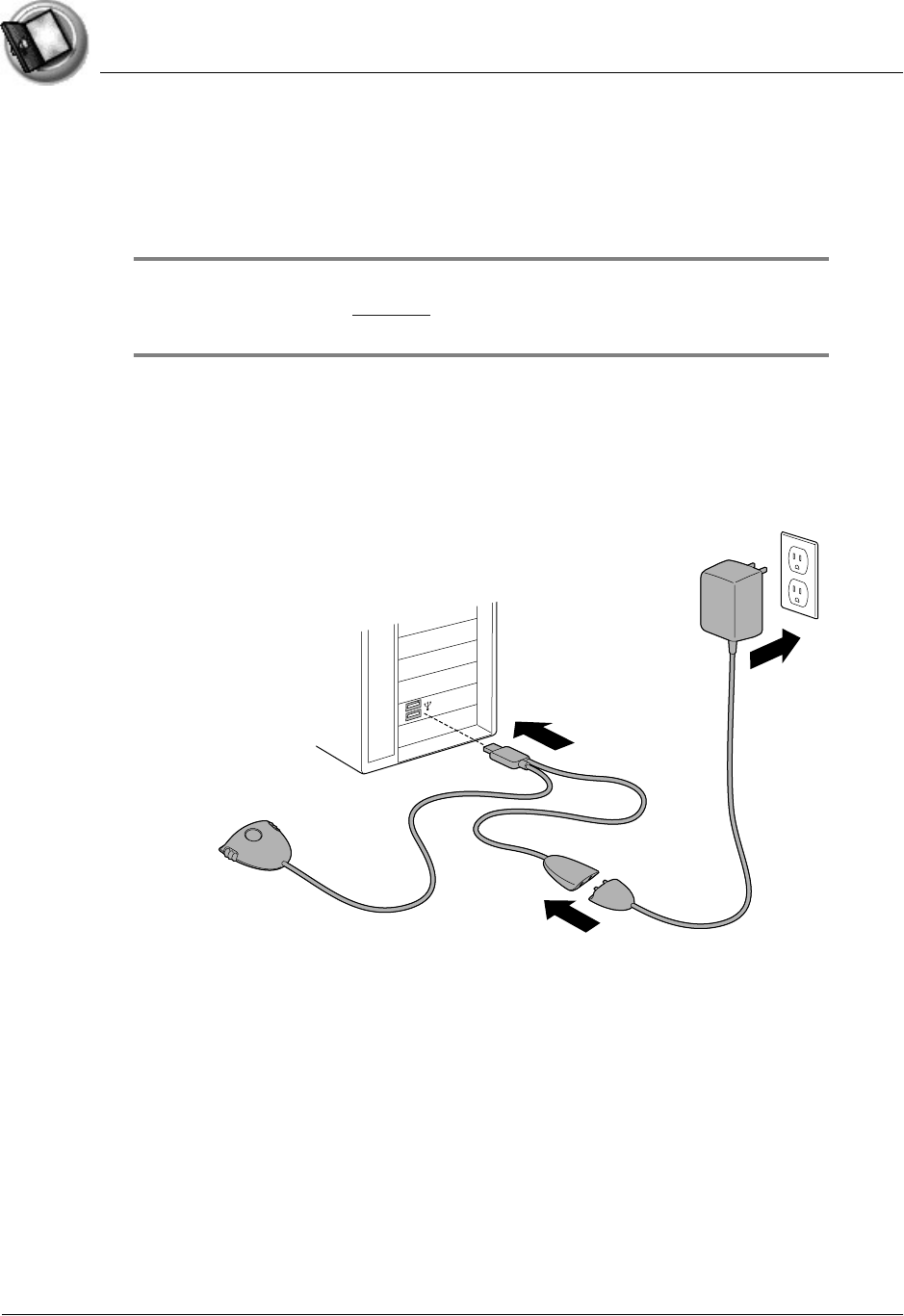
Introduction to your Zodiac Handheld
Connecting the cable or cradle
Using Your Zodiac Handheld 12
Connecting the cable or cradle
The HotSync cable or cradle that comes with your Zodiac handheld enables
you to synchronize the information on your handheld with your computer.
IMPORTANT: If you are upgrading from another Palm Powered™ handheld,
follow the instructions on page 167 before connecting the cradle and installing the
Palm Desktop software.
1. Turn off your computer.
2. Plug the HotSync cable or cradle into a USB port on your computer.
3. Plug the power adapter into a power outlet.
4. Connect the power adapter cable and the HotSync cable.
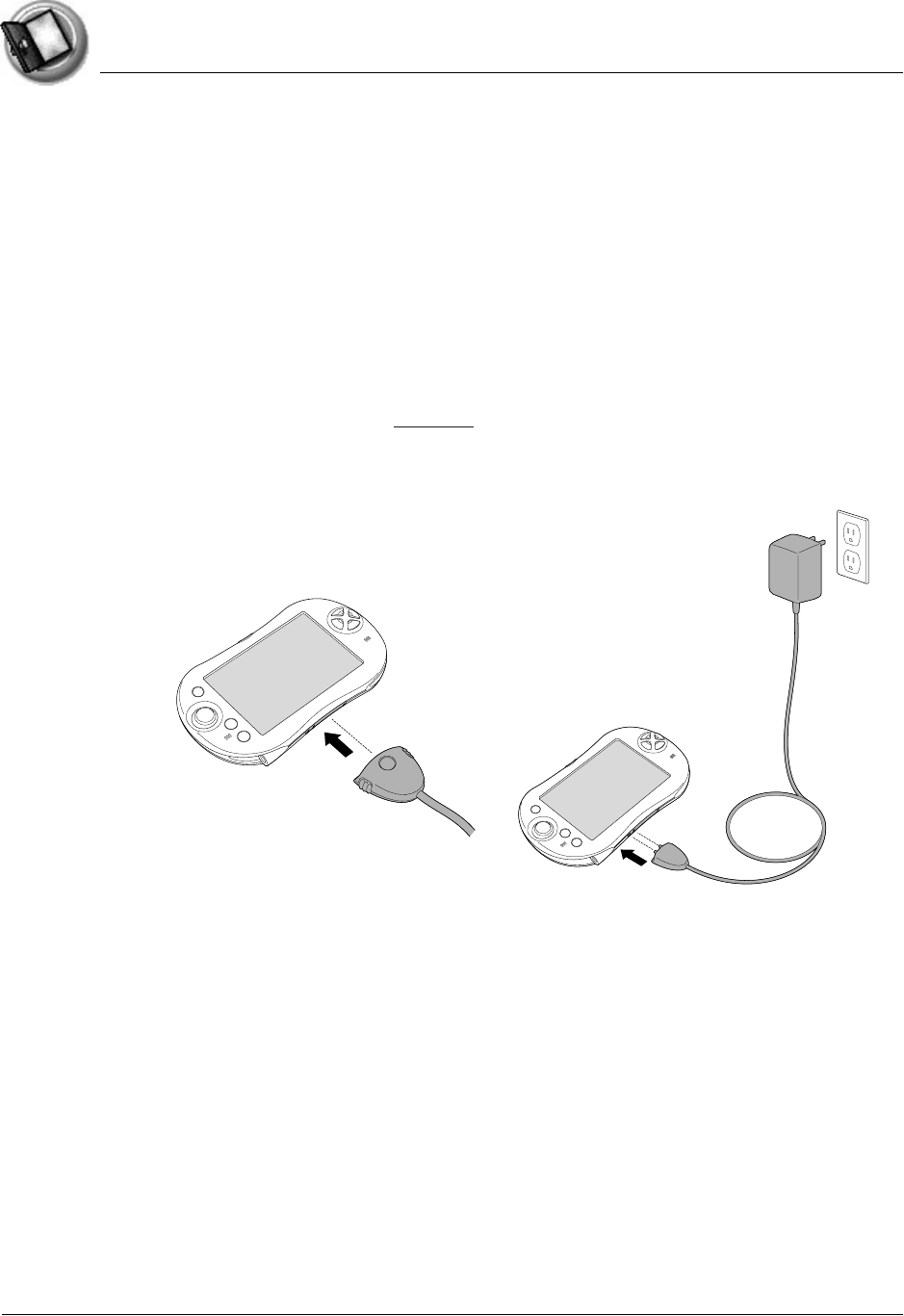
Introduction to your Zodiac Handheld
Charging the battery
Using Your Zodiac Handheld 13
Charging the battery
To use your Zodiac handheld, you must connect it to an AC outlet and charge
the battery.
1. Connect your handheld to an AC outlet using one of these three setups:
•Desktop Setup. Connect the optional HotSync cradle (sold separately)
to the HotSync cable, your computer, and an outlet as described in the
cradle instructions, and then insert your handheld in the cradle.
•Travel Setup. Connect the HotSync cable to your computer and an
outlet as described on page 12, and then connect your handheld to
the HotSync cable.
•Ultra-light Setup. Connect the power adapter cable to your handheld.
2. Wait approximately 2 hours for the battery to fully charge.
While your handheld charges, the LED repeatedly increases in brightness.
When your handheld is fully charged, the LED turns green.
When your handheld needs to be recharged, the LED blinks and turns yellow.
When the LED turns red, your battery is extremely low.
Travel Setup Ultra-light Setup

Introduction to your Zodiac Handheld
Charging the battery
Using Your Zodiac Handheld 14
Charging tips
•Although you can turn your handheld on while it is charging, your
handheld charges more quickly while it is turned off.
•The battery has a built-in sensor to prevent it from overheating. This
also means that it stops charging if the environment is too warm.
– Keep in mind that operating your handheld while charging the
battery generates heat.
– We do not recommend charging your handheld in environments
that are over 86 degrees Farenheit.
– If you must charge your handheld in temperatures above 91
degrees Farenheit, do not turn it on while it is charging.
Battery life
Extend the life of your battery by following these guidelines:
•Use the lowest brightness setting you find comfortable (see page 21).
•Turn off your handheld as soon as you finish using it. Do not wait for
the auto timeout to turn it off.
•Keep the Auto-off after setting in General Preferences set to 30
seconds in case you forget to turn off your handheld.
•Use the headphones when listening to music and videos and keep the
volume low. Playing them loudly through the internal speakers will
significantly reduce battery life. Playing them loudly through the
headphones can permanently damage your hearing.
•Turn off Bluetooth when you’re not using it.
•Turn off the Beam Receive setting in General Preferences when you’re
not using the IR port to receive information from another device.

Introduction to your Zodiac Handheld
Starting your handheld for the first time
Using Your Zodiac Handheld 15
Starting your handheld for the first time
The first time you start your Zodiac handheld, setup instructions appear on
the screen. These instructions guide you through calibrating the touch-screen
(also called the digitizer) and the analog controller.
1. Press the power button .
2. Follow the onscreen instructions, tapping the screen and moving the
analog controller where indicated.
Palm Desktop software
Palm Desktop software includes many of the same applications as your
Zodiac handheld: Photos, Music, Address Book, Date Book, To Do List, and
Memo Pad. You can use the HotSync feature of this software to load,
exchange, and backup files between your handheld and your computer.
It’s a good idea to back up your files in case something happens to the data on
your Zodiac handheld. Changes you make on your Zodiac handheld or Palm
Desktop software appear in both places after you synchronize.
Using the Palm Desktop software, you can do the following:
•Work with your Zodiac handheld applications on your computer to
view, enter, and modify files stored on your handheld.
•Back up the files stored on your handheld with HotSync technology
and synchronize the files in your Palm Desktop software.
Synchronization is a one-step procedure that ensures your data is
always safe and up-to-date. See page 136 for more information.
•Load compatible files and applications onto your handheld from your
computer.
•Import and export data, so you can easily transfer data from other
desktop applications into selected applications. See page 39 for more
information.
•Print your Date Book, Address Book, To Do List, and Memo Pad
information on any printer.
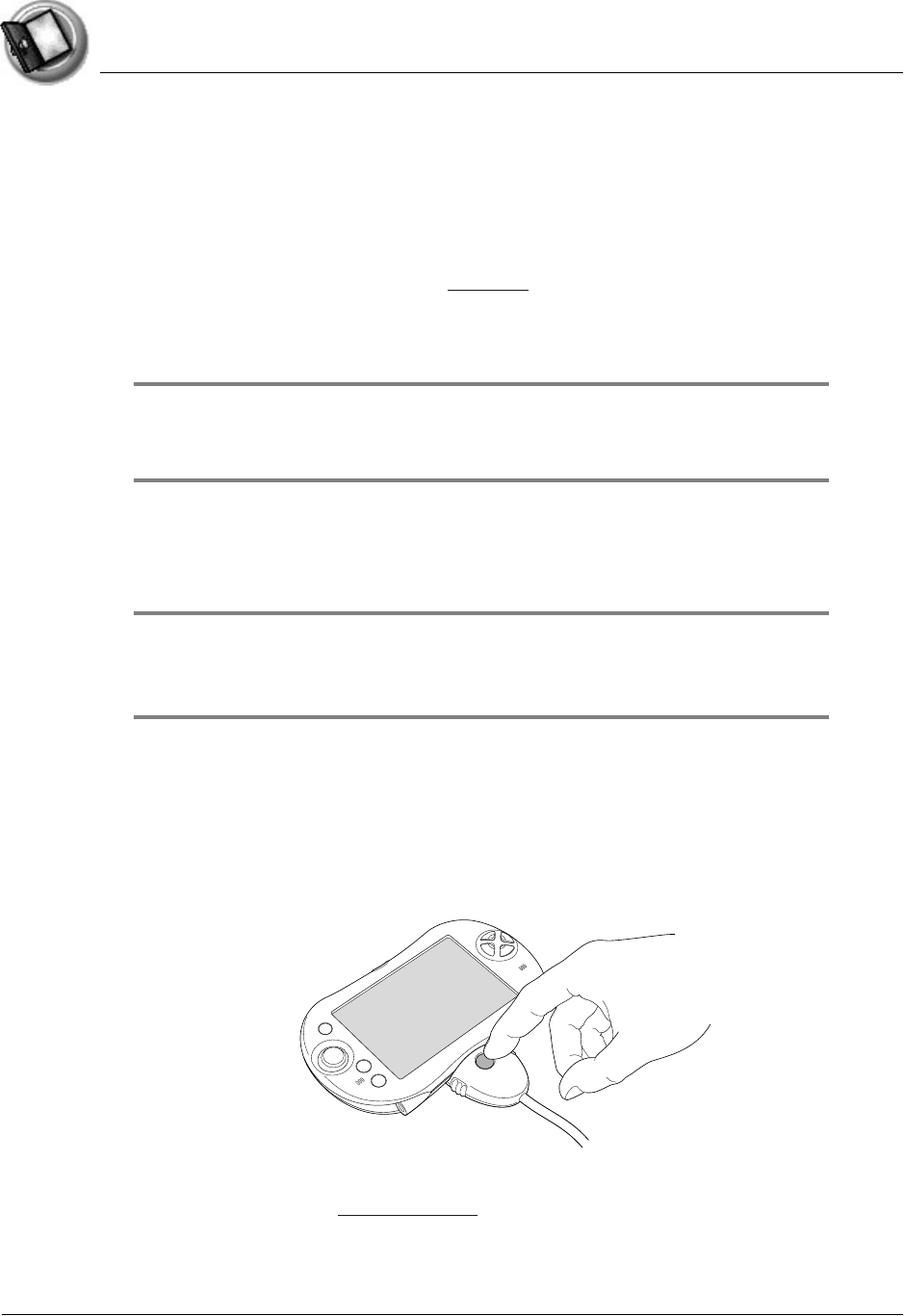
Introduction to your Zodiac Handheld
Palm Desktop software
Using Your Zodiac Handheld 16
Installing Palm Desktop software
The following instructions guide you through installing Palm Desktop
software so that you can transfer data from your computer to your handheld.
Before you begin, make sure you connected the HotSync cable or cradle to
your computer as described on page 12.
After installation, refer to the online Help in Palm Desktop software for
information on how to use the software.
IMPORTANT: Do not copy the Palm Desktop software files to your computer’s
hard disk. You must use the installer to place the files in their proper locations and
to decompress the files.
1. Exit any open programs, including those that run at startup (such as
Microsoft Office), and disable any virus-scanning software.
2. Insert the Palm Desktop software CD into the computer’s CD-ROM drive.
NOTE: If the installation does not begin automatically, click the Windows Start button,
choose Run, enter D:\autorun.exe, and then click OK. If necessary, replace D: with the
drive letter assigned to your CD-ROM drive.
3. Follow the onscreen instructions to complete the installation. When
prompted, complete the following steps:
a. Install Palm Desktop software.
b. Select or create a user name.
c. Connect your handheld to the cable or cradle and synchronize.
d. Select free Bonus Software applications for installation.
e. Create your FREE tapwave.com account.
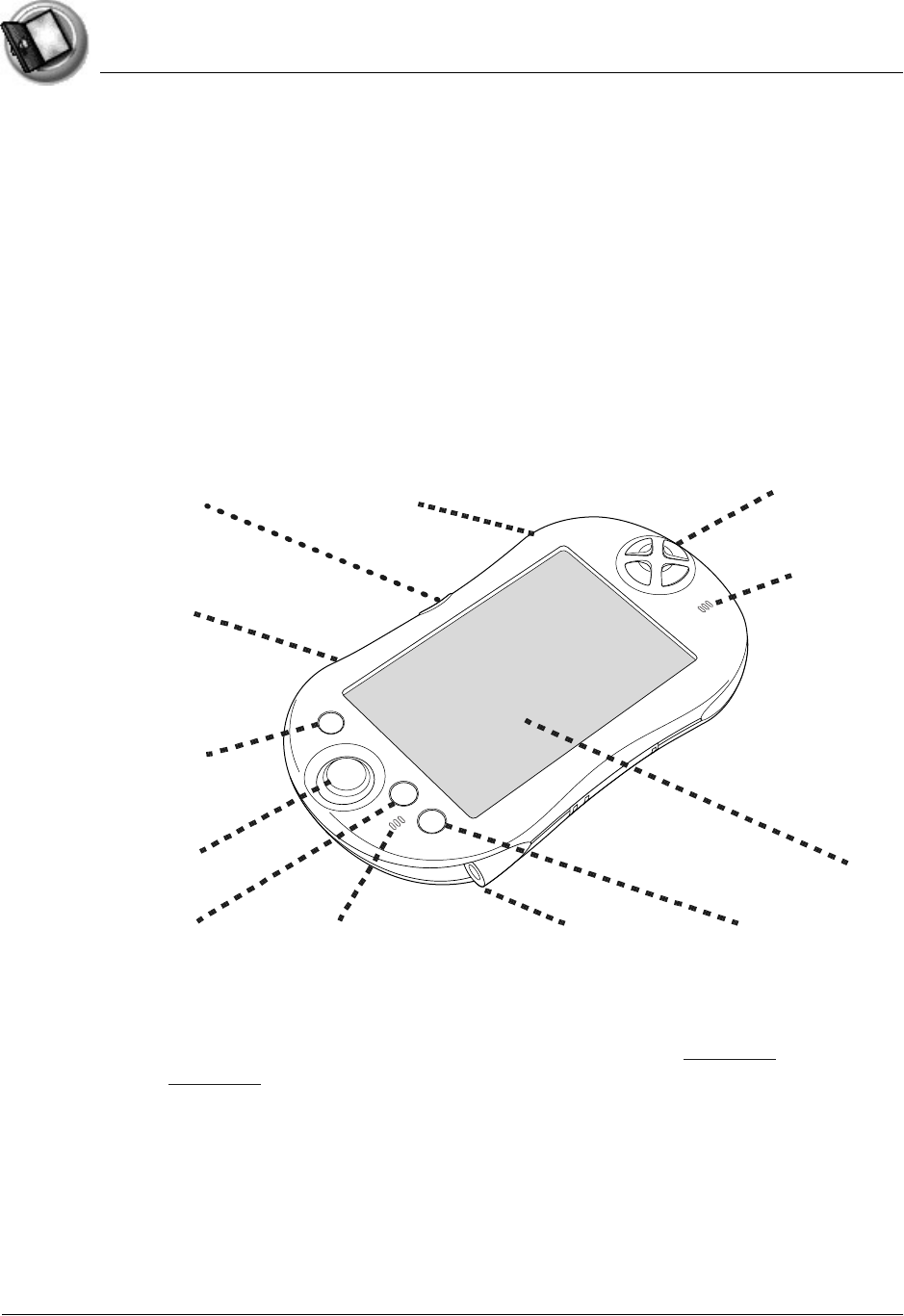
Introduction to your Zodiac Handheld
Zodiac components
Using Your Zodiac Handheld 17
Using your handheld with another desktop organizer
If you prefer to use another desktop organizer, such as Microsoft Outlook, you
can use it instead of installing Palm Desktop software. All you need to install
are HotSync Manager and the connection software (sold separately) for your
desktop organizer, called a conduit, that lets you synchronize the data
between your handheld and your desktop organizer.
Zodiac components
About the front panel
•Bluetooth button. Activates the built-in Bluetooth radio so that your
Zodiac handheld can communicate with other devices that are
enabled with Bluetooth technology. For details, see page 117 and
page 166.
•Trigger buttons. Performs various actions based on the application.
Handheld screen
A
nalog controller
Function button Home button
Action buttons
Power button
Bluetooth button
Left trigger
Right trigger
Left speaker
Right speaker
Headphone jack

Introduction to your Zodiac Handheld
Zodiac components
Using Your Zodiac Handheld 18
•Power button. Turns the handheld on (if it is off) and returns to the
last screen that was displayed. Press the power button again to turn
the handheld off.
Pressing and holding the power button opens the dialog box where
you can adjust the sound volume and screen brightness. For details,
see page 21.
The power button also includes an LED that changes color based on
the status of the battery.
–Green. Appears when your handheld is connected to the cable or
cradle and it is fully charged.
–Yellow. Appears when your handheld is charging.
–Red. Appears when your handheld battery is critically low and
needs to be charged.
•Analog controller. Allows you to navigate through the Home screen
and move around within applications. Move it in the direction you
want to go, or press it when centered to select an item. For details, see
page 23.
•Function button. Performs various actions based on the application.
For example, in Date Book you can press this button to change the
calendar display format.
•Left/Right speakers. Enables you to listen to music and game sounds
without using the headphones.
•Headphone jack. Enables you to connect headphones to your
handheld so you can discreetly listen to music and game sounds.
•Home button. Opens the Home screen where you can select a game
or application that you want to start. For details, see page 41.
•Handheld screen. Displays the applications and data stored in your
handheld. It is touch-sensitive and responds to the stylus.
•Action buttons. Activates various functions based on the application.
For example, in a game, these buttons might be used for acceleration,
braking, stunts, or weapons, but in the Home screen, these buttons are
shortcuts to your favorite games or applications. See page 45 for
details on the Enable Quick Launch option to assign your favorite
shortcuts to these buttons.
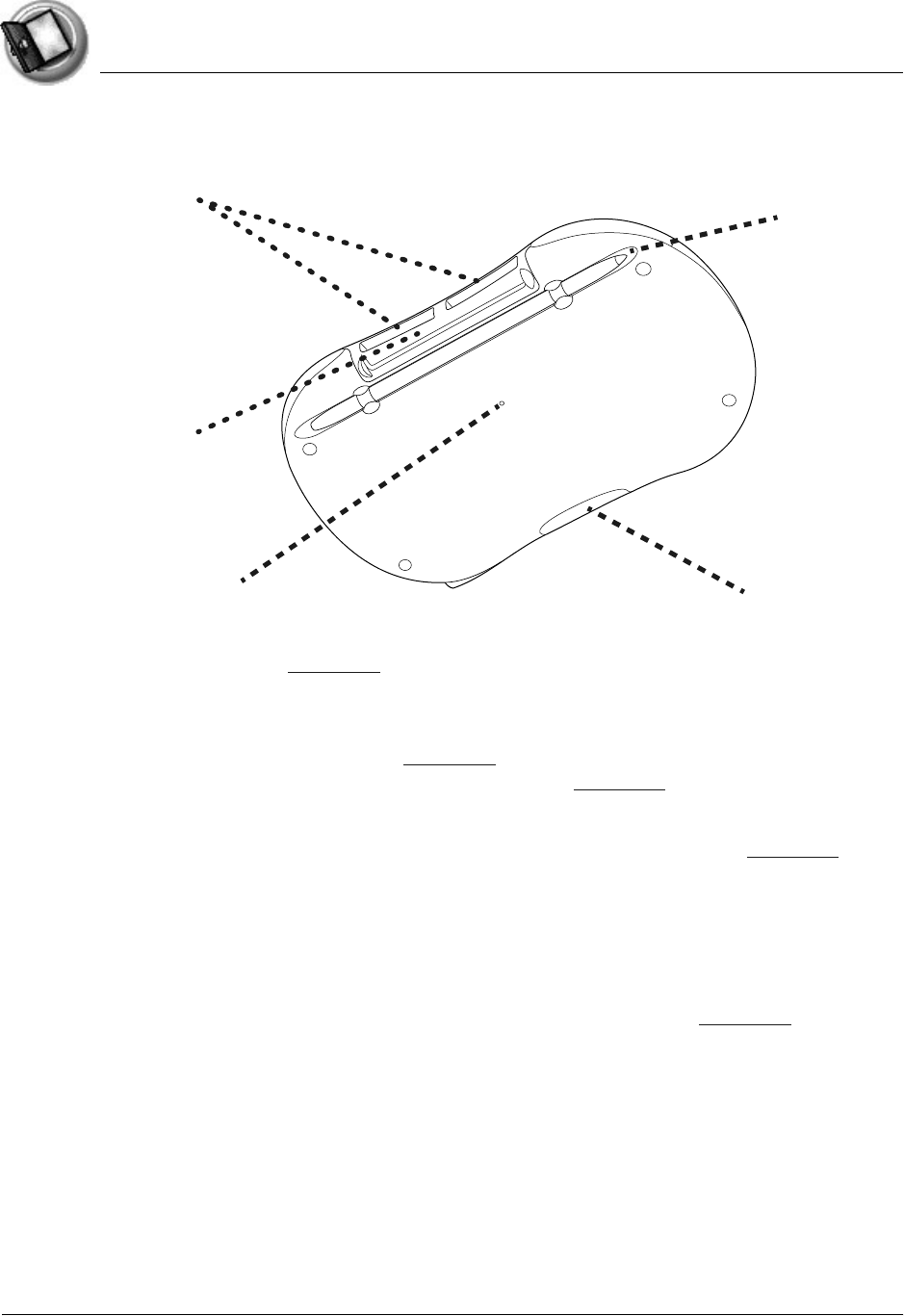
Introduction to your Zodiac Handheld
Zodiac components
Using Your Zodiac Handheld 19
About the back panel
•Reset button. Under normal use, you should not have to use the reset
button. See page 170 for information on when and how to use the
reset button.
•IR port. Uses infrared technology to transmit data to and receive data
from other devices, see page 163 for details. You can also use the IR
port to perform HotSync operations, see page 141 for details.
•Expansion slots. Enables you to expand your handheld’s storage
capacity and capabilities by inserting expansion cards. See page 155 to
learn more about using expansion cards.
•HotSync connector. Connects your handheld to the cable or cradle,
which in turn connects to your computer and the AC adapter. This
allows you to recharge your handheld and to synchronize the
information between your handheld and your computer using
HotSync technology. For more information, see page page 136.
•Stylus channel and stylus. Holds the stylus when you are not using it.
The stylus is the writing instrument you use to enter data on your
handheld.
IR port
Reset button HotSync connector
Stylus channel
and stylus
Expans
i
on s
l
ots
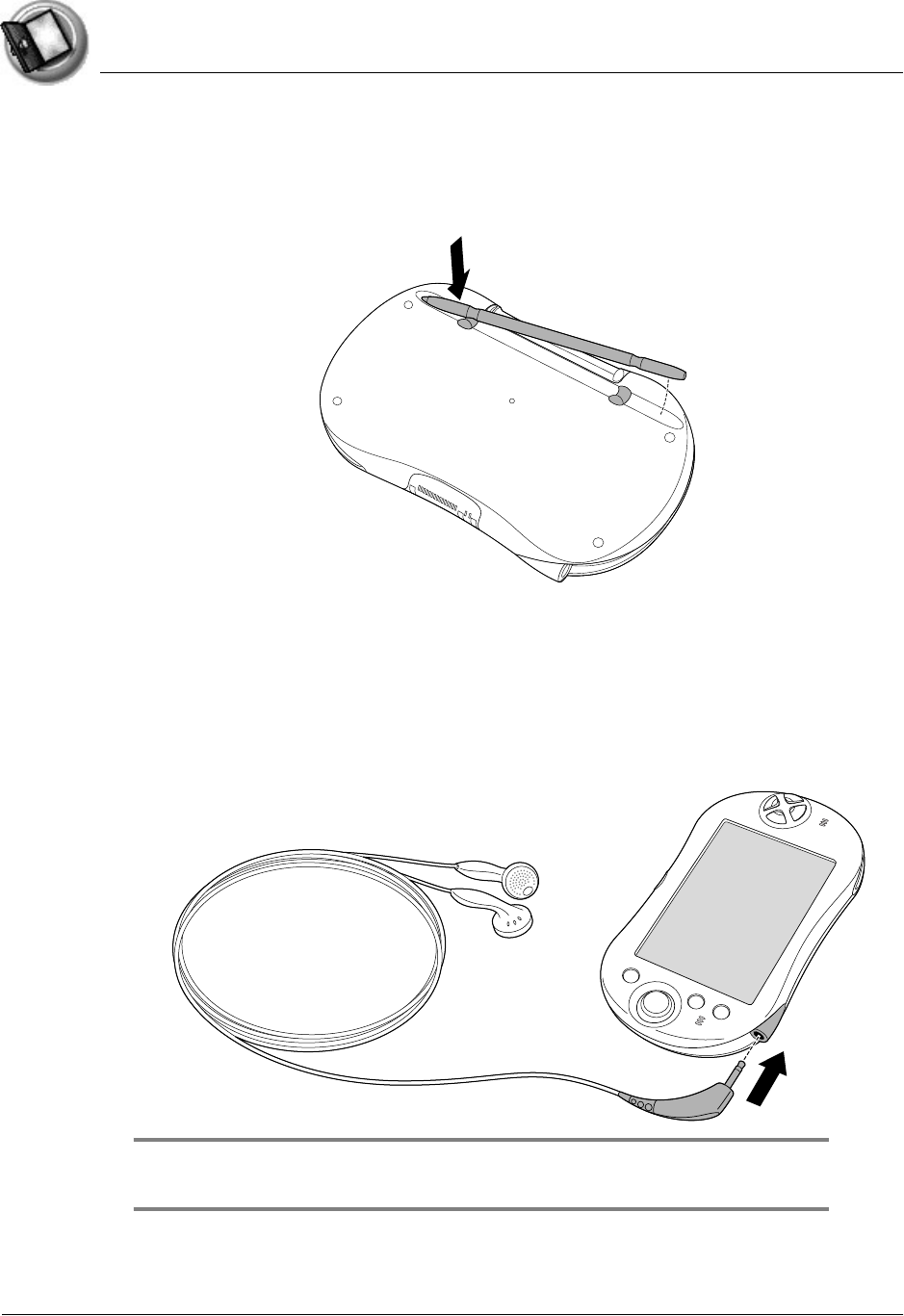
Introduction to your Zodiac Handheld
Zodiac components
Using Your Zodiac Handheld 20
Removing the stylus
To use the stylus, remove it from the channel and hold it as you would a pen
or pencil.
Connecting the headphones
Your Zodiac handheld includes a pair of stereo headphones that you can use
while listening to music, playing games, or watching video clips. Using
headphones or external speakers instead of the built-in speakers also
conserves battery power.
IMPORTANT: When using the headphones, keep the volume soft. Listening to
loud volumes through the headphones can permanently damage your hearing.
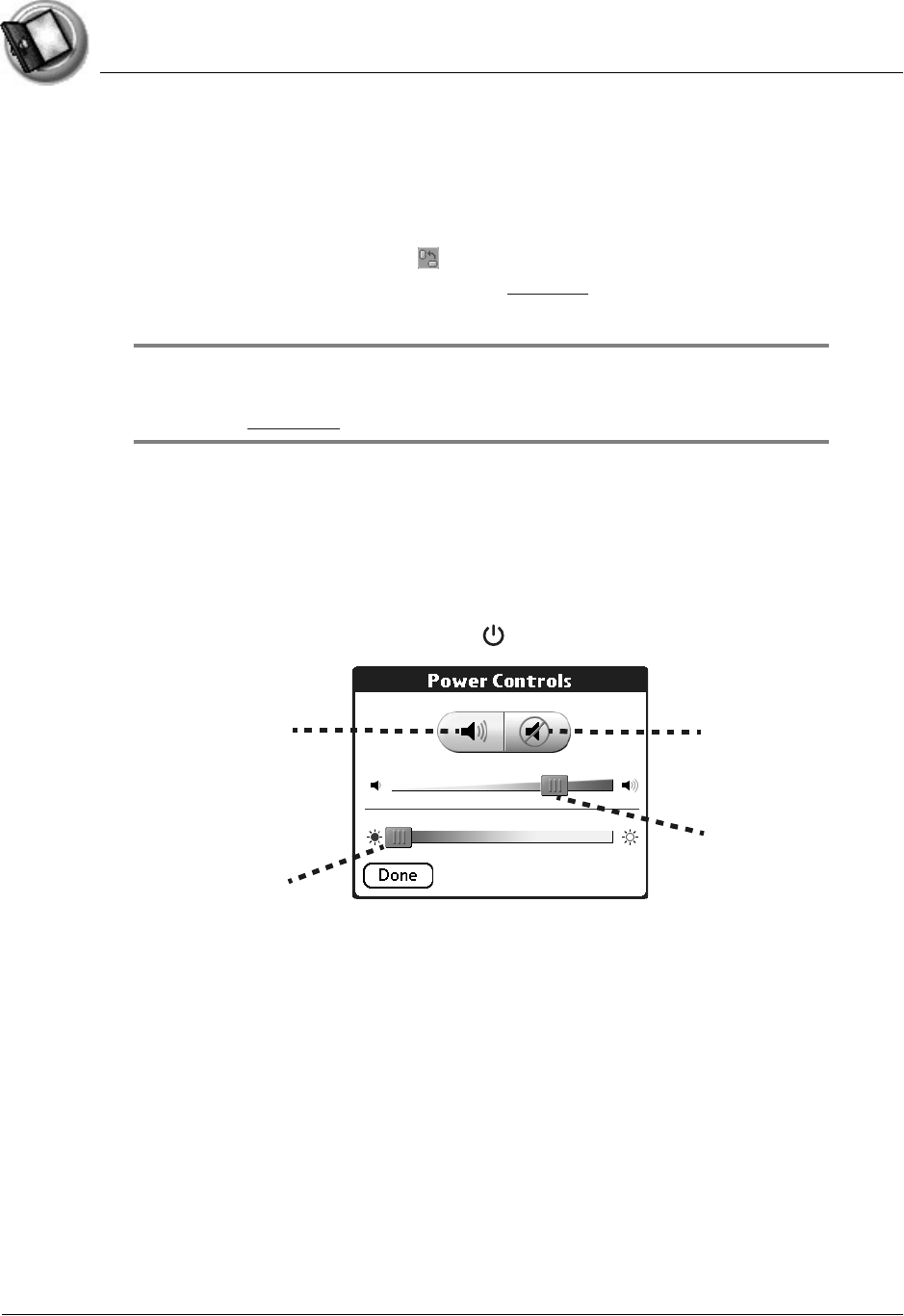
Introduction to your Zodiac Handheld
Zodiac components
Using Your Zodiac Handheld 21
Adjusting the screen orientation
In many applications you can change the orientation of your Zodiac display
by switching between portrait (vertical) and landscape (horizontal) mode.
•Tap the Orientation icon in the Status Bar to switch between
portrait and landscape mode. See page 24 to learn about the Status
Bar.
TIP: In landscape mode, you can also choose whether the Status Bar
and Input Area appear on the left or right side of the screen. For
details, see page 123.
Adjusting the speaker volume and screen brightness
You can quickly adjust the volume level or sound in your applications and the
brightness of your screen to make it easy to see in a variety of lighting
conditions.
1. Press and hold the power button .
2. Adjust the sound by doing one of the following:
•Tap the Sound icon and drag the slider to adjust the volume level.
•Tap the Mute icon and choose how long the sound remains off.
3. Adjust the brightness by doing one of the following:
•Drag the slider to adjust the brightness.
•Tap to the right or left of the slider to adjust the brightness in small
increments.
4. Tap Done.
Sound icon Mute icon
Brightness
slider
Sound
slider
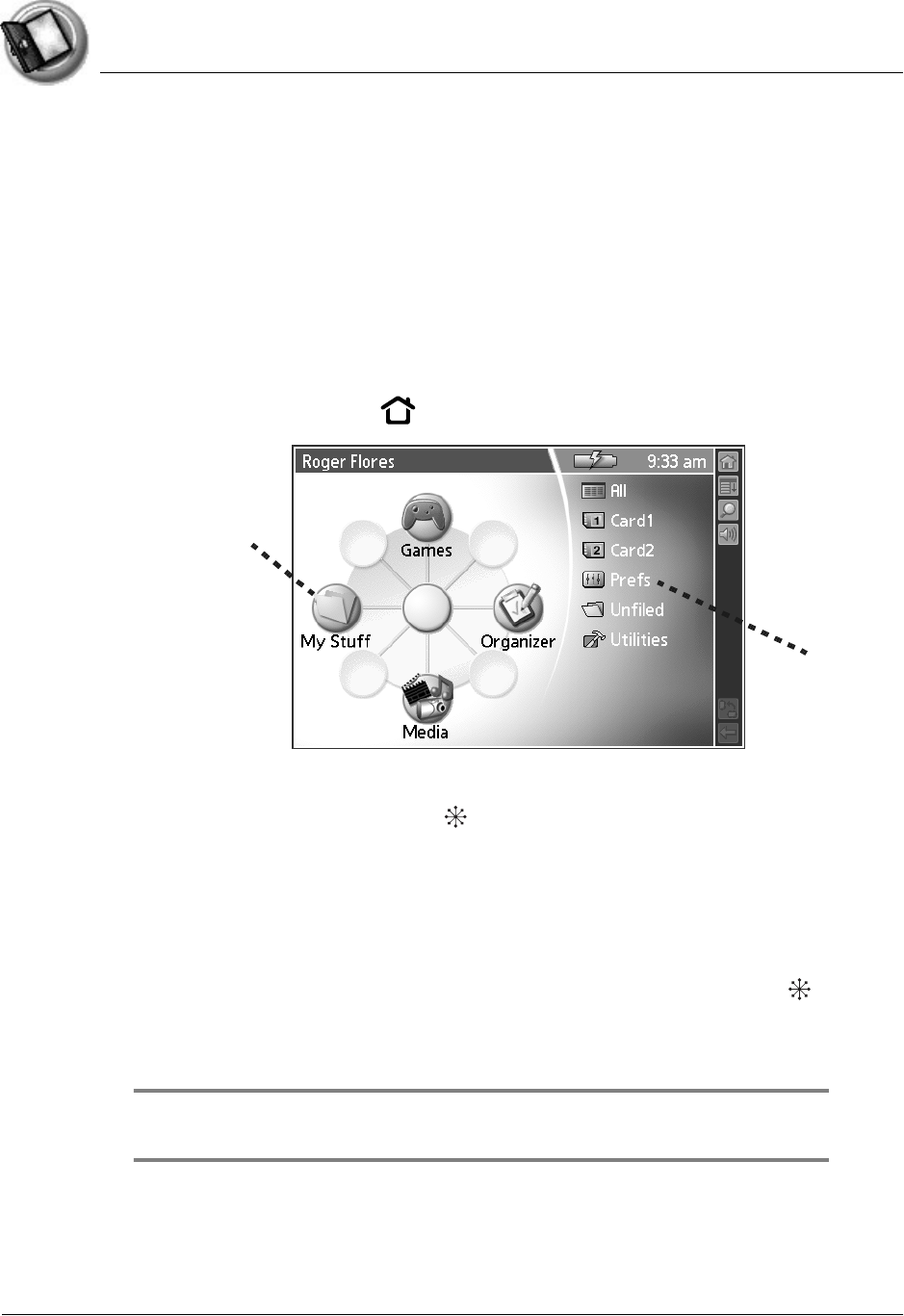
Introduction to your Zodiac Handheld
Opening applications
Using Your Zodiac Handheld 22
Opening applications
You can use the Home screen to open any application installed on your
handheld. The Home screen displays your user name, the current time, the
battery level, a radial menu of your favorite categories, and a list of remaining
categories.
You can choose which icons appear on the radial menu and which icons
appear on the list. If you have expansion cards inserted in the expansion slots,
each card appears as a category.
1. Press the Home button .
2. Open a category by doing one of the following:
•Move the analog controller in the direction that corresponds to the
category you want to open. The placement of the icon on the radial
menu corresponds to the directional controls on the analog controller.
After you highlight your selection, release the analog controller to
open the category.
•Press the Function button to move from the radial menu to the list, and
then scroll to a category on the list. With the analog controller
centered, press it to open the category.
•Tap a category icon on the screen.
TIP: To view a list of all your applications, select All from the category list on the
right side of the screen.
Radial menu
Menu list
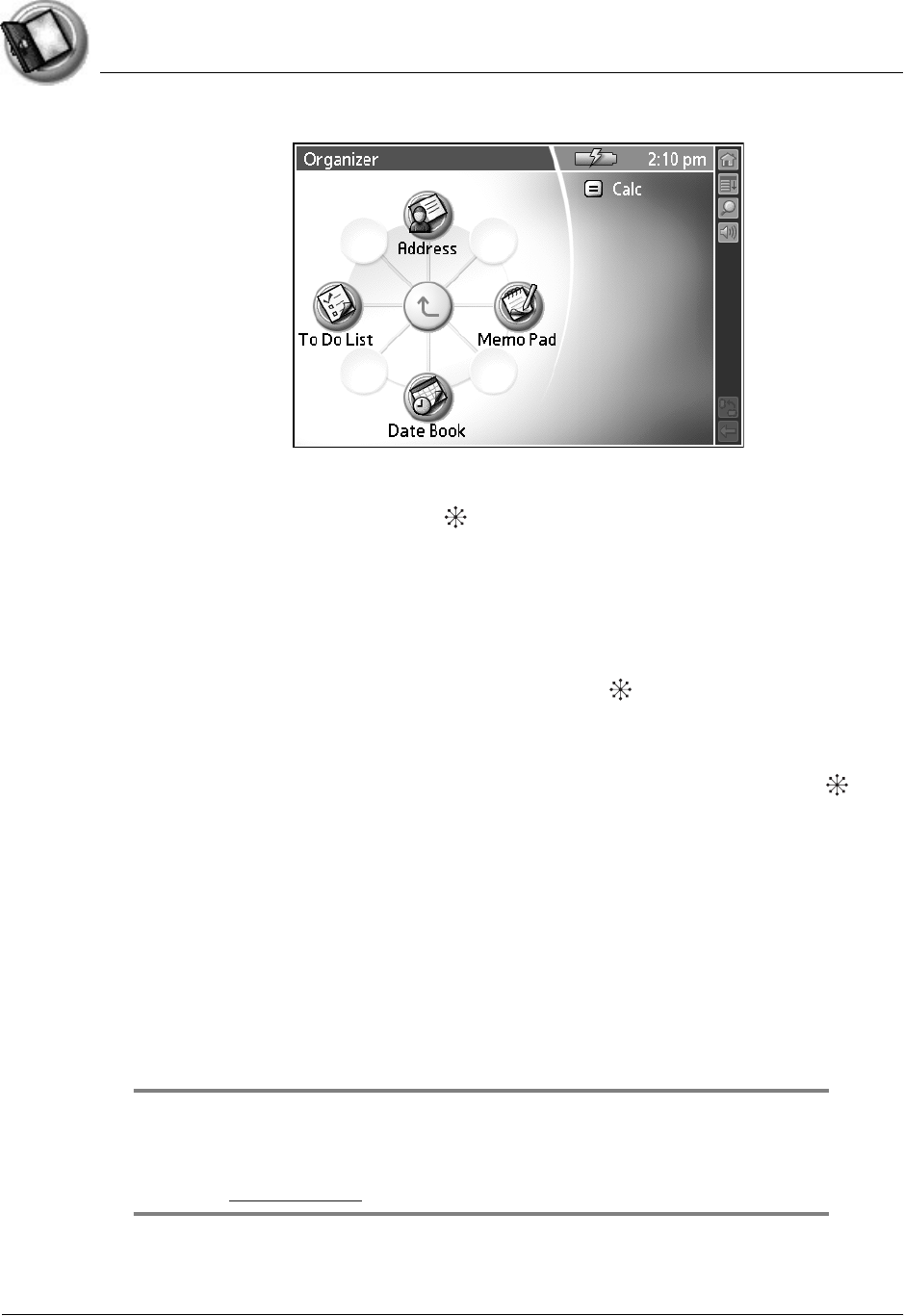
Introduction to your Zodiac Handheld
Learning to navigate
Using Your Zodiac Handheld 23
3. Open an application by doing one of the following:
•Move the analog controller in the direction that corresponds to the
application you want to open. The placement of the icon on the radial
menu corresponds to the directional controls on the analog controller.
After you highlight your selection, release the analog controller to
open the application.
•Scroll to an application icon in the All view list (if you already selected
the All category). With the analog controller centered, press it to
open the application.
•Press the Function button to move from the radial menu to the list, and
then scroll to an application on the list. With the analog controller
centered, press it to open the application.
•Tap an application icon on the screen.
Learning to navigate
Just as you use a mouse pointer to click elements on your computer’s screen,
you use the stylus to tap elements on your handheld’s touch-sensitive screen.
Tapping is the basic action used to perform tasks on your handheld. In
addition, you can drag the stylus to select text.
IMPORTANT: Always use the point of the stylus for tapping or making strokes on
the handheld screen. Do not use a pen, pencil, or any other sharp object to write or
tap on the handheld screen, as it may damage the screen. If you misplace your
stylus, visit tapwave.com for information on a replacement.
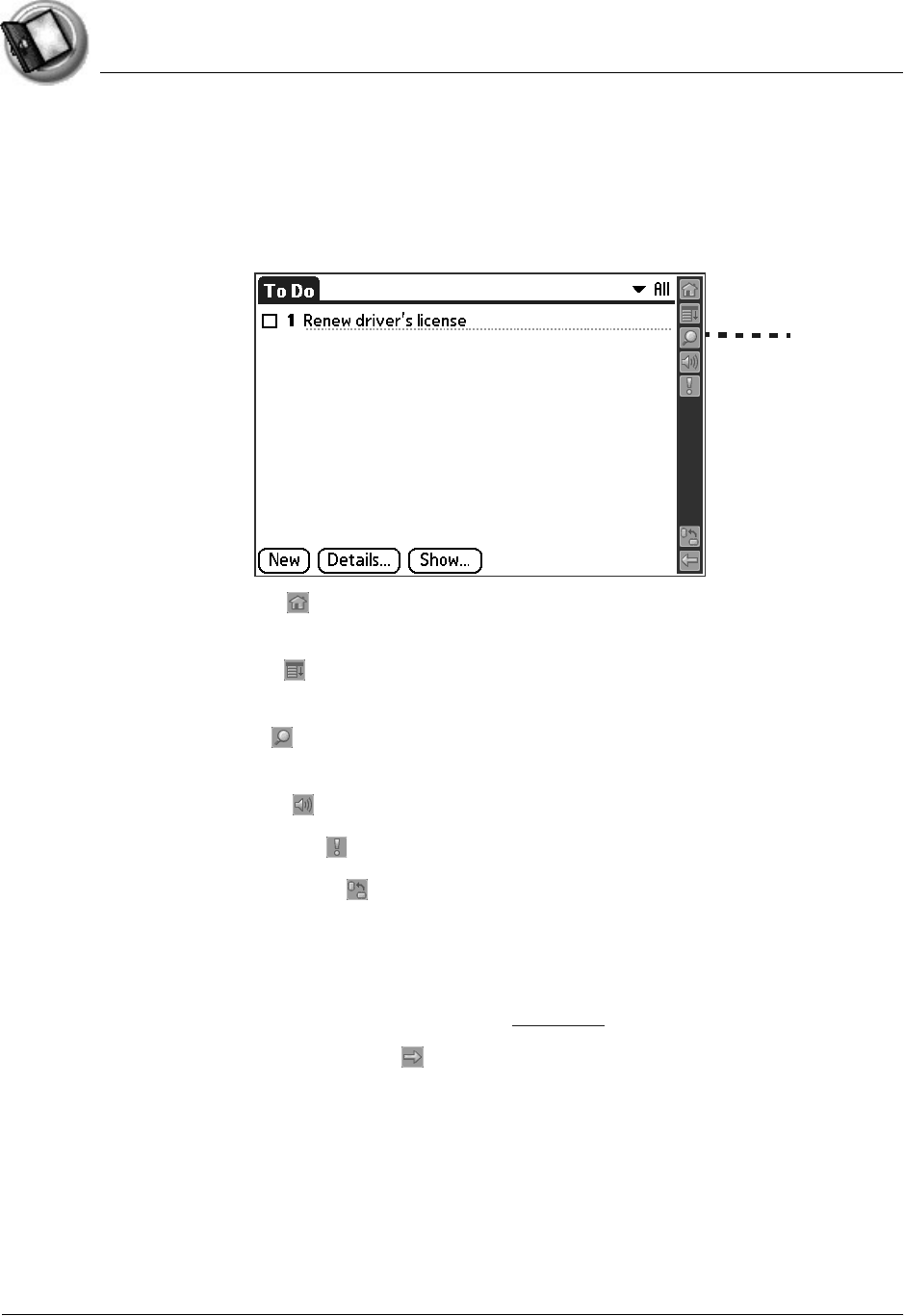
Introduction to your Zodiac Handheld
Learning to navigate
Using Your Zodiac Handheld 24
Status Bar
The Status Bar can appear on the far right, on the far left, or at the bottom of
your screen. When you tap an element on the Status Bar, it performs the
following actions:
•Home icon . Displays the Home screen where you can open
applications.
•Menu icon . Displays the menu bar where you can choose menu
commands.
•Find icon . Opens the Find dialog box where you can perform
system-wide searches on a text string.
•Sound icon . Displays the volume, mute, and brightness controls.
•Attention icon . Flashes when you have alerts to review.
•Orientation icon . Switches the orientation of the screen display
between portrait and landscape mode (when available). In landscape
mode, you can also choose whether the Status Bar and Input Area
appear on the left or right side of the screen. This option is designed to
facilitate left-handed data entry in applications that support this
feature. For more information, see page 123.
•Expand/Collapse icon . Expands and collapses the Input Area
display to provide a larger viewing area while playing games or using
applications where data entry is not required. If the application is
designed to take advantage of the extra screen space, you can view
additional information where the Input Area normally appears.
Status Bar
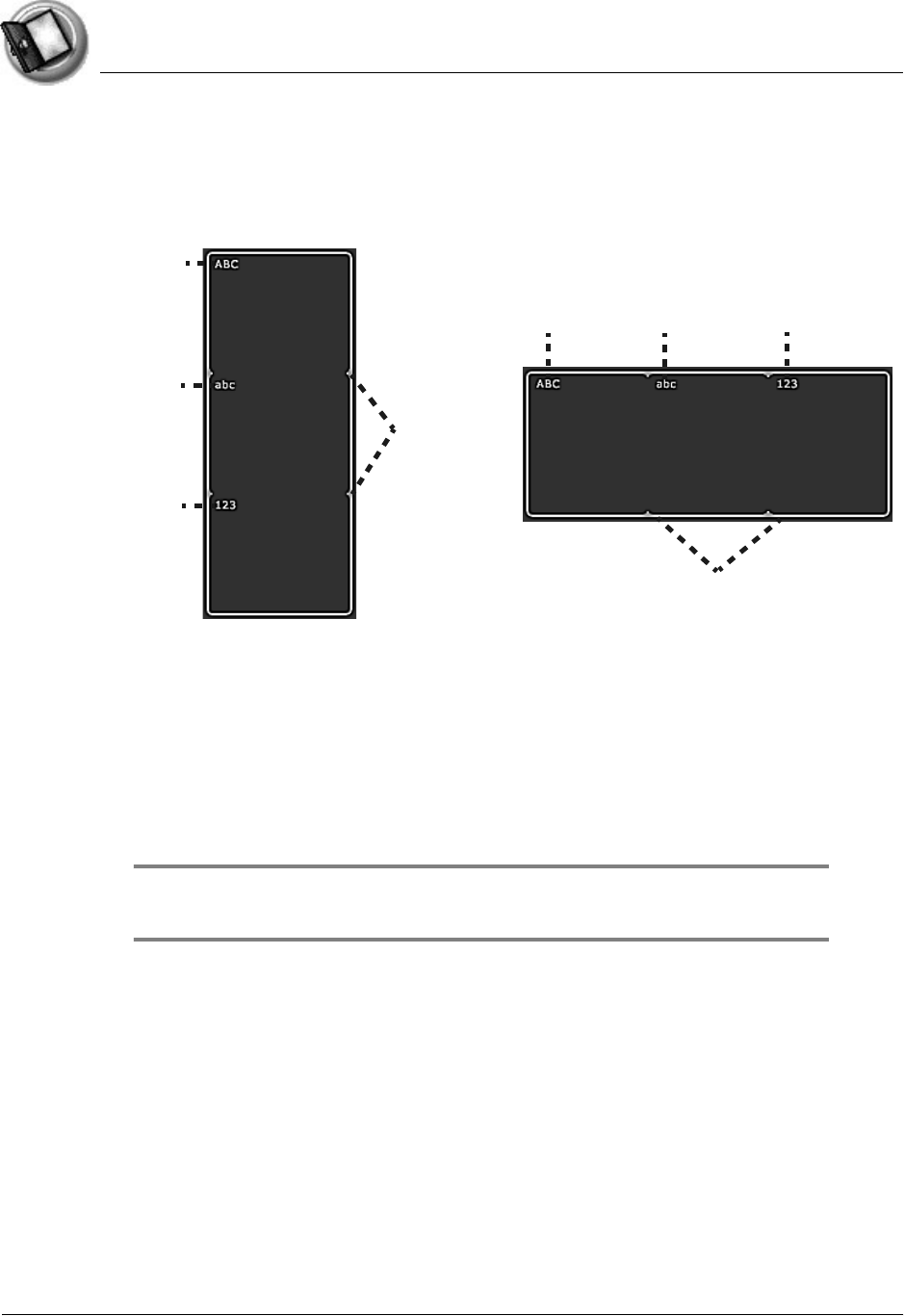
Introduction to your Zodiac Handheld
Learning to navigate
Using Your Zodiac Handheld 25
Input Area
The Input Area enables you to enter data on your handheld using Graffiti® 2
characters or the onscreen keyboard. It includes the following elements:
•Division marks. Separates the various portions of the Input Area.
•ABC and abc. Indicates which type of Graffiti 2 characters (upper or
lower case) you can write in this portion of the Input Area. When you
tap these icons, the alphabetic onscreen keyboard appears.
•123. Indicates that you can write numeric Graffiti 2 characters in this
portion of the Input Area. When you tap this icon, the numeric
onscreen keyboard appears.
NOTE: The cursor must be in an input field to enter Graffiti 2 characters or
open the onscreen keyboard.
Division
marks
Division
marks
ABC
ABC
abc 123
abc
123
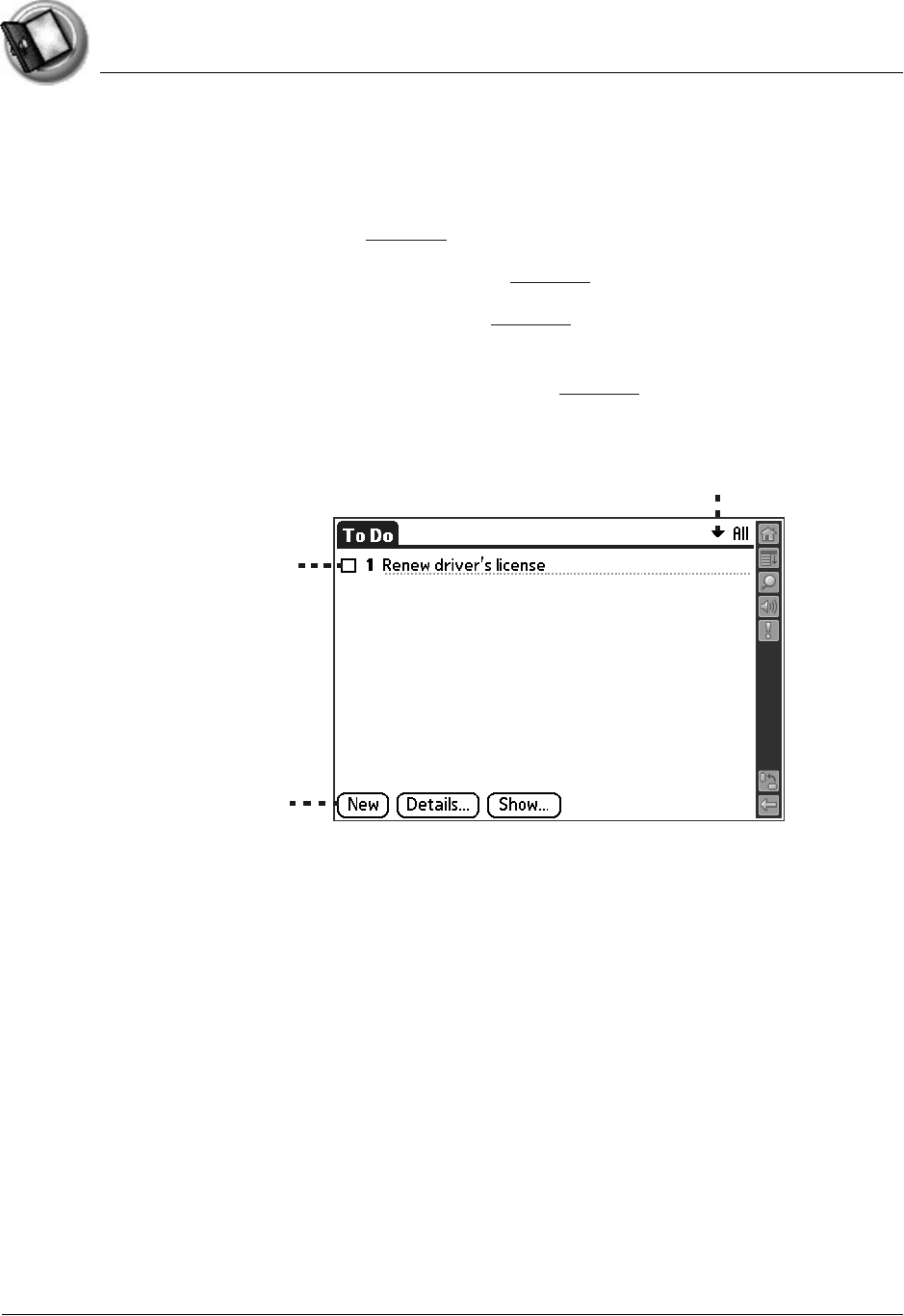
Introduction to your Zodiac Handheld
Learning to navigate
Using Your Zodiac Handheld 26
Entering data
You can enter text, numbers, and symbols into your Zodiac in four ways:
•Using Graffiti 2 (see page 30)
•Using the onscreen keyboard (see page 37)
•Using an external keyboard (see page 39)
•Entering or importing data in Palm Desktop software, and then
synchronizing with your handheld (see page 38)
There are also onscreen controls that enable you to enter data by selecting
options:
•Pick list. Displays a list of choices. Tap the black triangle next to the
pick list name to display a list of choices, and then tap an item in the list
to select it.
•Box. Indicates the state of the corresponding option. A check mark in a
box means the option is active. If a box is empty, tapping it inserts a
check mark. If a box is checked, tapping it removes the check mark.
•Button. Initiates a command when tapped. Buttons, such as New or
Done, appear in dialog boxes and at the bottom of application screens.
Pick list
Box
Button
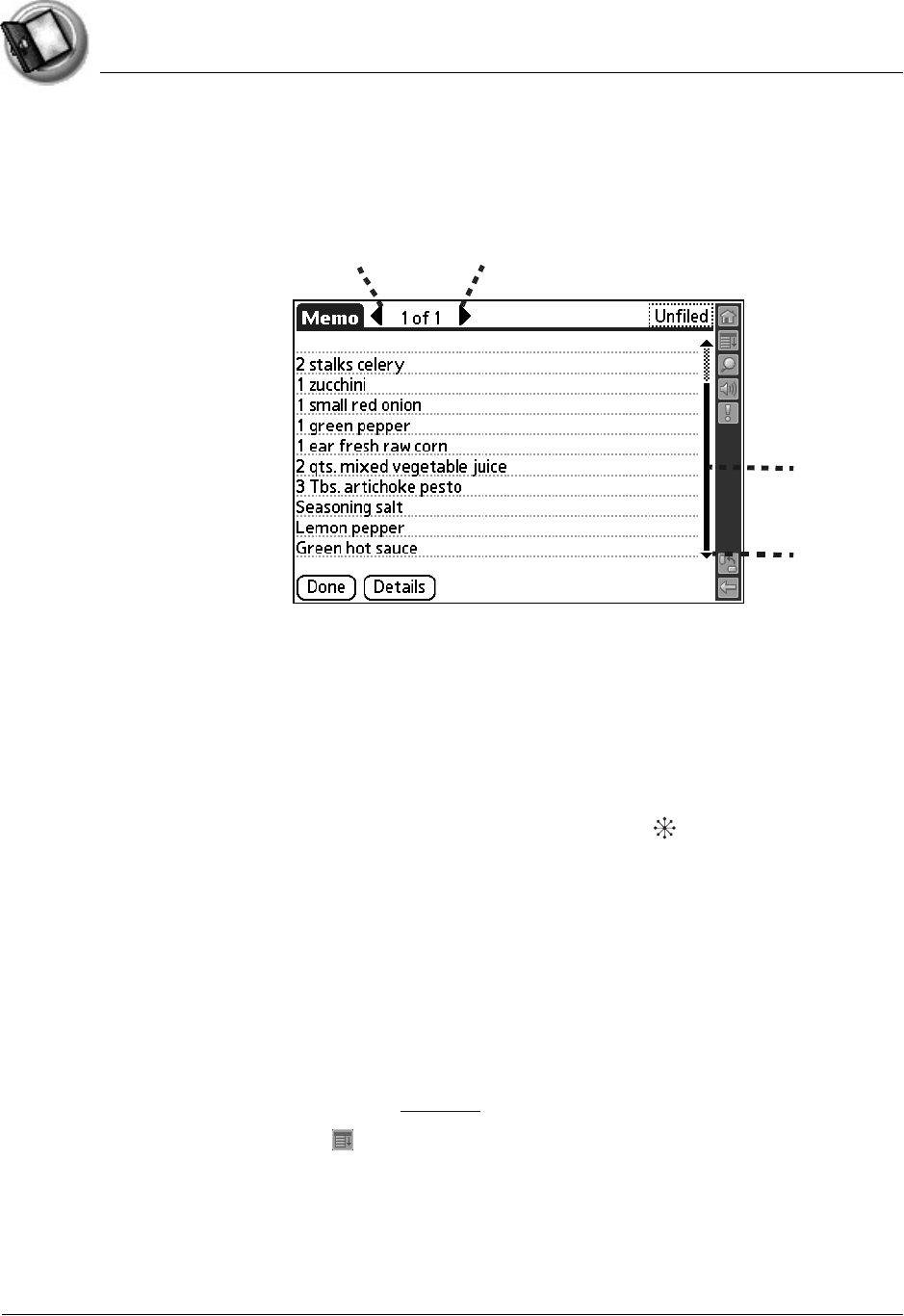
Introduction to your Zodiac Handheld
Learning to navigate
Using Your Zodiac Handheld 27
Navigation controls
Many applications include onscreen controls that enable you to navigate
through your data:
•Next or previous arrow. Displays the previous or next page of
information.
•Scroll bar. Moves through long notes or memos. Tap and hold down
the scroll bar slider to scroll through pages; tap the slider arrow at
either end to move one line at a time. To scroll to the previous page,
tap the scroll bar just above the slider; to scroll to the next page, tap
the scroll bar just below the slider. You can also scroll to the previous
and next pages by moving the analog controller Up and Down.
Menus
Menus and commands are specific to each application and area within the
application. For example, in Memo Pad, the Memo List screen and the Memo
screen display different menus.
Some applications or screens do not have menus. Where available, menu
commands for each application are described in the corresponding
application’s chapter, with the exception of the Edit menu. For information on
Edit menu commands, see page 65.
1. Tap the Menu icon or the title bar to open the menu bar.
Next
arrow
Previous
arrow
Scroll bar
slider
Scroll bar
arrow
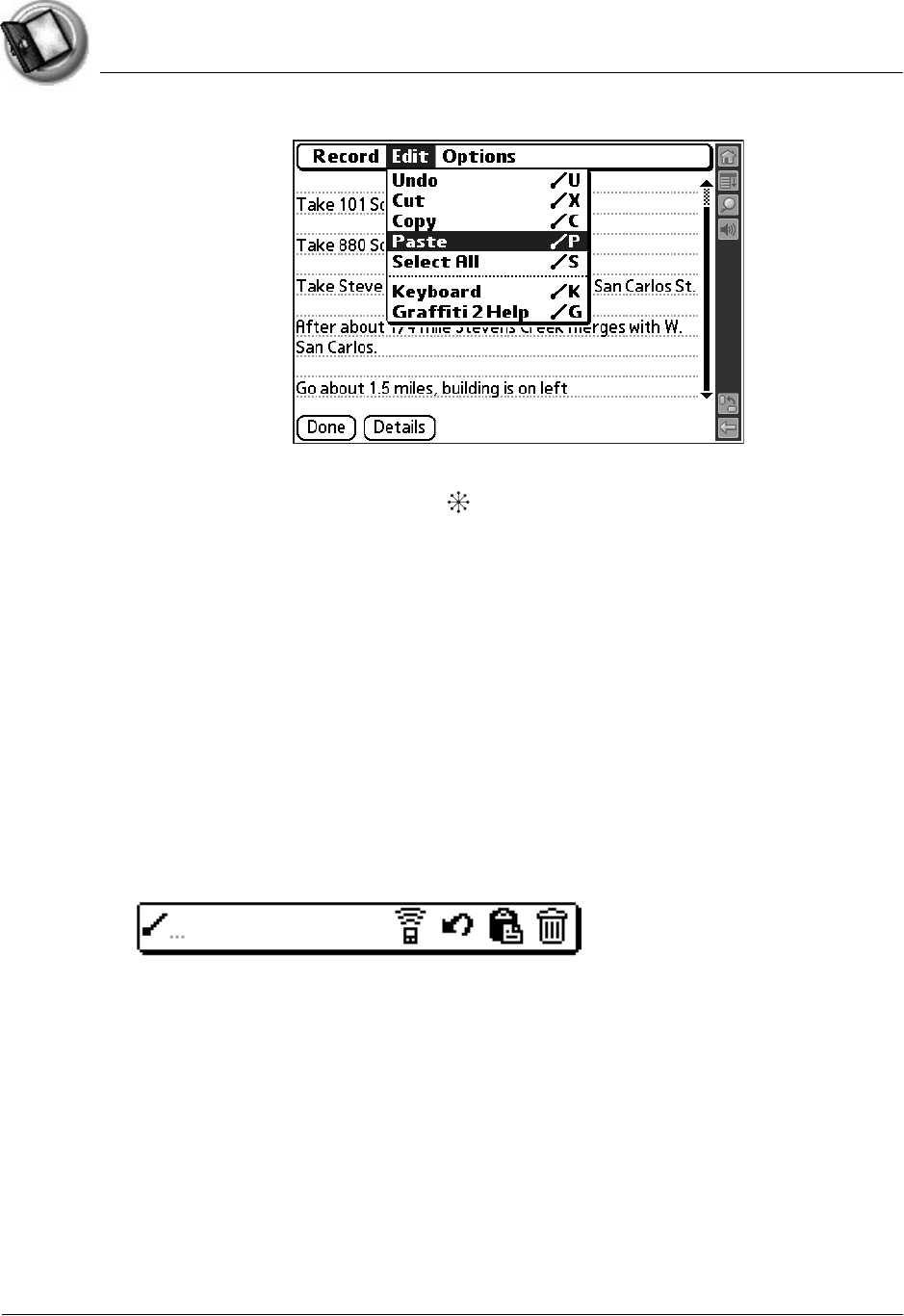
Introduction to your Zodiac Handheld
Learning to navigate
Using Your Zodiac Handheld 28
2. Select a command from the menu by tapping it with the stylus or by
moving the analog controller to highlight it and then pressing the
analog controller while it is centered.
Command toolbar
The command toolbar enables you to initiate a command by tapping an icon
or writing a Graffiti 2 quick stroke instead of using the menus. Most menu
commands have an equivalent Graffiti 2 quick stroke, which is similar to
keyboard shortcuts used to execute commands on computers.
The Graffiti 2 quick stroke appears next to the command in the menu. To use
Graffiti 2 quick strokes, menus must be closed.
1. In the abc or ABC portions of the Input Area, draw the Graffiti 2 menu
command stroke (a diagonal line from the lower-left to upper-right) to
display the command toolbar.
2. Within 4 seconds, do one of the following:
•Tap an icon that represents the command you want. The icons vary
within each application.
•Enter a Graffiti 2 quick stroke in the Input Area. For example, to choose
Select All from the Edit menu, draw the letter S.
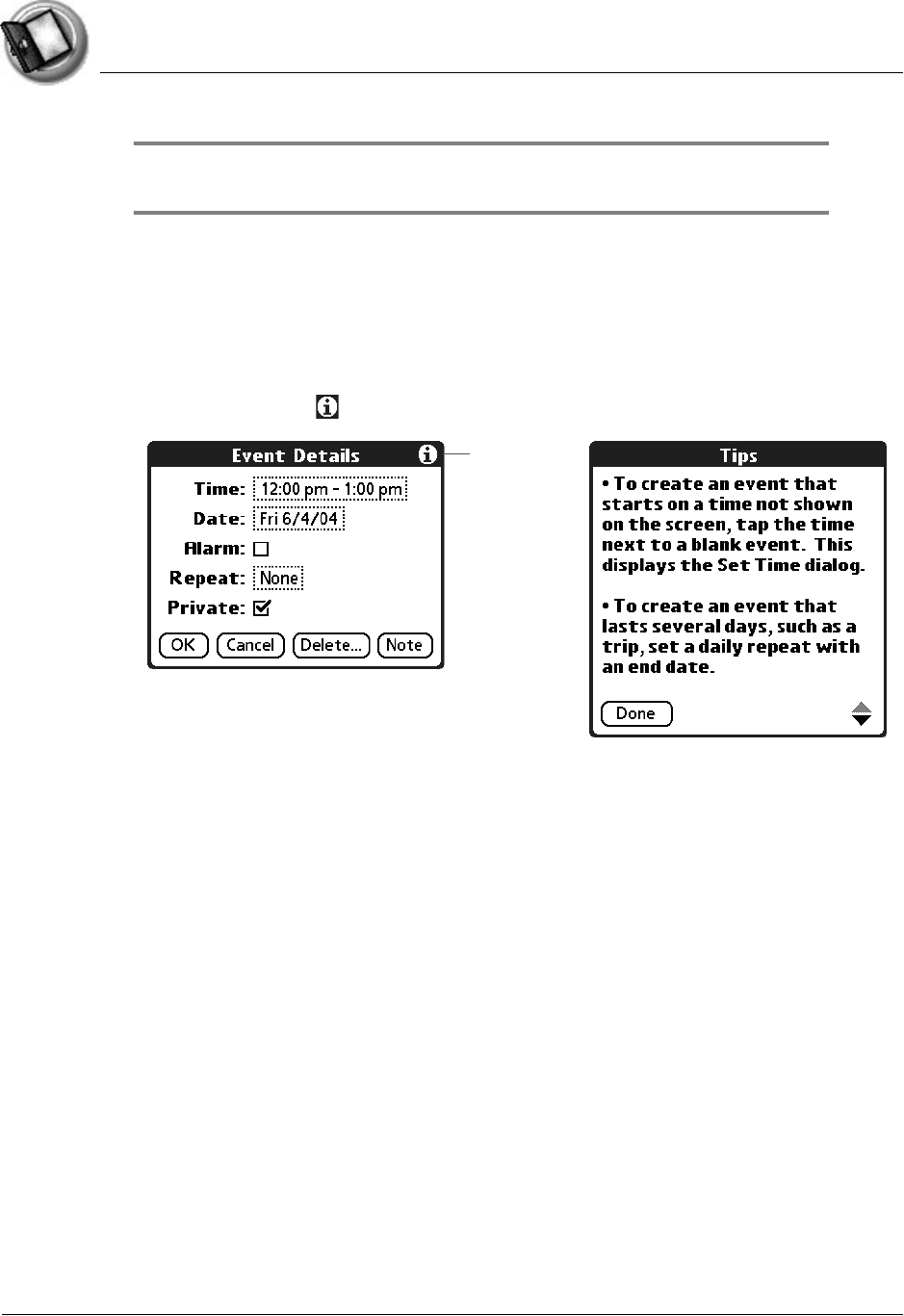
Introduction to your Zodiac Handheld
Learning to navigate
Using Your Zodiac Handheld 29
TIP: If you wait more than four seconds to draw the quick stroke letter, you need
to redraw the menu command stroke to redisplay the command toolbar.
Tips
Many of the dialog boxes that appear on your handheld contain a Tips icon in
the upper-right corner. Tips anticipate questions you may have and provide
shortcuts for using the dialog box or other useful information.
1. Tap the Tips icon in the upper-right corner of the dialog box.
2. Tap Done after reading the tip.
Tips icon

Using Your Zodiac Handheld 30
2
Entering Data in Your
Zodiac Handheld
You can enter data into your Zodiac handheld by using the onscreen
keyboard, writing with the stylus in the Input Area, using your computer
keyboard, using an external keyboard, or by importing data from another
application.
Entering data using Graffiti 2 handwriting software
You can use Graffiti 2 strokes to create letters, numbers, punctuation, and
symbols. The Graffiti 2 writing strokes include all letters, numbers, and
symbols found on a standard keyboard.
Learning to write Graffiti 2 characters
With only a few minutes of practice, you’ll find it easy to enter accurate text
and numbers using Graffiti 2 writing strokes.
The Graffiti 2 demo shows how to use the handwriting software. The first
time you turn on your handheld the Welcome application automatically
guides you through the setup process. When you complete setup, you are
invited to learn how to use the Graffiti 2 handwriting software.
After you view the Welcome application the first time, a Graffiti 2 Demo icon
appears in the Utilities category on the Home screen. Select this icon to
view the demo at any time. You can also select the Welcome icon in the
Utilities category to view the Welcome application again.
TIP: When you reach the Stroke Lookup screen of the demo, use the pick list to
view the wide variety of characters that you can make. As you tap a character, an
animation of the strokes used to form that character appears.
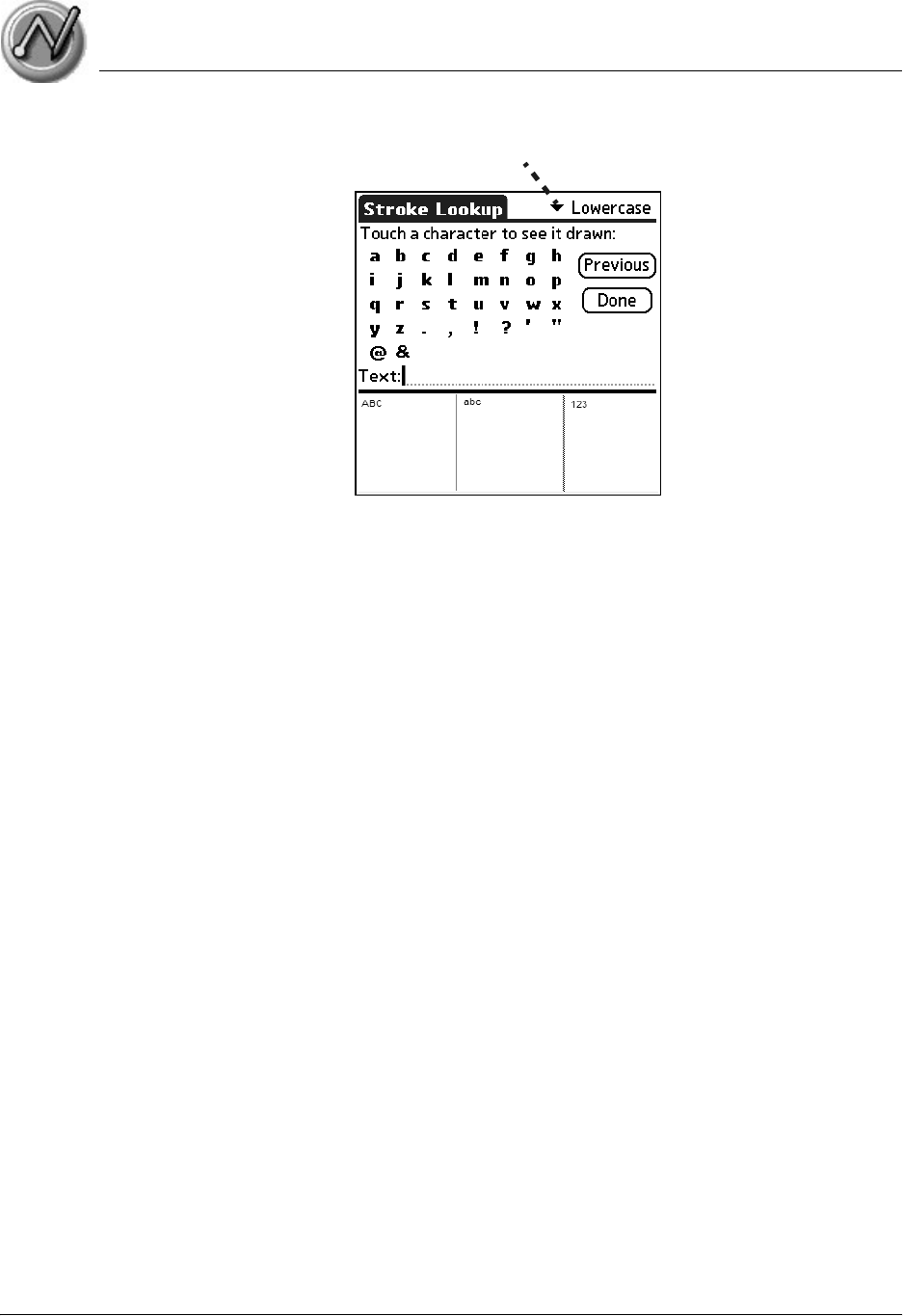
Entering Data in Your Zodiac Handheld
Entering data using Graffiti 2 handwriting software
Using Your Zodiac Handheld 31
General Guidelines for Graffiti 2 Writing
Follow these guidelines to learn and use Graffiti 2 writing strokes successfully:
•To achieve 100% accuracy, practice drawing characters exactly as they
appear in the tables later in this chapter.
•The heavy dot on each shape indicates where to start the stroke. Some
characters have similar shapes, but different starting and ending
points. Always start the stroke at the heavy dot, but do not draw the
heavy dot; (it is there only as a guideline).
•The Graffiti 2 writing strokes for letters closely resemble letters of the
standard English alphabet, both uppercase and lowercase. Graffiti 2
includes symbols made with a single stroke and symbols made with
multiple strokes.
For multi-stroke characters, a temporary character appears after the
first stroke, to show that the stroke was recognized. For example, after
the first vertical stroke of “t”, a temporary “l” is shown. There is a limited
time window, during which you must draw the second stroke.
Otherwise the temporary stroke is recorded.
•The Input Area is divided into three parts, one for writing uppercase
letters, one for writing lowercase letters, and one for writing numbers.
The small marks at the top and bottom of the Input Area define the
division lines. To have your handheld recognize uppercase letters,
lowercase letters, and numbers, you must begin the strokes in the
corresponding portion of the Input Area.
Tap here to view
other strokes
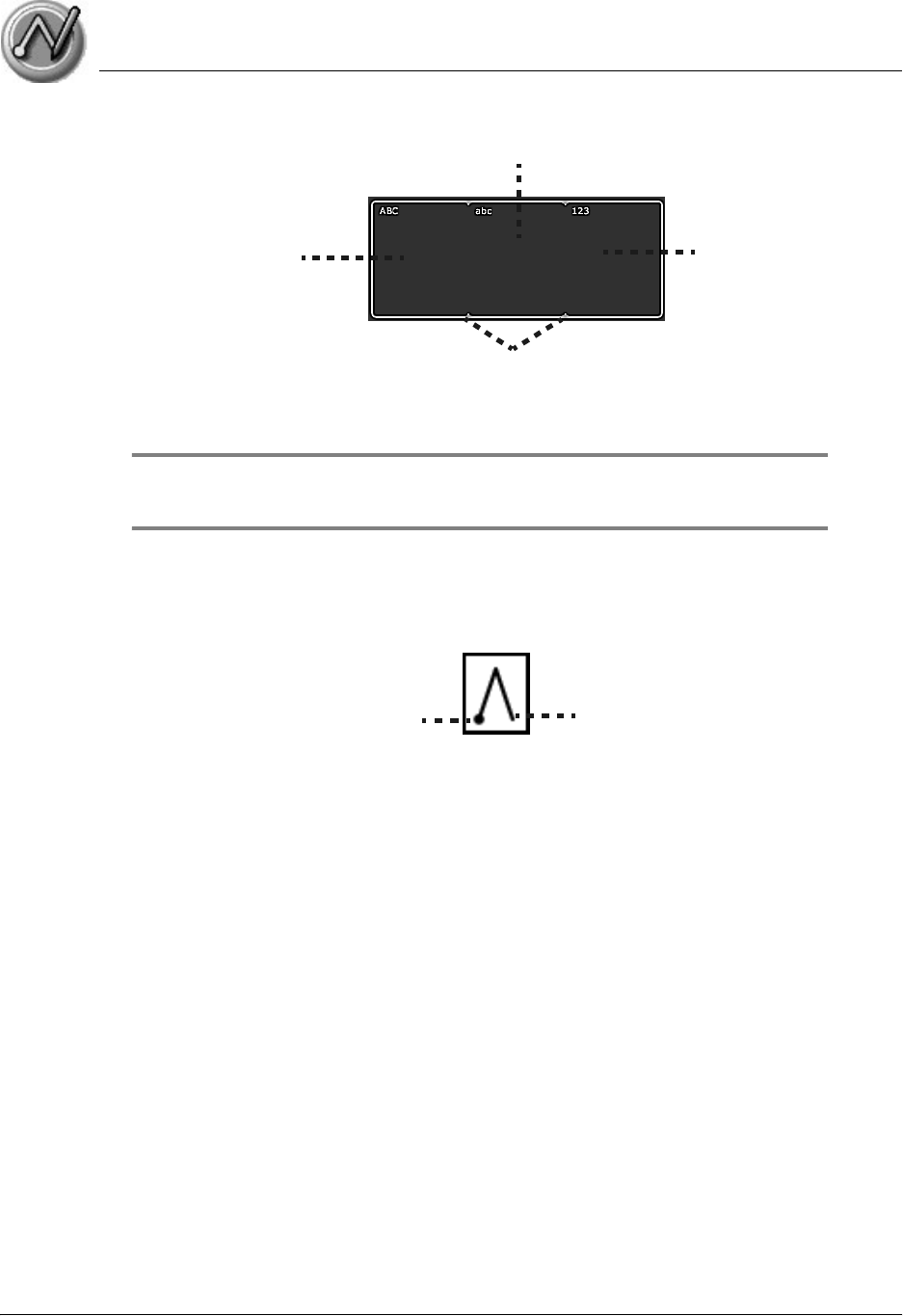
Entering Data in Your Zodiac Handheld
Entering data using Graffiti 2 handwriting software
Using Your Zodiac Handheld 32
1. Tap the screen where you want to write text, for example, on a line next to
a time in Date Book.
NOTE: A blinking cursor must appear onscreen in the entry field before you can begin
writing text.
2. Use the tables on the following pages to find the stroke shape for the
letter you want to write. For example, the stroke shown below creates the
letter A.
You use the same shape to create both the lowercase letter and the
uppercase letter.
3. Position the stylus in the appropriate place of the Input Area depending
on whether you want to write an uppercase or lowercase letter.
4. Start your stroke at the heavy dot, and draw the stroke shape as it
appears in the tables.
5. Lift the stylus from the screen at the end of the stroke shape.
6. Your handheld recognizes your stroke immediately and displays the
letter at the insertion point onscreen. As soon as you lift the stylus from
the screen, you can begin the stroke for the next character you want to
write.
Graffiti 2 tips
When using Graffiti 2 writing, keep the following tips in mind:
Write uppercase
letters here
Write numbers
here
Write lowercase letters here
Division marks
Start stroke at
heavy dot Lift stylus here
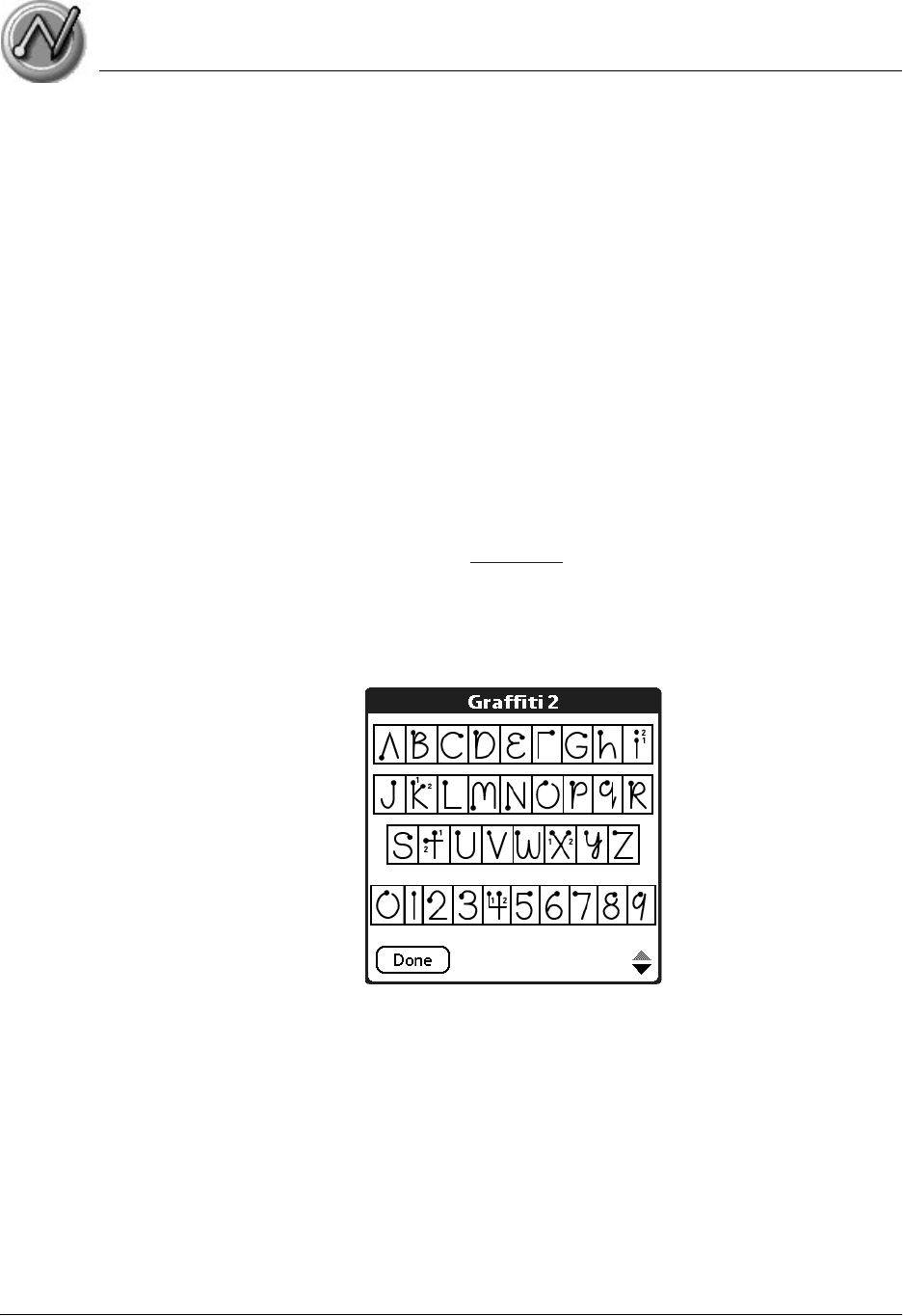
Entering Data in Your Zodiac Handheld
Entering data using Graffiti 2 handwriting software
Using Your Zodiac Handheld 33
•For greater accuracy, draw letters with large strokes; strokes that nearly
fill the Input Area are easily interpreted.
•To delete characters, set the insertion point to the right of the
character you want to delete, and draw the Backspace stroke (a line
from right to left) in the Input Area.
•Write at natural speed. Writing too slowly can produce errors.
•Do not write at a slant. Keep vertical strokes parallel to the sides of the
Input Area.
•When letters and numbers can be written using two different strokes,
use the one that’s easiest for you.
•Press firmly.
•Some characters can be formed in more than way, and you can choose
which method you prefer. See page 124 for details.
The Graffiti 2 alphabet
Draw Graffiti 2 letters according to the following alphabet.
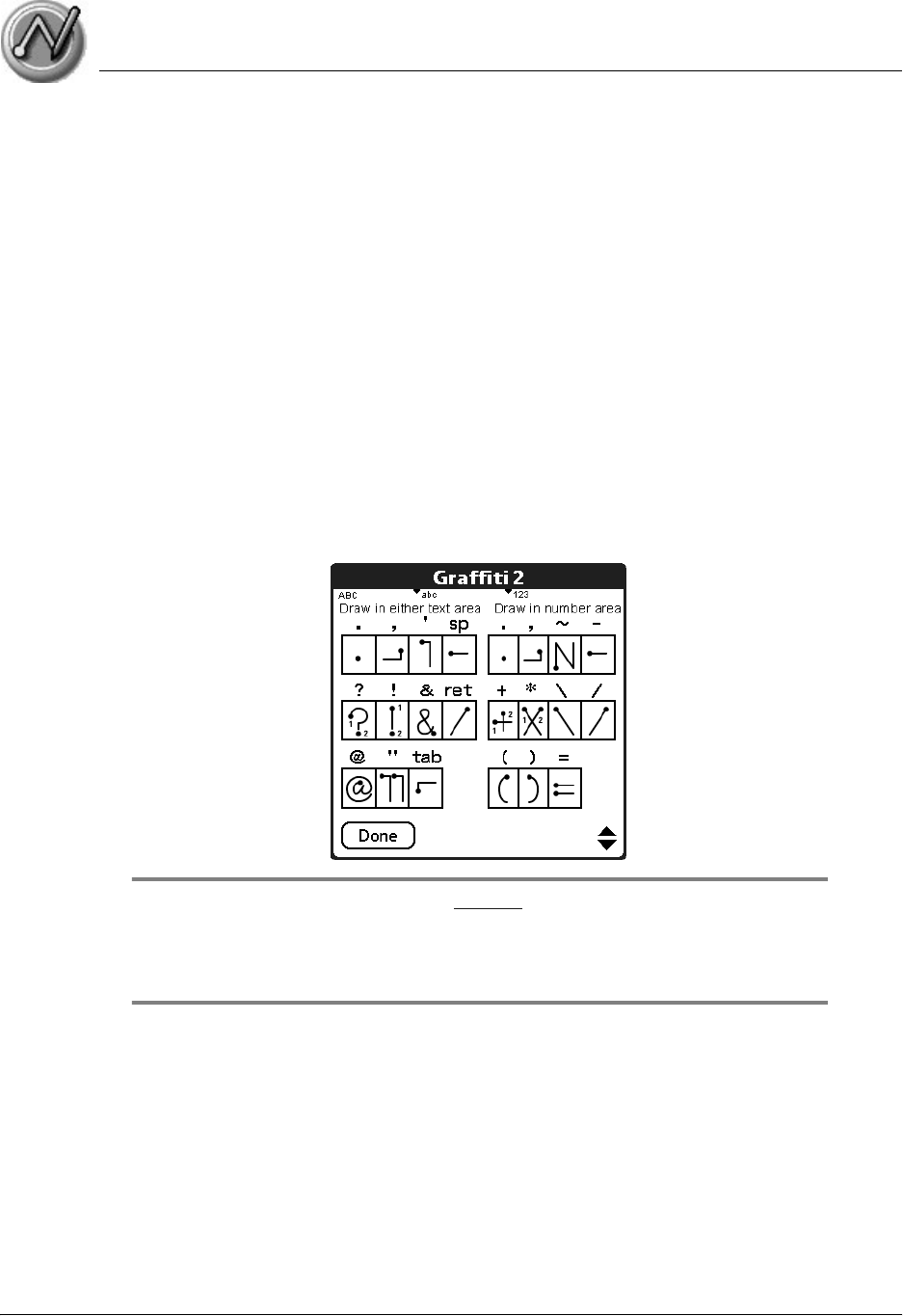
Entering Data in Your Zodiac Handheld
Entering data using Graffiti 2 handwriting software
Using Your Zodiac Handheld 34
Writing punctuation marks and other special characters
Using Graffiti 2 writing, you can create any punctuation symbol and special
character available from a standard keyboard.
•Punctuation marks. The period and comma punctuation marks can
be written in any portion of the Input Area (the uppercase, lowercase,
or number area). Other common punctuation marks can be written
only in specific parts of the Input Area. The chart below indicates
where the punctuation marks must be drawn (in general, the more
frequently used punctuation is on the left side).
– Characters that appear on the left side of the chart must be drawn
in the alphabetic (uppercase or lowercase) portions of the Input
Area.
– Characters that appear on the right side of the chart must be drawn
in the number portion of the Input Area.
TIP: If you draw the Shift stroke (see page 34) before entering a punctuation
mark, you can enter punctuation strokes anywhere in the Input Area. This requires
an additional stroke, but you may find it more convenient, since you don’t have to
remember on which side of the Input Area to make the punctuation strokes.
•Symbols and other special characters. You can write symbols and
other special characters using the Shift command. When you make a
vertical stroke from the bottom to the top in the Input Area, the Shift
indicator arrow appears in the lower right corner of the screen. While
this arrow is visible, you can make the characters shown in the
illustration below. Once the arrow goes away, the symbol or other
special character appears.
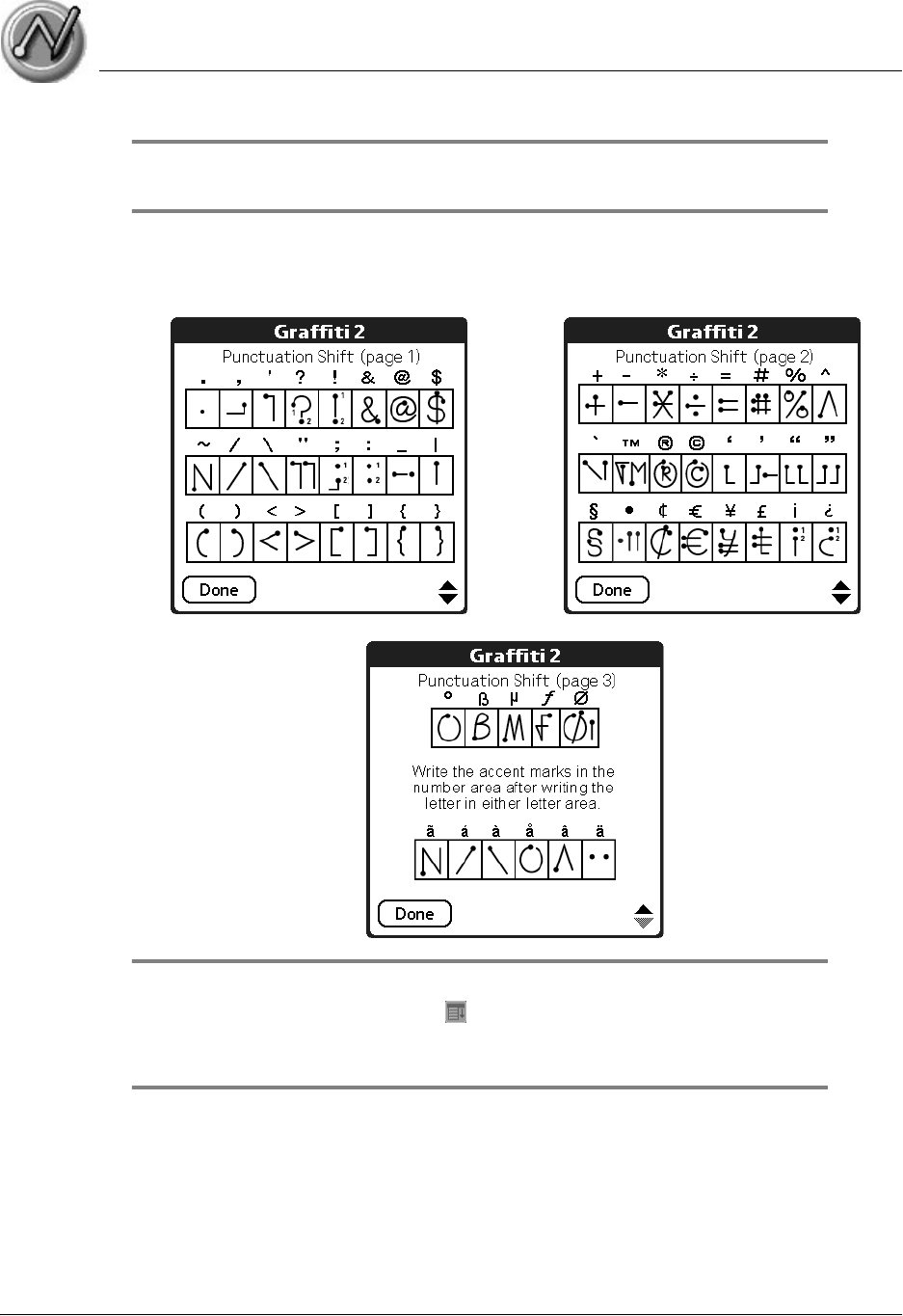
Entering Data in Your Zodiac Handheld
Entering data using Graffiti 2 handwriting software
Using Your Zodiac Handheld 35
TIP: Using an additional Shift stroke to finish writing the character (as shown in
the demo) is optional, but it makes the character appear more quickly.
After drawing the Shift stroke, draw punctuation marks, symbols or accent
marks using the following strokes:
TIP: Samples of the character strokes are available in the Graffiti 2 Help file. To
view the Help file, tap the Menu icon , and from the Edit menu, select Graffiti 2
Help. Note that the accented characters appear on a Punctuation Shift screen, but
do not use the Shift command.
•Accented letters. When writing letters with accent marks, first write
the uppercase or lowercase letter stroke in the appropriate portion of
the Input Area. Then quickly write the accent stroke in the number
portion of the Input Area, as shown in the illustration above.
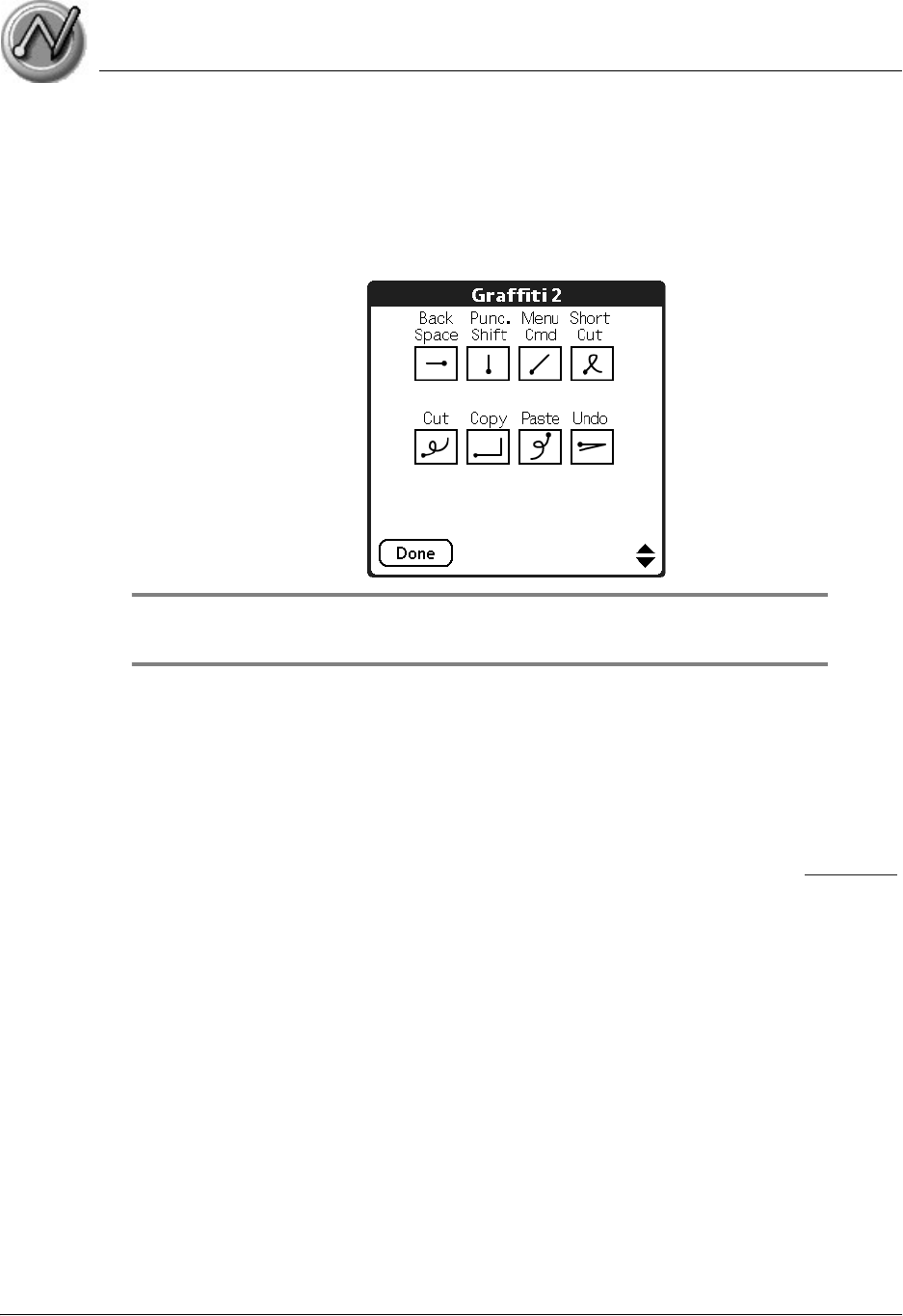
Entering Data in Your Zodiac Handheld
Using Graffiti 2 Gestures
Using Your Zodiac Handheld 36
Using Graffiti 2 Gestures
Gestures are editing commands, such as cut, paste, and the ShortCut
command which is explained in the next section. To use gestures, draw the
following strokes:
TIP: The Menu command stroke must be drawn in either of the letter portions of
the Input Area. The remaining strokes can be drawn anywhere in the Input Area.
Using Graffiti 2 ShortCuts
Graffiti 2 ShortCuts let you quickly and easily enter commonly used words or
phrases. ShortCuts are similar to the Glossary or Autotext features of some
word processors. Graffiti 2 writing comes with several predefined ShortCuts.
You can also create your own for any words, letters, or numbers, see page 133
for details.
Your handheld includes the following predefined Graffiti 2 ShortCuts for
common entries:
•br—Breakfast
•di—Dinner
•ds—Date stamp
•dts—Date/time stamp
•lu—Lunch
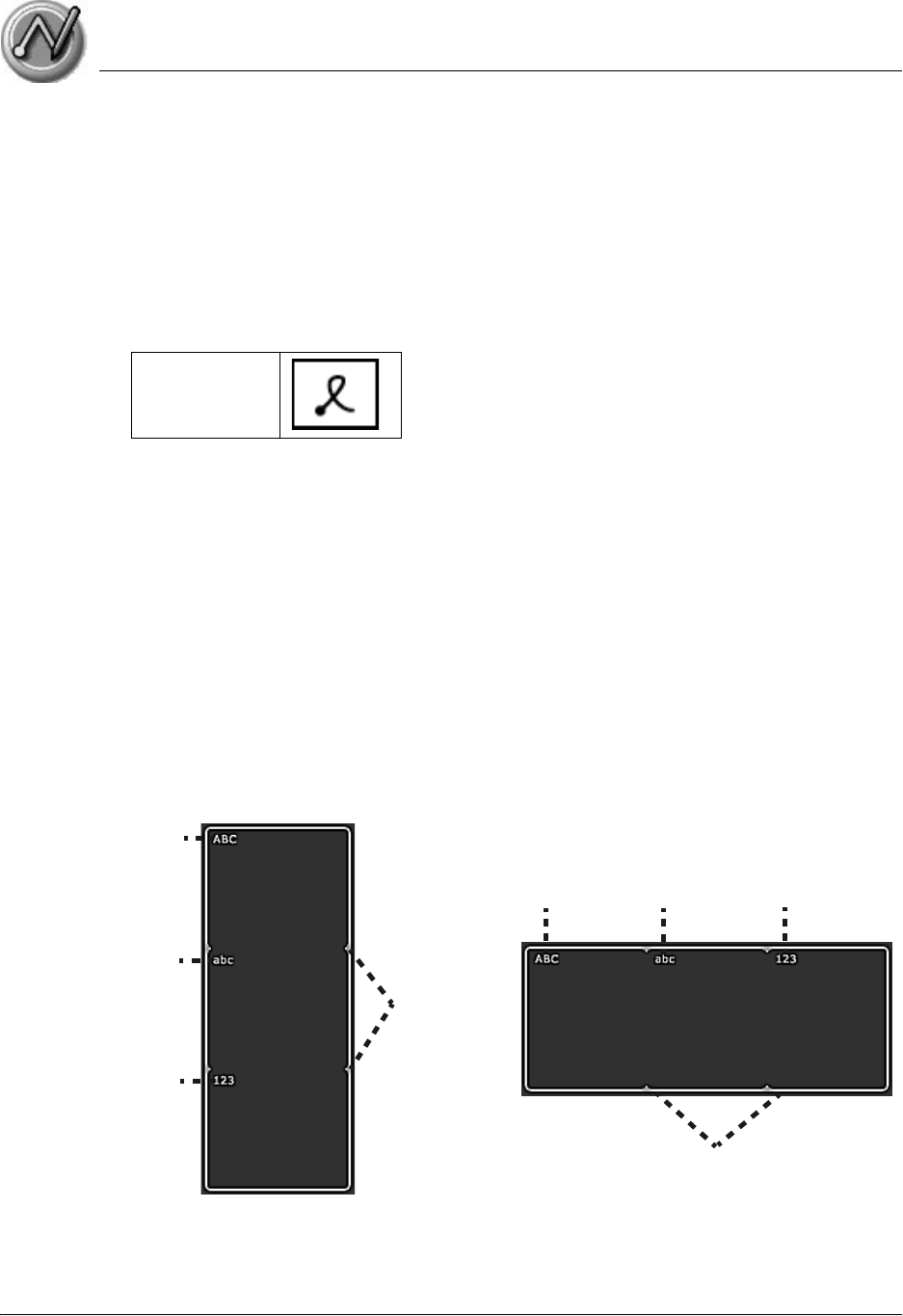
Entering Data in Your Zodiac Handheld
Using the onscreen keyboard
Using Your Zodiac Handheld 37
•me—Meeting
•ts—Time stamp
1. Draw the ShortCut stroke.
2. Draw the ShortCut character(s).
When you draw the ShortCut stroke, the ShortCut symbol appears at the
insertion point.
Using the onscreen keyboard
You can open the onscreen keyboard anytime you need to enter text or
numbers on your handheld.
1. Open any application (such as Address Book).
2. Tap any record, or tap New.
3. In the Input Area, tap one of the following to display the corresponding
onscreen keyboard:
•ABC or abc - display the alphabetic keyboard.
•123 - displays the numeric keyboard.
ShortCut
Division
marks
Division
marks
ABC
ABC
abc 123
abc
123
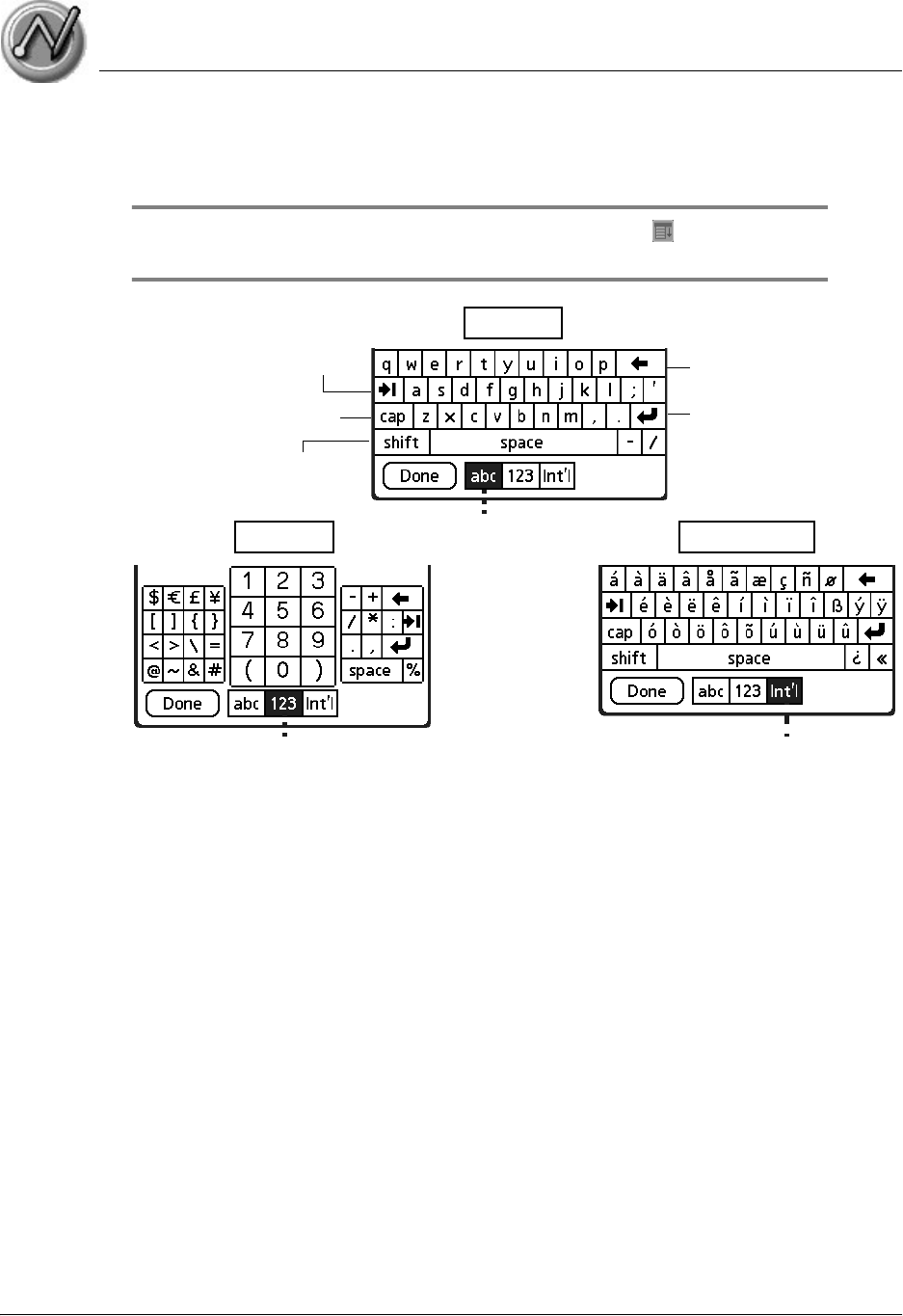
Entering Data in Your Zodiac Handheld
Using your computer keyboard
Using Your Zodiac Handheld 38
4. To display the international keyboard, open an onscreen keyboard, and
then tap Int’l at the bottom of the keyboard display.
TIP: To select any of the three keyboards, tap the Menu icon and then tap Edit.
Tap Keyboard, and then tap the keyboard you want.
.
5. Tap the desired characters or numbers; then tap Done to enter the text or
numbers.
Using your computer keyboard
At times, you may prefer to use your computer keyboard rather than the
onscreen keyboard to enter or modify information on your handheld.
You can enter information from your computer keyboard using Palm™
Desktop software or any supported desktop organizer installed for use with
your handheld. You can then perform a HotSync operation to synchronize the
information on your computer with the information you entered on your
handheld. All the Organizer applications on your handheld are available in
Palm Desktop software and in most desktop organizer software.
Refer to Palm Desktop online Help for more information on entering data on
your computer.
Backspace
Carriage return
Tab
Caps Lock
Caps Shift
Tap here to display
alphabetic keyboard
Tap here to display
numeric keyboard Tap here to display
international keyboard
Alpha
Numeric International

Entering Data in Your Zodiac Handheld
Using an external keyboard
Using Your Zodiac Handheld 39
Using an external keyboard
You can connect an optional external keyboard accessory to the connector on
your handheld so you can type data directly into your handheld. External
keyboards are very useful for typing large amounts of data quickly and
accurately while you are away from your computer.
Importing data
If you have data stored in computer applications such as spreadsheets and
databases, or if you want to import data from another device, you can transfer
the data to your Zodiac handheld without entering it manually. Save the data
in one of the file formats listed below, import it into Palm Desktop software,
and then perform a HotSync operation to transfer the data to your handheld.
Palm Desktop software can import data in the following file formats:
•Comma delimited (.csv, .txt): Address Book and Memo Pad only.
•Tab delimited (.tab, .tsv, .txt): Address Book and Memo Pad only.
•CSV (Lotus Organizer 2.x/97 Mapping): Address Book only.
•vCal (.vcs): Date Book only.
•vCard (.vcf): Address Book only.
•Date Book archive (.dba).
•Address Book archive (.aba).
•To Do List archive (.tda).
•Memo Pad archive (.mpa).
Archive formats can only be used with Palm Desktop software. Use the archive
file formats to share information with other people who use Palm Powered
handhelds or to create a copy of your important Palm Desktop information.
1. Open Palm Desktop software.
2. Click the application into which you want to import data.
3. If you are importing records that contain a field with category names, do
the following:

Entering Data in Your Zodiac Handheld
Importing data
Using Your Zodiac Handheld 40
a. Select All in the Category box.
b. Make sure that the same categories that appear in the imported file also
exist in the application. If the categories do not exist, create them now;
otherwise, the records are imported into the Unfiled category.
4. Choose File > Import; then select the file you want to import, and click
Open.
5. To import data into the correct Palm Desktop fields, drag fields in the left
column so that they are opposite the corresponding imported field on the
right.
6. To exclude a field from being imported, uncheck the field’s box.
7. Click OK.
8. The imported data is highlighted in the application.
9. To add the imported data to your handheld, perform a HotSync
operation.
See Palm Desktop online Help for more information on importing and
exporting data.
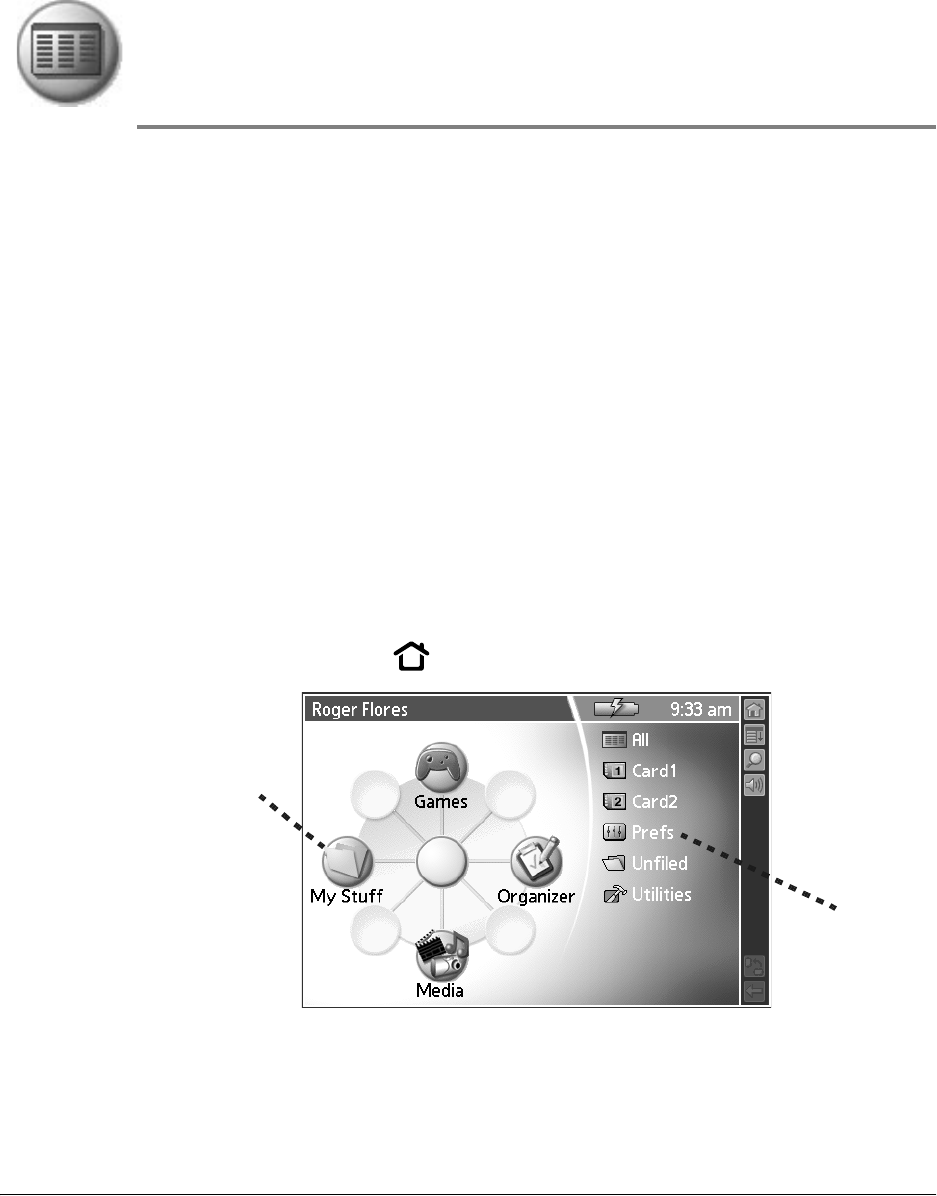
Using Your Zodiac Handheld 41
3
Managing Applications
This chapter explains how to switch between applications on your Zodiac
handheld, how to personalize application settings, and how to organize
applications into related groups.
Using the Home screen
The Home screen enables you to open applications on your handheld. All the
applications installed on your handheld are organized into categories which
appear in the Home screen. By default the Home screen displays a radial
menu and list of your application categories. When you choose a category,
the applications in that category appear on the radial menu and in the list.
In addition to providing a way for you to open applications, the Home screen
also displays your user name, the battery level, and the current time. When
you open a category, the category name replaces your user name.
You can customize the Home screen as described later in this chapter.
1. Press the Home button or tap the Home icon.
.
Radial menu
Menu list
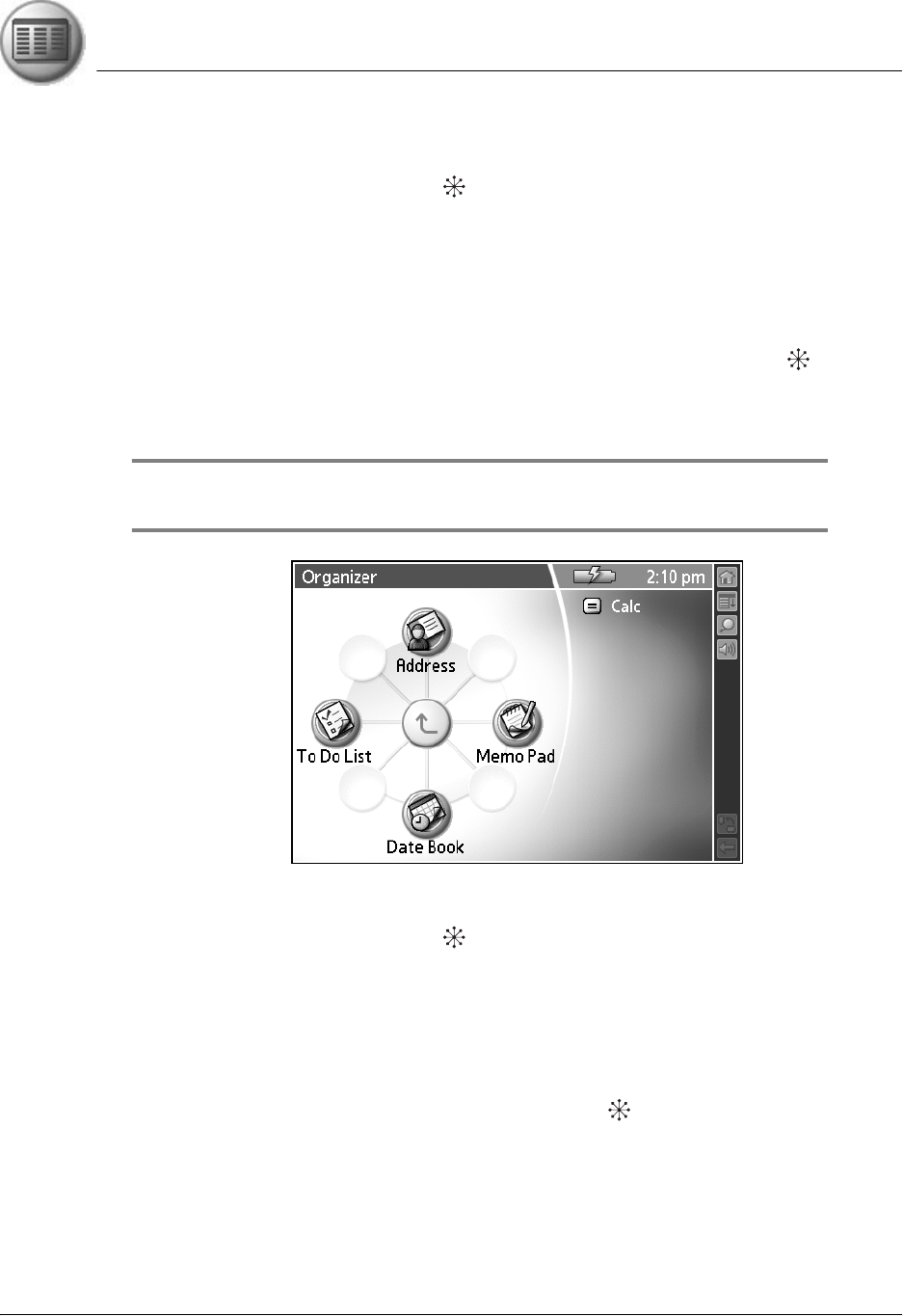
Managing Applications
Using the Home screen
Using Your Zodiac Handheld 42
2. Open a category by doing one of the following:
•Move the analog controller in the direction that corresponds to the
category you want to open. The placement of the icons on the radial
menu correspond to the directional controls on the analog controller.
After you highlight your selection, release the analog controller to
open the category.
•Press the Function button to move from the radial menu to the list,
then scroll to a category on the list. With the analog controller
centered, press it to open the category.
•Tap a category icon on the screen.
TIP: To view a list of all your applications, select All from the category list on the
right side of the screen.
3. Open an application by doing one of the following:
•Move the analog controller in the direction that corresponds to the
application you want to open. The placement of the icons on the radial
menu correspond to the directional controls on the analog controller.
After you highlight your selection, release the analog controller to
open the application.
•Scroll to an application icon in the All view list (if you already selected
the All category). With the analog controller centered, press it to
open the application.

Managing Applications
Customizing the Home screen display
Using Your Zodiac Handheld 43
•Press the Function button to move from the radial menu to the list, and
then scroll to an application on the list. With the analog controller
centered, press it to open the application.
•Tap an application icon on the screen.
Customizing the Home screen display
There are several ways you can customize the Home screen display. You can
rearrange the icons on radial menus, move applications to a different
category, create new categories, and set display and button preferences.
Arranging icons on the radial menus
Each radial menu can contain up to eight icons. You can move icons to a
different spoke on a radial menu, or move them between a radial menu and
the corresponding list.
To arrange the radial menus, do any of the following:
•Drag an icon from the list to a spoke on the radial menu. If that spoke is
already occupied, the previous occupant moves to the list.
•Drag an icon from one spoke on the radial menu to another spoke. If
the new spoke is already occupied, the icons trade places.
•Drag an icon from the radial menu to the list. The spoke remains empty
and the icon appears in alphabetical order on the list.
Organizing applications
Your Zodiac handheld supports up to 15 categories. The category feature
enables you to organize your applications into logical groups so that you can
easily find and open them. You can move applications between categories
and add, rename, and delete categories as needed.
Moving applications between categories
1. Press the Home button .
2. Tap your user name in the title bar to open the menus.
3. From the App menu, select Category.
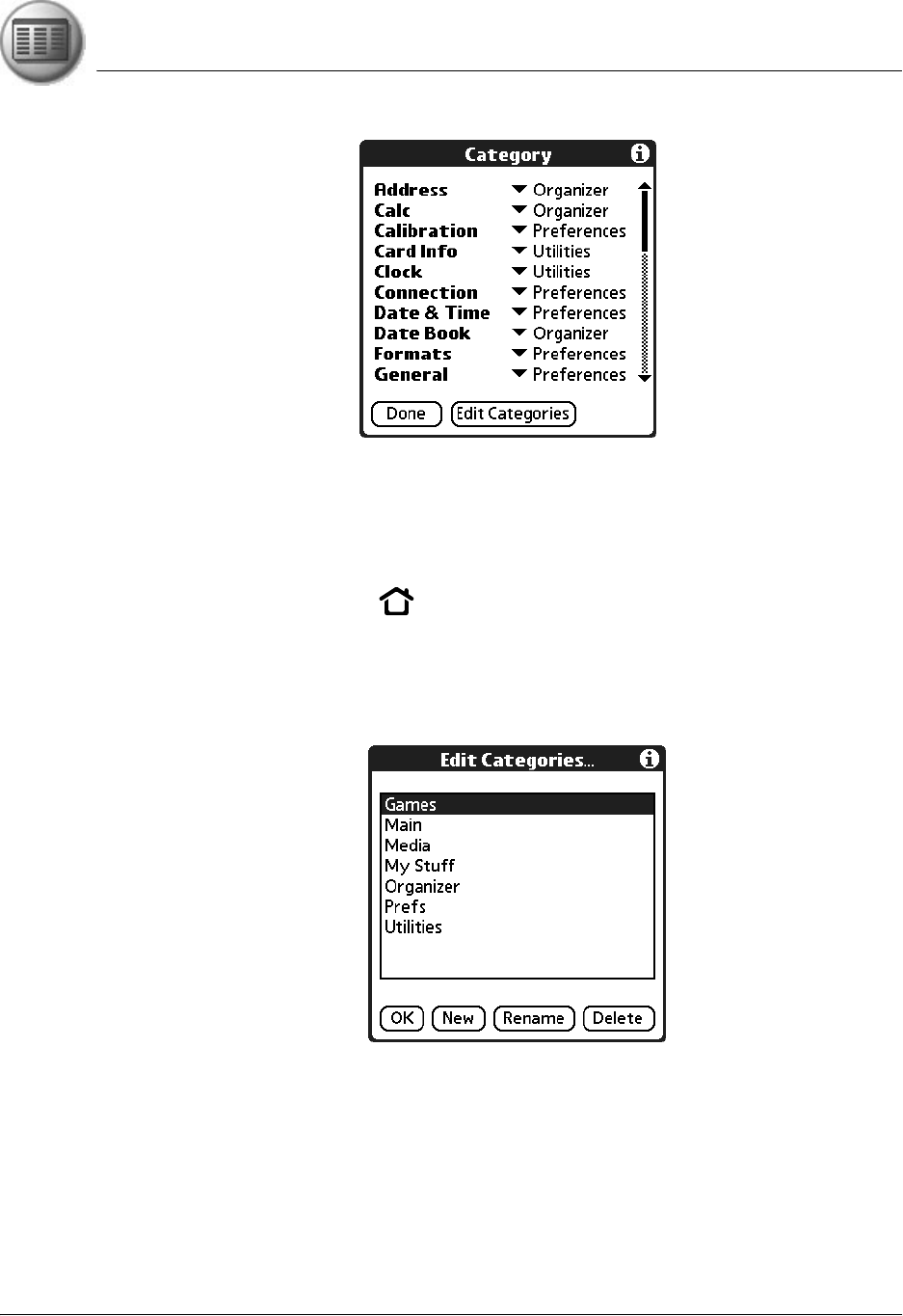
Managing Applications
Customizing the Home screen display
Using Your Zodiac Handheld 44
4. From the pick list next to an application, select a different category.
5. Tap Done.
Creating or renaming a category
1. Press the Home button .
2. Tap your user name in the title bar to open the menus.
3. From the App menu, select Category.
4. Tap Edit Categories.
5. Tap New or Rename.
6. Enter the category name, and then tap OK to add or rename the category.
7. Tap OK to close the Edit Categories dialog box.
8. Tap Done.
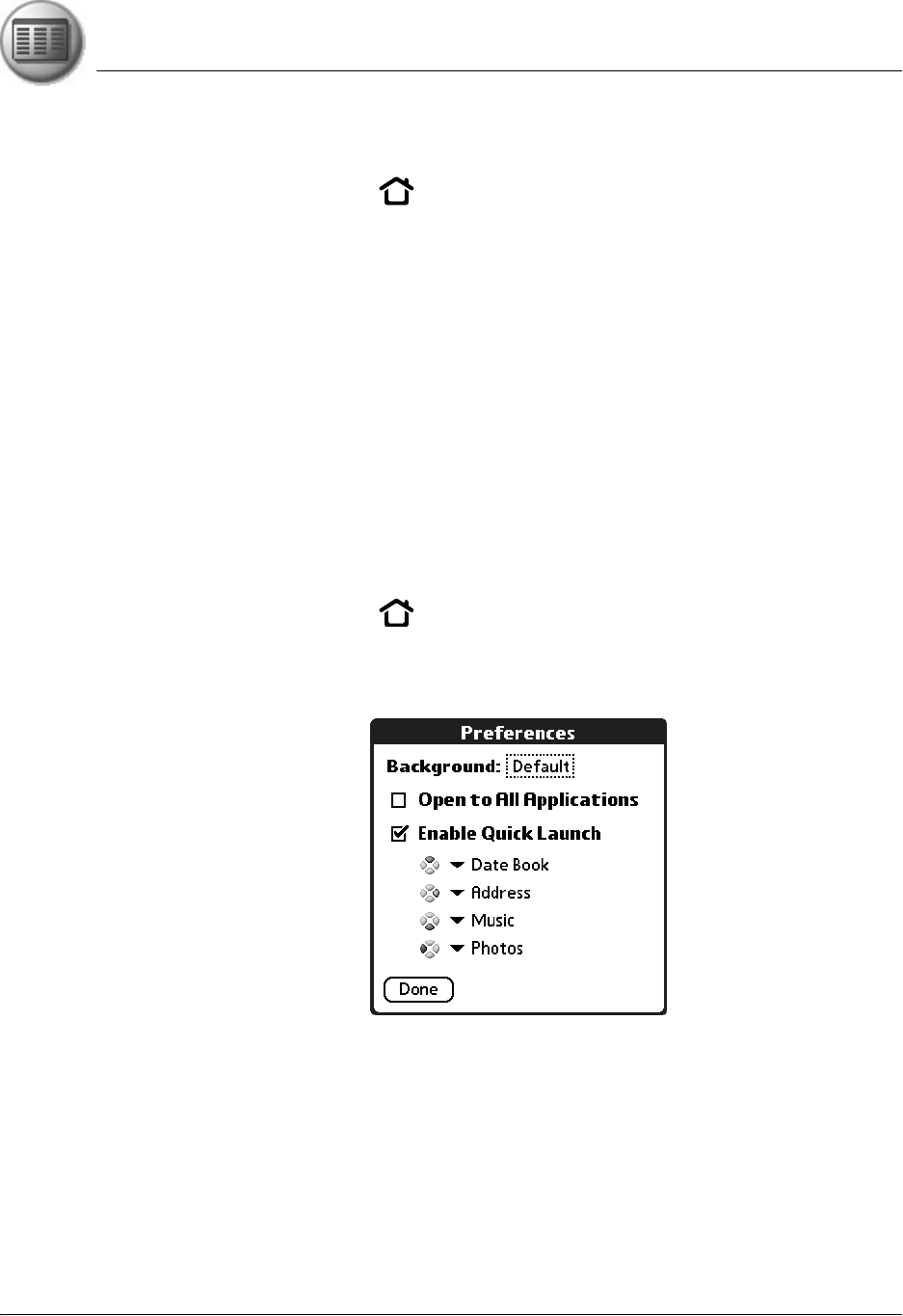
Managing Applications
Customizing the Home screen display
Using Your Zodiac Handheld 45
Deleting a category
1. Press the Home button .
2. Tap your user name in the title bar to open the menus.
3. From the App menu, select Category.
4. Tap Edit Categories.
5. Select a category, and then tap Delete.
6. Tap Yes to confirm deletion.
7. Tap Done.
Setting Home screen preferences
You can use the Home screen Preferences settings to change the background
graphic, display all your applications in an alphabetical list, and map
applications to the action buttons.
1. Press the Home button .
2. Tap your user name in the title bar to open the menus.
3. From the Options menu, select Preferences.
4. Set any of the following options:
•Background. Replace the background with any JPEG picture available
in the Photos application on your handheld.
•Open to All Applications. Display all of your application icons in an
alphabetical list (instead of radial menus) whenever you open the
Home screen.
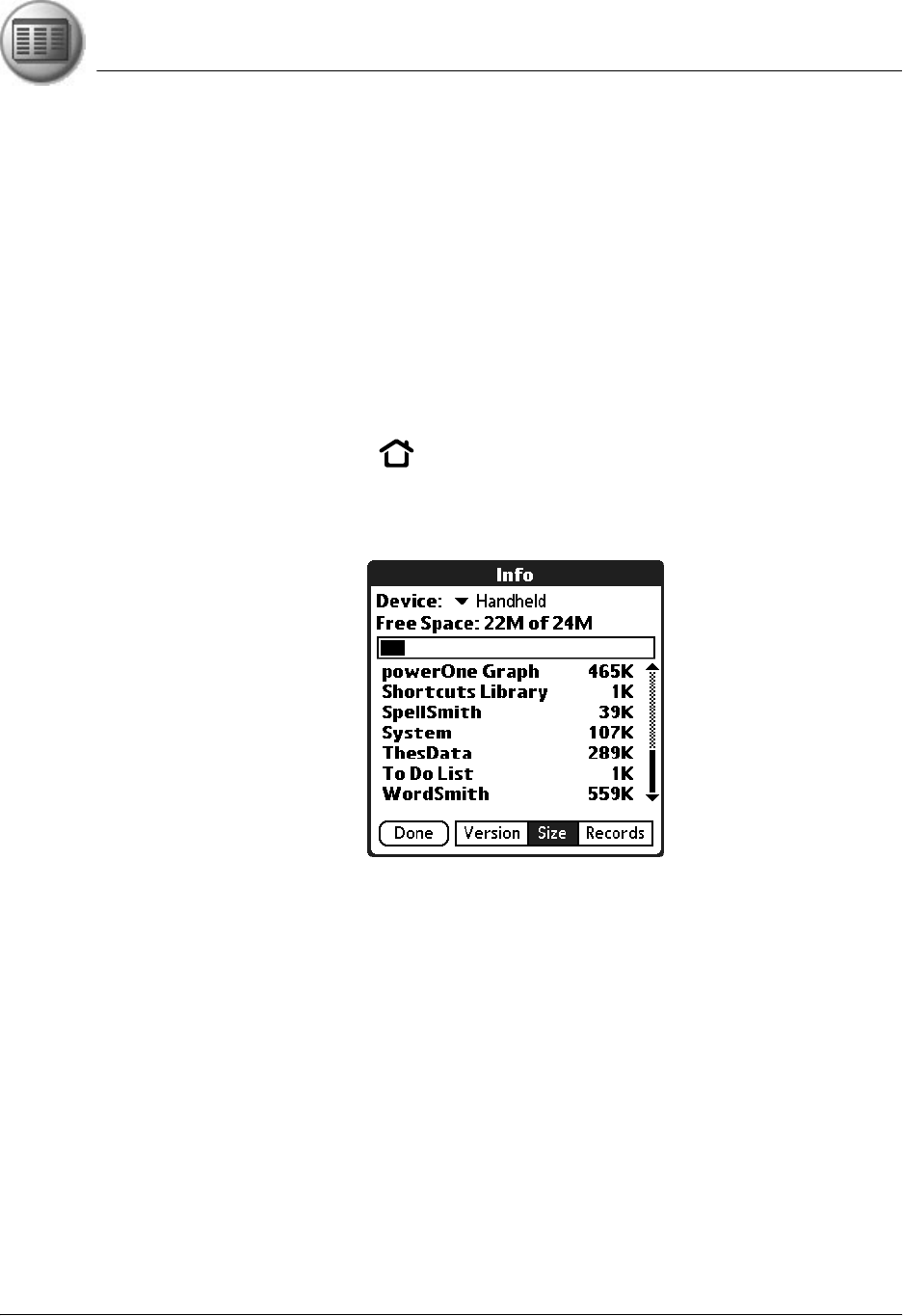
Managing Applications
Viewing information on an application
Using Your Zodiac Handheld 46
•Enable Quick Launch. Assign an application to each of the four Action
buttons. When you press any of these buttons from the Home screen,
the assigned application opens immediately.
5. Tap Done.
Viewing information on an application
You can get information on any application by displaying the Info screen. The
Info screen displays the name, version number, size, and number of records
associated with each application on your handheld.
1. Press the Home button .
2. Tap your user name in the title bar to open the menus.
3. From the App menu, select Info.
4. From the Device pick list, select Handheld or the name of an expansion
card inserted in a slot.
5. Tap Version, Size, Records to view the corresponding information for the
selected device.
6. Tap Done.
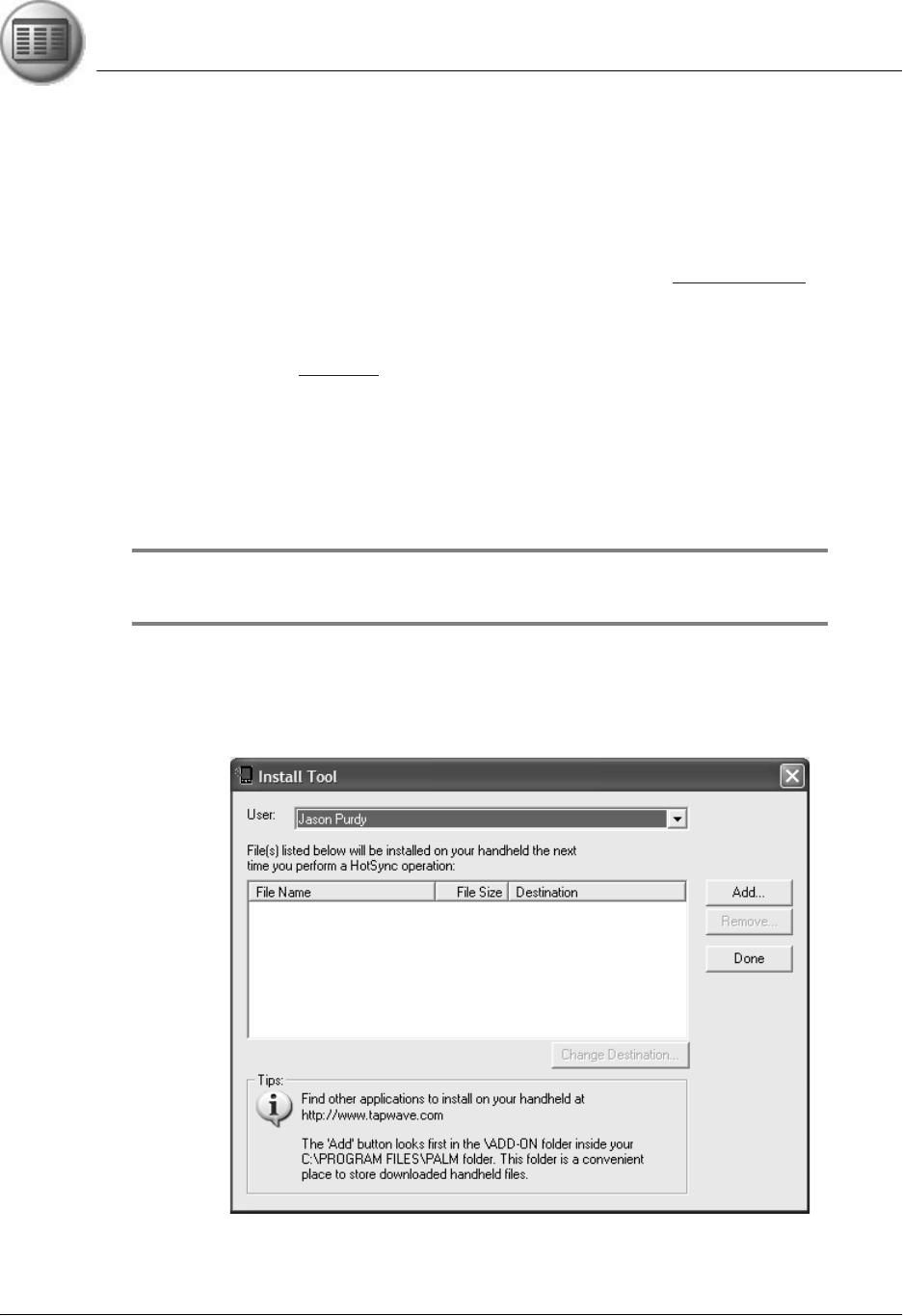
Managing Applications
Installing add-on applications
Using Your Zodiac Handheld 47
Installing add-on applications
In addition to the applications that came with your handheld, you can use the
Install Tool to install applications (called add-on applications) during a
HotSync operation. A variety of third-party games and applications are
available for your handheld; for more information visit tapwave.com.
Add-on applications can reside in your handheld’s internal memory or on an
expansion card. You can remove add-on applications at any time; for more
information, see page 48.
There are also several Bonus Software applications included on the CD that
came with your handheld. If you did not install these applications when you
installed Palm Desktop software, you can install them at any time by choosing
the Install Bonus Software option from the CD menu. After you install an
application, check the CD for the accompanying documentation.
NOTE: Some add-on applications consist of multiple PRC or PDB files. Check the
documentation that came with the application to ensure that you install all required files.
1. From your computer, double-click the PRC or PDB file you want to install.
The Install Tool window opens and the selected file appears in the list of
applications to install.

Managing Applications
Removing add-on applications
Using Your Zodiac Handheld 48
TIP: You can also select the Install Tool dialog box by selecting Install Tool from
the Palm Desktop program group, or by clicking the Install icon in Palm Desktop
software.
2. In the User drop-down list, select the user name that corresponds to your
Zodiac handheld.
3. (Optional) Click Change Destination, click the arrows to indicate whether
you want to install the application on your handheld or an expansion
card, and then click OK.
TIP: If you decide not to install an application, select it in the list of files in the
Palm Install Tool dialog box and click Remove. The application is removed from the
dialog box list, but not from your computer.
4. Click Done. A message appears to indicate that the application(s) will be
installed the next time you perform a HotSync operation.
5. Perform a HotSync operation to install the application(s). For details, see
page 136.
Removing add-on applications
If you run out of memory or no longer need them, you can remove add-on
applications, patches, and extensions from your handheld.
You cannot remove the built-in applications that reside in ROM on your
handheld.
1. Press the Home button .
2. Tap your user name in the title bar to open the menus.
3. From the App menu, select Delete.
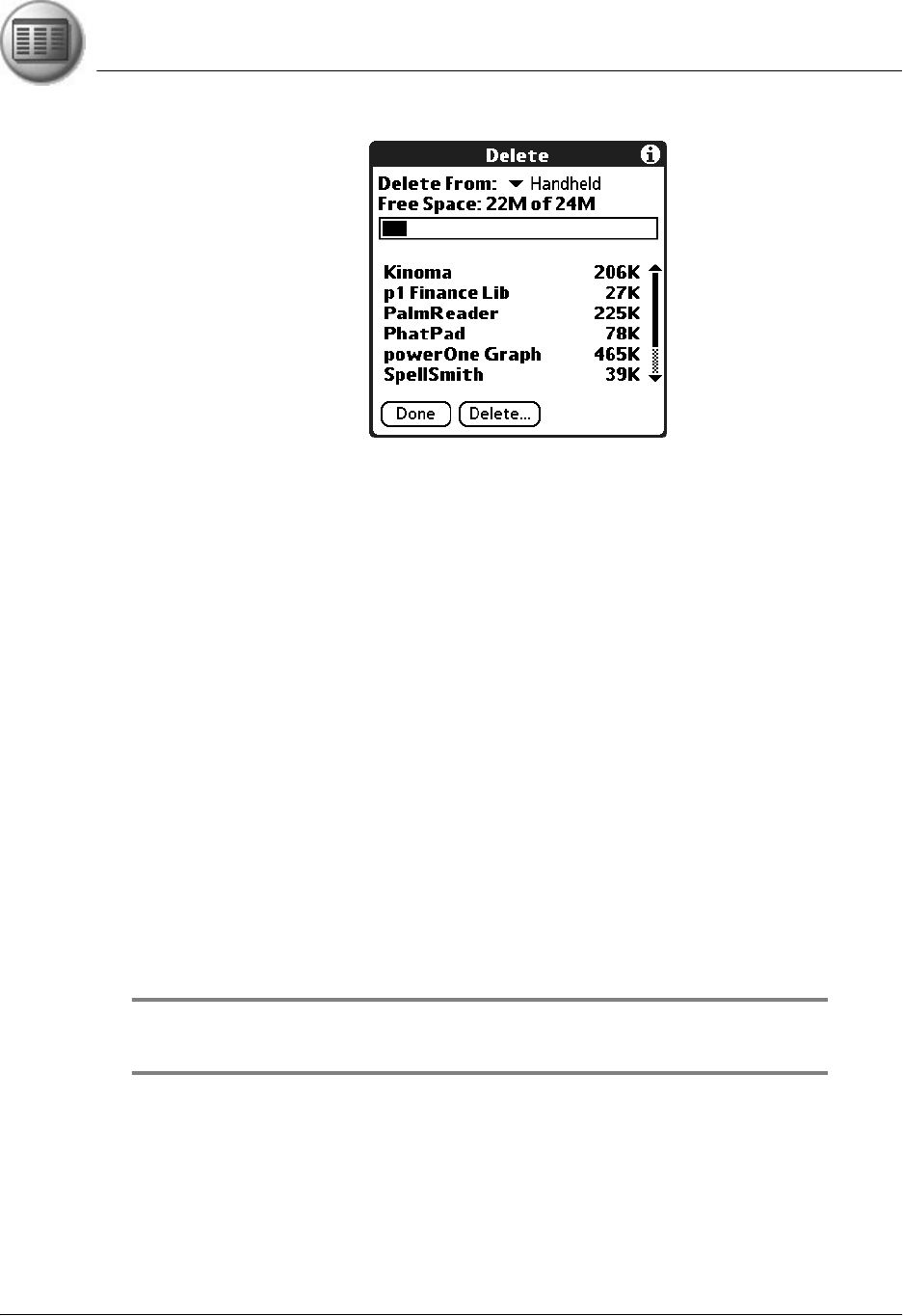
Managing Applications
Removing Palm Desktop software
Using Your Zodiac Handheld 49
4. From the Delete From pick list, select Handheld.
5. Tap the application you want to remove.
6. Tap Delete.
7. Tap Yes.
8. Tap Done.
The application is deleted. Applications that are loaded in ROM (for example,
Memo Pad) cannot be deleted, and are not listed.
Removing Palm Desktop software
If you no longer want to use Palm Desktop software, you can remove it from
your computer.
1. From the Windows Start menu, choose Settings > Control Panel.
2. Double-click the Add/Remove Programs icon.
3. On the Install/Uninstall tab, select Palm Desktop software; then click Add/
Remove.
NOTE: You must retain the HotSync Manager from the installation CD to synchronize
data with another desktop organizer application.
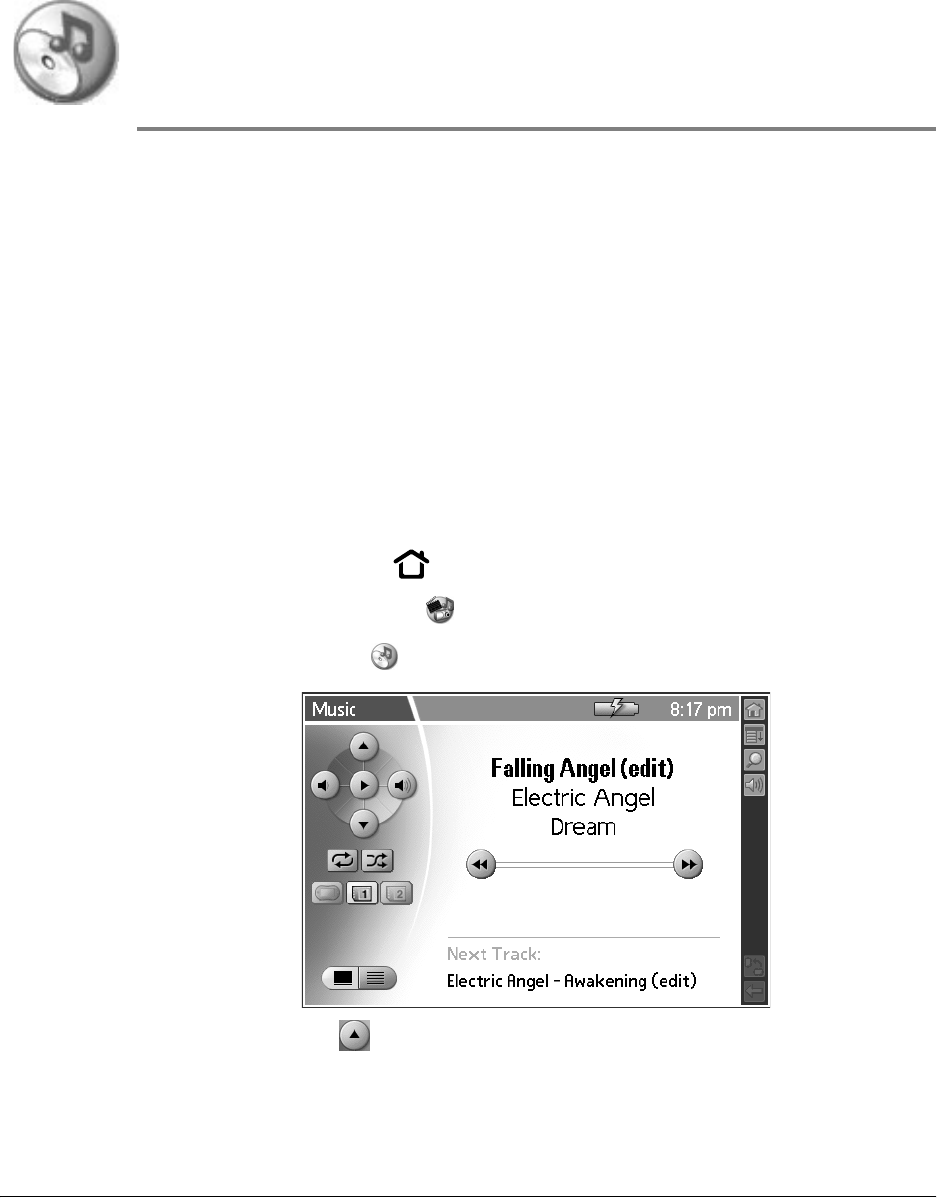
Using Your Zodiac Handheld 50
4
Using Music
Music provides a full-featured mobile MP3 player right on your handheld.
Use Music to:
•Listen to songs and other MP3 files stored on your handheld or an
expansion card.
•Upload songs from your computer to your handheld or an expansion
card.
•Update a list of songs you created with the Music component in Palm
Desktop software.
Opening Music
1. Press the Home button .
2. Select the Media category .
3. Select the Music icon .
•Previous Track . Restart the current track, or if the current track has
been playing for less than 2 seconds, select the previous track on the
song list.
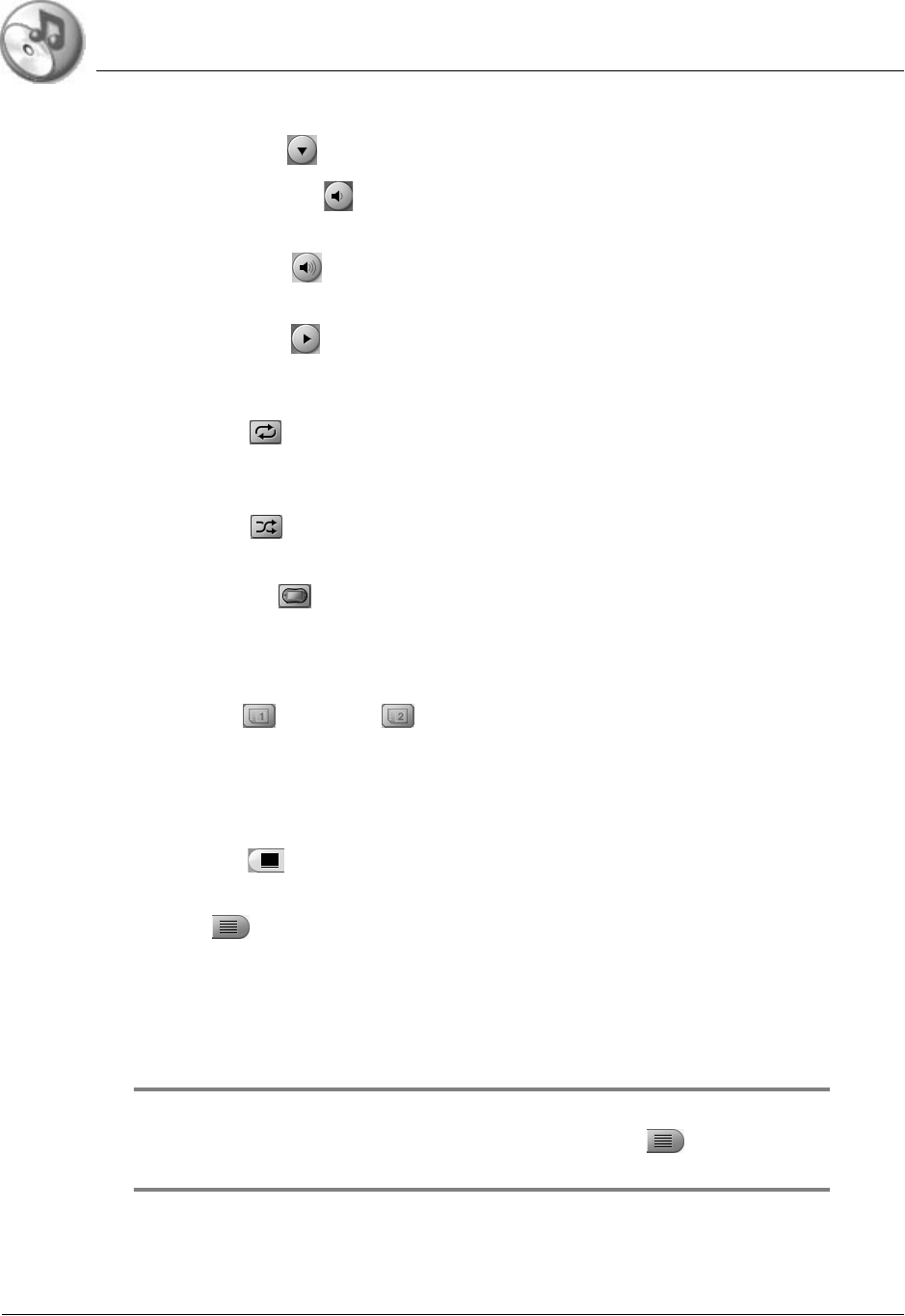
Using Music
Opening Music
Using Your Zodiac Handheld 51
•Next Track . Select the next track on the song list.
•Volume Down . Lower the speaker or headphone volume level.
The volume indicator appears when you tap this button.
•Volume Up . Raise the speaker or headphone volume level. The
volume indicator appears when you tap this button.
•Play/Pause . Start and stop playback of the selected song. When a
song is playing, the Pause button appears. When a song is not playing,
the Play button appears.
•Repeat . Select Repeat replays the entire song list after the last
song plays. If Repeat is not selected, your handheld shuts off after the
last song.
•Shuffle . Select Shuffle to create a randomly ordered song list.
Deselect Shuffle to return the songs to their prior order.
•Handheld . Select handheld to display songs stored in the internal
memory on your handheld. If there are no songs in internal memory,
then the button is inactive. You can display songs on your handheld
and expansion cards at the same time.
•Card 1 or Card 2 . Select one of the Card buttons to display
songs stored on an expansion card that is seated in an expansion slot.
If there are no songs on the card seated in the expansion slot, then the
button is inactive. You can display songs on your handheld and
expansion cards at the same time.
•Details . View the following information when available: song title,
artist name, album title, progress bar, counter.
•List . View the order in which songs will play and the location
where the songs are stored. You can drag and drop song titles to
arrange them in a particular order, or use the Music application on
your computer to create a song list, and then synchronize your
handheld with your computer. See the Palm Desktop Online Help for
details.
TIP: To scroll through the song list, tap the onscreen scroll arrows or press the
blue or green Action buttons. To play a specific song, tap List and then tap the
song title.
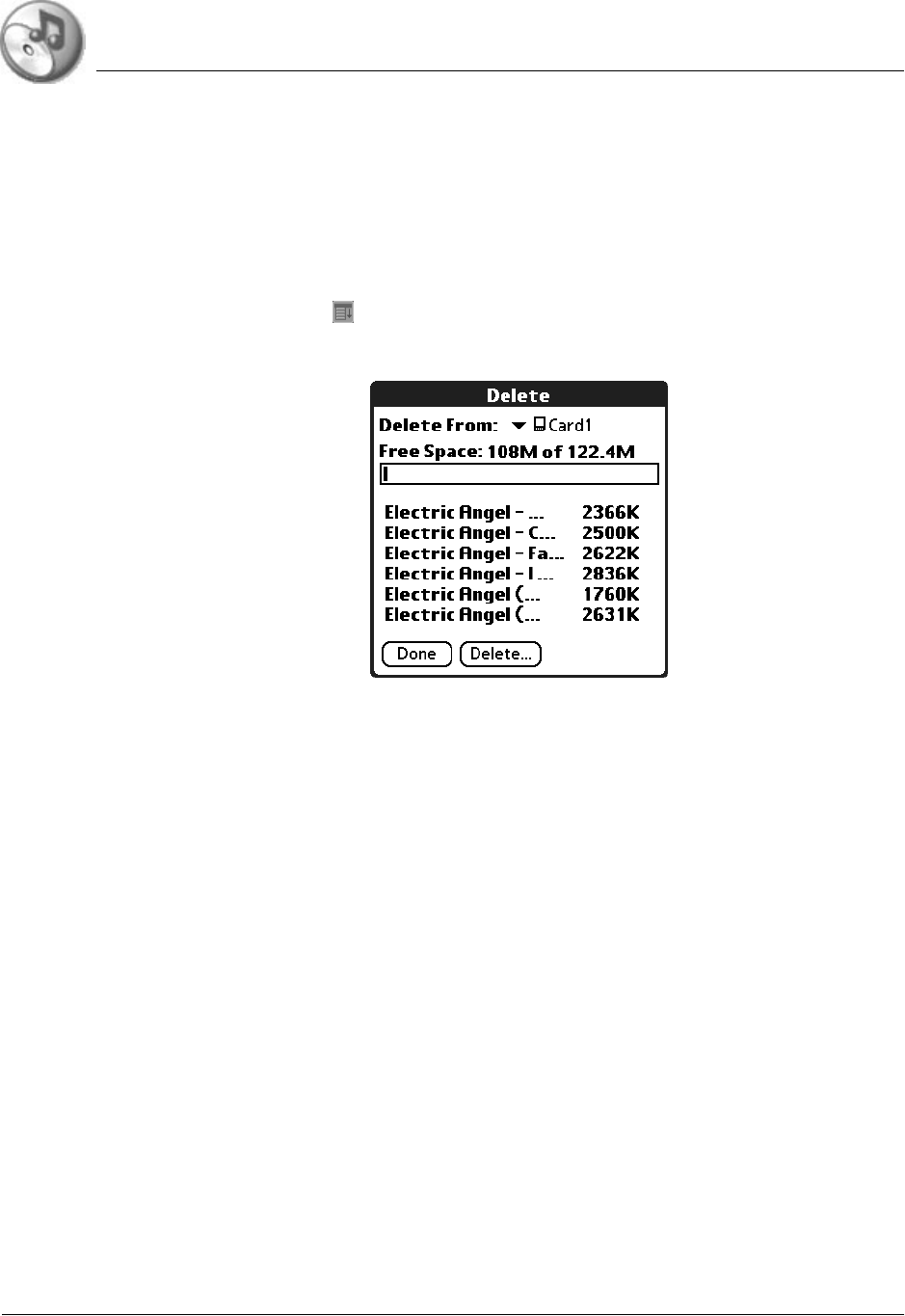
Using Music
Deleting songs
Using Your Zodiac Handheld 52
Deleting songs
When you delete a song, Music removes the song from your song list and
deletes the song file from your handheld or expansion card. If you also have a
copy of the song on your computer, it does not delete the copy on your
computer.
1. Tap the Menu icon .
2. From the Track menu, select Delete.
3. From the Delete From pick list, select the location of the song you want to
delete.
4. Highlight the song you want to delete, and then tap Delete.
5. Tap Yes to confirm deletion.
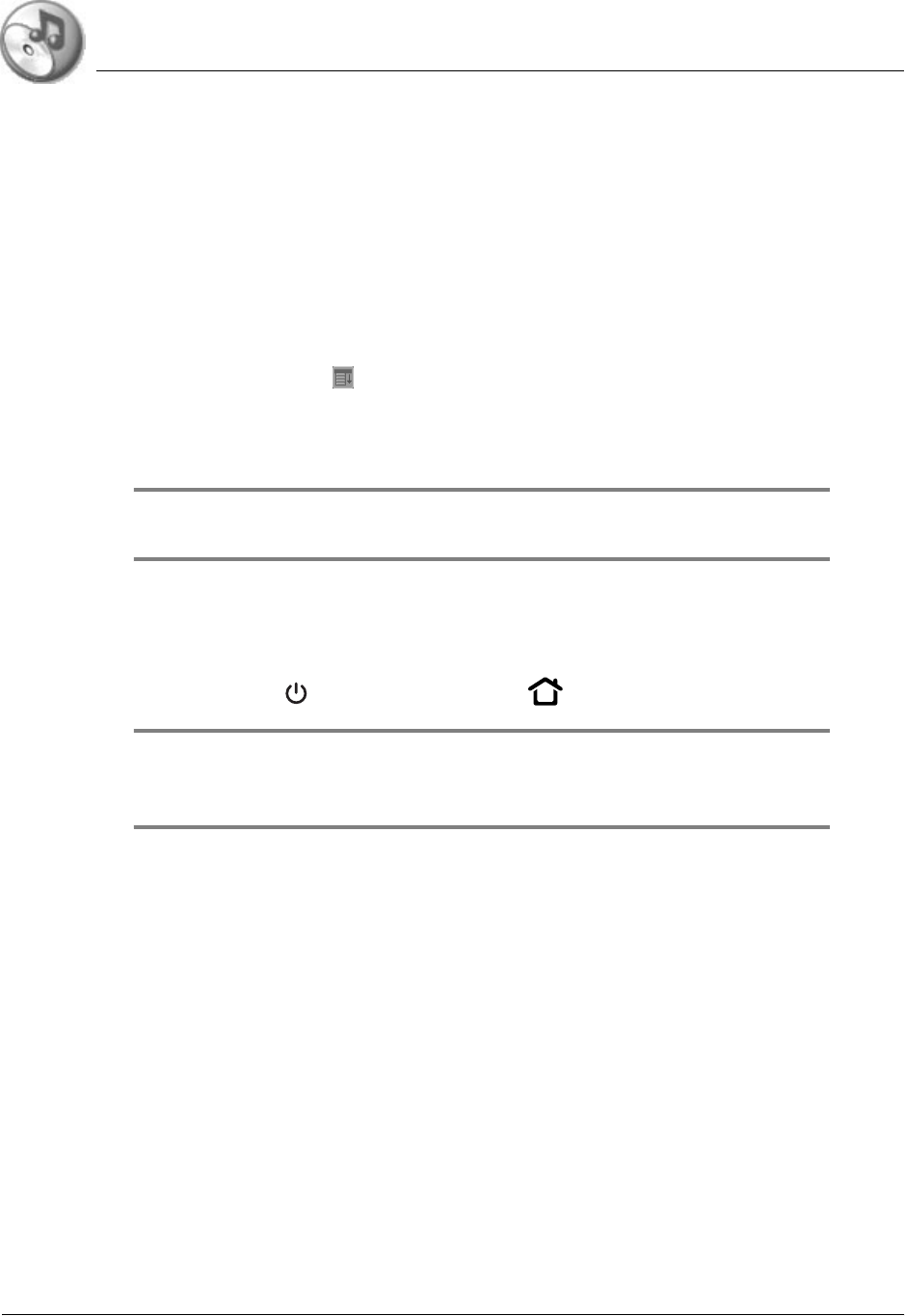
Using Music
Conserving power while playing songs
Using Your Zodiac Handheld 53
Conserving power while playing songs
When your handheld is not plugged into a power outlet, you can put your
handheld into a special power-saving Hold state to conserve battery power
while playing songs. In the Hold state, the screen and backlight turn off while
your songs continue to play.
If you forget to put your handheld in the Hold state, it automatically enters
this state if the auto-shutoff interval expires while you’re listening to a song.
1. Tap the Menu icon .
2. From the Options menu, select Hold.
The LED blinks slowly to indicate that the Hold state is active.
TIP: You can also activate the Hold state by simultaneously pressing the Left and
Right Trigger buttons.
3. After an hour, an alarm sounds. Tap Yes to keep your handheld in the
Hold state. If you do not respond, your handheld shuts off.
4. To return your handheld to the normal operating state, press either the
power button or the Home button .
TIP: You can also conserve power by listening to music through the headphones
or amplified external speakers instead of playing music through the internal
speakers.
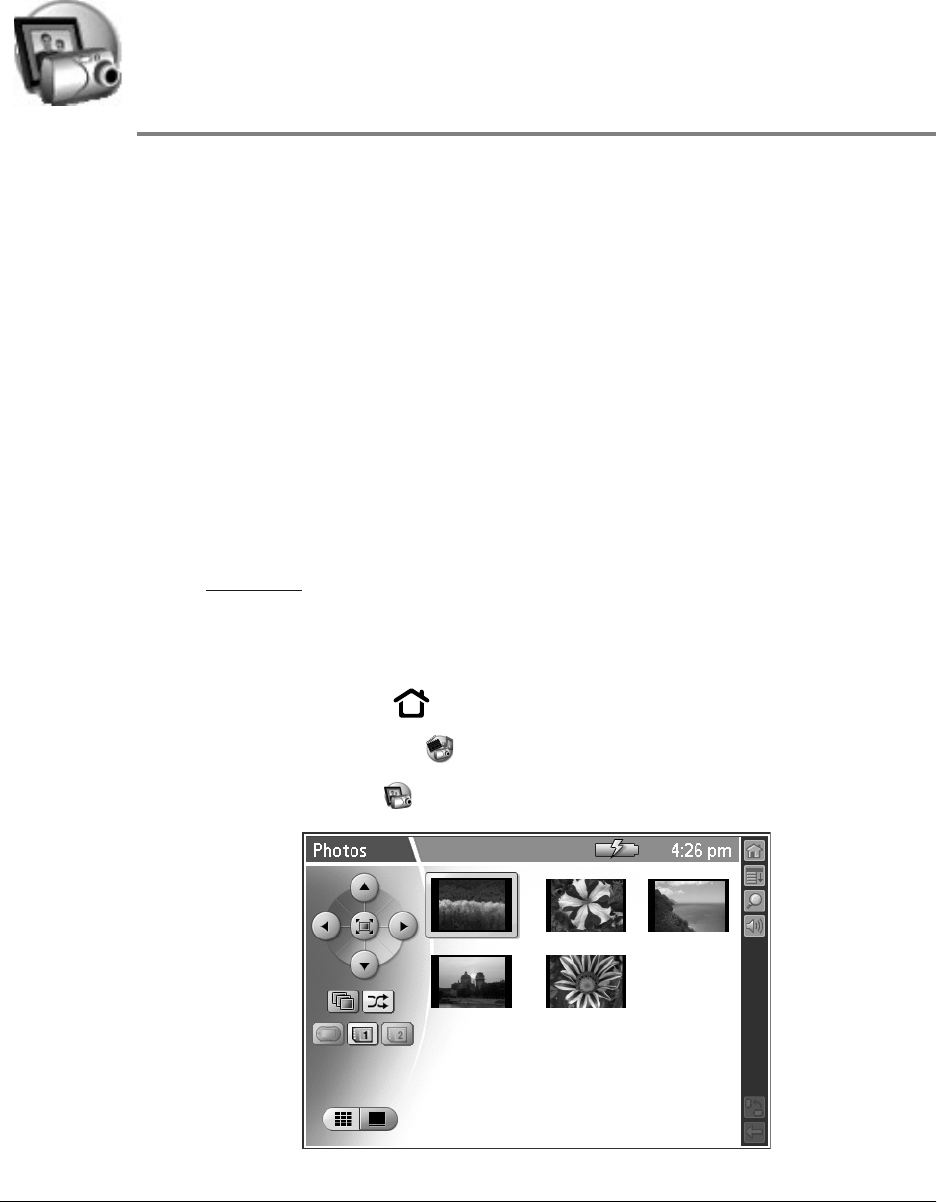
Using Your Zodiac Handheld 54
5
Using Photos
Photos provides a way to view and manage JPEG pictures files on your
handheld.
Use Photos to:
•View individual pictures stored on your handheld or an expansion
card.
•View pictures and create slide shows.
•Upload pictures from your computer to your handheld or an
expansion card.
•Update a picture list you created with the Photos component in Palm
Desktop software.
•Exchange pictures with friends and family. See the section that begins
on page 163 for details.
Opening Photos
1. Press the Home button .
2. Select the Media category .
3. Select the Photos icon .
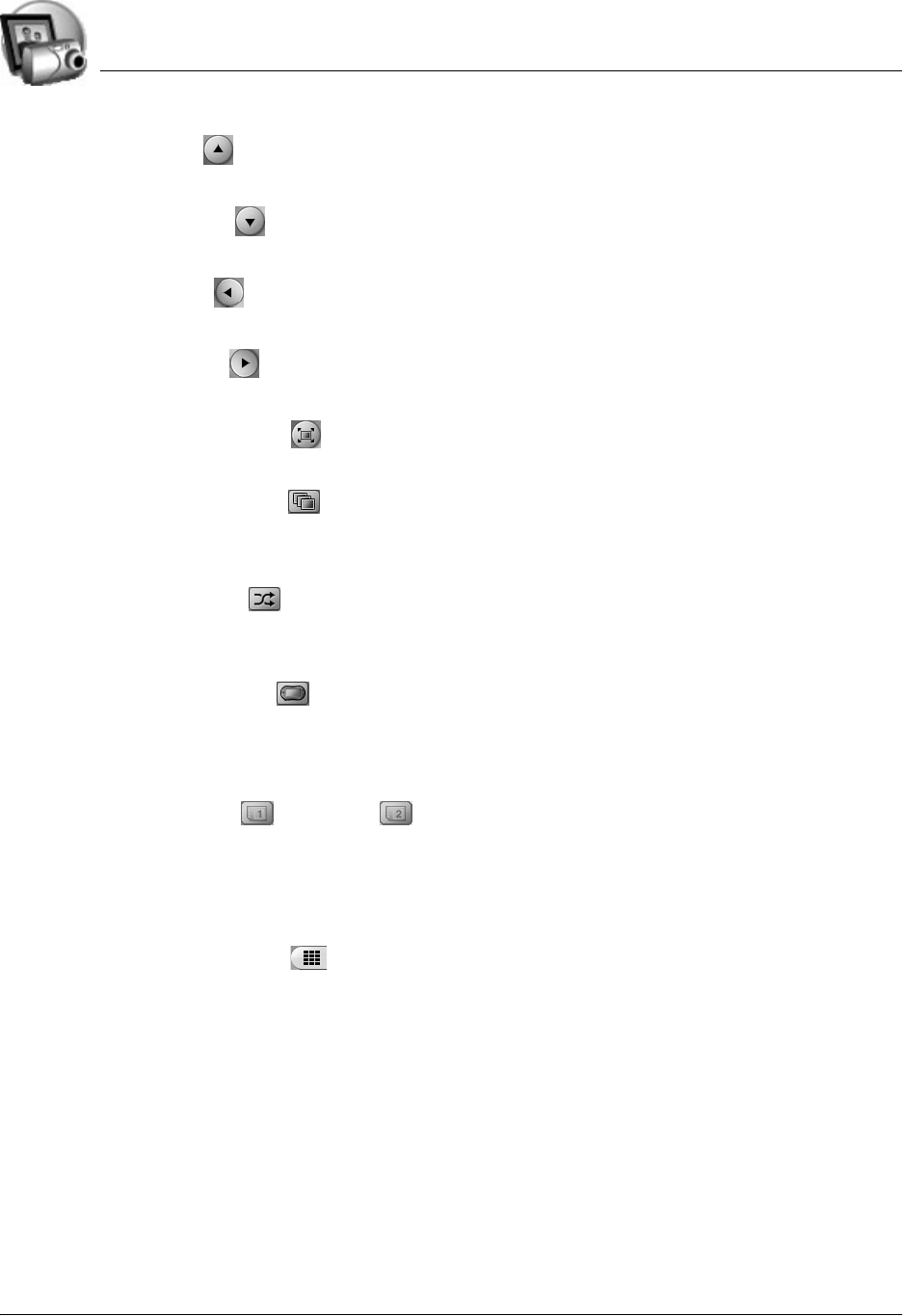
Using Photos
Opening Photos
Using Your Zodiac Handheld 55
•Up . Select the thumbnail above the current picture, or display the
previous picture in the sequence.
•Down . Select the thumbnail below the current picture, or display
the next picture in the sequence.
•Left . Select the thumbnail to the left of the current picture, or
display the previous picture in the sequence.
•Right . Select the thumbnail to the right of the current picture, or
display the next picture in the sequence.
•Full-Screen . View a full-screen image of the selected picture. To
exit Full-Screen mode, tap the screen or press Center.
•Slide Show . Begin a slide show. The pictures appear in Full-Screen
mode in the same sequence as the picture list. The slide show
automatically advances to the next picture after a preset interval.
•Shuffle . Select Shuffle to create a randomly ordered picture list
and slide show. Deselect Shuffle to return the pictures to their prior
order.
•Handheld . Select handheld to display pictures stored in the
internal memory on your handheld. If there are no pictures in internal
memory, then the button is inactive. You can display pictures on your
handheld and expansion cards at the same time.
•Card 1 or Card 2 . Select one of the Card buttons to display
pictures stored on an expansion card that is seated in an expansion
slot. If there are no pictures on the card seated in the expansion slot,
then the button is inactive. You can display pictures on your handheld
and expansion cards at the same time.
•Picture List . Display thumbnail images of all the pictures in the
selected locations. View the order in which pictures will appear in a
slide show. You can drag and drop pictures to arrange them in a
particular order, or use the Photos application on your computer to
create a picture list, and then synchronize your handheld with your
computer. See the Palm Desktop Online Help for details.
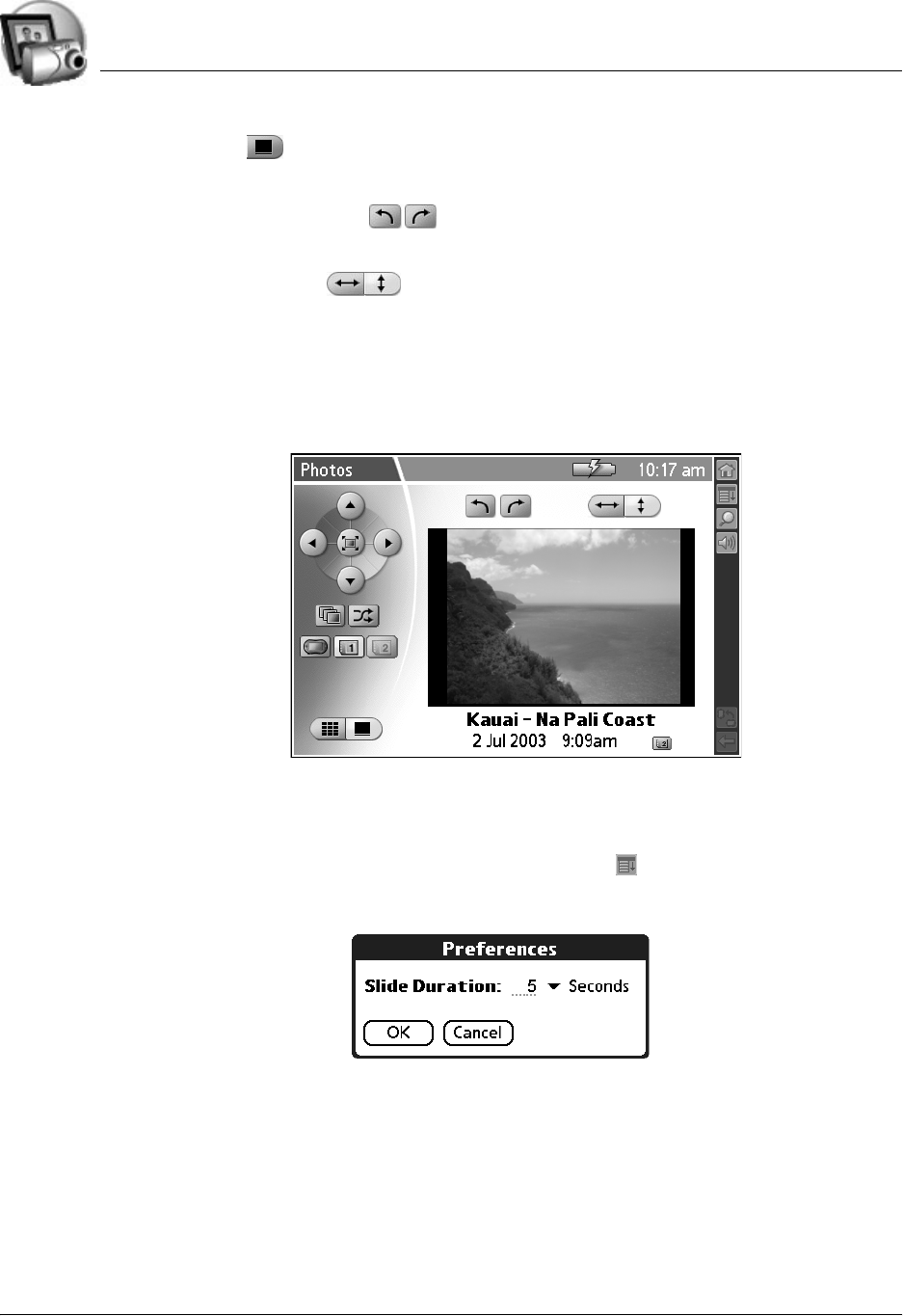
Using Photos
Setting the slide show interval
Using Your Zodiac Handheld 56
•Details . View the selected picture and the following information
and controls:
–Rotate controls . Rotate the picture in 90 degree
increments.
–Fit controls . Choose how the picture fits on the screen.
–Title. View the name of the picture file.
–Date/Time. View the date and time the picture was taken. This may
be different from the date associated with the picture file.
–Location. View an icon that indicates where the picture is stored.
Setting the slide show interval
1. From the list or detail view, tap the Menu icon .
2. From the Options menu, select Preferences.
3. From the Slide Duration pick list, select the interval unit: Seconds,
Minutes, or Hours.
4. Enter the interval length in the space next to the pick list.
5. Tap OK.
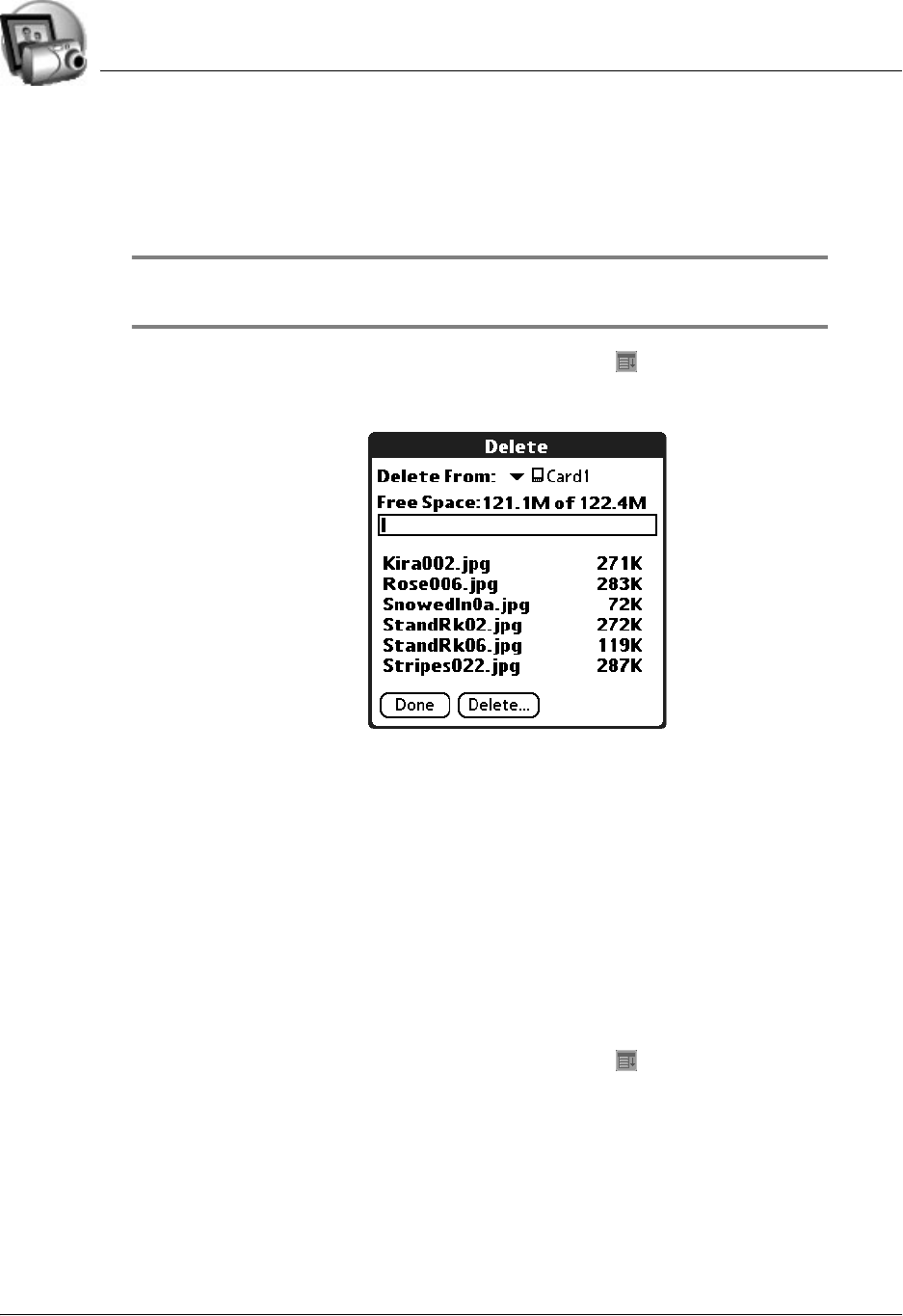
Using Photos
Deleting pictures
Using Your Zodiac Handheld 57
Deleting pictures
When you delete a picture, Photos removes the picture from your picture list
and deletes the file from your handheld or expansion card.
IMPORTANT: If you also have a copy of the picture on your computer, deleting
the picture from your handheld does NOT delete the copy on your computer.
1. From the list or detail view, tap the Menu icon .
2. From the Image menu, select Delete.
3. Select the picture you want to delete.
4. Tap Delete.
5. Tap Yes to confirm deletion.
6. Repeat steps 3 - 5 to delete other pictures.
7. Tap Done.
Copying pictures
You can copy pictures between your handheld and an expansion card.
1. From the list or detail view, tap the Menu icon .
2. From the Image menu, select Copy.
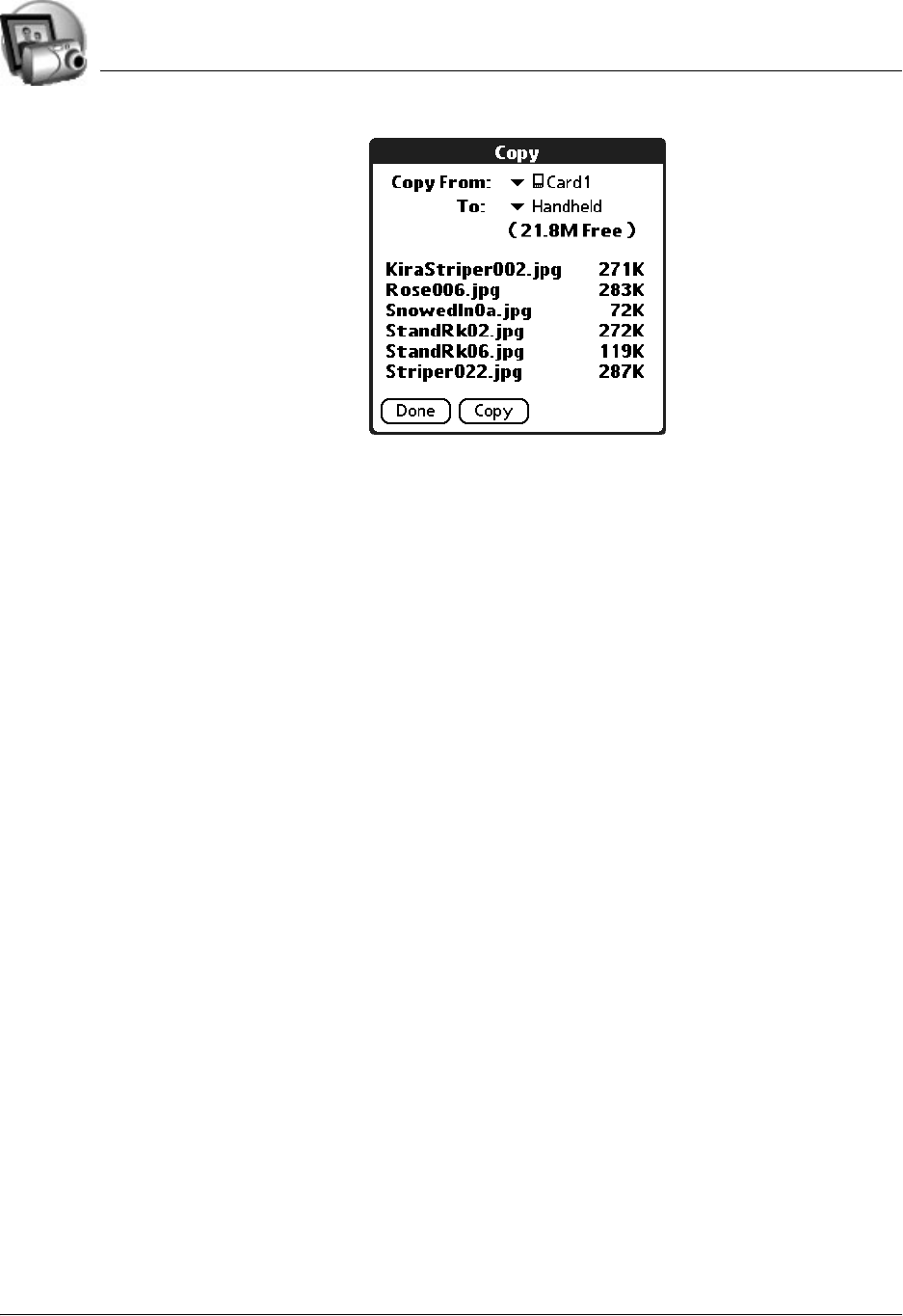
Using Photos
Copying pictures
Using Your Zodiac Handheld 58
3. From the Copy From pick list, select the location where the picture
currently resides.
4. From the Copy To pick list, select the location where you want to place the
picture.
5. Select the picture you want to copy.
6. Tap Copy.
7. Repeat steps 3 - 6 to copy other pictures.
8. Tap Done.

Using Your Zodiac Handheld 59
6
Playing Games
Your Zodiac handheld comes with these two great games:
•Stunt Car Extreme. Navigate hills, jumps and obstacles in this
outrageous 3-D racing game. Select from cockpit or behind the car
view, and choose from a quick race or play an entire season in our
championship mode. You can even see your stats track by track as
you progress in the game.
For complete documentation on this game, look for the .pdf file in the
Tapwave Extras\Bonus\Stunt Car Extreme\ folder on the
Zodiac CD.
•Acid Solitaire. This addictive game offers the best of interactive
solitaire for your on-the-go lifestyle. Supporting features such as an
easy-to-use drag and drop interface, two play modes, an advanced
statistic tracking model that follows eleven different game stats and a
sophisticated alert system that notifies you both when you are about
to run out of moves and when no moves are remaining. You can even
customize your background to have your own unique solitaire
experience.
For complete documentation on this game, look for the .pdf file in the
Tapwave Extras\Bonus\Acid Solitaire\ folder on the
Zodiac CD.
For information about installing additional games, see page 47. To learn about
playing games that are stored on expansion cards, see page 156.

Playing Games
Playing multi-player games
Using Your Zodiac Handheld 60
Playing multi-player games
The built-in Bluetooth radio provides you with a wireless, multi-player gaming
environment. When your handheld is within range of other Zodiac handhelds
or other devices enabled with Bluetooth technology that support the game
software, you can initiate or join a multi-player game session.
You can initiate a session as follows:
1. Launch the game. See page 41 for details.
2. Select multi-player mode as described in the game documentation.
This should initiate the discovery process on your handheld.
3. Instruct all players to press the Bluetooth button to make their
handhelds discoverable.
When a Zodiac handheld is in this state, the Bluetooth LED flashes.
4. When the Discovery Results screen appears, select the players you want
to include in the game, and then tap OK.
This should send an invitation message to the selected players’
handhelds.
5. Instruct the players to tap Yes to join the game.
6. When the game is over, press and hold the Bluetooth button to turn off
the Bluetooth radio.
For additional information about using the Bluetooth features of your
handheld visit tapwave.com.
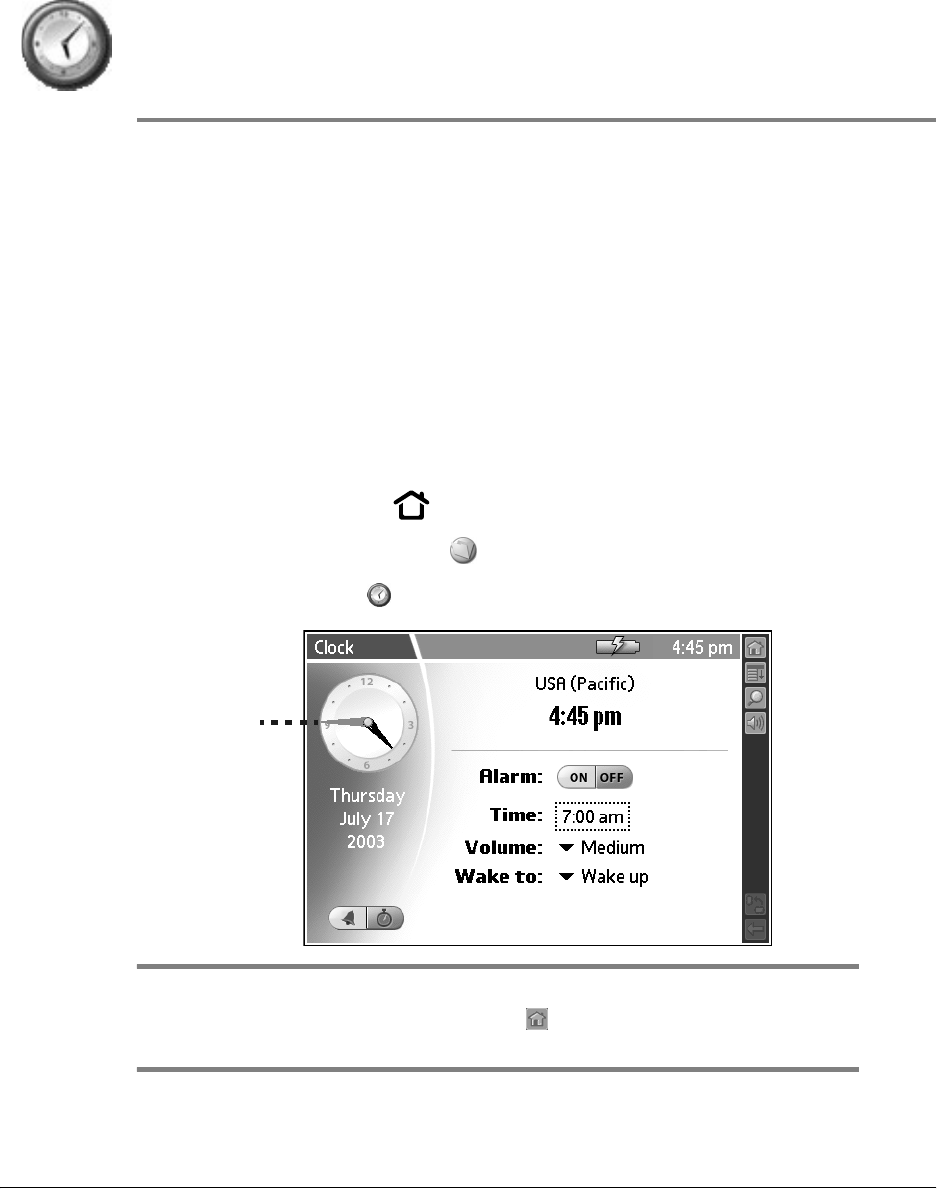
Using Your Zodiac Handheld 61
7
Using Clock
Clock provides an easy-to-read time display, an alarm clock, a stopwatch, and
a timer.
Use Clock to:
•Set an alarm that is not related to a specific entry on your handheld.
•Determine how long it takes to complete a task or event.
•Receive a notification when the specified time period elapses.
Opening Clock
1. Press the Home button .
2. Select the My Stuff category .
3. Select the Clock icon .
TIP: To set the time and date, select Set Time & Date from the Options menu. To
change the time and date format, tap Home , select the Prefs category, and then
select Formats.
Analog clock
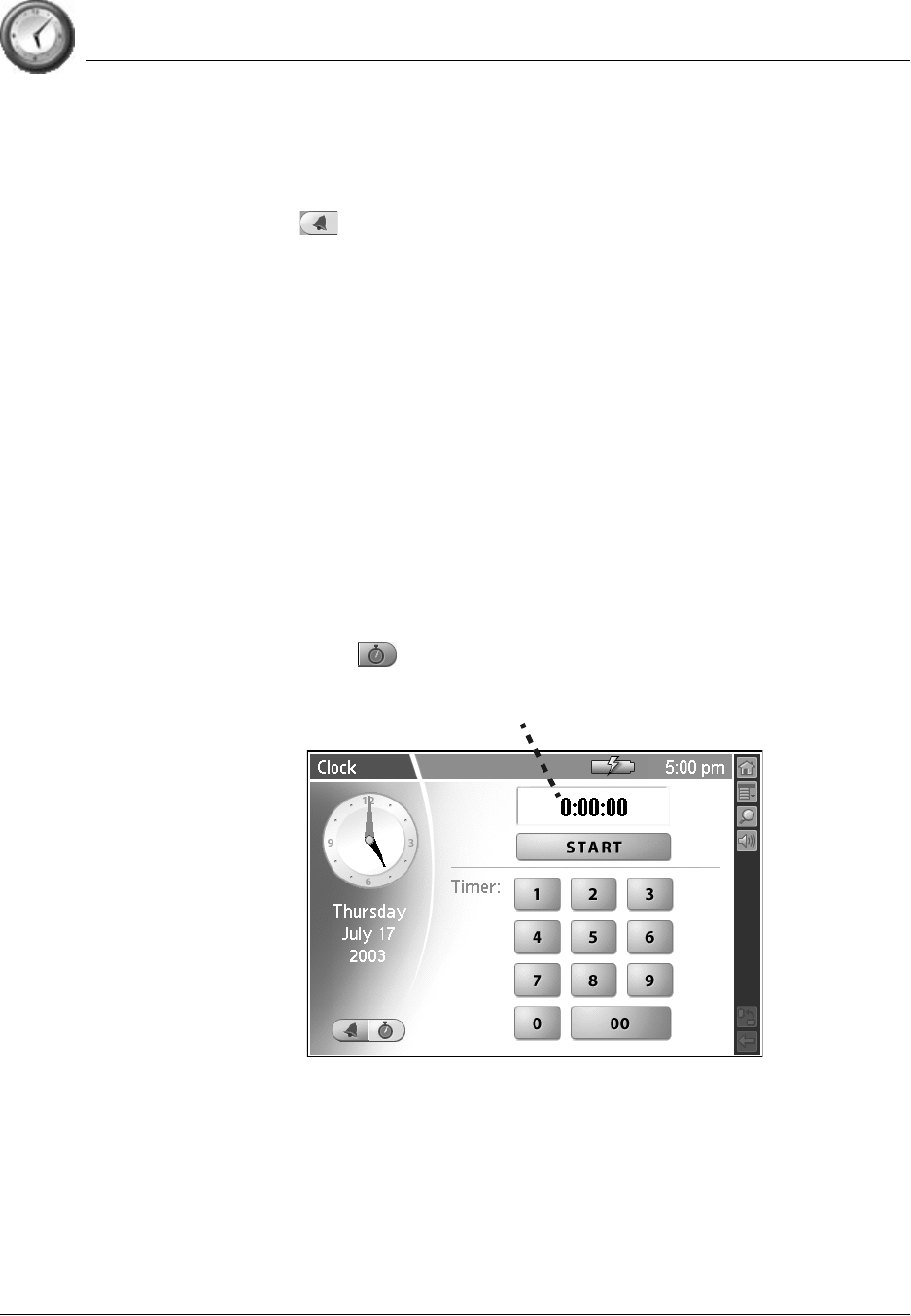
Using Clock
Opening Clock
Using Your Zodiac Handheld 62
•Analog Clock. View the current time in analog format.
•Date. View the current date.
•Time/Alarm . View the time in digital format and access the
following alarm controls:
–Alarm On. Turn on the alarm and display the alarm controls.
–Alarm Off. Turn off the alarm and hide the alarm controls.
–Time. Set the time when you want the alarm to sound. When you
tap this box, a number pad appears. Tap the numbers to select the
time you want the alarm to sound, and then tap OK.
–Volume. Select the volume level for the alarm sound. The choices
are: Low, Medium, High, and Ascending. The Ascending setting
increases from low to high volume over a period of about 20
seconds.
–Wake To. Select the alarm sound. Options include Music, Alarm,
Alert, Bird, Concerto, Phone, Sci-fi, and Wake Up. If you select Music,
you can select a song from the Music application.
•Timer/Stopwatch . Access the following timer and stopwatch
controls:
–Display. View the time remaining in timer mode, and the elapsed
time in stopwatch mode. The time displays in 1/100th of a second
increments.
–Start. Begin the timer or stopwatch. When you tap this button, it
changes to a Stop button.
Display

Using Clock
Opening Clock
Using Your Zodiac Handheld 63
–Stop. Pause the timer or stopwatch. When you tap this button, it
changes to a Resume button and a Reset button appears next to
the Display. If you are done timing the current task, tap Reset to
return the display to all zeros.
–Resume. Restart the timer of stopwatch to continue timing a task.
When you tap this button it changes to a Stop button.
–Timer. Set a timer to notify you know when a particular amount of
time has passed. To set the timer, tap the number pad to indicate
the time period you want to monitor, such as a 3-minute egg or a
half-hour pizza delivery. When the time period elapses, the
selected alarm sound plays and a notification screen appears. You
can set the timer sound by selecting Preferences from the Options
menu.
TIP: You can also stop or resume the timer or stopwatch by pressing the Right
Trigger button.

Using Your Zodiac Handheld 64
8
Performing Common Tasks
There are many tasks that are common to the applications found in the
Organizer category. These common tasks are described in this section. We use
the term records as a generic term that refers to an individual item in an
application, for example, a single Date Book event, an Address Book entry, a
To Do List item, or a Memo Pad memo.
Creating records
You can use the following procedure to create a new record in Date Book,
Address Book, To Do List, and Memo Pad.
1. Open the application in which you want to create a record.
2. Tap New.
3. (Date Book only) Select start and end times for your appointment and
tap OK.
4. Enter text for the record.
NOTE: The handheld automatically capitalizes the first letter of each field (except
numeric and e-mail fields).
5. (Optional) Tap Details to select attributes for the record.
6. (Address Book and Memo Pad only) Tap Done.
Your handheld saves the new record automatically.
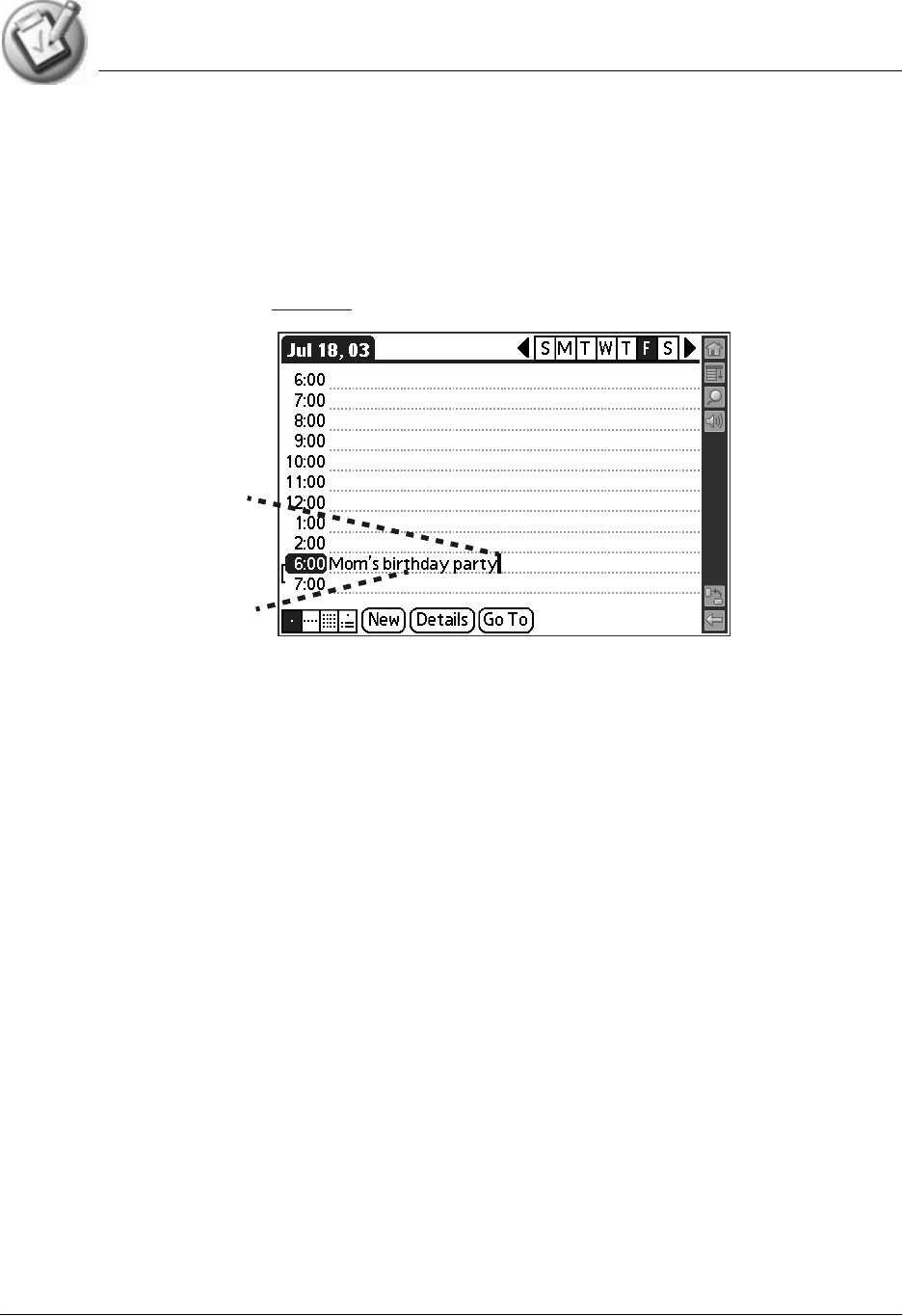
Performing Common Tasks
Editing records
Using Your Zodiac Handheld 65
Editing records
After you create a record, you can change, delete, or add new information at
any time. When the screen is in edit mode, a blinking cursor appears within
the information, and the information appears on a dotted line called an edit
line. You can then enter text in any of the ways described in the chapter
beginning on page 30.
Selecting Text
Select the text you want to edit using one of the following techniques:
•Double-tap a word in a field to select the word.
•Triple-tap any word on a line to select the entire line.
•Drag across a line of text to select some or all of the information, or
drag down to select text across multiple lines.
Using the Edit menu
The Edit menu is available from any screen where you enter or edit text. As a
general rule, the Edit menu commands affect selected text. Any of the
following commands may appear in the Edit menu, depending on the
application you’re using:
•Undo. Reverses the last action taken.
•Cut. Removes a selection from its current location to memory. You can
then paste the text into another area of the current application or into
a different application.
Edit line
Cursor

Performing Common Tasks
Deleting records
Using Your Zodiac Handheld 66
•Copy. Copies a selection and moves it to memory. You can paste the
selection into another area of the current application or into a different
application.
•Paste. Inserts a selection from memory into an area you select. Paste
produces no result if you have not used the Cut or Copy commands.
•Select All. Selects all the text in the current record or screen.
•Keyboard. Opens the onscreen keyboard. Tap Done to close the
keyboard.
•Graffiti 2 Help. Opens the Graffiti 2 character stroke screen.
Deleting records
You can delete records in any of the Organizer applications.
1. Select the record you want to delete.
2. Do one of the following:
•From the Record menu, select Delete. The Delete command differs
depending on the application you’re using, for example, Delete Event
appears in the Record menu in Date Book, and Delete Item appears in
To Do List.
•In the Details dialog box of the application, tap Delete, and then tap
OK.
•Delete the text of the record.
NOTE: In Date Book, deleting the text of a repeating event deletes all instances of the
event.
•In the Input Area, drag a diagonal line from the lower left to upper
right to display the Command toolbar; then tap the Delete icon or
draw a Graffiti 2 D in the text area.
A confirmation dialog box appears.
Delete icon

Performing Common Tasks
Purging records
Using Your Zodiac Handheld 67
3. To archive a copy of the deleted file on your PC during the next HotSync
operation, check the Save Archive box.
4. Tap OK to delete the record.
Purging records
Over time, as you use Date Book and To Do List, you may accumulate records
that are no longer useful. For example, events that occurred months ago
remain in Date Book, and completed To Do List items remain in the list.
Outdated records take up memory on your handheld, so it’s a good idea to
remove them by using Purge. If you think Date Book or To Do List records
might prove useful later, you can purge them from your handheld and save
them in an archive file.
Purging is not available in Address Book or Memo Pad; delete records from
these applications manually.
1. Open the application from which you want to purge records.
2. Tap the Menu icon .
3. From the Record menu, select Purge.
4. From the confirmation dialog box, do the following:
•Date Book. Select an option from the Delete Events Older Than pick
list —1 week, 2 weeks, 3 weeks or 1 month.
•Date Book and To Do list. Check the Save Archive Copy on PC box to
save a copy of purged records in an archive file on your desktop. The
records are transferred the next time you perform a HotSync
operation.
5. Tap OK.
Categorizing records
You can categorize records in Address Book, To Do List, and Memo Pad for
easy retrieval (Date Book does not have categories). When you create a record,
it is automatically assigned to the current category. For example, if you are in
the All category, the record goes in the Unfiled category. A record can remain
unfiled or it can be assigned to a category at any time.

Performing Common Tasks
Categorizing records
Using Your Zodiac Handheld 68
Each application has a default set of categories:
•Address Book includes a Business, Personal, and QuickList category.
•To Do List includes a Business, Personal, and All category.
•Memo Pad includes a Business, Personal, and All category.
You can rename or delete the default categories, and you can create new
categories. Each application can have up to 15 categories.
Moving a record into a category
1. Select the record you want to categorize.
2. Tap Details (from the Address View screen, tap Edit first).
3. From the Category pick list, select the desired category.
4. Tap OK.
Displaying a category of records
1. Open one of the following applications: Address Book, To Do List, or
Memo Pad application.
2. From the pick list in the upper-right corner, select the category you want
to display.
Tap pick list Select a category
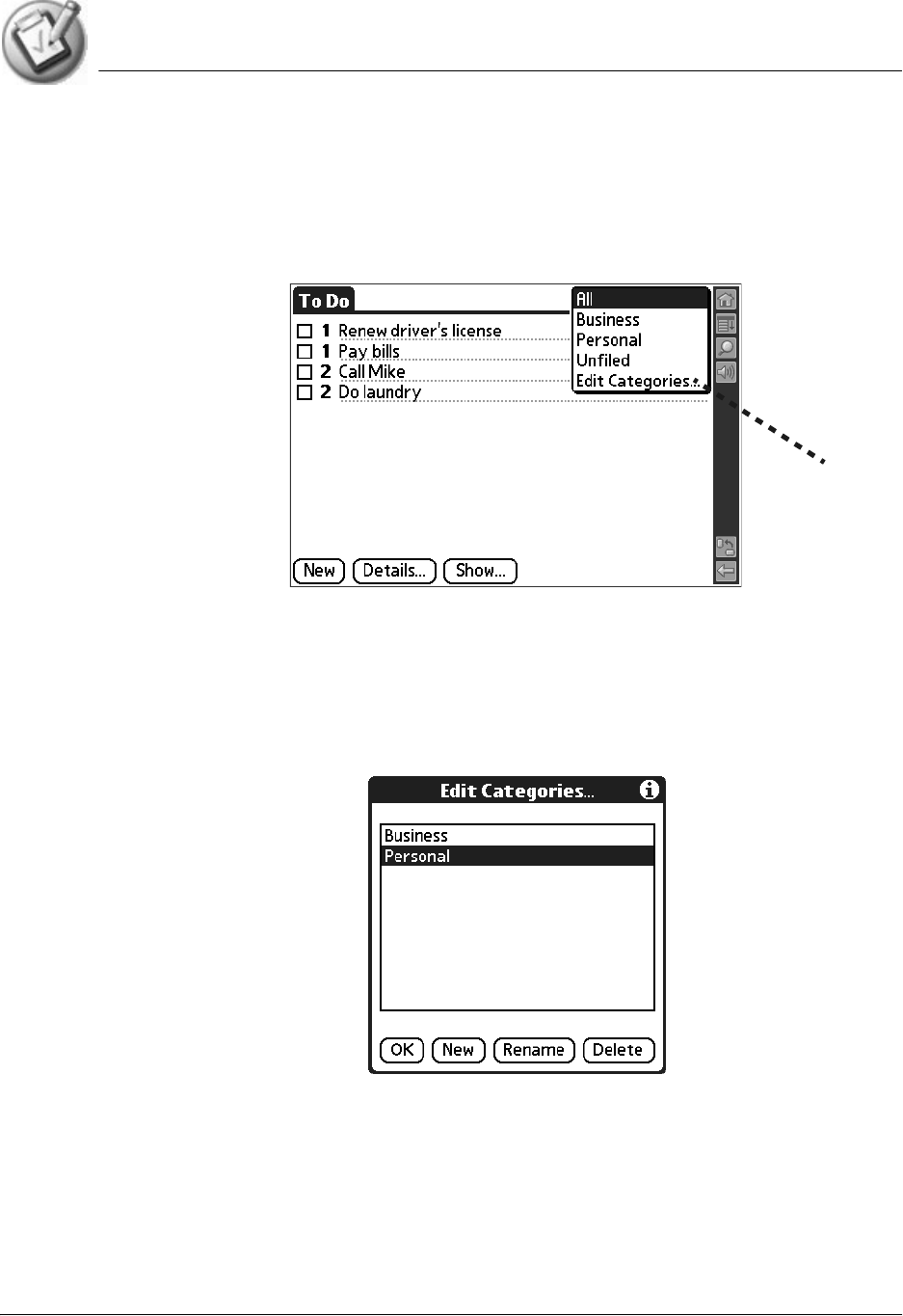
Performing Common Tasks
Categorizing records
Using Your Zodiac Handheld 69
Adding or editing categories
1. In Address Book, To Do List, or Memo Pad application, choose from the
following options:
•From the pick list in the upper-right corner, select Edit Categories.
•In Address Book, select a record, tap Edit, and then tap Details. From
the Category pick list, select Edit Categories.
•In Memo Pad and To Do List, select a record from the list, and tap
Details. From the Category pick list, select Edit Categories.
2. Select any of the following options:
•To create a new category, tap New, and enter a new name in the Input
Area. Tap OK.
•To rename a category, tap it in the list to select it. Tap Rename, enter a
new name in the Input Area, and tap OK.
Edit Categories
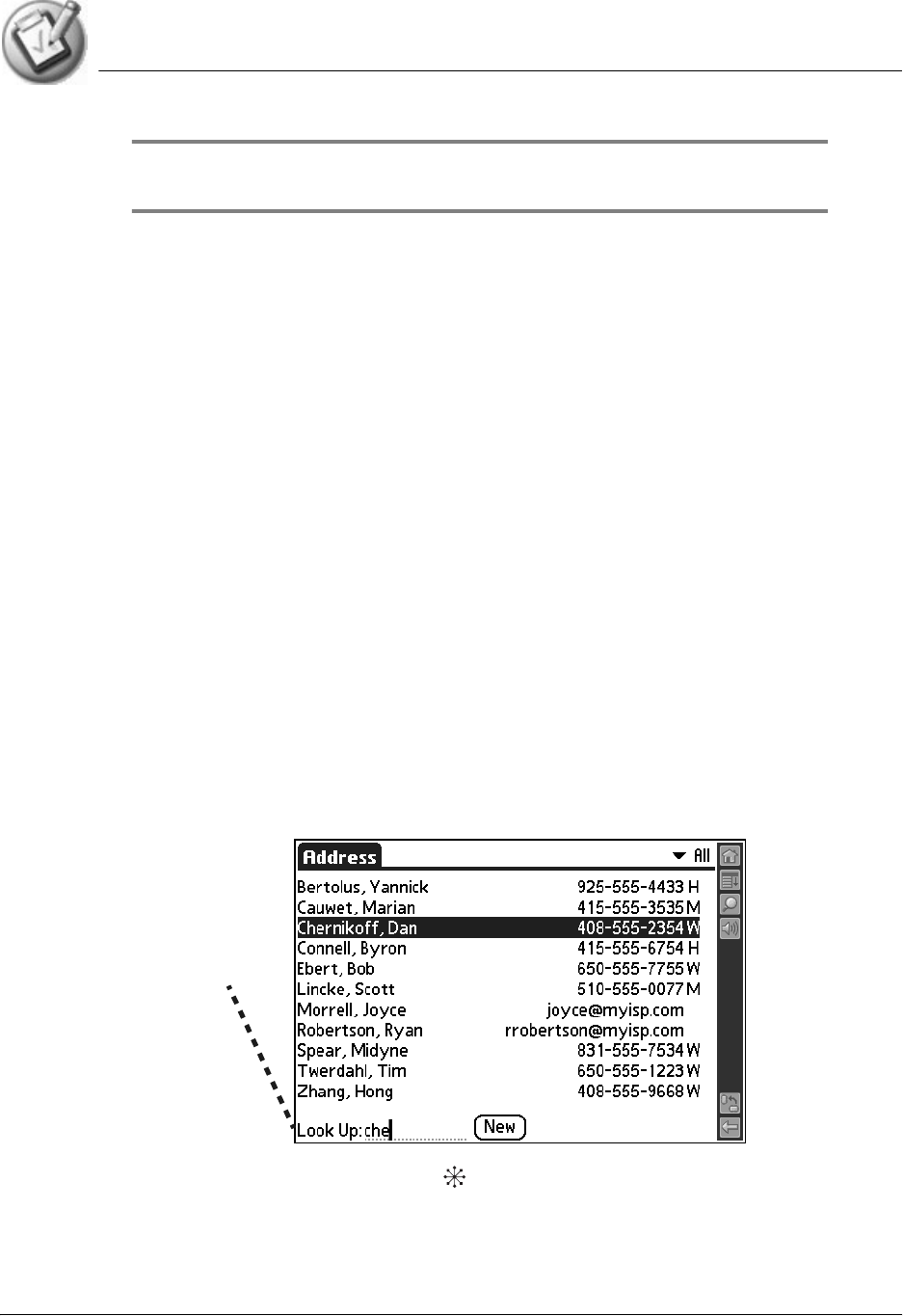
Performing Common Tasks
Finding records
Using Your Zodiac Handheld 70
TIP: You can move records from multiple categories into a single category by
renaming all discrete categories with a single category name.
•To delete a category, tap it in the list to select it. Tap Delete.
3. Tap OK.
Finding records
Your handheld provides several ways to find information:
•In all applications, starting with the current application, you can use
the Find dialog box to locate the selected text.
•In Date Book, To Do List, and Memo Pad, you can use Phone Lookup to
display the Address List screen and add the information from this list
to a record.
•In Address Book, you can use the Look Up option to enter the first
letters of a name to scroll immediately to that name.
Finding Address Book records
1. Do one of the following:
•From the Address screen, enter the first few letters of the name you
want to locate.
•Move the analog controller to scroll to a name. Holding down the
analog controller accelerates scrolling.
Look Up line
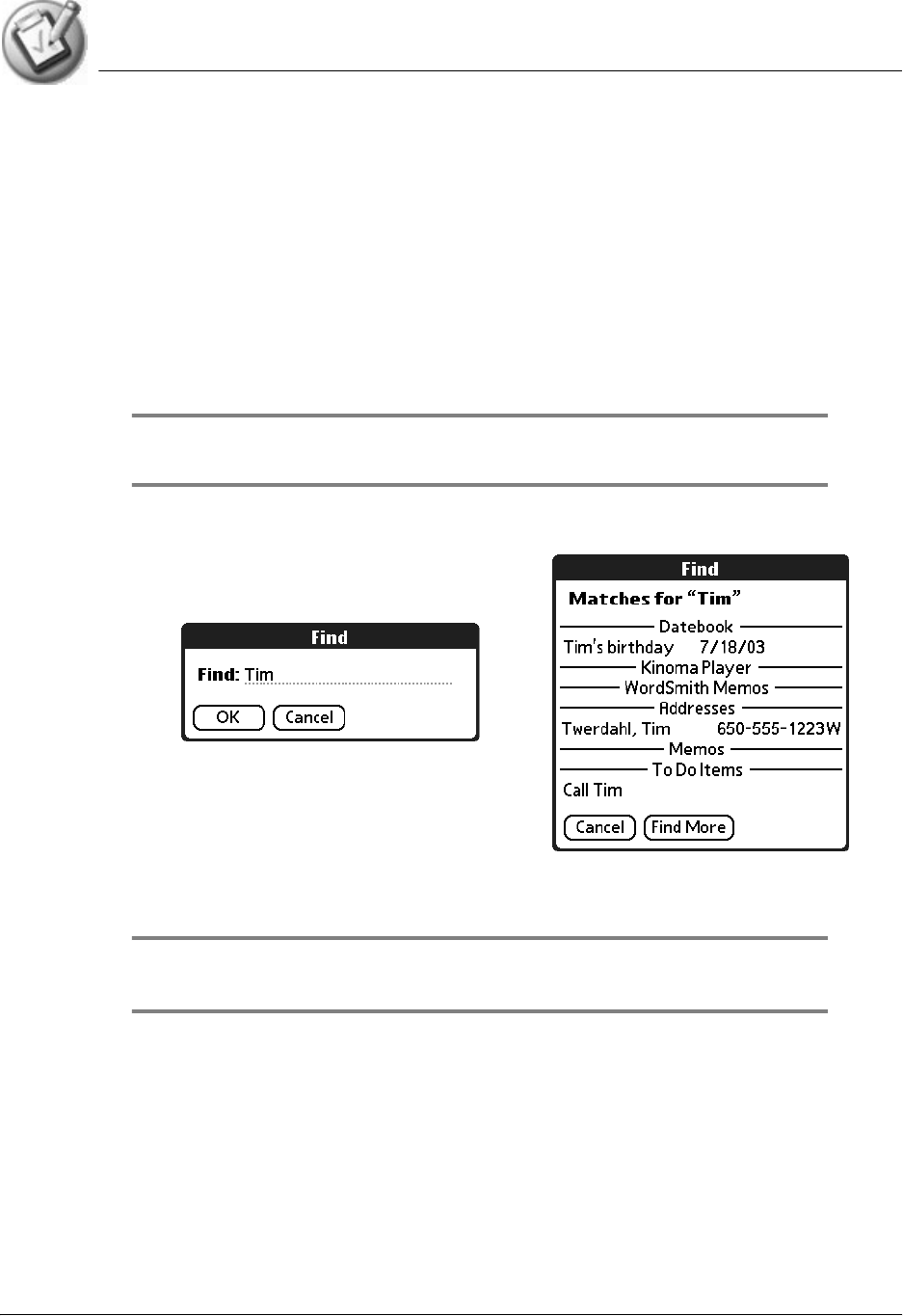
Performing Common Tasks
Finding records
Using Your Zodiac Handheld 71
Using the Find dialog box
The Find dialog box helps you locate text in any or all applications. For
example, if the text “dog” appears in Address Book and Date Book, the Find
dialog box displays both occurrences.
1. Tap the Find icon.
2. Enter the text you want to find; then tap OK.
Note that the Find option is not case sensitive; searching for "davidson"
also finds "Davidson."
TIP: Select text in an application before tapping Find to automatically place the
text in the Find dialog box.
Find searches for the text in all records and all notes within all applications.
As your handheld searches for the text, you can tap Stop to stop the search at
any time. To continue the search after tapping Stop, tap Find More.
NOTE: Find locates all matches that begin with the supplied text. It does not find words
where the supplied text appears in the middle or at the end of a word.
Using Phone Lookup
The Phone Lookup option lets you add a telephone number from the Address
list to an entry in another application. For example, you can add your dentist’s
telephone number to your dental appointment date in Date Book.
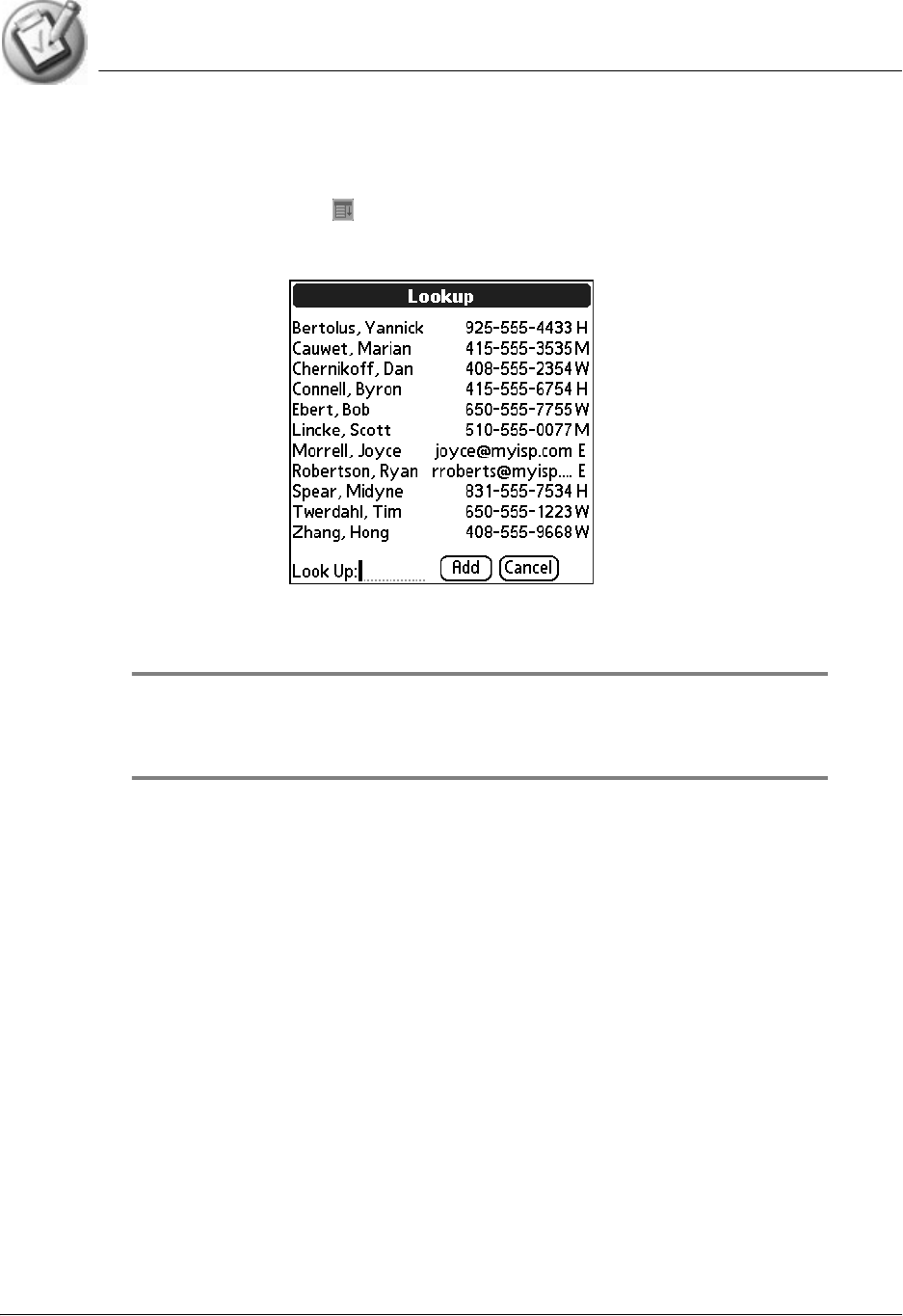
Performing Common Tasks
Sorting records
Using Your Zodiac Handheld 72
1. In Date Book, To Do List, or Memo Pad, display the record in which you
want to insert a phone number.
2. Tap the Menu icon .
3. From the Options menu, select Phone Lookup.
4. Select a record or write the first few letters of the name you want to add.
Tap Add to add the information to the record.
NOTE: You can also search based on selected text. Drag to highlight the text, then
follow step 3 above. When the search is complete, the name and phone number of the
candidate replaces the selected text.
Sorting records
You can sort lists of records in various ways, depending on the application.
Sorting is available in applications that display lists—in Address Book, To Do
List, and Memo Pad.
Sorting To Do List records
1. Open the application to display the list screen.
2. Tap Show.
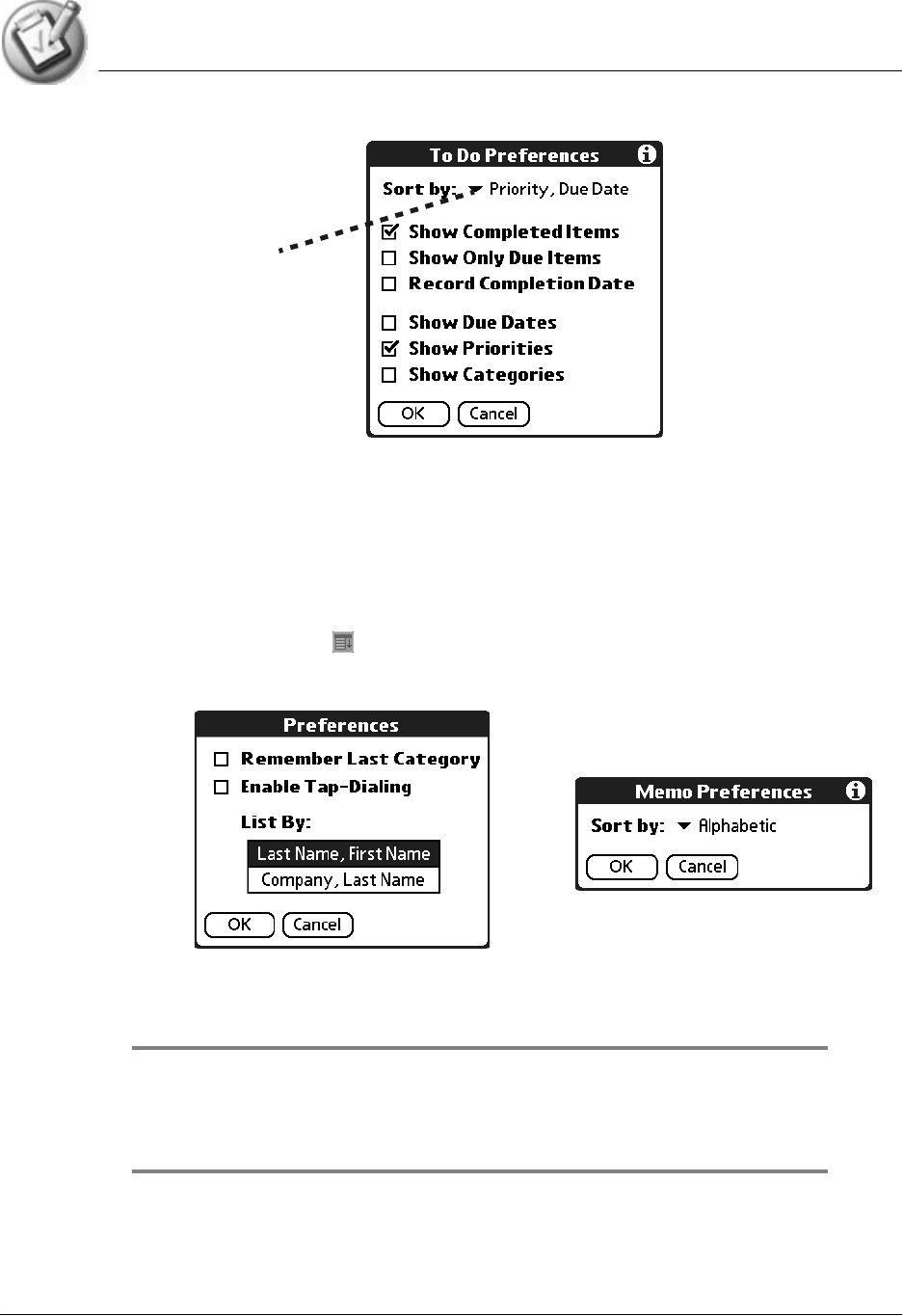
Performing Common Tasks
Sorting records
Using Your Zodiac Handheld 73
3. From the Sort By pick list, select an option.
4. Tap OK.
Sorting Address Book and Memo Pad records
1. Open the application to display the list screen.
2. Tap the Menu icon .
3. From the Options menu, select Preferences.
4. In the Preferences dialog box, tap the option you want, and then tap OK
to sort the list.
TIP: You can also manually arrange the Memo list by tapping and dragging a
memo to a new location in the list. To display the list of your memos on your
computer as you arranged them manually on your handheld, open Memo Pad in
Palm Desktop software click List By, and select Order on Handheld.
Sort By
pick list
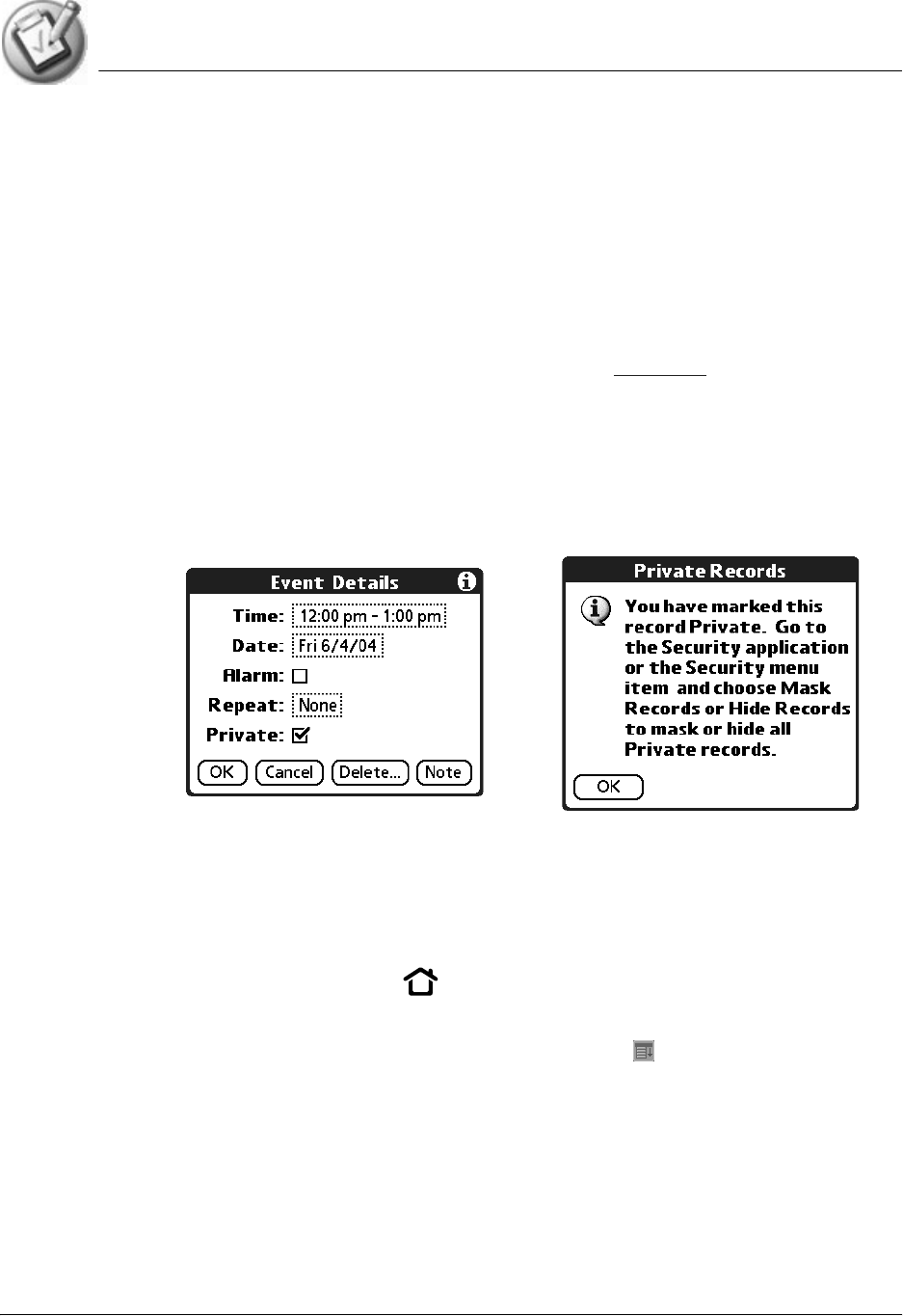
Performing Common Tasks
Making records private
Using Your Zodiac Handheld 74
Making records private
In most applications (except Mail), you can make individual records private.
Private records can be either masked or hidden. Private records remain visible
and accessible until you select a security setting to Hide records. Private
record names are covered with a gray bar when the security setting is set to
Mask records.
If you assigned a password to your handheld, you must enter it before private
records are displayed. For more information, see page 148.
1. In your application, do one of the following:
•Create a new record and tap Edit, and then tap Details.
•Select an existing record, and tap Details.
2. Check the Private box. Tap OK.
3. At the alert in the Private Records dialog box, tap OK.
Hiding private records
1. Do one of the following:
•Press the Home button , select the Utilities category, and then
select Security.
•From within an application, tap the Menu icon , and from the
Options menu, select Security.
•From within any application, draw the Menu command stroke to bring
up the Command Bar and tap the padlock icon.
2. From the Current Privacy pick list in the Change Security dialog box,
select Hide Records.
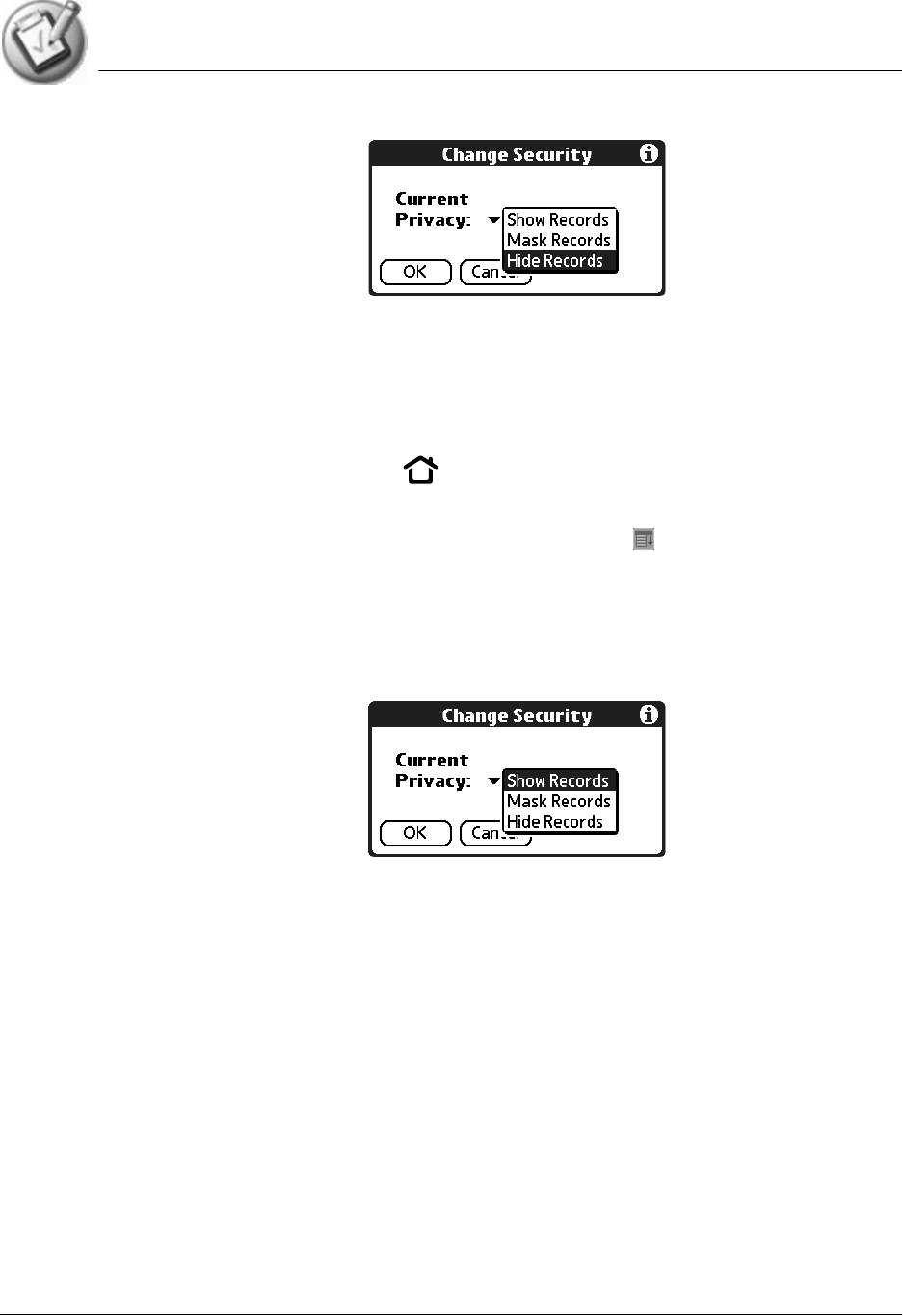
Performing Common Tasks
Attaching notes
Using Your Zodiac Handheld 75
3. Tap OK.
Displaying private records
1. Do one of the following:
•Press the Home button , select the Utilities category, and then
select Security.
•From within an application, tap the Menu icon , and from the
Options menu, select Security.
•From within any application, draw the Menu command stroke to bring
up the Command Bar and tap the padlock icon.
2. From the Current Privacy pick list, select Show Records.
3. If you assigned a password, enter it.
4. Tap OK.
Attaching notes
You can attach notes to records in all the Organizer applications except Memo
Pad. A note can be up to several thousand characters long.
1. Display the entry to which you want to add a note.
2. (Address Book only) Tap Edit.
3. Tap Details.
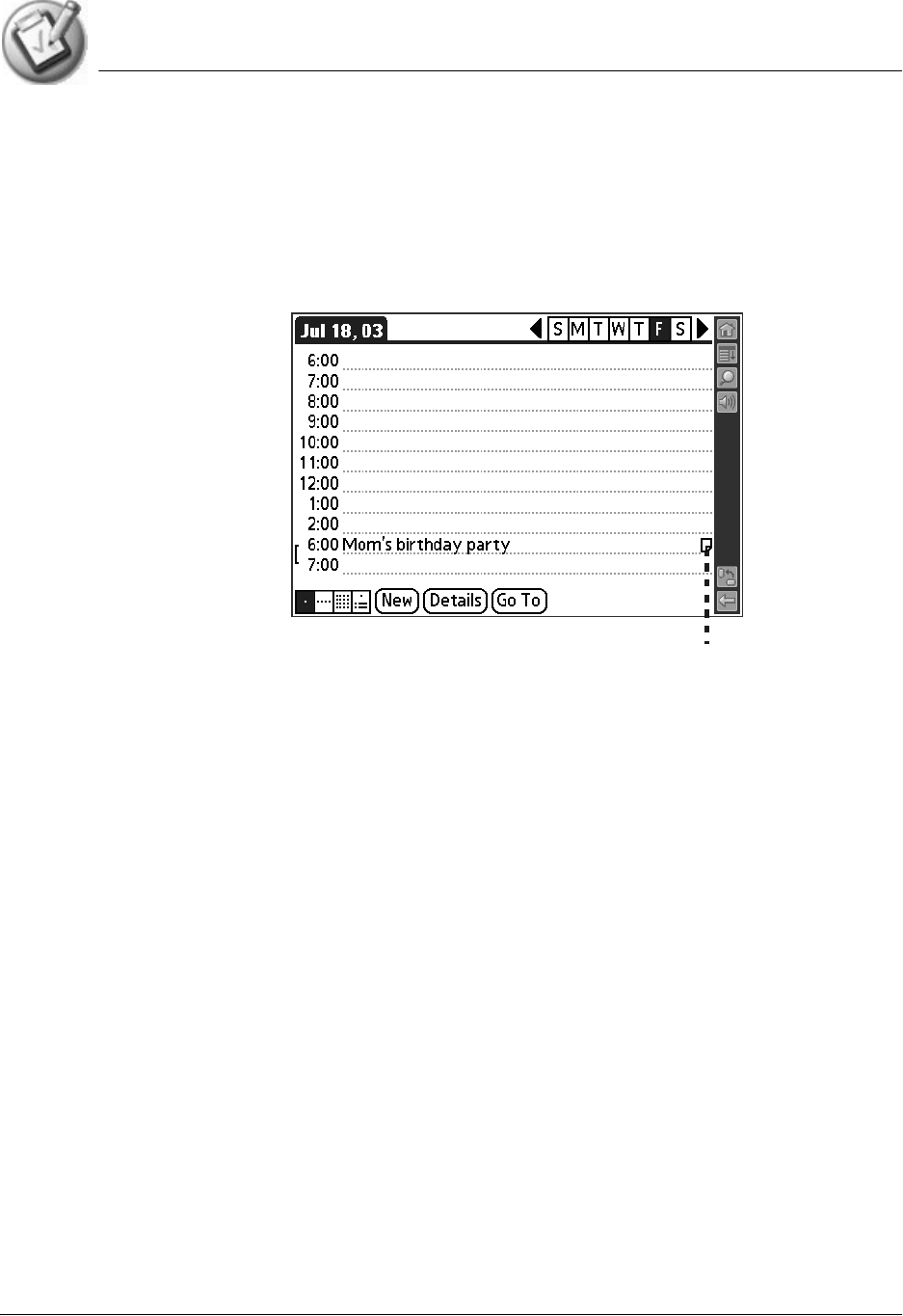
Performing Common Tasks
Attaching notes
Using Your Zodiac Handheld 76
4. Tap Note.
5. Enter the desired note.
6. Tap Done.
A note icon appears to the right of any item containing a note. To review or
edit a note, tap the note icon.
Deleting a note
1. Tap the note icon.
2. Tap Delete.
3. Tap Yes.
Note icon
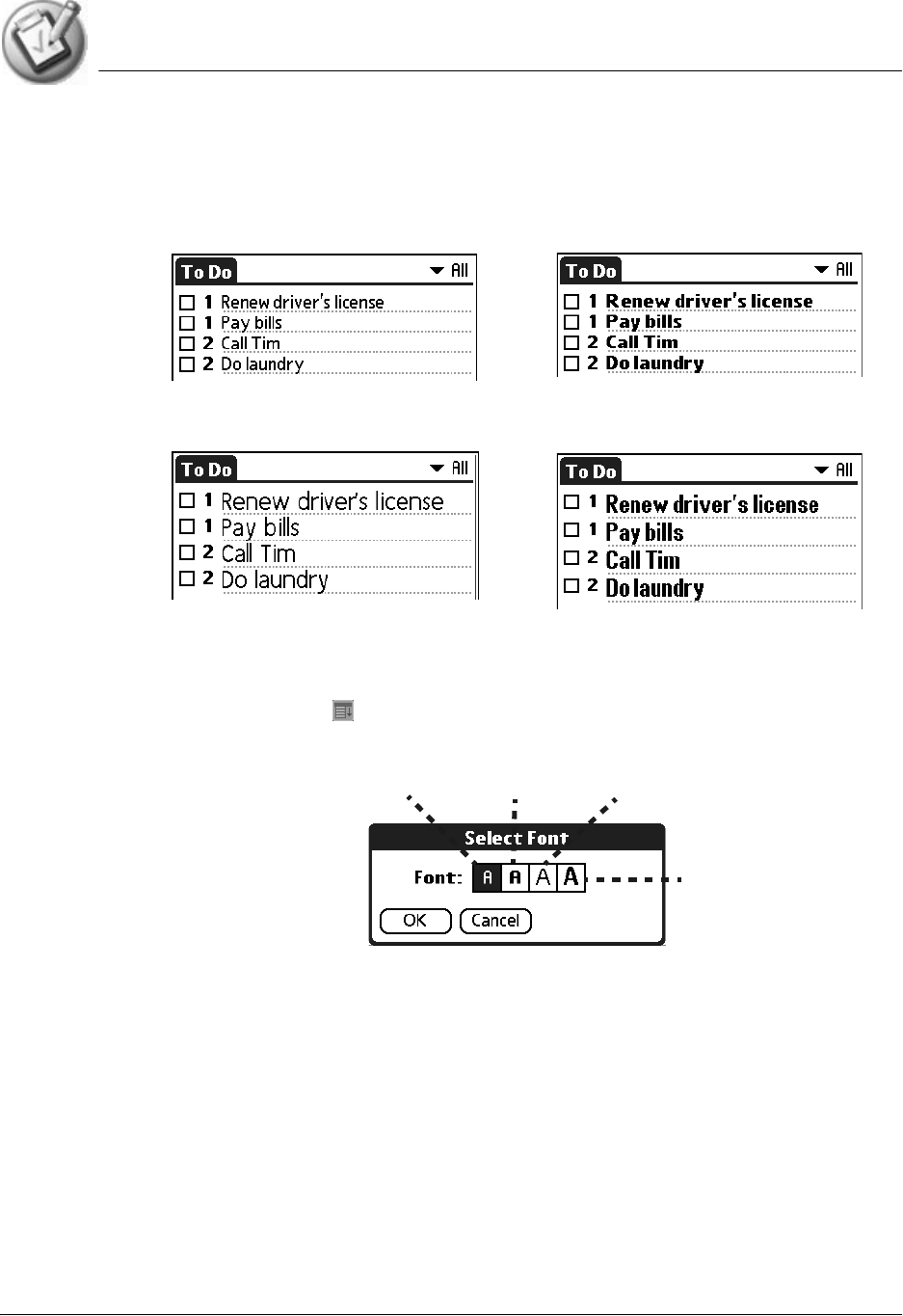
Performing Common Tasks
Choosing fonts
Using Your Zodiac Handheld 77
Choosing fonts
You can change the font style in all the Organizer applications. You can also
choose a different font style for each application.
1. Open an application.
2. Tap the Menu icon .
3. From the Options menu, select Font.
4. Tap the font style you want.
5. Tap OK.
Small font
Large font
Small bold font
Large bold font
Small LargeSmall bold
Large bold

Using Your Zodiac Handheld 78
9
Using Address Book
Address Book lets you keep names, addresses, telephone numbers, and other
information about your personal or business contacts.
Use Address Book to:
•Quickly enter, look up, or duplicate names, addresses, phone numbers,
and other information.
•Enter up to five phone numbers (home, work, fax, mobile, and so on) or
e-mail addresses for each name.
•Define which phone number appears in the Address List for each
Address Book entry.
•Attach a note to each Address Book entry, in which you can enter
additional information about the entry.
•Assign Address Book entries to categories so that you can organize
and view them in logical groups.
Opening Address Book
1. Press the Home button .
2. Select the Organizer category .
3. Select the Address icon .
Address Book opens to display the list of all your records.
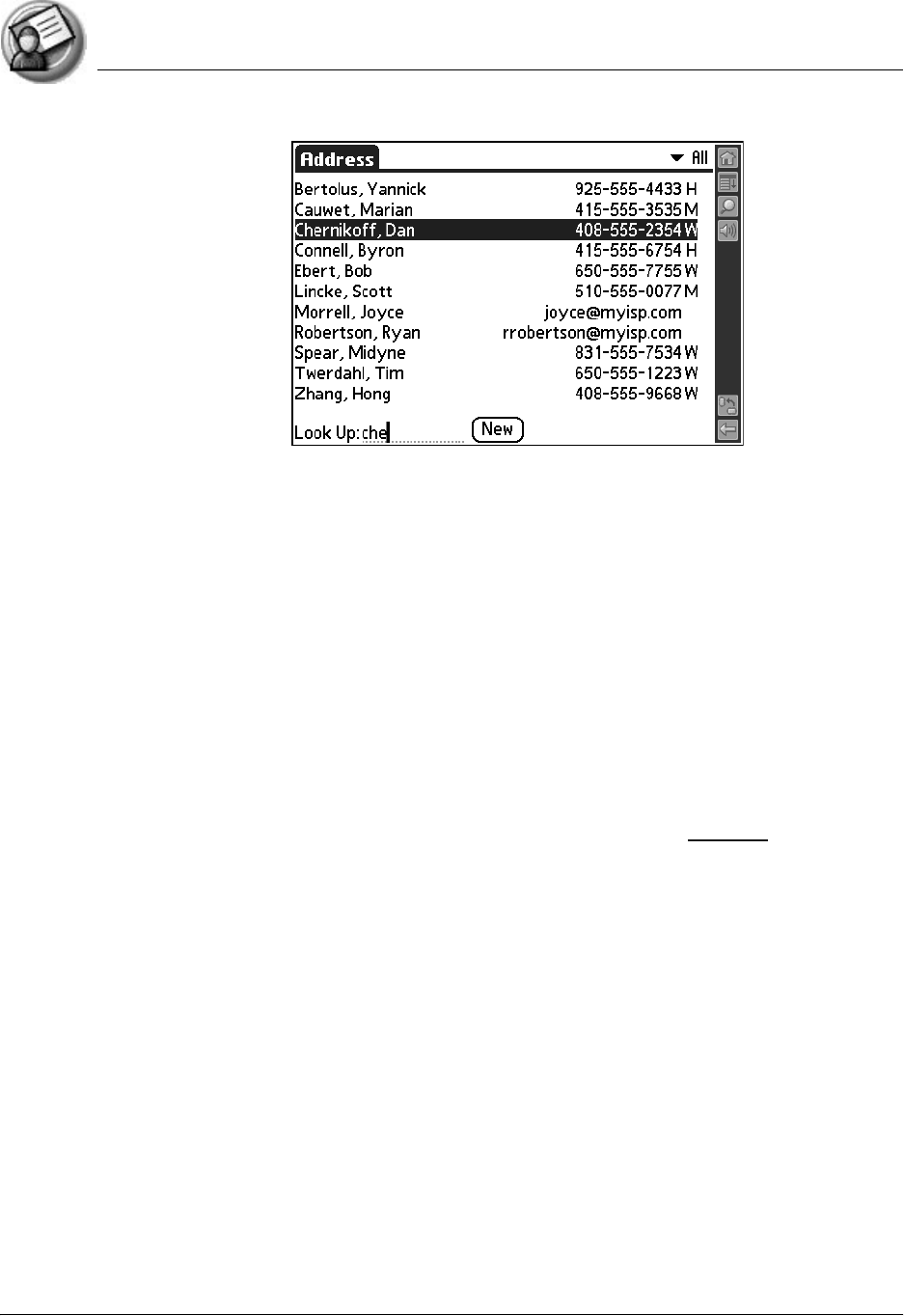
Using Address Book
Adding and using Address Book entries
Using Your Zodiac Handheld 79
Adding and using Address Book entries
Address Book stores name and address information about people or
businesses.
Creating an Address Book entry
A record in Address Book is called an entry. You can create entries on your
handheld, or you can use Palm Desktop software to create entries on your
computer and then download them to your handheld with your next HotSync
operation.
Palm Desktop software also has data import capabilities that let you load
database files into Address Book on your handheld. See page 39 and Palm
Desktop online Help for more information.
1. Open Address Book.
2. Tap New.
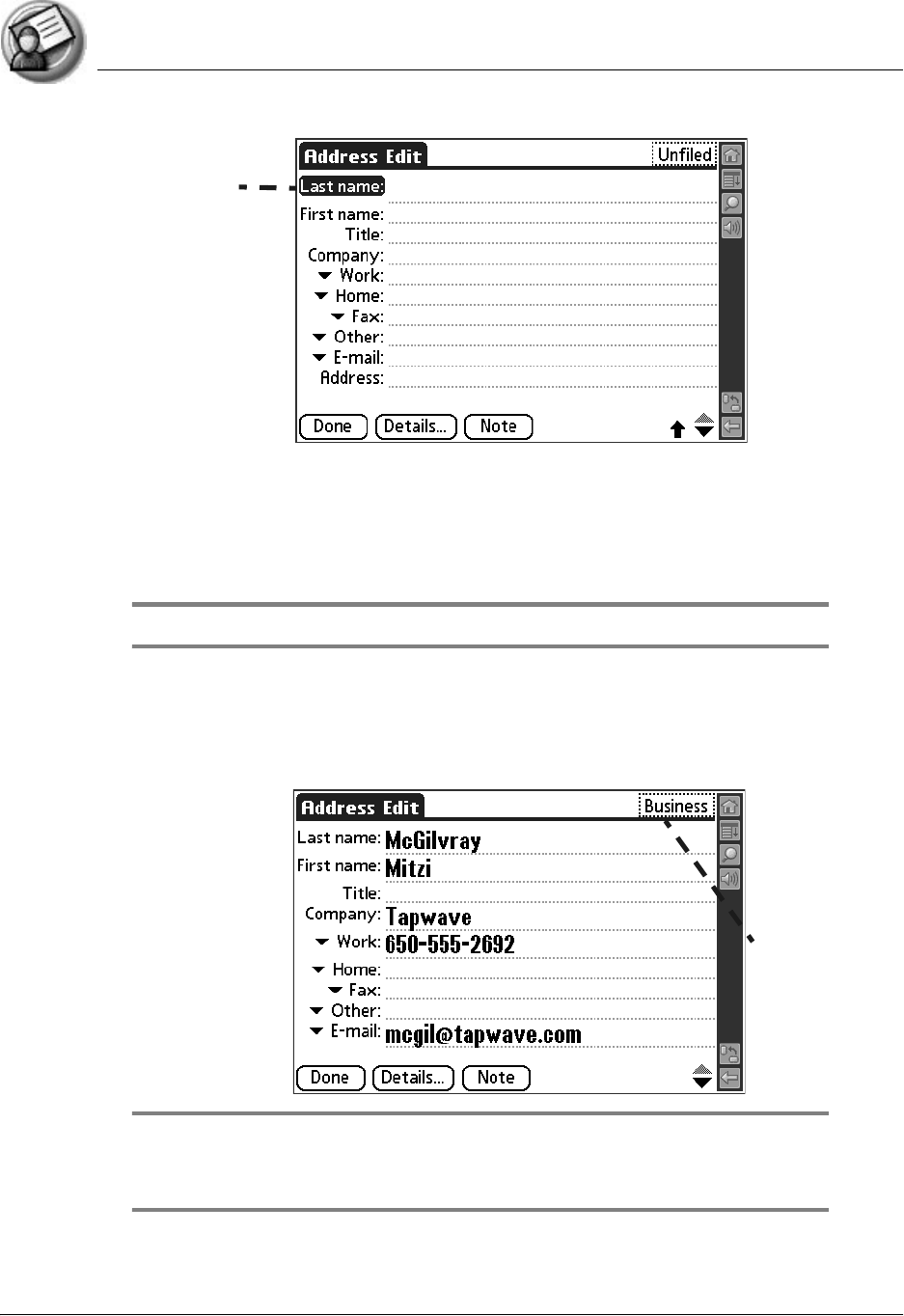
Using Address Book
Adding and using Address Book entries
Using Your Zodiac Handheld 80
3. Enter the last name of the person you want to add to your Address Book.
4. Tap the First Name field and enter the person’s first name.
5. Tap any field and enter any other information that you want to include in
the entry.
NOTE: If you plan to sort entries by company name, be sure to enter a company name.
6. Tap the scroll arrows to move to the next page of information.
7. To attach a note to an entry, tap Note. Enter the note, and then tap Done.
8. After you finish entering information, tap Done.
TIP: To create an entry that always appears at the top of the Address List, begin
the Last name or Company field with a symbol, as in *If Found Call.* This entry can
contain contact information in case you lose your handheld.
Cursor
at Last
name
Tap here to assign
entry to a category
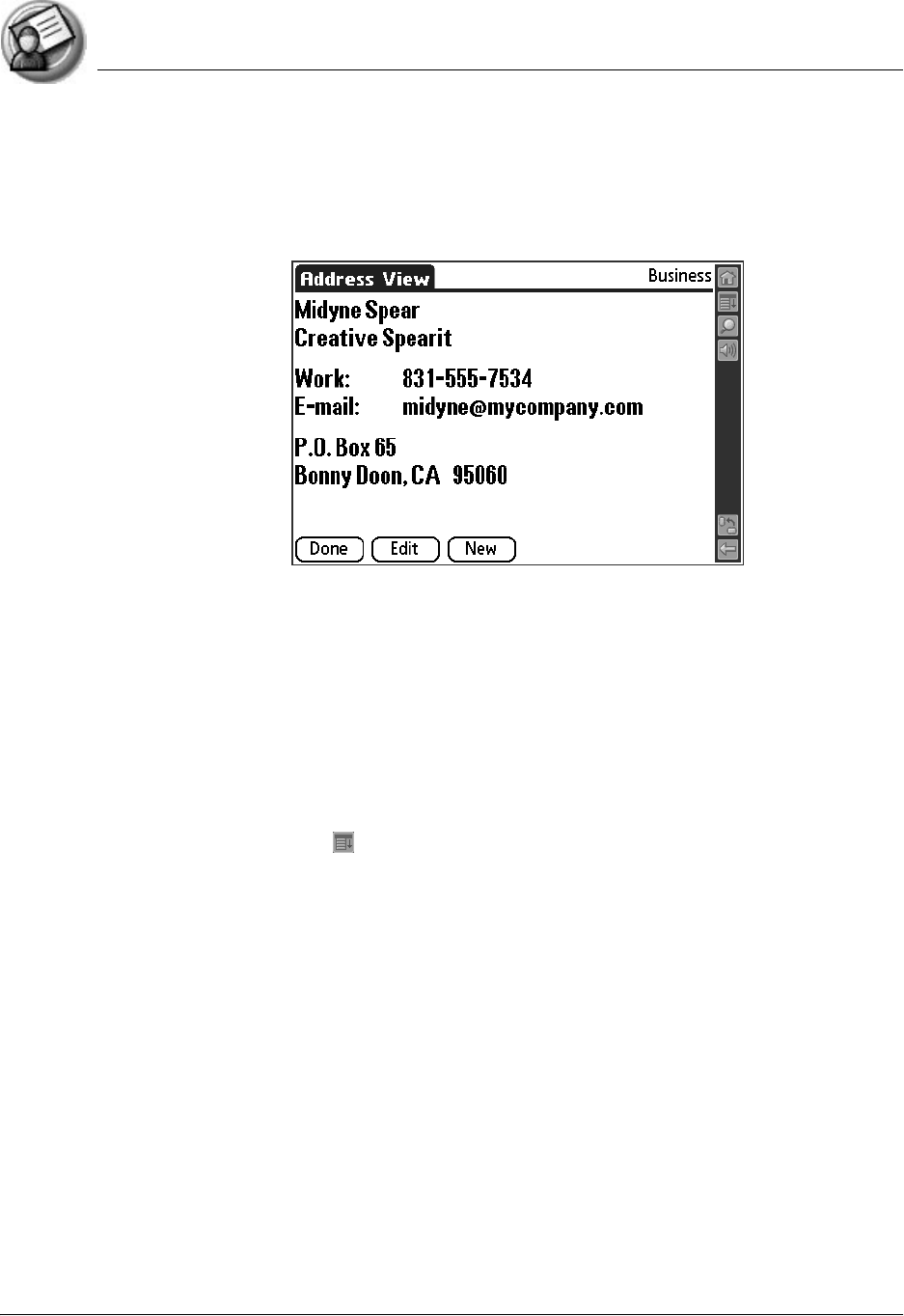
Using Address Book
Viewing an address entry
Using Your Zodiac Handheld 81
Viewing an address entry
1. Tap the address entry in Address List view.
The entry appears in Address view.
2. Tap Done after you finish viewing the entry.
Duplicating an entry
You can duplicate existing entries, which can be helpful when you want to
enter multiple people from a single organization. When you duplicate an
entry, the word Copy appears next to the name in the First Name field.
1. In Address Book, tap a name you want to duplicate.
2. Tap the Menu icon .
3. From the Record menu, select Duplicate Record.
4. Edit the record as necessary.
Selecting different types of phone numbers and addresses
You can select the types of phone numbers or e-mail addresses that an
Address Book entry displays. Any changes you make apply only to the current
entry.
1. In the Address list, tap the entry you want to change.
2. Tap Edit.
3. From the pick list next to any label you want to change, select a new label.
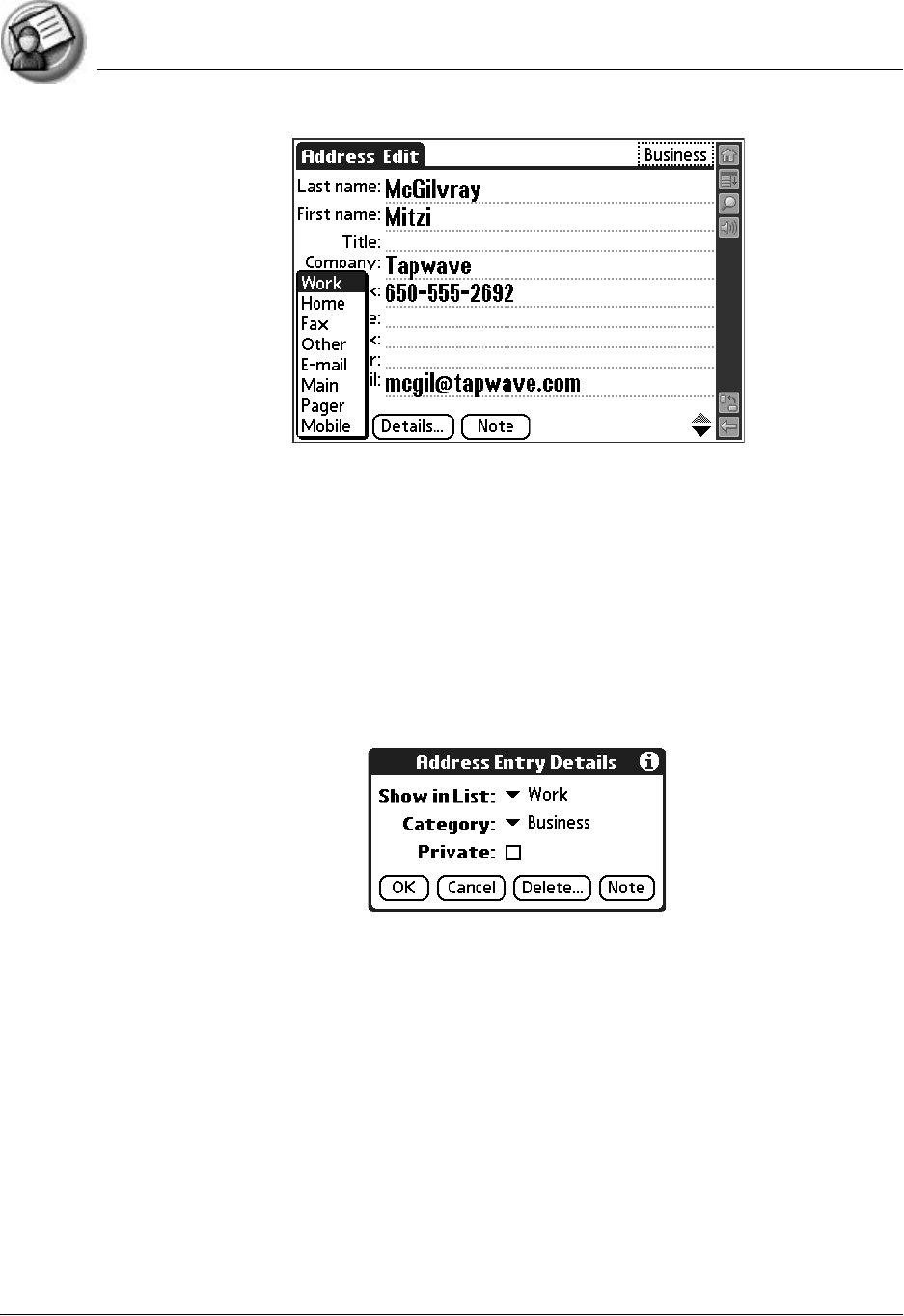
Using Address Book
Editing Address Book entries
Using Your Zodiac Handheld 82
Editing Address Book entries
You can change the type of information that appears in the Address List
screen, categorize an entry, and hide an entry for security reasons. You can
also delete entries.
1. Tap the entry that you want to change in the Address list.
2. Tap Edit.
3. Tap Details.
4. In the Address Entry Details dialog box, set any of the following:
•Show in List. Select which information you want to appear in the
Address List screen. Options are Work, Home, Fax, Other, and E-mail.
•Category. Select the category you want to assign to the entry.
•Private. Hide the entry when Security is turned on.
•Note. Attach a note, such as driving directions, to the entry.
5. Tap OK.
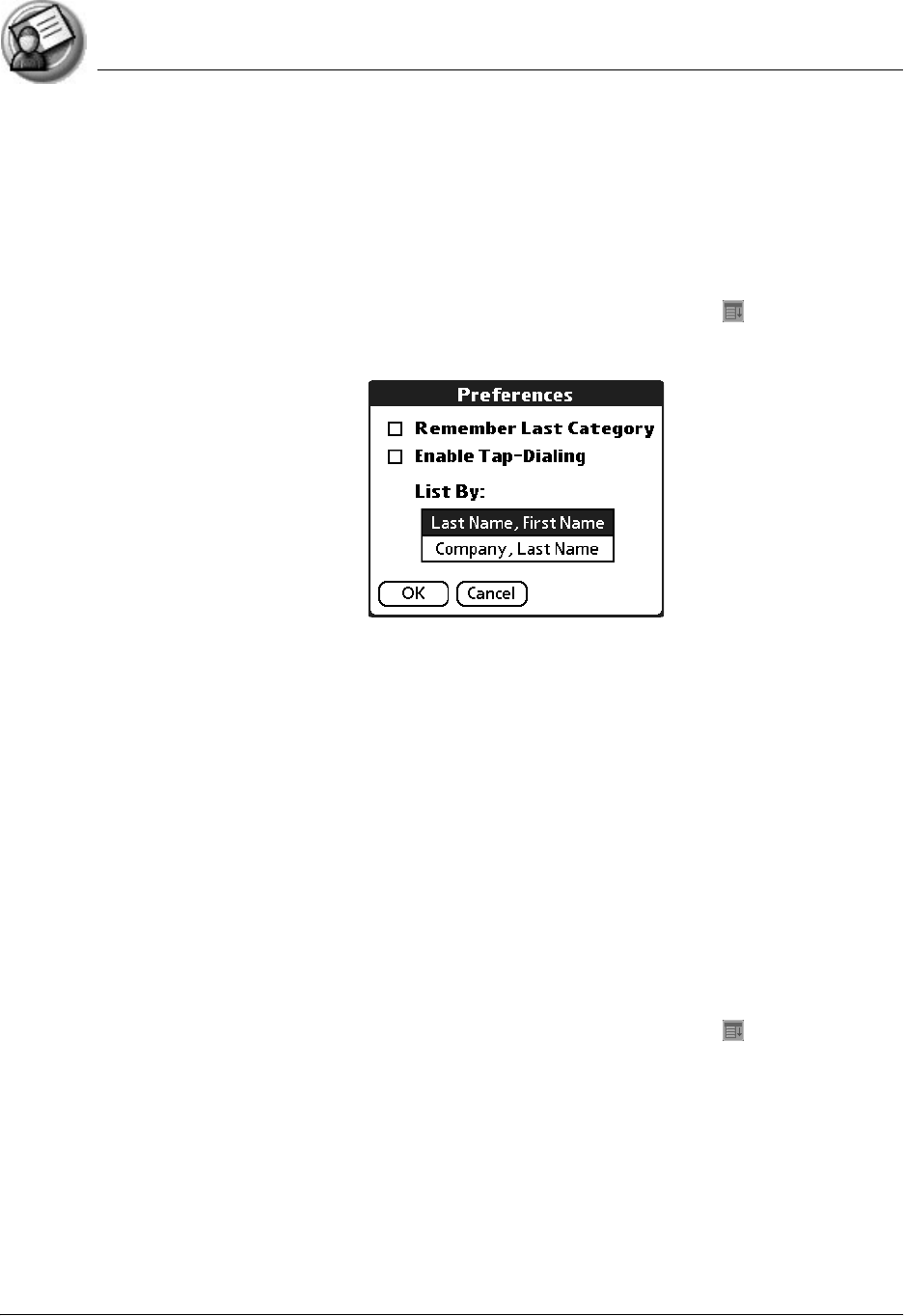
Using Address Book
Changing Address Book display
Using Your Zodiac Handheld 83
Changing Address Book display
You can change how Address Book lists are sorted and you can add custom
fields for entering additional information, using preferences. You can also
have Address Book display the last category you selected each time you
return to the application.
1. In the Address list or in Address view, tap the Menu icon .
2. From the Options menu, select Preferences.
.
3. From the Address Book Preferences dialog box, select from the following
options:
•Remember last category. Display the most recently viewed category
the next time you open Address Book.
•Last Name, First Name. Sort the Address list alphabetically by an
individual’s last name and then first name.
•Company, Last Name. Sort the Address list alphabetically by the
company name, and then an individual’s last name.
4. Tap OK.
Adding custom fields at the end of Address Edit screens
1. In the Address list or in Address view, tap the Menu icon .
2. From the Options menu, select Rename Custom Fields.
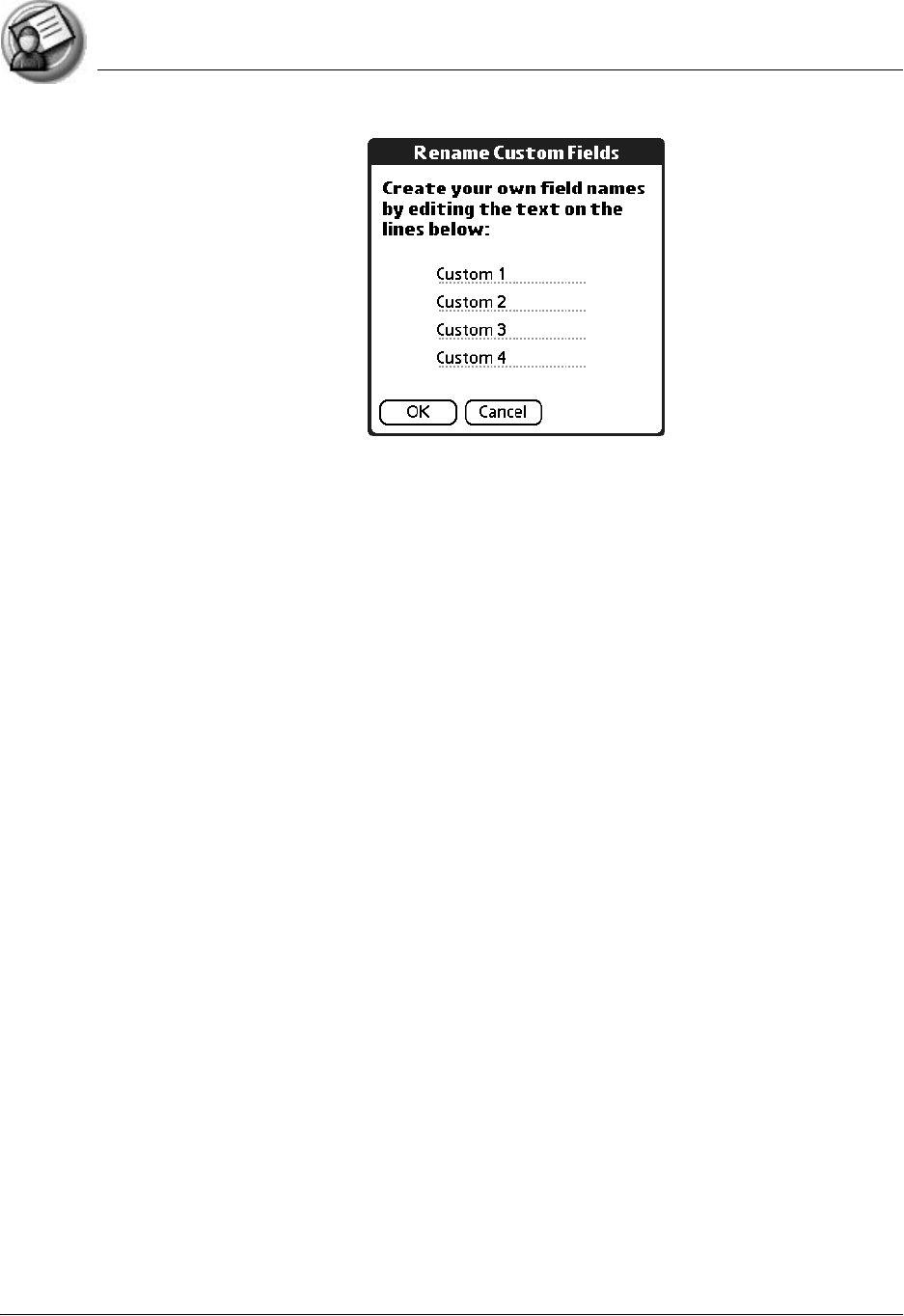
Using Address Book
Adding custom fields at the end of Address Edit screens
Using Your Zodiac Handheld 84
3. In the Input Area, rename the fields to identify the information you’ll
enter in them. The names you give the custom fields appear in all entries,
at the end of the Address Edit screen.
4. Tap OK in the Rename Custom Fields dialog box.
5. Tap Done.
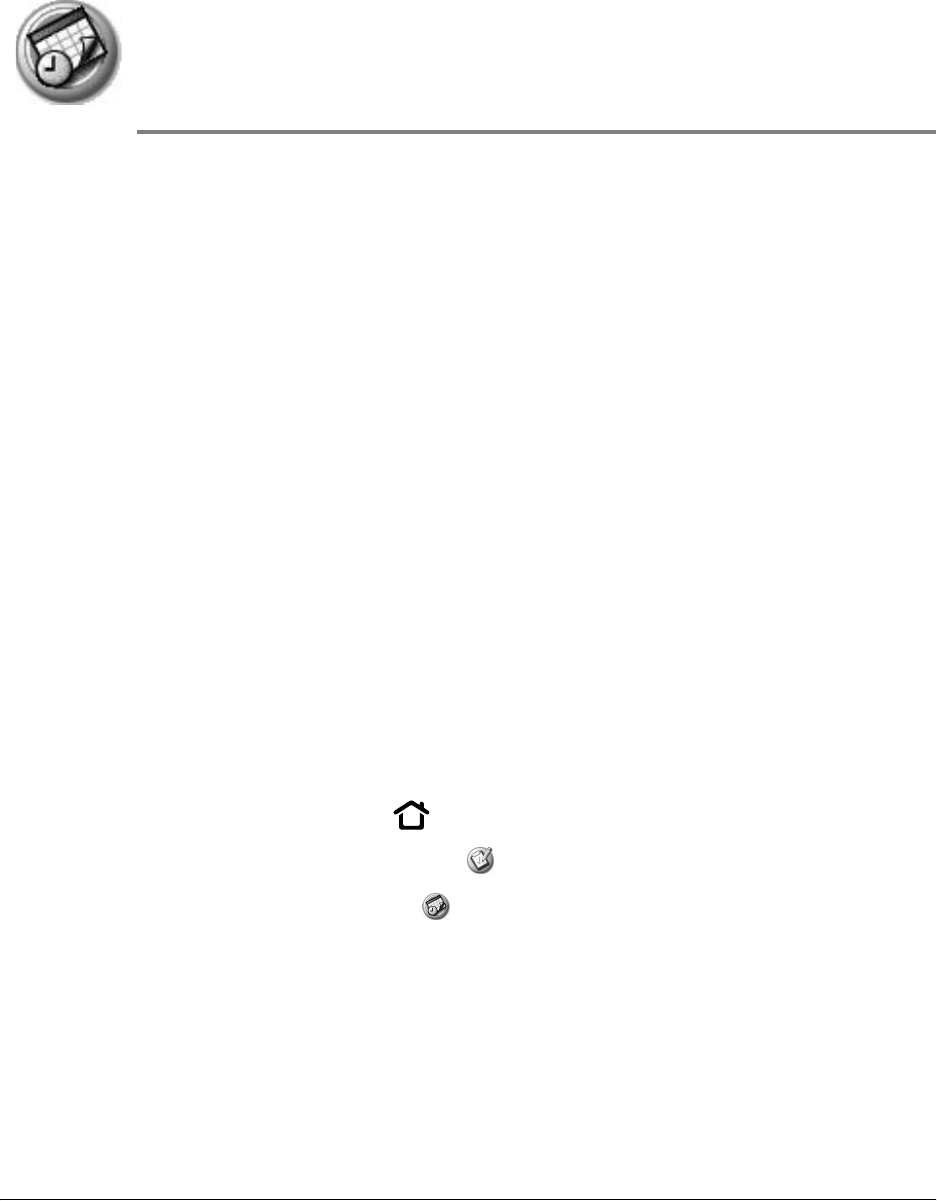
Using Your Zodiac Handheld 85
10
Using Date Book
Date Book lets you quickly and easily schedule appointments or any activity
associated with a date or date and time. When you open Date Book, the
current date and a list of times for a standard business day are displayed.
Use Date Book to:
•Schedule events: timed events, which have both times and dates;
untimed events, for example, birthdays or anniversaries; repeating
events, such as a weekly meeting held on the same day at the same
time; continuous events, such as a vacation or three-day conference;
and all day events, which reflect the default hours of a day as set by the
user.
•Display your schedule in different ways: by Day, Week, Month, or
Agenda view.
•Set an alarm to sound minutes, hours, or days before a scheduled
appointment.
•Attach notes to events to describe or clarify Date Book entries.
•Rearrange or delete events from your schedule.
Opening Date Book
1. Press the Home button .
2. Select the Organizer category .
3. Select the Date Book icon .
Date Book opens to today’s schedule. The date appears in the top left corner
of the screen.
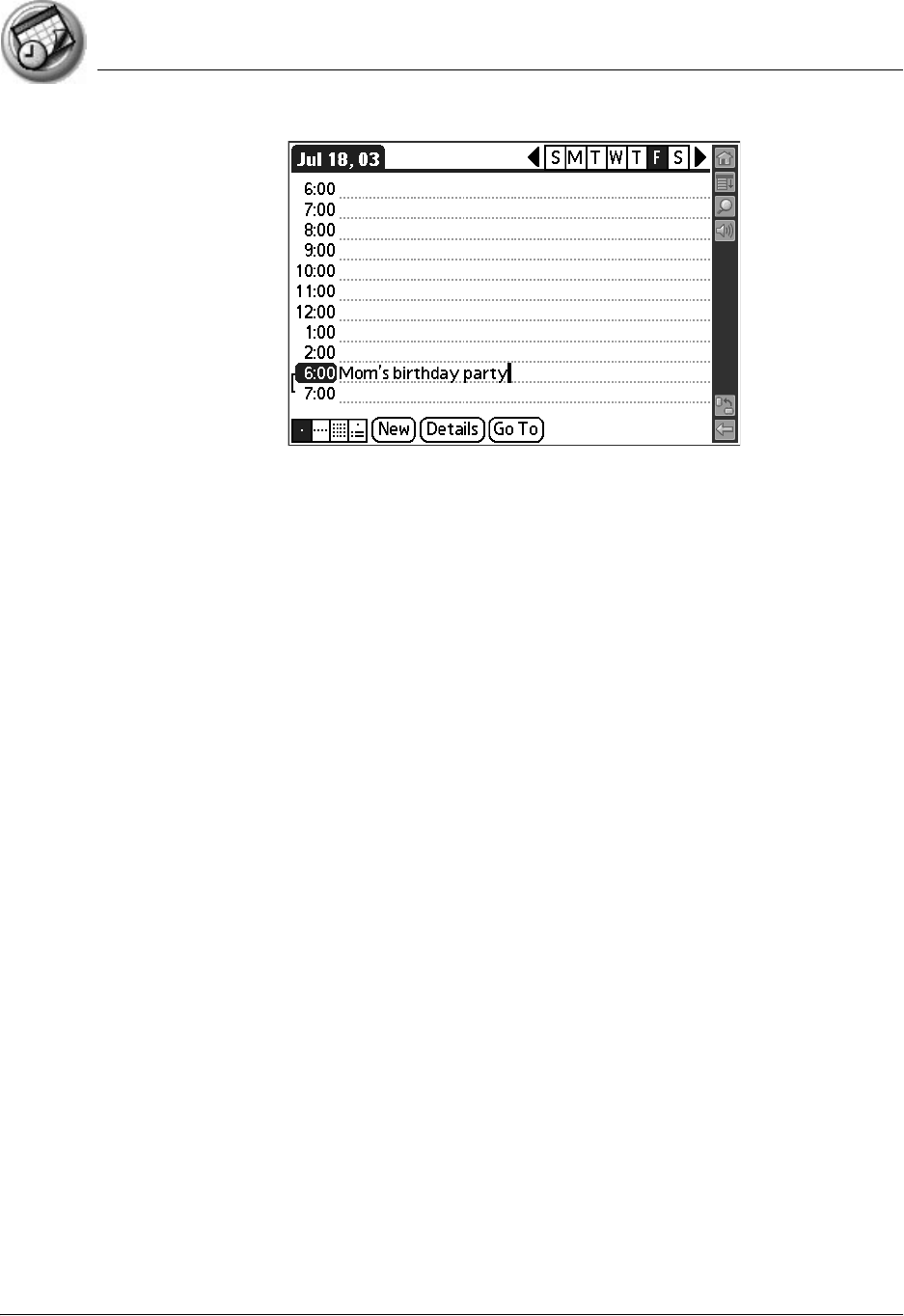
Using Date Book
Scheduling events
Using Your Zodiac Handheld 86
Scheduling events
An entry in Date Book is called an event. When you schedule an event, its
description appears on the time line, and its duration is set to 1 hour by
default. You can easily change the start time and duration for any event. You
can schedule the following types of events in Date Book:
•Timed events, such as meetings, that have a specific date and a specific
start and end time.
•Untimed events, such as birthdays, holidays, and anniversaries. These
events occur on a particular date but have no specific start or end
times; they appear at the top of the list of times marked with a
diamond. You can schedule more than one untimed event on the
same date.
•Repeating events, such as a weekly meeting that is held on the same
day at the same time each week.
•Continuous events, such as a vacation or three-day conference.
•All day events, which reflect the default length of the day.
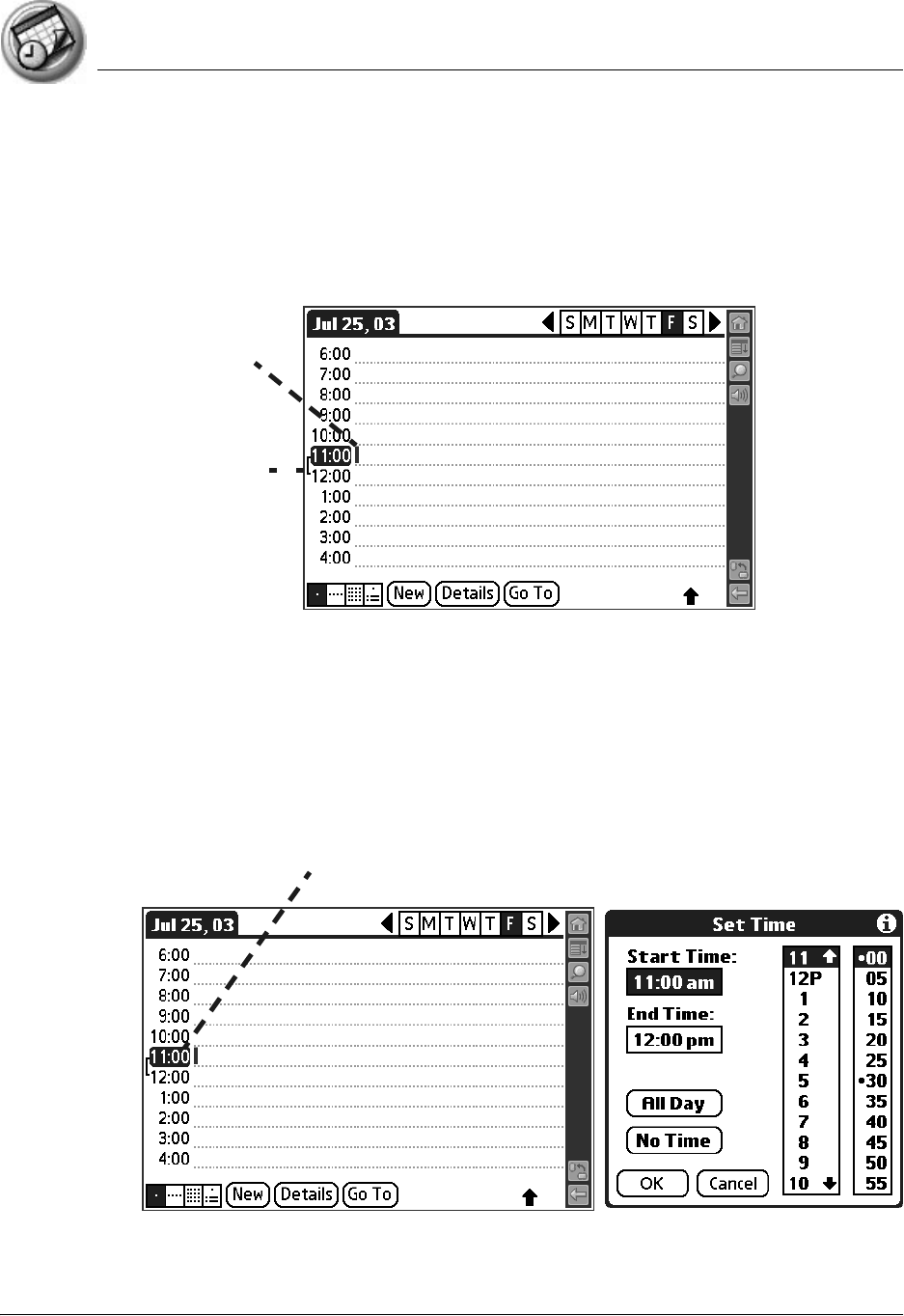
Using Date Book
Scheduling events
Using Your Zodiac Handheld 87
Scheduling timed events for the current date
1. Open Date Book to today’s schedule. The Day view displays the current
date and a list of times for a normal day.
2. With the current day selected, tap the line next to the time that
corresponds to the start of the event.
3. Enter a description of the event, up to 255 characters in length.
4. Set the event’s duration:
•If the event is 1-hour long, skip to the end of this procedure.
•If the event is longer or shorter than an hour, tap directly on the time to
open the Set Time dialog box.
Time bar shows
default duration.
Enter text next
to event time
Tap the time to
display the Set
Time dialog box
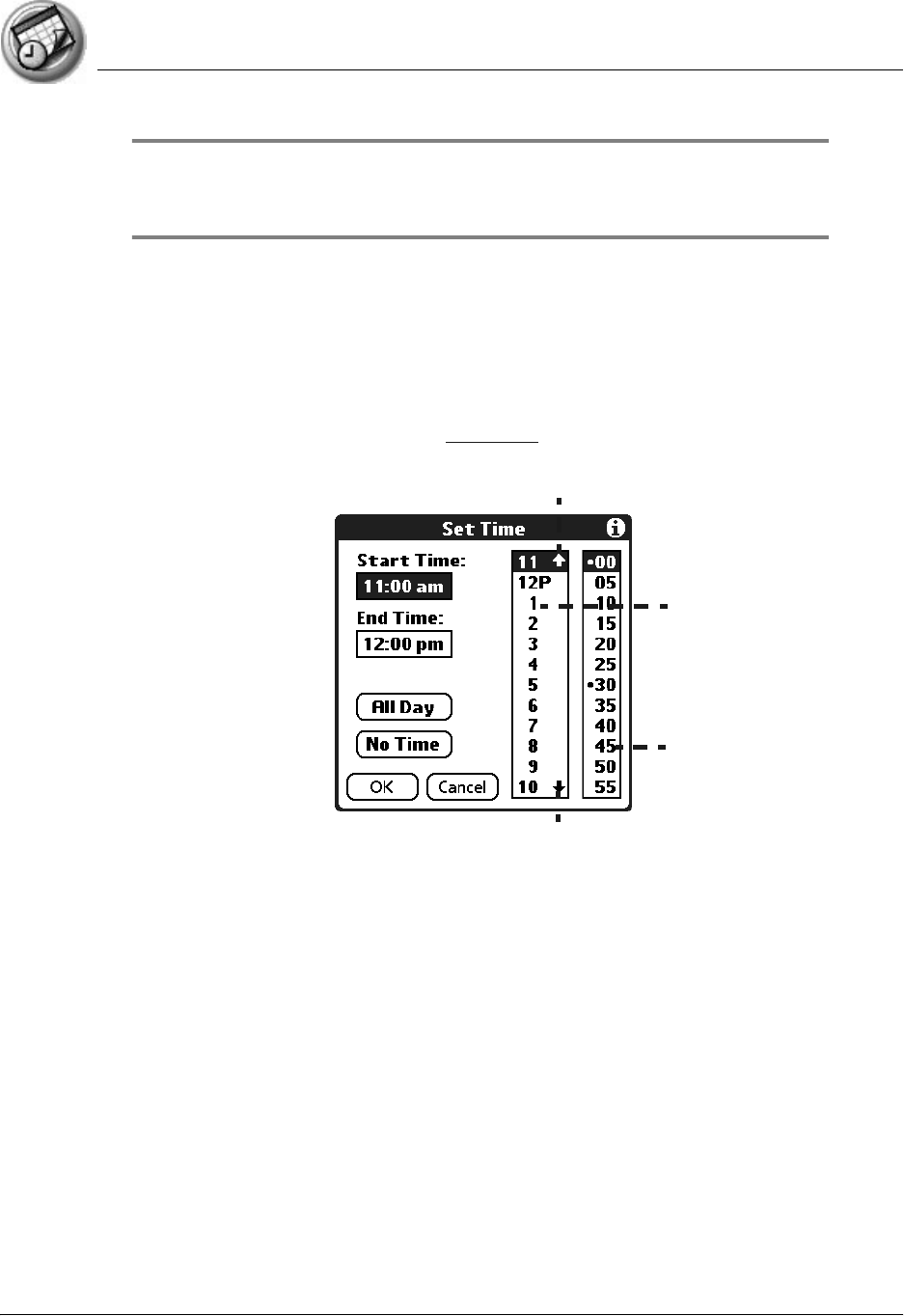
Using Date Book
Scheduling events
Using Your Zodiac Handheld 88
TIP: You can open the Set Time dialog box (to select a start time) by making sure
no event is selected, and then writing a number in the number portion of the Input
Area.
5. Set the duration of the event in either of the following ways:
•Tap the time columns in the Set Time dialog box to set the Start Time;
Tap End Time; then tap the time columns to set the End Time.
•Tap All Day if the event lasts all day. The default hours of a standard
business day are set by the user, and may be changed using Date Book
Preferences. For details, see page 101.
6. Tap OK.
Tap to scroll to
earlier hours
Tap to scroll to
later hours
Tap to change
hours
Tap to change
minutes
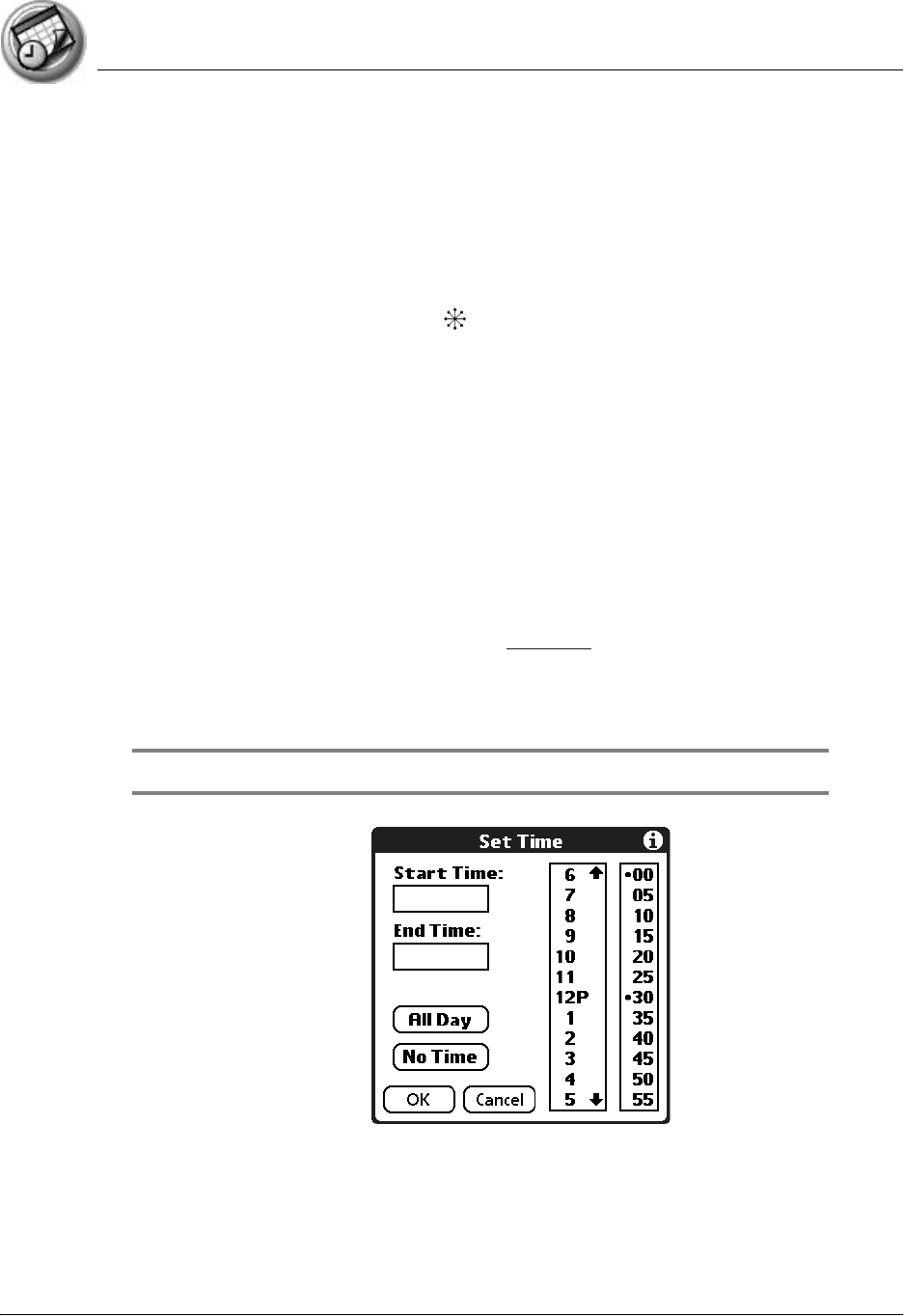
Using Date Book
Scheduling events
Using Your Zodiac Handheld 89
Scheduling a timed event for another date
1. Select the date you want in one of the following ways:
•Tap the desired day of the week in the date bar at the top of the screen.
If necessary, tap the scroll arrows in the upper-right corner to move to
the next or previous week.
•Move the analog controller to scroll between days. Move Left to
display the previous day and Right to display the next day.
•Tap Go To at the bottom of the screen to open the Go to Date dialog
box. Select a date by tapping a year, month, and day in the calendar.
2. After locating the desired date, follow the steps for scheduling an event
for the current day.
Scheduling untimed events
You can schedule untimed events for any date. Untimed events appear at the
top of the list of times marked with a diamond.
1. Select the event date you want (see page 86).
2. Tap New.
3. In the Set Time dialog box, tap No Time.
NOTE: You can tap OK instead but make sure nothing is entered for start or end time.
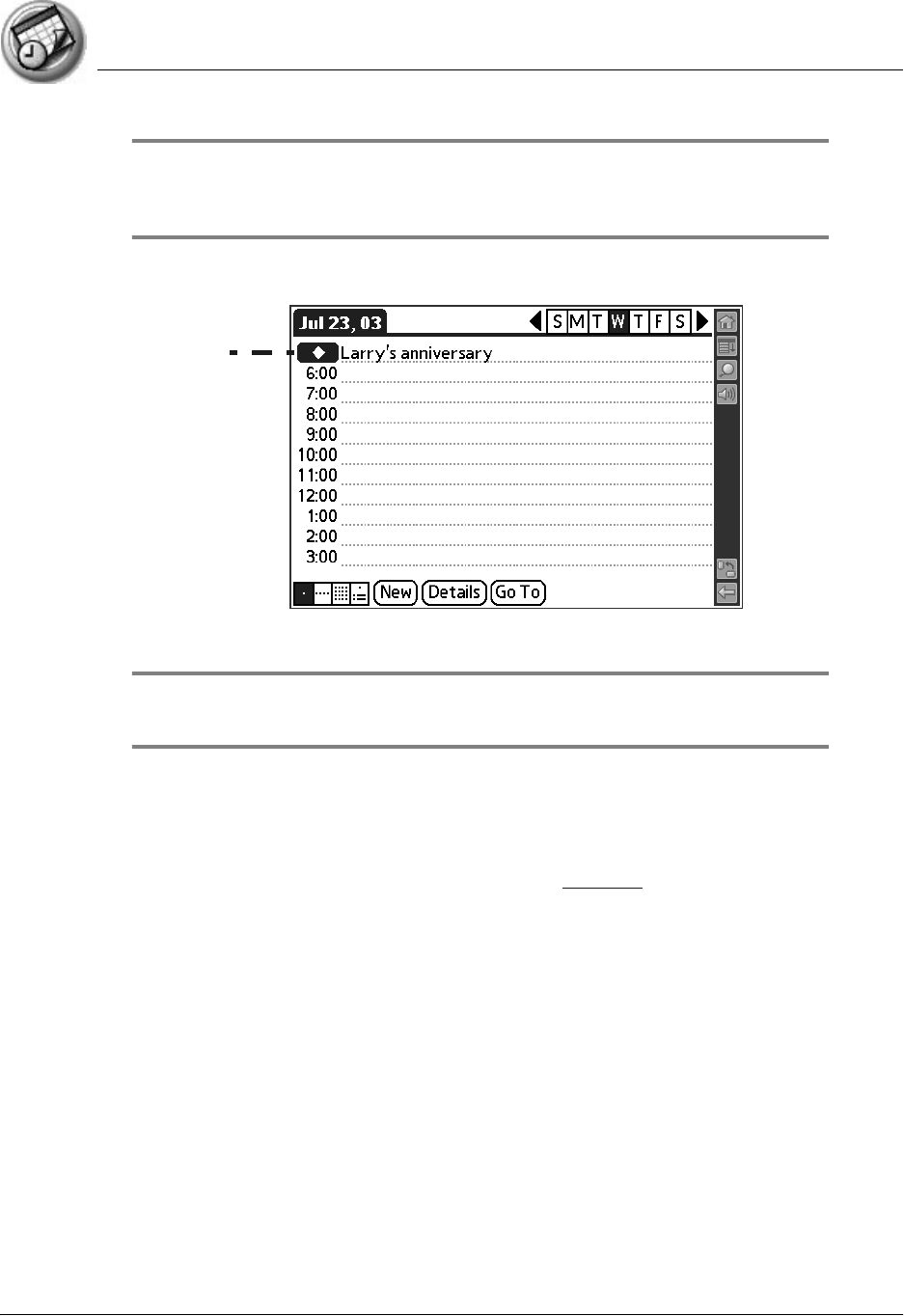
Using Date Book
Scheduling events
Using Your Zodiac Handheld 90
TIP: You can create a new untimed event by making sure no event is selected and
then writing letters in the Input Area. When you start writing, the untimed event
appears at the top of the screen
4. Enter a description of the event.
5. Tap a blank area on the screen to deselect the untimed event.
NOTE: If you create a timed event and later want to make it an untimed event, tap
directly on the event time in Date Book, tap No Time, and then tap OK.
Adding Address Book information to an event
You can add a name, address, and telephone number to an event using the
Phone Lookup option. For instructions, see page 71.
Rescheduling events
You reschedule events using the Details option in Date Book. You can also use
the Details option to convert untimed events into timed events.
1. Tap the event you want to reschedule.
2. Tap Details.
3. To change the time, tap the Time box, select a new time, and then tap OK.
4. To change the date, tap the Date box, select a new date, and then tap OK.
Untimed
event
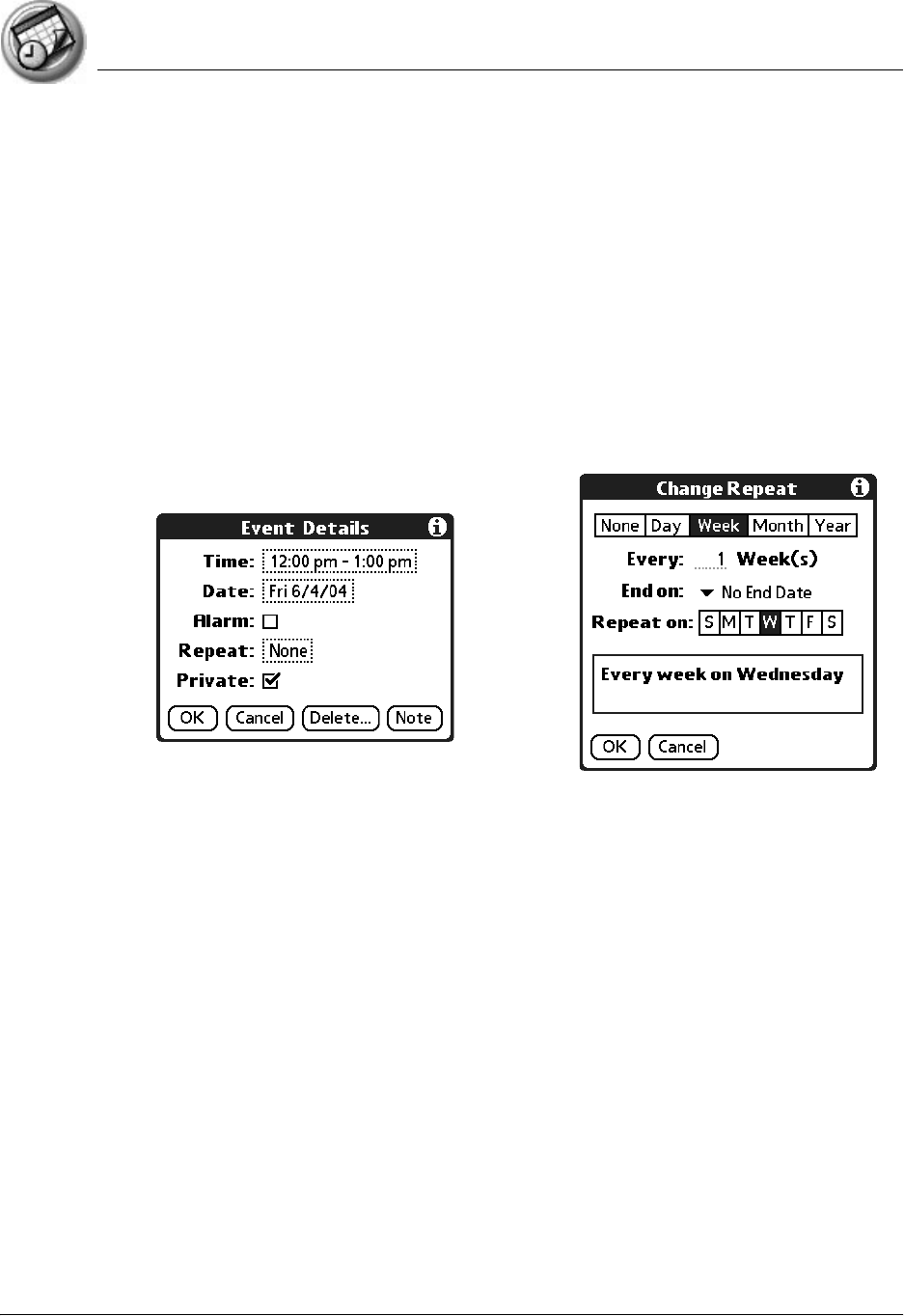
Using Date Book
Scheduling events
Using Your Zodiac Handheld 91
Scheduling repeating or continuous events
The Repeat function lets you schedule events that recur at regular intervals or
extend over a period of consecutive days. Repeating events include a birthday
and a weekly guitar lesson that falls on the same day of the week and the
same time of day. Continuous events might include a business trip or a
vacation.
1. Tap the event (be sure to tap the event and not the time next to the event).
Typically, a continuous event is an untimed event.
2. Tap Details.
3. Tap the Repeat box to open the Change Repeat dialog box.
4. Tap Day, Week, Month, or Year to set how often the event repeats. For a
continuous event, tap Day.
5. Enter a number that corresponds to how often you want the event to
repeat on the Every line.
6. For example, if you select Month and enter the number 2, the event
repeats every other month.
7. To set an end date for the repeating or continuous event, select Choose
Date from the End On pick list. Use the date picker to select an end date.
8. Tap OK. An icon that represents a repeating event appears to the far right
on the event line.
Changing repeating or continuous events
When changes are made to a repeating or continuous event you have the
option of applying the change to just the current event, the current event and
Tap the
Repeat
box.
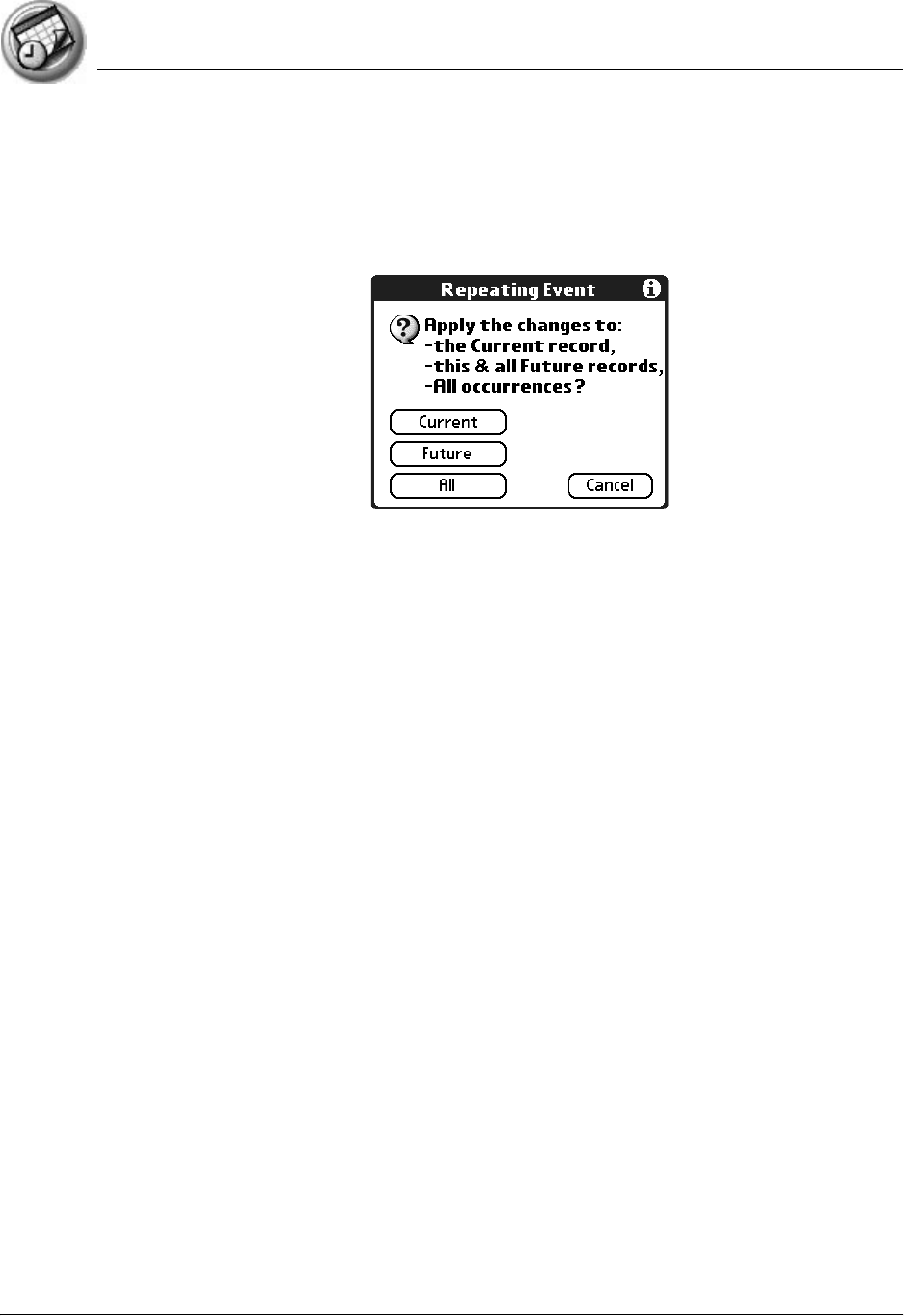
Using Date Book
Scheduling events
Using Your Zodiac Handheld 92
all future occurrences of this event, or all occurrences of this event - past,
present, and future.
1. Select the event you want to change and tap Details.
2. Change the event and tap OK. The Repeating Event screen opens.
3. Select one of the following options:
•Current. Edit a single occurrence of this event.
•Future. Edit the current event and all future occurrences of this event.
•All. Edit all past, current, and future occurrences of this event.
The event is changed and you are returned to the day view where you started.
These steps apply to all changes and deletions you make to repeating or
continuous events.
Tips for scheduling repeating or continuous events
Keep the following in mind when scheduling repeating or continuous events:
•If you change the start date of a repeating event, your handheld
calculates the number of days you moved the event. Your handheld
then automatically changes the end date to maintain the duration of
the repeating event.
•If you change the repeat interval (e.g., daily to weekly) of a repeating
event, past occurrences (prior to the day on which you change the
setting) are not changed, and your handheld creates a new repeating
event.
•If you change the date of an occurrence of a repeating event (e.g., from
January 14 to January 15) and apply the change to all occurrences, the
new date becomes the start date of the repeating event. Your
handheld adjusts the end date to maintain the duration of the event.

Using Date Book
Setting the alarm
Using Your Zodiac Handheld 93
•If you change other repeat settings (for example, time, alarm, private)
of a repeating event and apply the change to all occurrences, your
handheld creates a new event. The start date of this new event is the
day on which the setting is changed. Past occurrences (prior to the day
of the change) are not changed.
•If you apply a change to a single occurrence of a repeating event (e.g.,
time), that occurrence no longer shows the Repeat icon.
Setting the alarm
The Alarm setting lets you set an audible alarm for events in your Date Book,
and display a reminder message on-screen. For untimed events, only the
reminder message appears.
Setting an alarm for an event
You can set an alarm for minutes, hours, or days before an event. When you
set an alarm, an Alarm icon appears to the far right of the event with the
alarm.
You can also set a silent alarm for untimed events that displays a reminder
message on-screen before the day of the event. The alarm triggers at the
specified period of minutes, hours, or days before midnight of the day on
which the untimed event begins.
For example, you set a 5-minute alarm for an untimed event that occurs on
February 4. The reminder message appears at 11:55 p.m. on the night of
February 3. The reminder remains onscreen until you turn on your handheld
and tap OK to turn off the reminder.
1. Tap the event to which you want to assign an alarm.
2. Tap Details.
3. Check the Alarm box.
The default setting, 5 Minutes, appears.
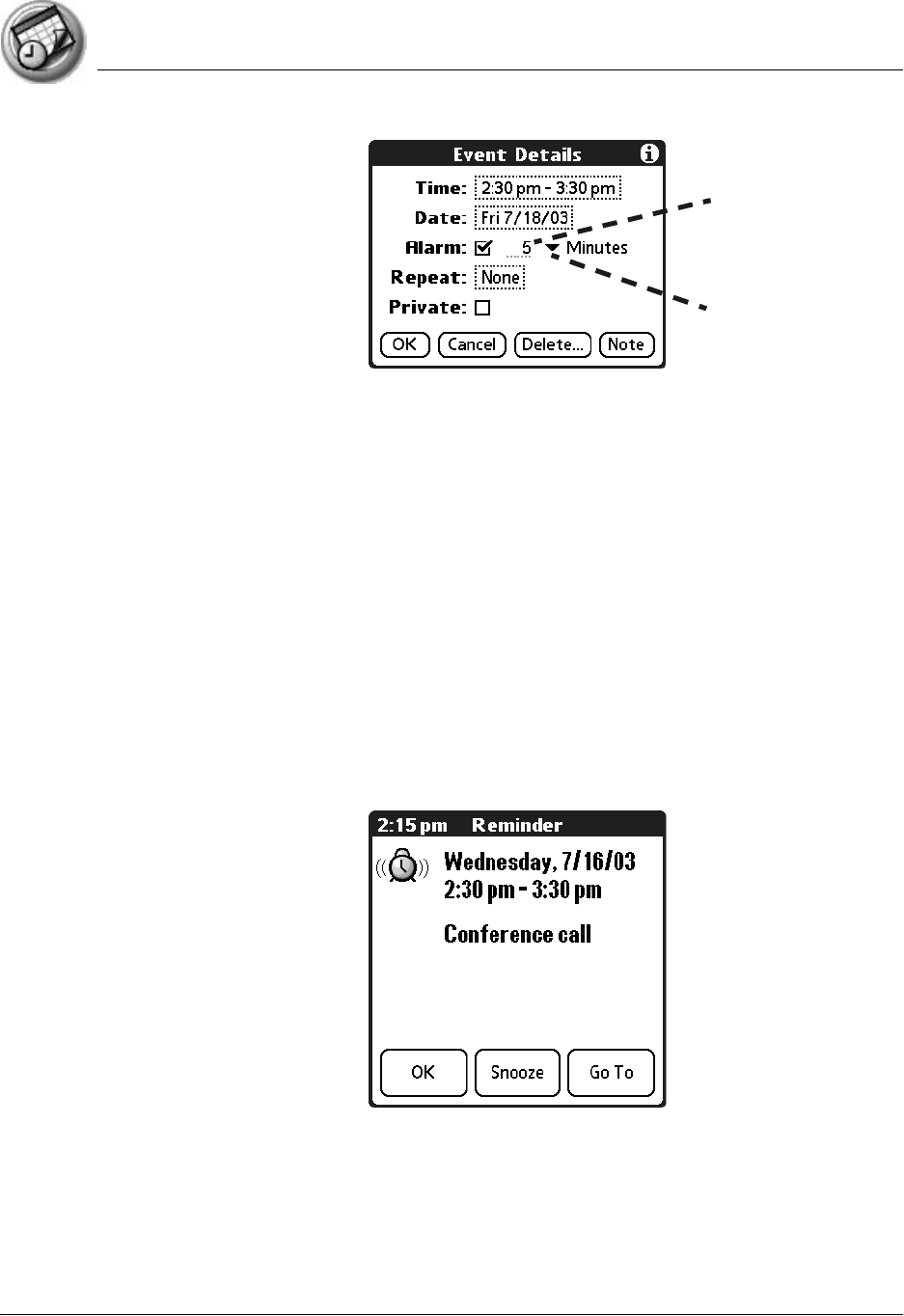
Using Date Book
Setting the alarm
Using Your Zodiac Handheld 94
4. Set the alarm time:
•Enter any number from 0 to 99 (inclusive) as the number of time units.
•From the pick list, select the time unit --Minutes, Hours, or Days.
5. Tap OK.
Once an alarm goes off, you can tap the Snooze option to dismiss the alarm
for a 5-minute period.
Snoozing the alarm
When the alarm dialog box appears, tap Snooze to delay the alarm for a preset
five-minute period.
Each time you tap Snooze, the alarm dismisses for an additional 5-minute
period.
Unit of time
Number of
time units
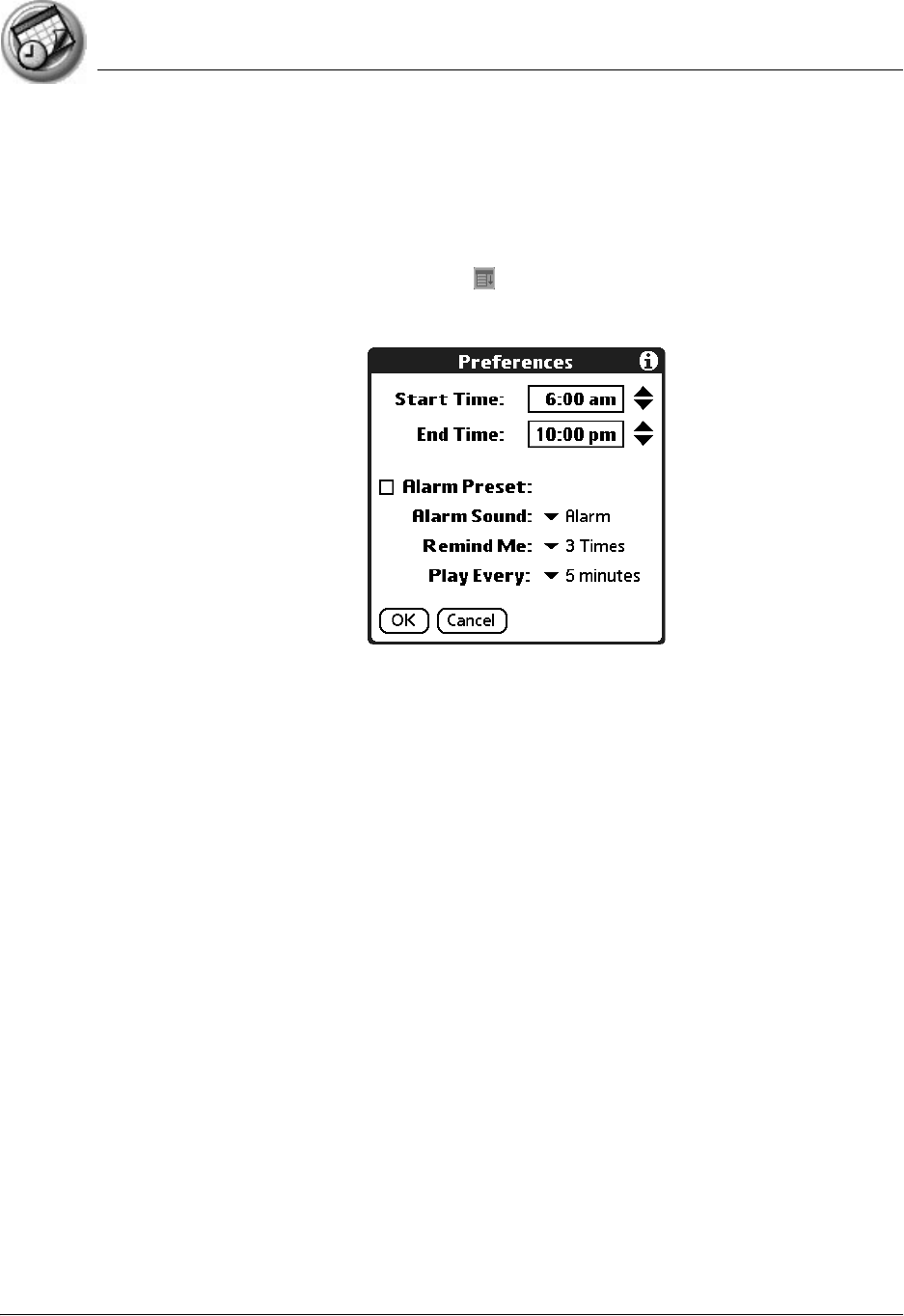
Using Date Book
Setting the alarm
Using Your Zodiac Handheld 95
Setting alarm options
You can set the alarm to go off automatically for each new event using
preferences. You can also set a tone for the alarm and the number of times the
alarm sounds.
1. In Date Book, tap the Menu icon .
2. From the Options menu, select Preferences.
3. Select from the following options:
•Alarm Preset. Set an alarm for each new event automatically. The
silent alarm for untimed events is defined by minutes, days, or hours
before midnight of the date of the event.
•Alarm Sound. Select the tone of the alarm. Options include Alarm,
Alert, Bird, Concerto, Phone, Sci-fi, and Wake Up.
•Remind Me. Define how many times the alarm sounds—once, twice,
three, five, or ten times.
•Play Every. Set how often the alarm sounds—every 1, 5, 10, or 30
minutes.
4. Tap OK.
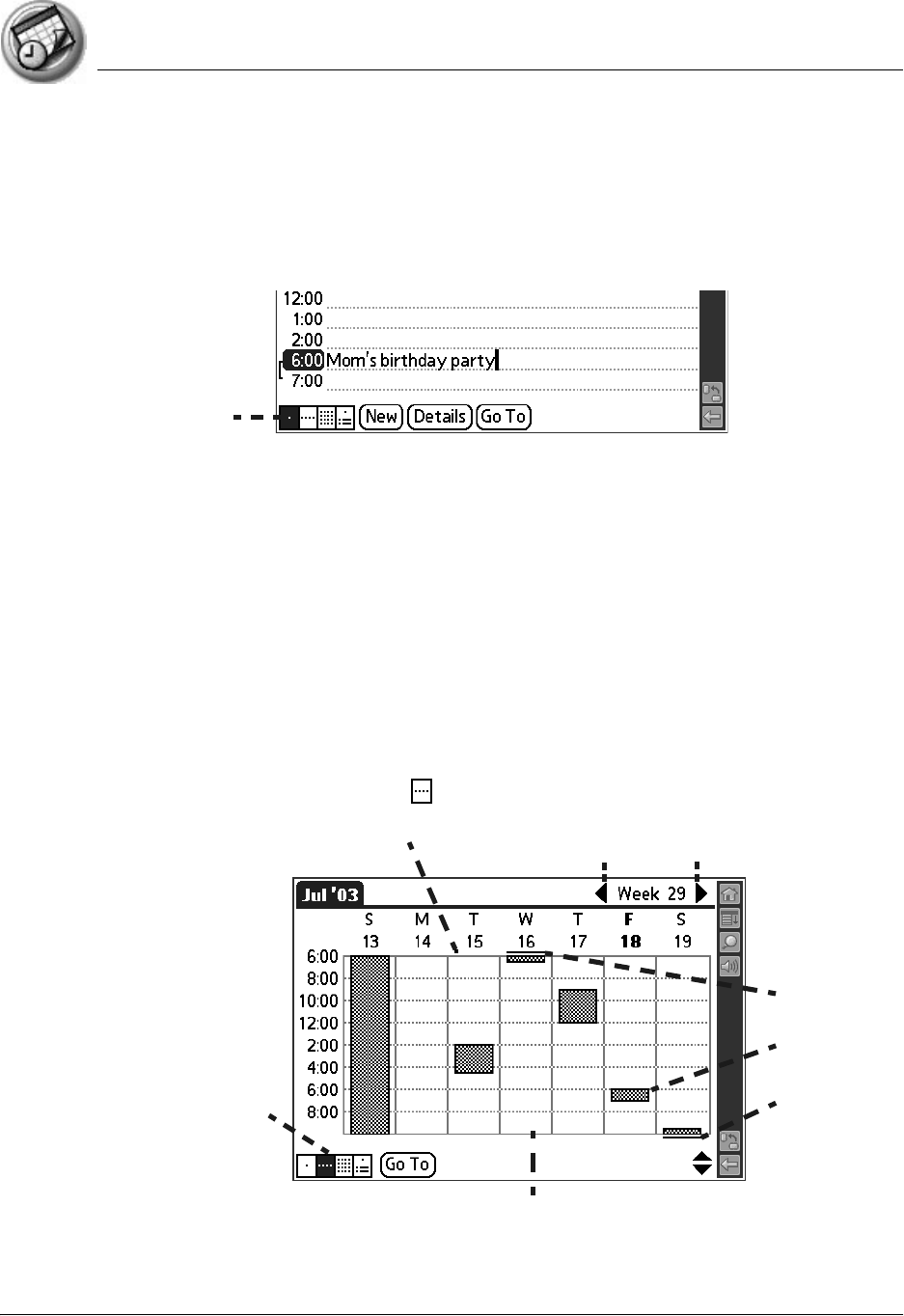
Using Date Book
Changing the Date Book view
Using Your Zodiac Handheld 96
Changing the Date Book view
Date Book includes four views for displaying your appointments: day view,
week view, month view, and agenda view.
•Tap a view icon in the lower-left corner of the Date Book screen.
•Press the Function button to scroll between views.
•Tap and hold down the stylus on the date in the date bar to display the
time (when you release the stylus, the menu bar appears).
Working in Week view
Week view displays a calendar of your events for an entire week. This view lets
you quickly review your appointments and available time slots. In addition,
the graphical display helps you spot overlaps and conflicts in your schedule.
Displaying the Week view
•Tap the Week view icon .
Date Book
view icons
Previous
week Next
week
Tap column to view that day
Box indicates
event
Bar indicates
earlier event
Dot indicates untimed event.
Bar indicates
later event
Month View icon
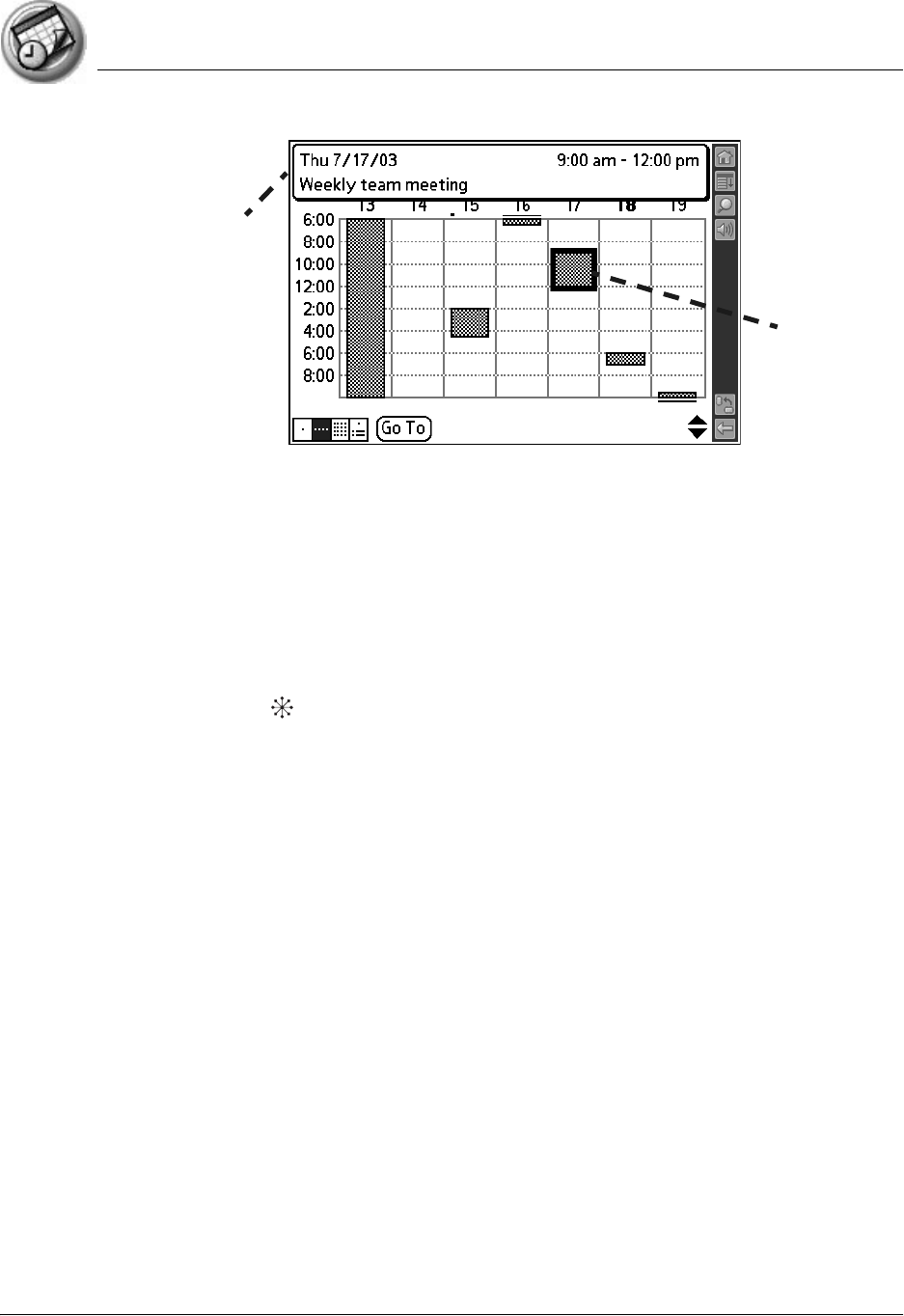
Using Date Book
Changing the Date Book view
Using Your Zodiac Handheld 97
Tips for using Week view
Keep the following points in mind when using Week view:
•Tap a specific day to display that day in Day view.
•Tap an event to display a description of the event at the top of the
screen.
•Tap the scroll arrows in the upper-right corner or move the analog
controller Right or Left to scroll forward or backward a week at a
time.
•To reschedule an event while in Week view, tap and drag the event to a
different time or day.
•Tap a blank time on any day to move to that day and have the time
selected for a new event.
•Tap any day or date that appears at the top of the Week view to move
directly to that day without selecting an event.
•The Week view displays the time span defined by the Start Time and
End Time in Date Book Preferences. If you have an event before or after
this time span, a bar appears at the top or bottom of that day's column.
Use the onscreen scroll arrows to scroll to the event.
Event details
Tap to show
event details
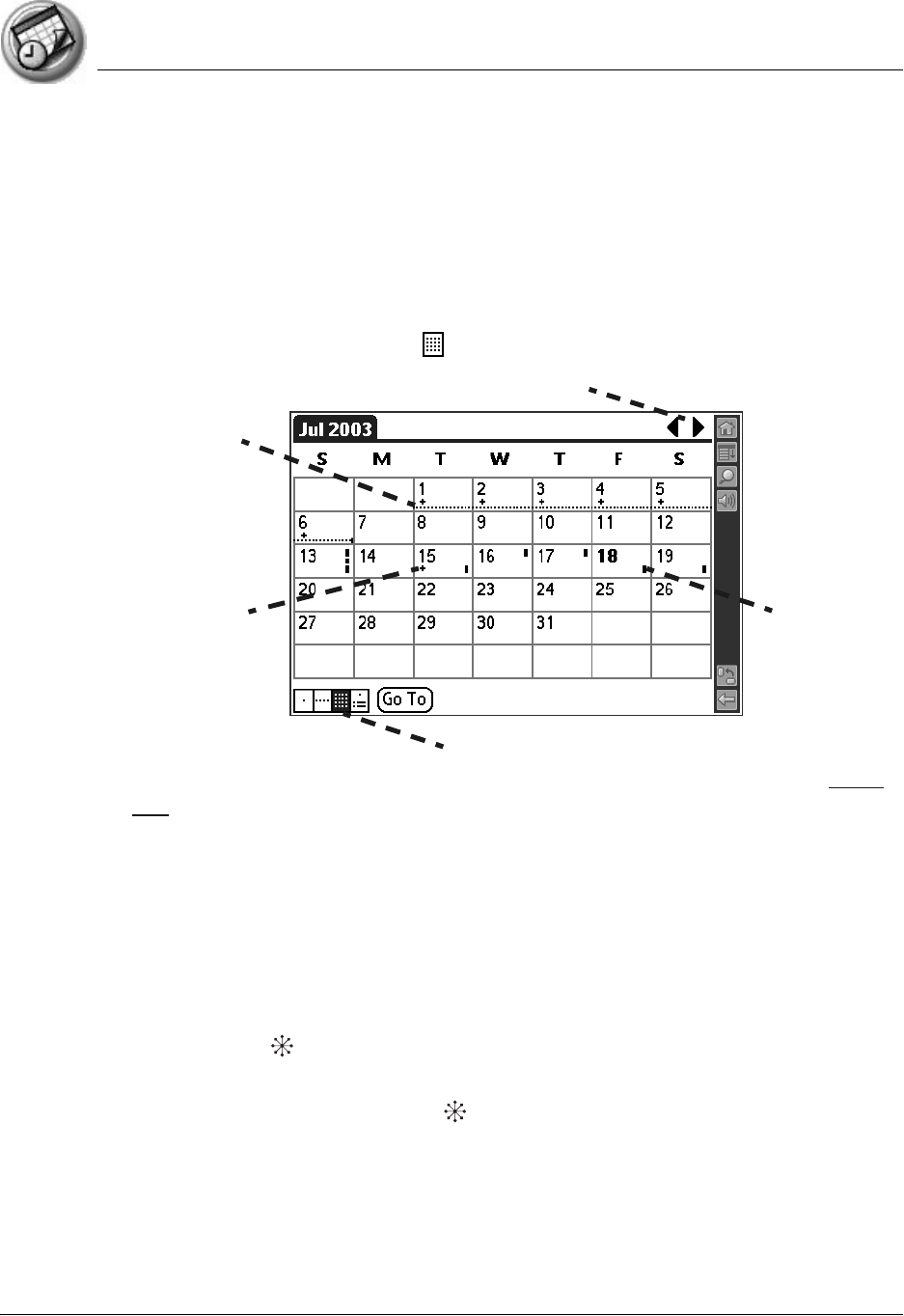
Using Date Book
Changing the Date Book view
Using Your Zodiac Handheld 98
Working in Month view
The Month view screen shows which days have events scheduled. Dots and
lines in the Month view indicate events, repeating events, and untimed
events.
Displaying the Month view
•Tap the Month view icon .
You can control the dots and lines that appear in the Month View. See page
100 for more information.
Tips for using Month view
Keep the following points in mind when using the Month view:
•Tap a day in the Month view to display that day in the Day view.
•Tap the scroll arrows in the upper-right corner to move forward or
backward a month, or when no date is selected, move the analog
controller Left to display the previous month and Right to display
the next month.
•Move the analog controller to scroll between days and months.
When a date is selected, move Left to display the previous day and
Right to display the next day.
•Tap Go To to open the date selector and select a different month.
Previous/next month
Bar on right
side indicates
event
Dashed line
indicates
continuous
event
Plus below
date indicates
untimed event
Month View icon
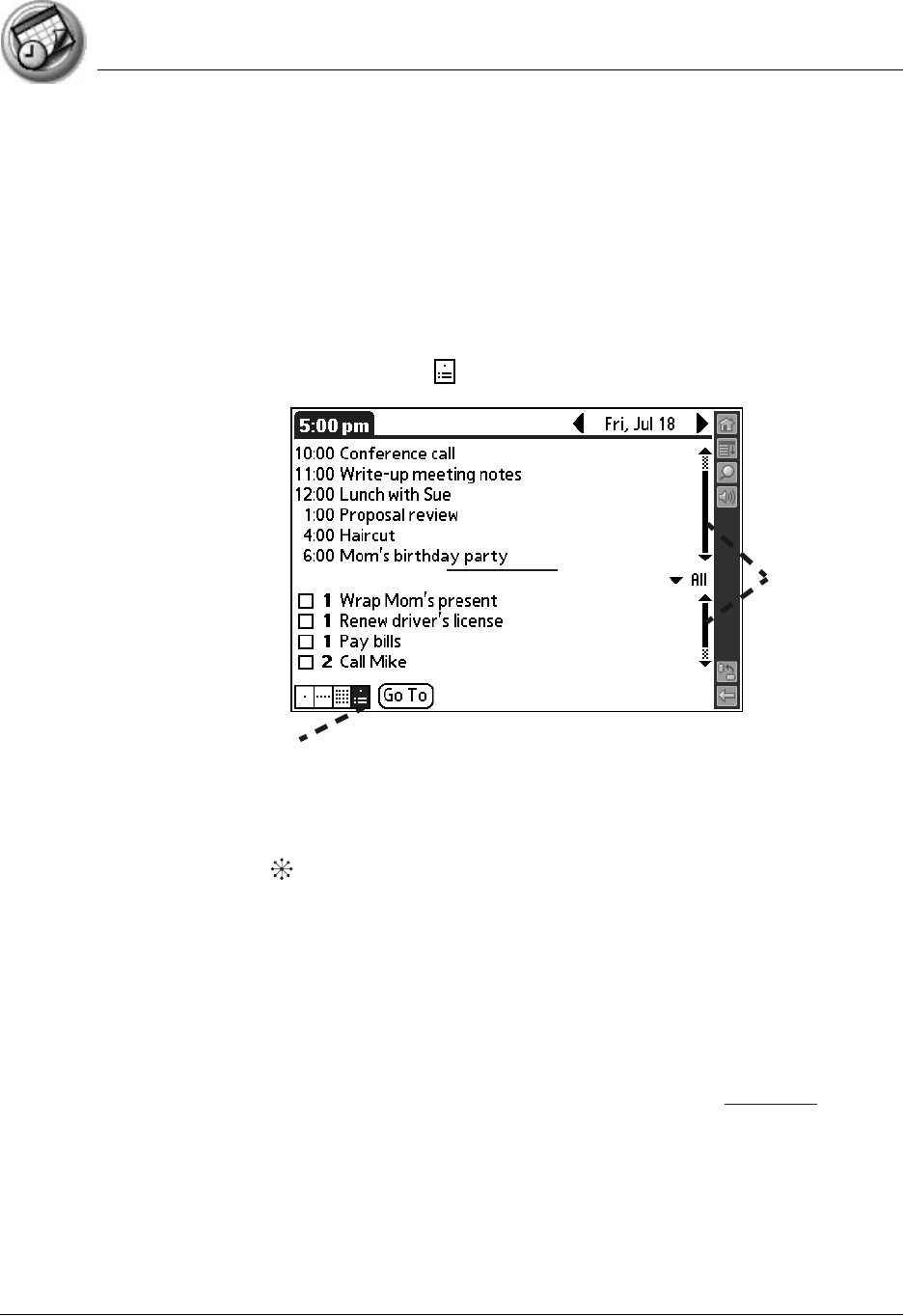
Using Date Book
Changing the Date Book view
Using Your Zodiac Handheld 99
Working in Agenda view
The Agenda view lets you view appointments, untimed events, and To Do List
items in a single screen. Although it is primarily a viewing option, you can also
use the Agenda view to check off completed To Do List items. To go to a Day
View of any event on the Agenda view screen, simply tap the desired event.
Displaying the Agenda View
•Tap the Agenda view icon .
Tips for using Agenda view
•Tap the scroll arrows in the upper-right corner or move the analog
controller Right or Left to scroll forward or backward a day at a time
or to display more To Do items.
•Tap any appointment while in Agenda view to display the Day View of
the appointment.
•Check off completed To Do List items in the Agenda view, or tap a
description of an item to go directly into To Do List.
•You can change the category of To Do items shown. From the pick list,
select the new category. See the chapter that begins on page 106 for
more information on To Do items.
Scroll the list
for each view
Agenda view icon
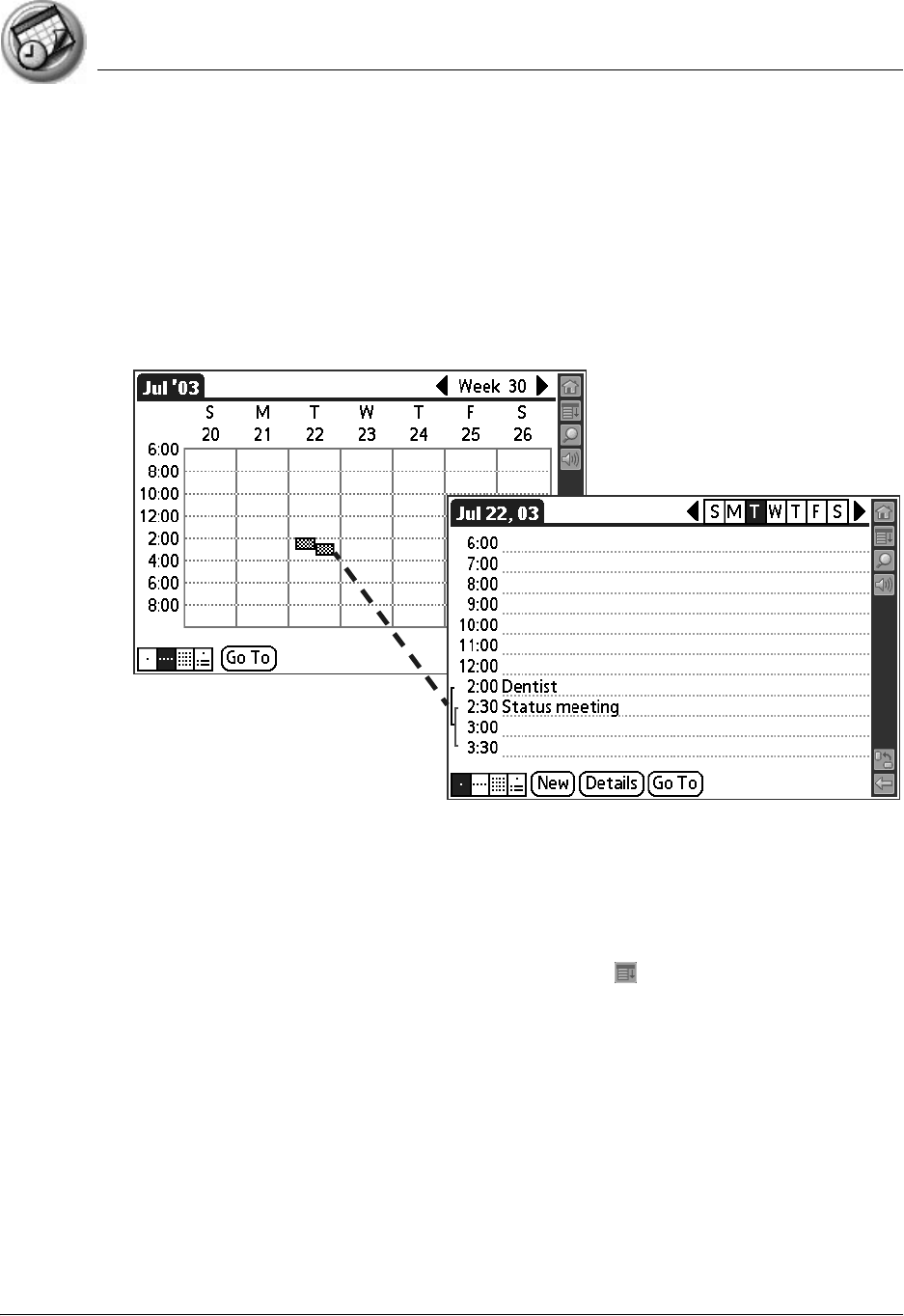
Using Date Book
Spotting event conflicts
Using Your Zodiac Handheld 100
Spotting event conflicts
With the ability to define specific start and end times for any event, it is
possible to schedule events that overlap (an event that starts before a
previous event finishes).
An event conflict (time overlap) appears in the Week view as overlapping time
bars and in the Day view as overlapping brackets to the left of the conflicting
times.
Changing the Date Book display
In Day or Month view, you can change which events appear in Date Book. In
Day view, you can display time bars that highlight event conflicts.
1. In Day view or Month view, tap the Menu icon .
2. From the Options menu, select Display Options.
Event
conflict
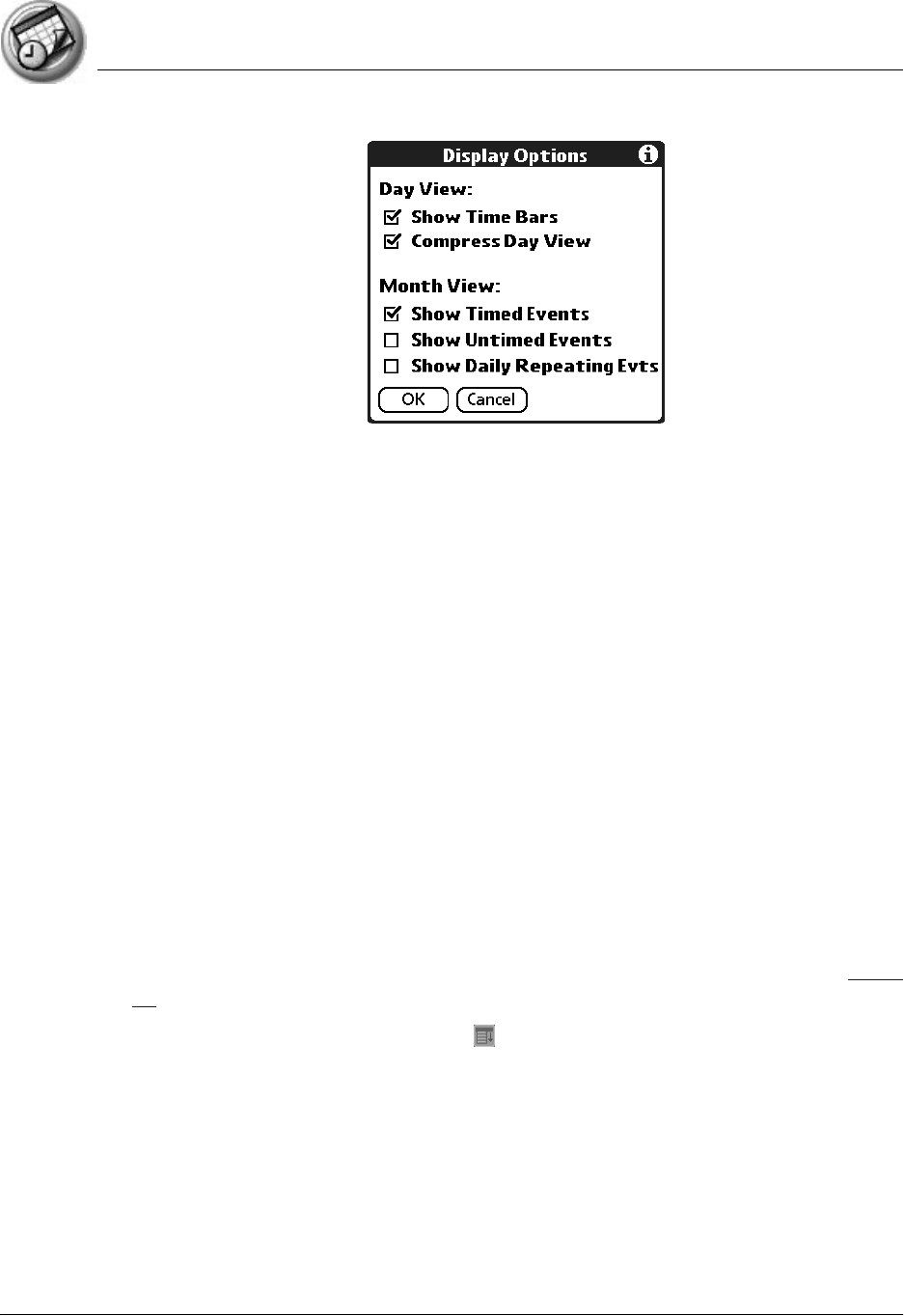
Using Date Book
Changing the Date Book display
Using Your Zodiac Handheld 101
3. For Day view, select from the following options:
•Show Time Bars. Display time bars showing the duration of an event
and any event conflicts.
•Compress Day View. Display start and end times for each event, but
no blank time slots at the bottom of the screen, to minimize scrolling.
Clear the option to display all time slots.
4. For Month view, select from the following options.
•Show Timed Events. Display time bars for events.
•Show Untimed Events. Display plus symbols for untimed events.
•Show Daily Repeating Evts. Display dashed lines for continuous
events.
5. Tap OK.
Changing the displayed Start and End Times
You can change the preferences used for new entries. Preferences include
display starting time, display ending time, and alarm characteristics. See page
95 for more information on alarm preferences.
1. In Date Book, tap the Menu icon .
2. From the Options menu, select Preferences.
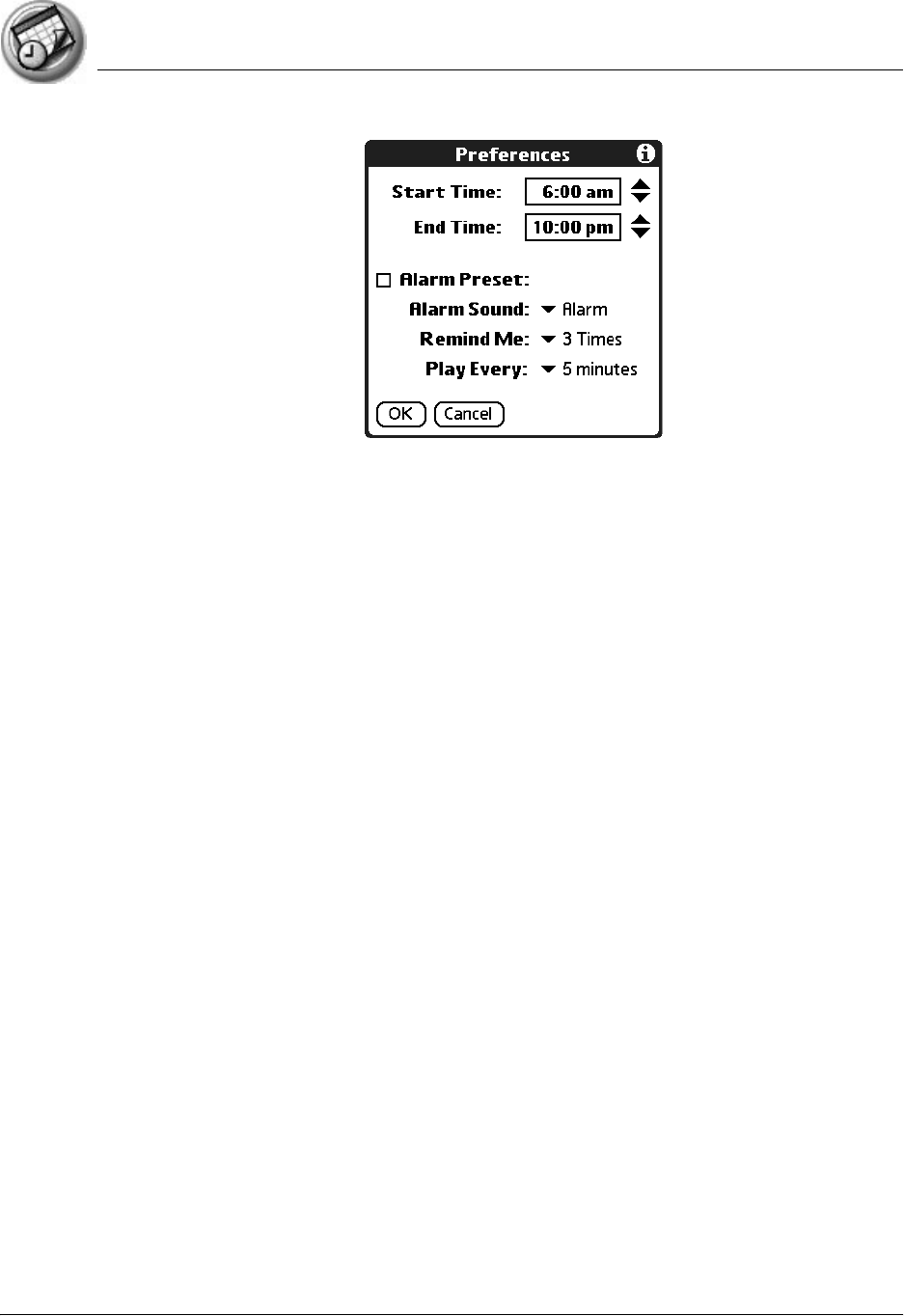
Using Date Book
Changing the Date Book display
Using Your Zodiac Handheld 102
The Start and End Time are used by the various Date Book screens. The Day
view schedules events to start and end at these times when the All Day option
is selected. The Week view displays the time span defined by the Start Time
and End Time.
3. Tap Start Time and use the scroll arrows to select a new start time for Date
Book screens. Repeat the step to set a new end time. If the time slots you
select do not fit on one screen, you can tap the scroll arrows to scroll up
and down.
4. Tap OK.
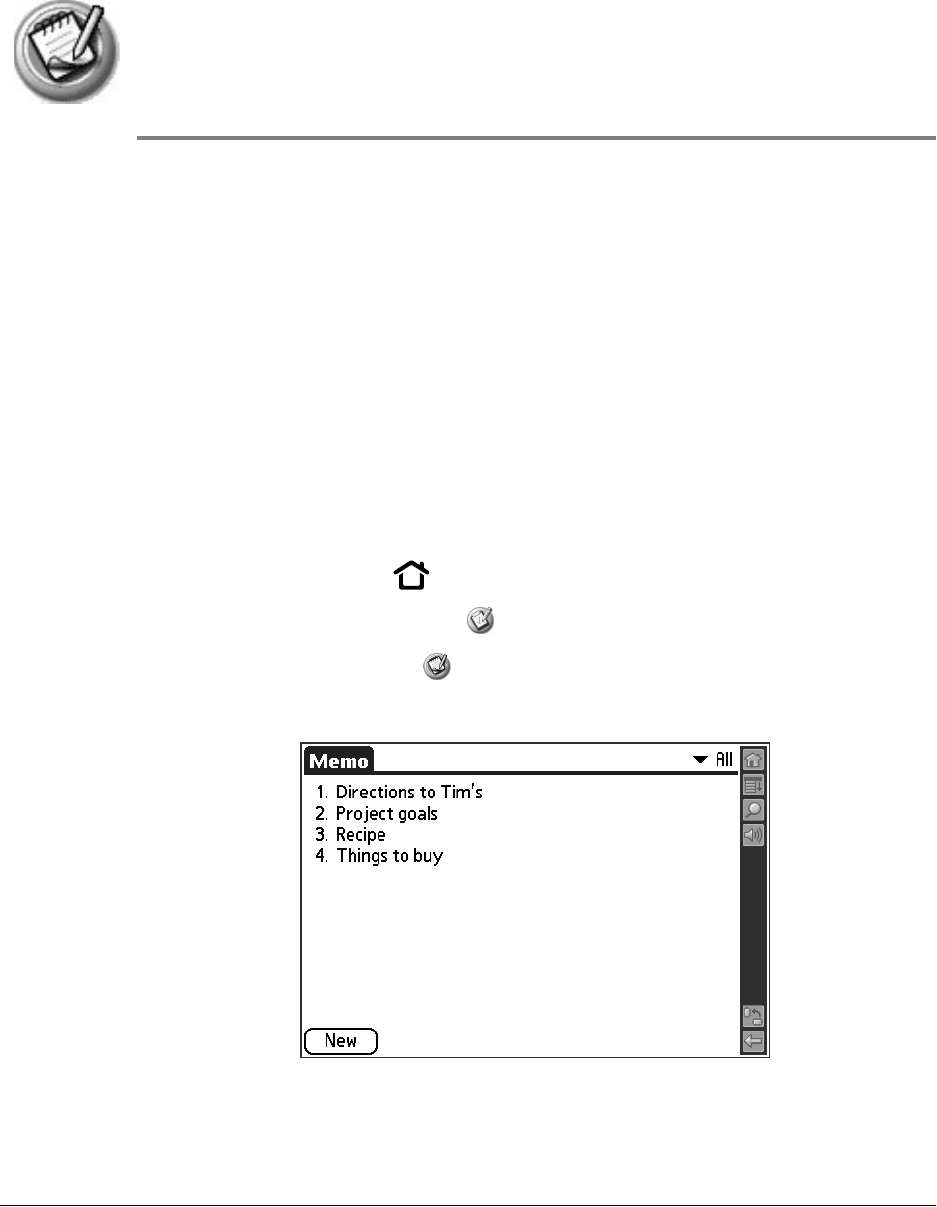
Using Your Zodiac Handheld 103
11
Using Memo Pad
Memo Pad provides a place to take notes that are not associated with records
in your other applications.
Use Memo Pad to:
•Take notes or write any kind of message on your handheld.
•Assign memos to categories so that you can organize and view them in
logical groups.
•Write down phone numbers and other types of information. Later, you
can copy and paste this information into other applications.
Opening Memo Pad
1. Press the Home button .
2. Select the Organizer category .
3. Select the Memo Pad icon .
Memo Pad opens to display the last Memo Pad screen that you viewed.
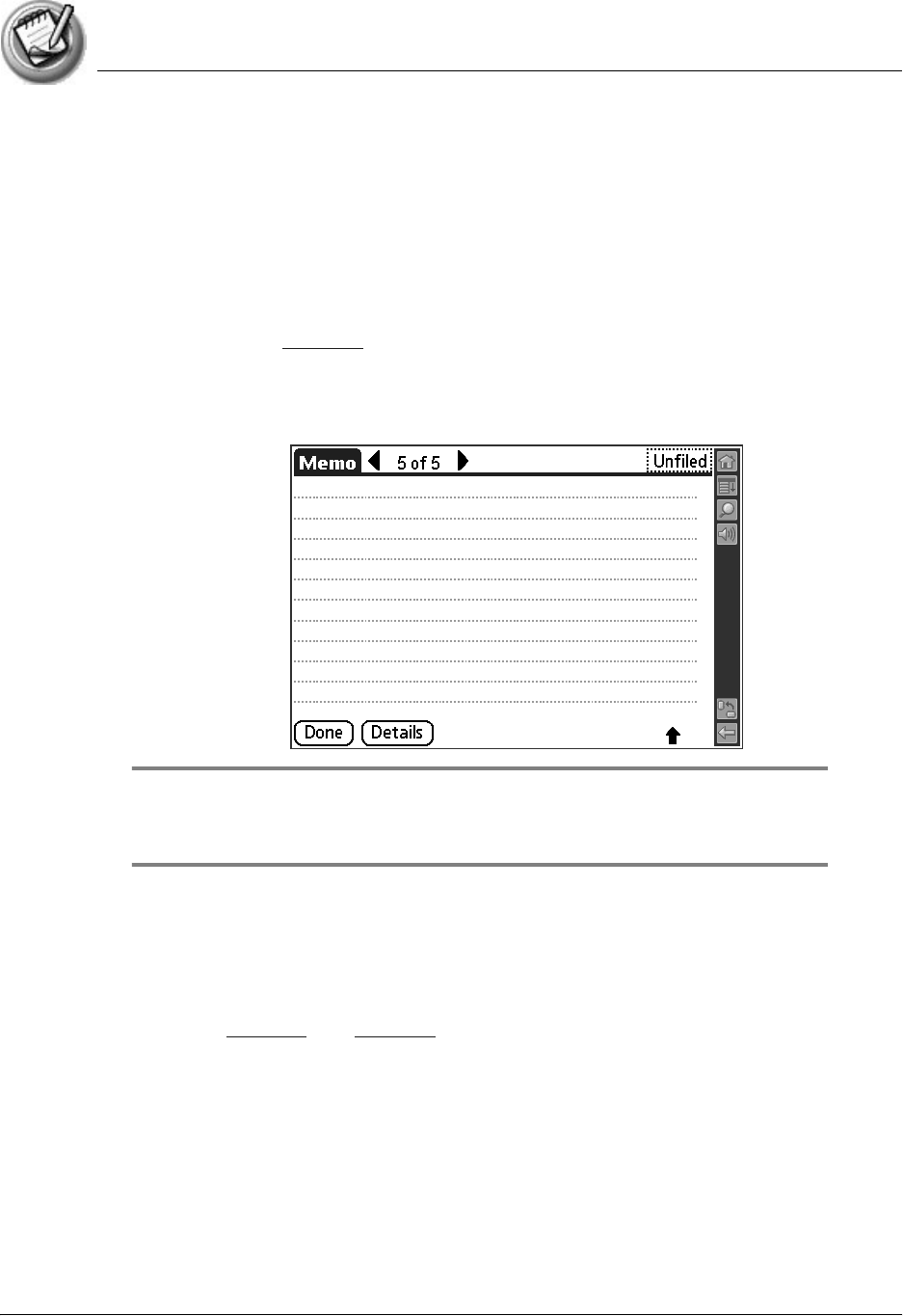
Using Memo Pad
Creating memos
Using Your Zodiac Handheld 104
Creating memos
A record in Memo Pad is called a memo. A memo can contain up to 4,000
characters. The number of memos you can store is limited only by the
memory available on your handheld.
When you create a new memo, you can add information to it from Address
Book, such as a phone number or address, using the Phone Lookup option.
For details, see page 71.
1. Open Memo Pad.
2. Tap New.
TIP: You can also create a new memo by beginning to write in the Input Area in
the Memo List screen. The first letter is automatically capitalized and begins your
new memo.
3. Enter the text you want to appear in the memo. Use the carriage return
stroke to move down to new lines in the memo.
4. Tap Done.
You can categorize memos and sort them by categories. See the sections that
begin on page 67 and page 72 for more information.
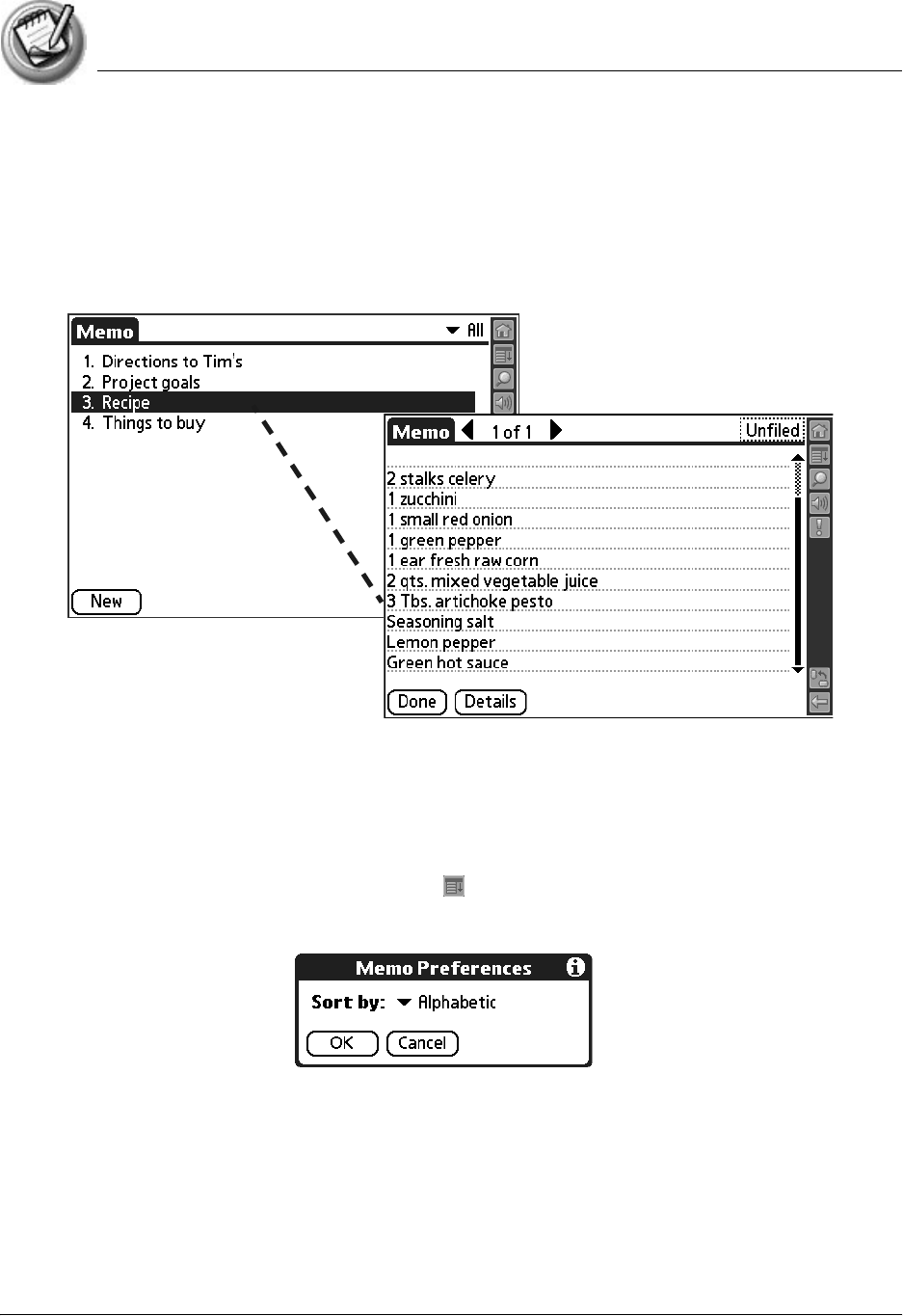
Using Memo Pad
Reviewing memos
Using Your Zodiac Handheld 105
Reviewing memos
The Memo List displays the first line of a memo. This makes it easy to locate
and review your memos. You can easily sort memos in the Memo List or move
through memos using Memo options.
1. In the Memo List, tap the text of the memo.
2. Review or edit the text in the memo.
3. Tap Done.
Arranging the Memo List
1. In the Memo List, tap the Menu icon .
2. From the Options menu, select Preferences.
3. Select one of the following options:
•Manual. Sort new memos in the sequence in which you create them.
•Alphabetical. Sort new and existing memos in numerical and then
alphabetical sequence.
4. Tap OK.
Tap a
memo to
review its
contents
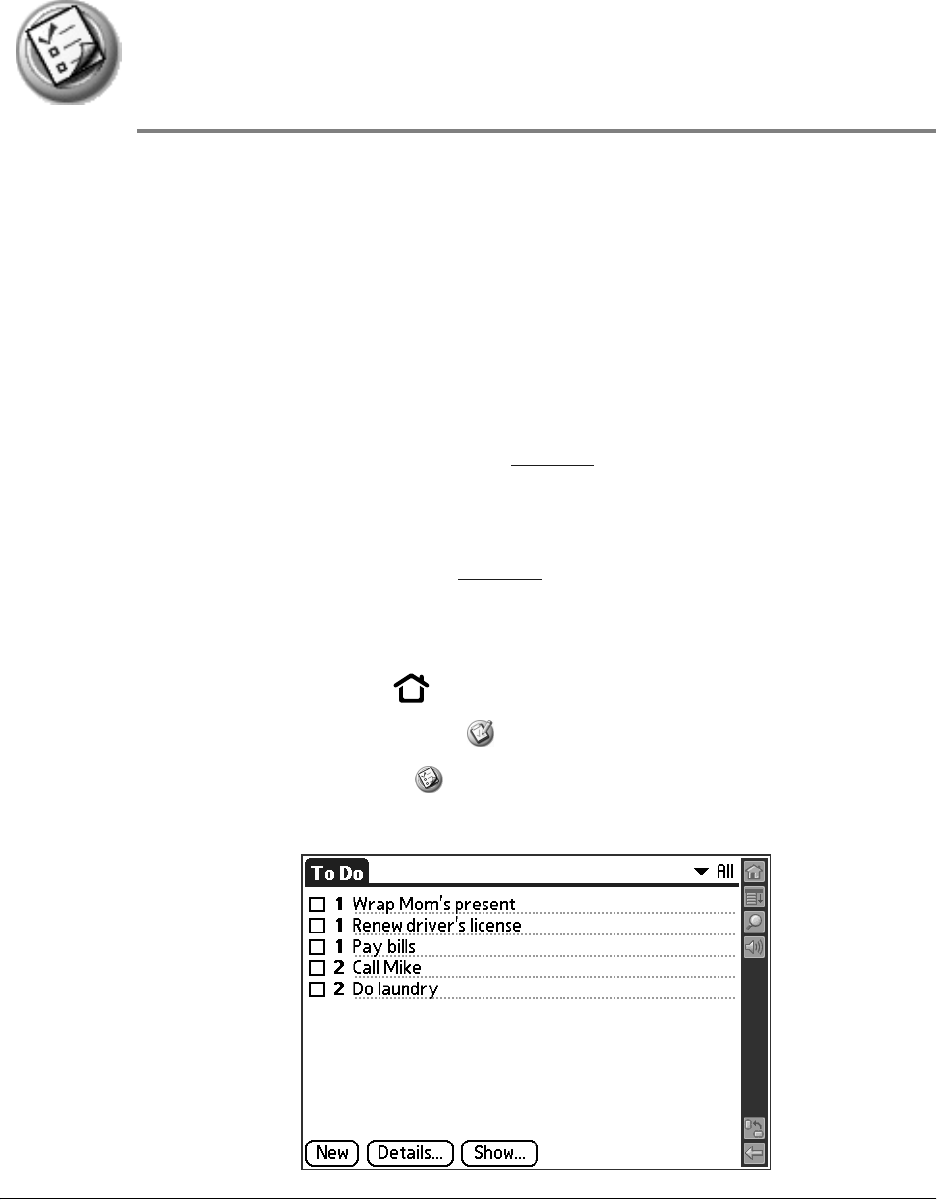
Using Your Zodiac Handheld 106
12
Using To Do List
To Do List is a convenient place to create reminders and prioritize the things
that you have to do.
Use To Do List to:
•Make a quick and convenient list of things to do.
•Assign a priority level to each task.
•Assign a due date for any or all of your To Do List items.
•Assign To Do List items to categories so that you can organize and
view them in logical groups (see page 67).
•Sort your To Do List items either by due date, priority level, or category.
•Attach notes to individual To Do List items for a description or
clarification of the task (see page 75).
Opening To Do List
1. Press the Home button .
2. Select the Organizer category .
3. Select the To Do List icon .
To Do List opens to display the category of items you last viewed.
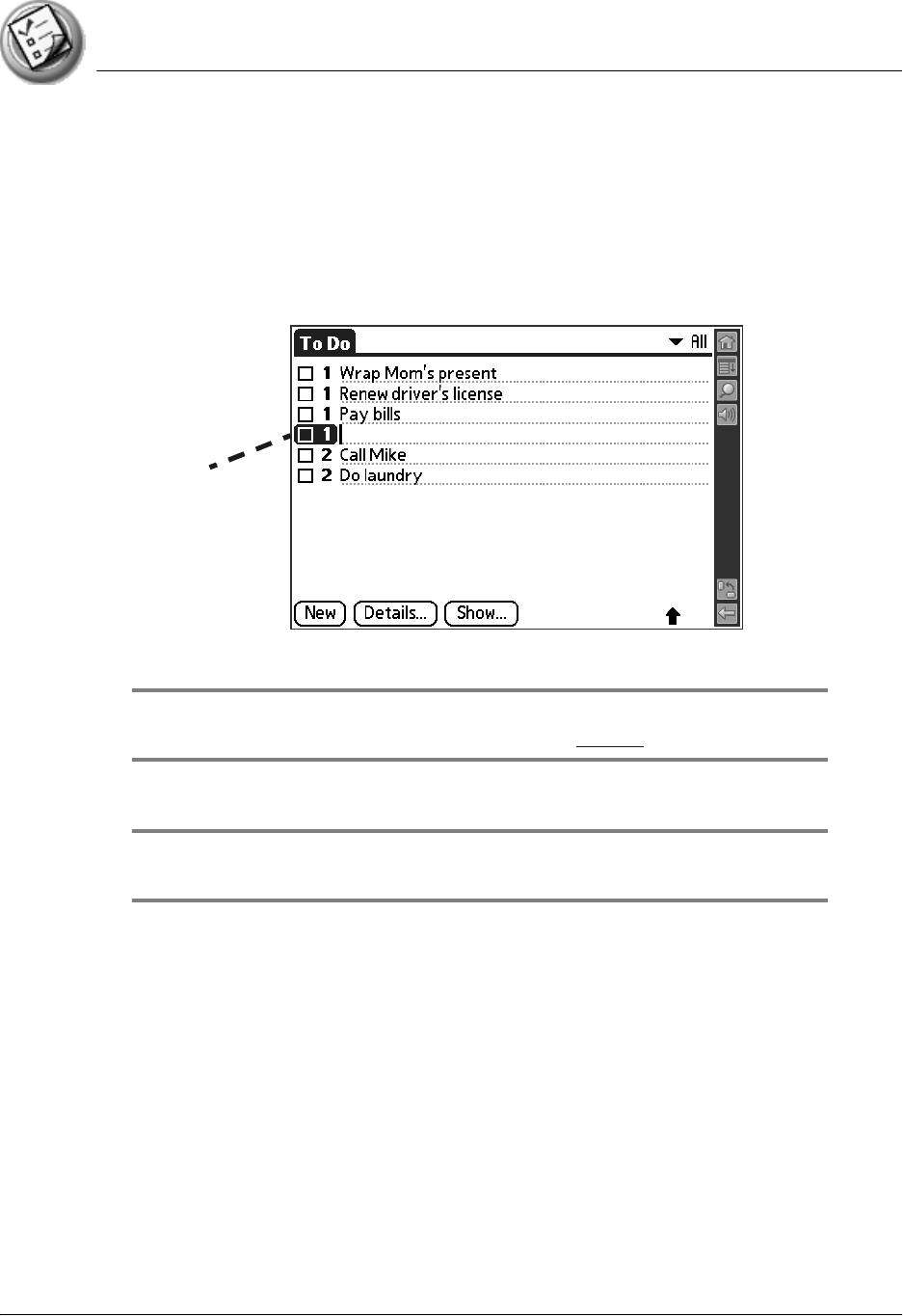
Using To Do List
Creating To Do List items
Using Your Zodiac Handheld 107
Creating To Do List items
A To Do List item is a reminder of some task that you have to complete. A
record in To Do List is called an item.
1. Open To Do List.
2. Tap New.
3. Enter the text of the To Do List item. The text can be longer than one line.
TIP: You can add a name, address, and phone number to a To Do List item using
the Phone Lookup option. For more information, see page 71.
4. Tap anywhere onscreen to deselect the To Do List item.
TIP: If no To Do List item is currently selected, writing in the Input Area
automatically creates a new item.
New To
Do item
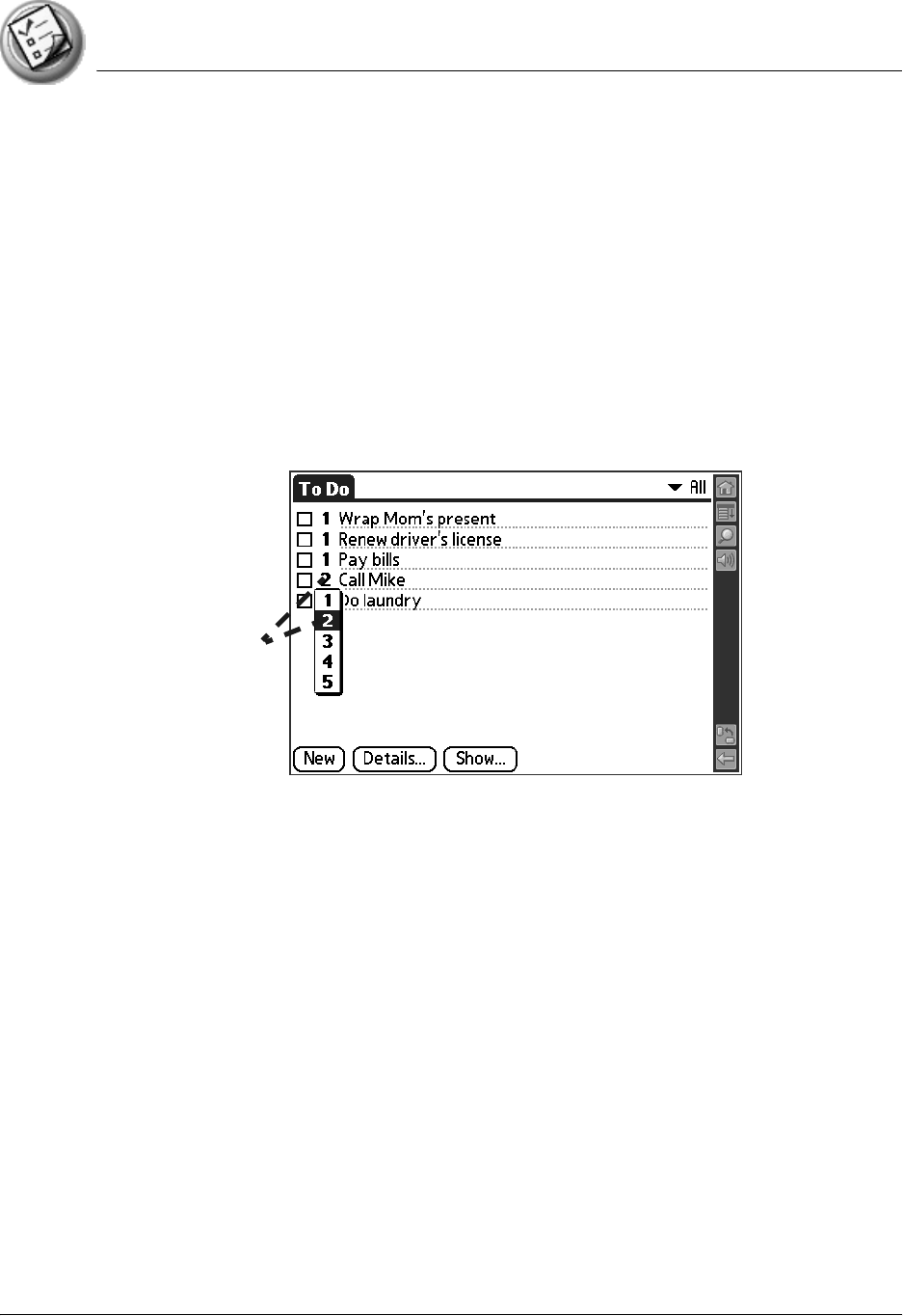
Using To Do List
Setting To Do List priorities
Using Your Zodiac Handheld 108
Setting To Do List priorities
You can set priorities for tasks in your To Do List according to their importance
or urgency. By default, items appear by priority and due date, with 1 as the
highest priority. Changing an item’s priority may move its position in the list.
New To Do List items automatically have a priority of 1. If you select another
item first, before creating a new item, the item you create appears beneath
the selected item with the same priority as the selected item.
1. If priorities aren’t visible in To Do List, tap Show at the bottom of the list,
tap Show Priorities, and tap OK.
2. Tap the Priority number on the left side of the To Do List item.
3. Tap the Priority number that you want to set. 1 is the most important and
5 is the least important.
Tap to
select
priority
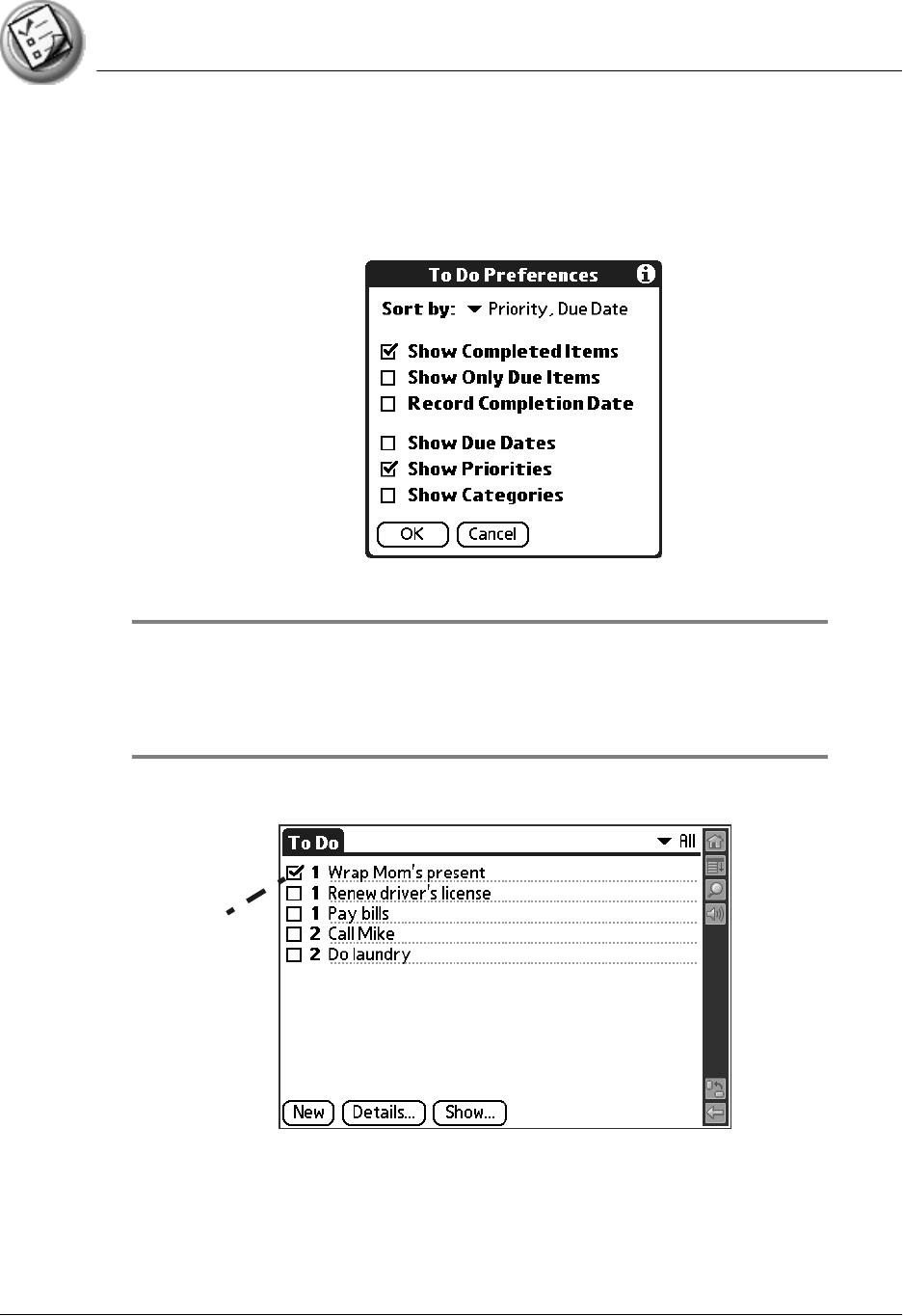
Using To Do List
Checking off To Do List items
Using Your Zodiac Handheld 109
Checking off To Do List items
You can check off a To Do List item to indicate that you’ve completed it.
1. In To Do List, tap Show.
2. Check the Show Completed Items box.
NOTE: If you uncheck this setting, your To Do items disappear from the list when you
complete (check) them. Items that no longer appear on the list because Show Completed
Items is turned off have not been deleted. They are still in the memory of your handheld.
You must purge completed items to remove them from memory.
3. Check the box on the left side of the item.
Completed
To Do item
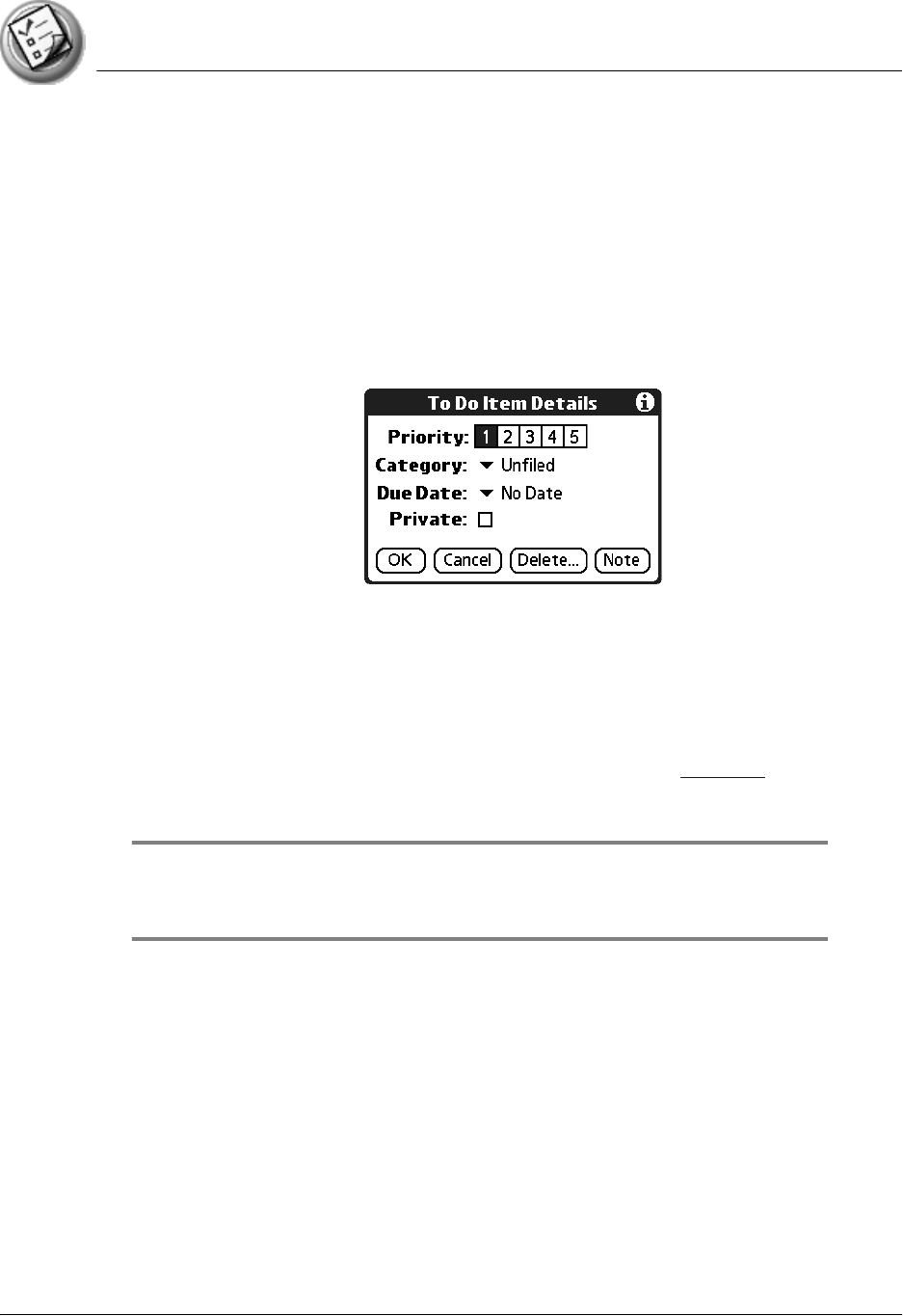
Using To Do List
Changing priorities and due dates
Using Your Zodiac Handheld 110
Changing priorities and due dates
You can change To Do List to display the due date assigned to an item, change
its priority, and assign a category to the task with the To Do Item Details
dialog box.
You can then sort To Do List items by priority, due date, or category.
1. In To Do List, tap the item that you want to change.
2. Tap Details.
3. From the Due Date pick list, select the date that you want to assign the
item. Options are Today, Tomorrow, One Week from the current date, No
Date (removes the due date from the item), or Choose Date (displays a
dialog box for you to select a date).
4. Tap Private to hide this item when Security is turned on.
For more information on hiding private records, see page 74.
5. Tap OK.
TIP: If you turn on the Show Due Dates option in the To Do Preferences dialog
box, you can tap directly on the due date in To Do List to open the pick list shown in
step 2.
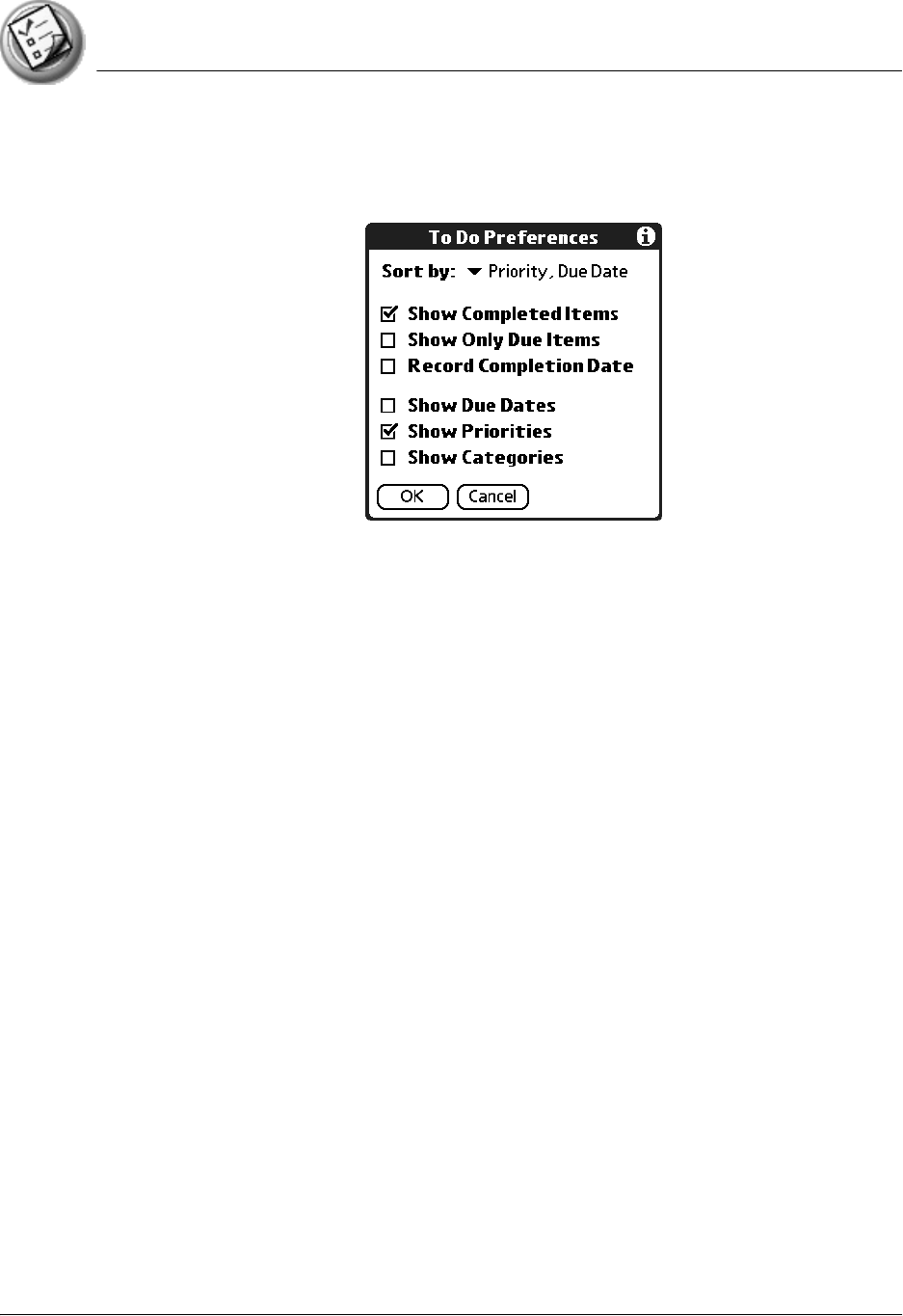
Using To Do List
Sorting To Do items
Using Your Zodiac Handheld 111
Sorting To Do items
1. In To Do List, tap Show.
2. From the Sort By pick list, select an option:
•Priority, Due Date. Sort items by priority first, and then due date.
•Due Date, Priority. Sort items by due date first, and then priority.
•Category, Priority. Sort items by category first, and then priority.
•Priority, Category. Sort items by priority first, and then category.
3. Tap OK.
Setting To Do List preferences
You can have To Do List display completed items and their completion dates,
as well as due items and their due dates.
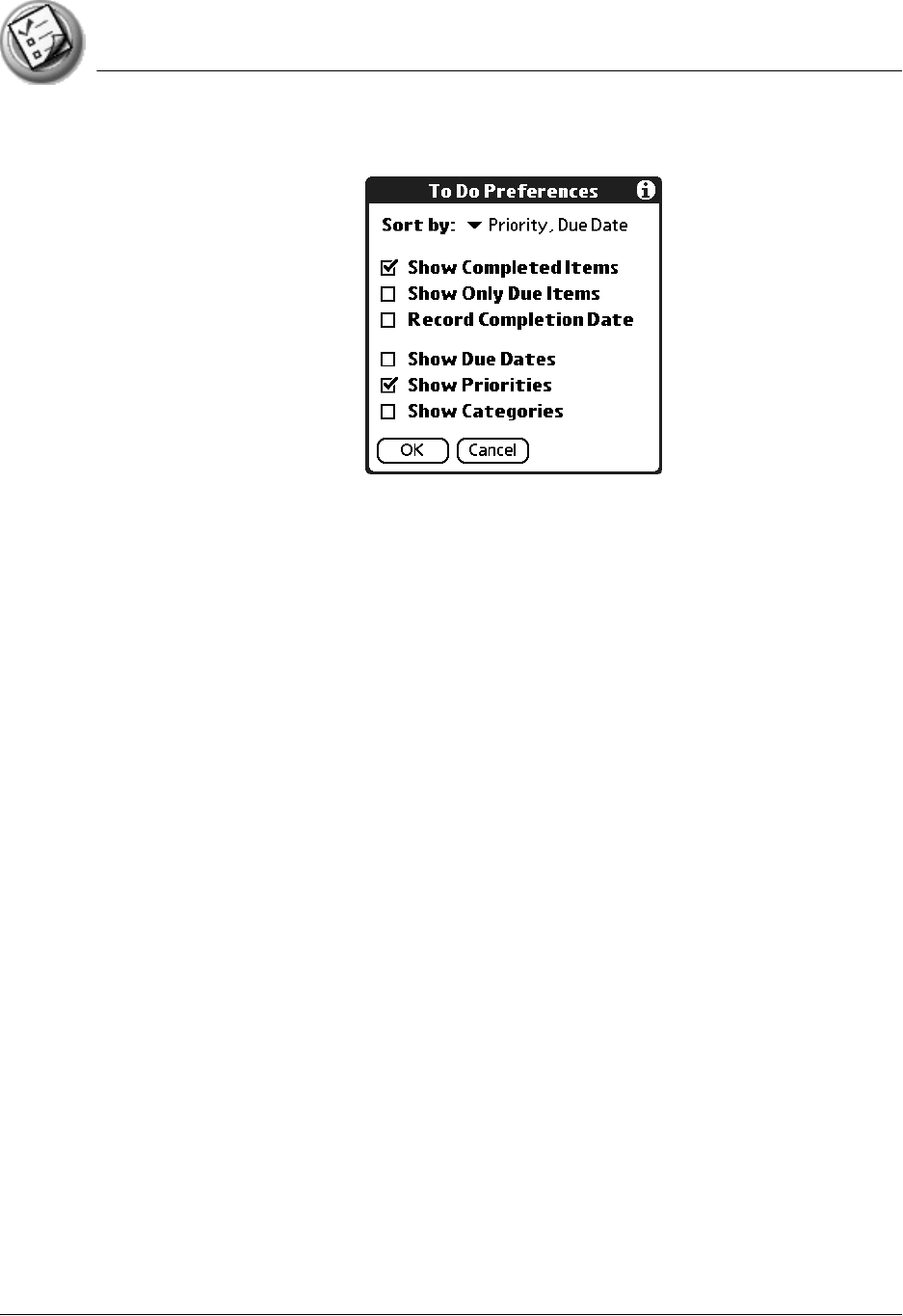
Using To Do List
Setting To Do List preferences
Using Your Zodiac Handheld 112
1. In To Do List, tap Show.
2. In the To Do Preferences dialog box, choose from the following settings:
•Show Completed Items. Display your completed items in To Do List. If
this box is unchecked, completed To Do items disappear from the list,
but are kept in the memory of your handheld. You must purge
completed items to remove them from memory.
•Show Only Due Items. Show only the items that are currently due,
past due, or have no due date specified. When this box is checked,
items that are not yet due do not appear in the list until their due date.
•Record Completion Date. Replace the due date with the actual
completion date (when you check the item). If you do not assign a due
date, the completion date still records when you complete the item.
•Show Due Dates. Display the due dates for items in To Do List, and
display an exclamation mark next to items that remain incomplete
after the due date passes.
•Show Priorities. Display the item priority to the left of each item in To
Do List.
•Show Categories. Display the category to which the item is assigned
to the right of each item in To Do List.
3. Tap OK.
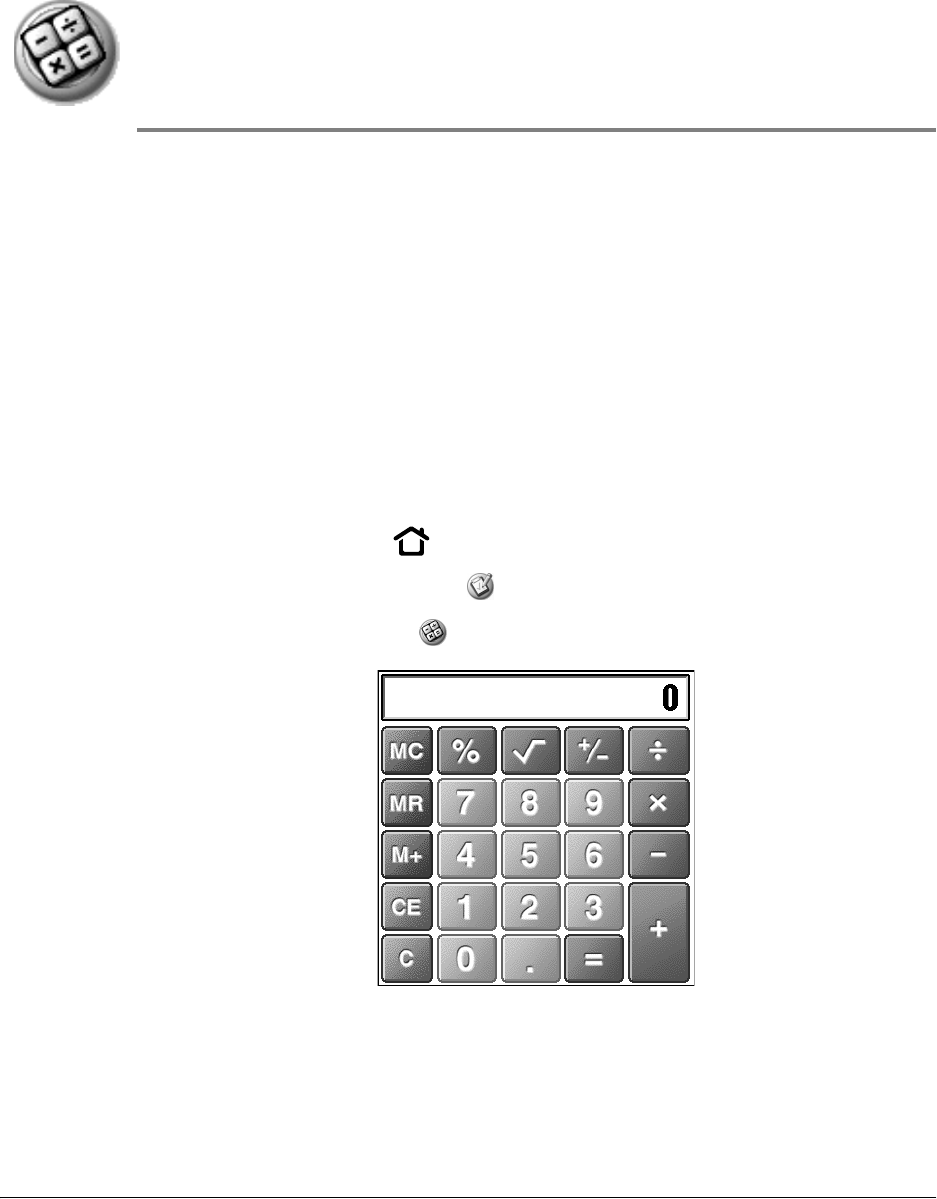
Using Your Zodiac Handheld 113
13
Using Calculator
Calculator lets you perform general mathematical functions, such as addition,
subtraction, multiplication, and division.
Use Calculator to:
•Perform basic calculations.
•Store and retrieve values.
•Display the last series of calculations, which is useful for confirming a
series of “chain” calculations.
Opening Calculator
1. Press the Home button .
2. Select the Organizer category .
3. Select the Calculator icon .
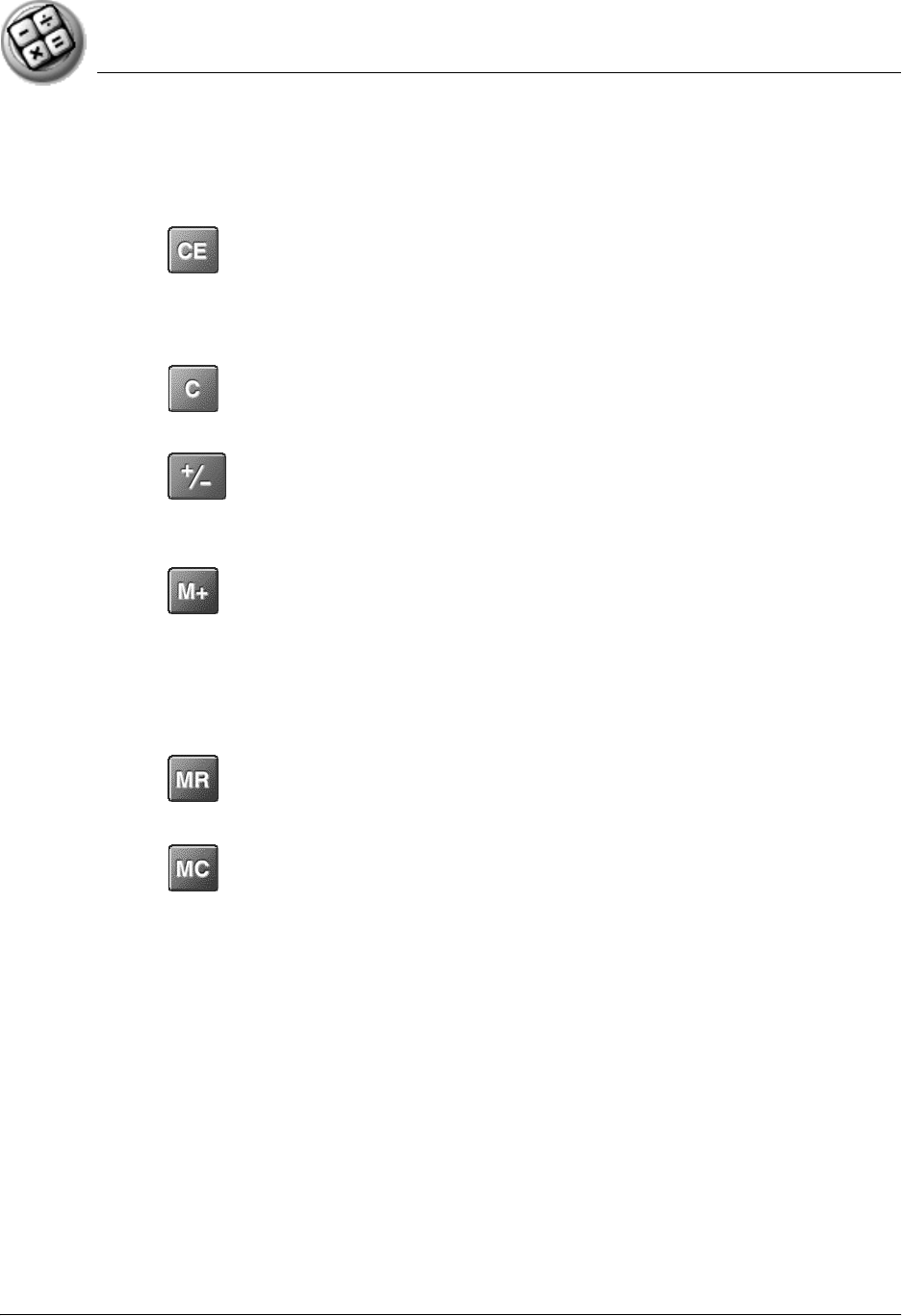
Using Calculator
Using the Calculator buttons
Using Your Zodiac Handheld 114
Using the Calculator buttons
Calculator includes several buttons to help you perform calculations.
•Clears the last number you entered. Use this button if you make a
mistake while entering a number in the middle of a calculation. This
button enables you to re-enter the number without starting the
calculation over.
•Clears the entire calculation and enables you to begin a fresh
calculation.
•Toggles the current number between a negative and positive
value. If you want to enter a negative number, enter the number first
and then press the +/- button.
•Places the current number in memory. Each new number you
enter with the M+ button is added to the total stored in memory. The
number that you add can be either a calculated value or entered by
pressing the number buttons. Pressing this button has no effect on the
current calculation (or series of calculations); it merely places the value
into memory until it is recalled.
•Recalls the stored value from memory and inserts it in the current
calculation.
•Clears any value stored in Calculator’s memory.
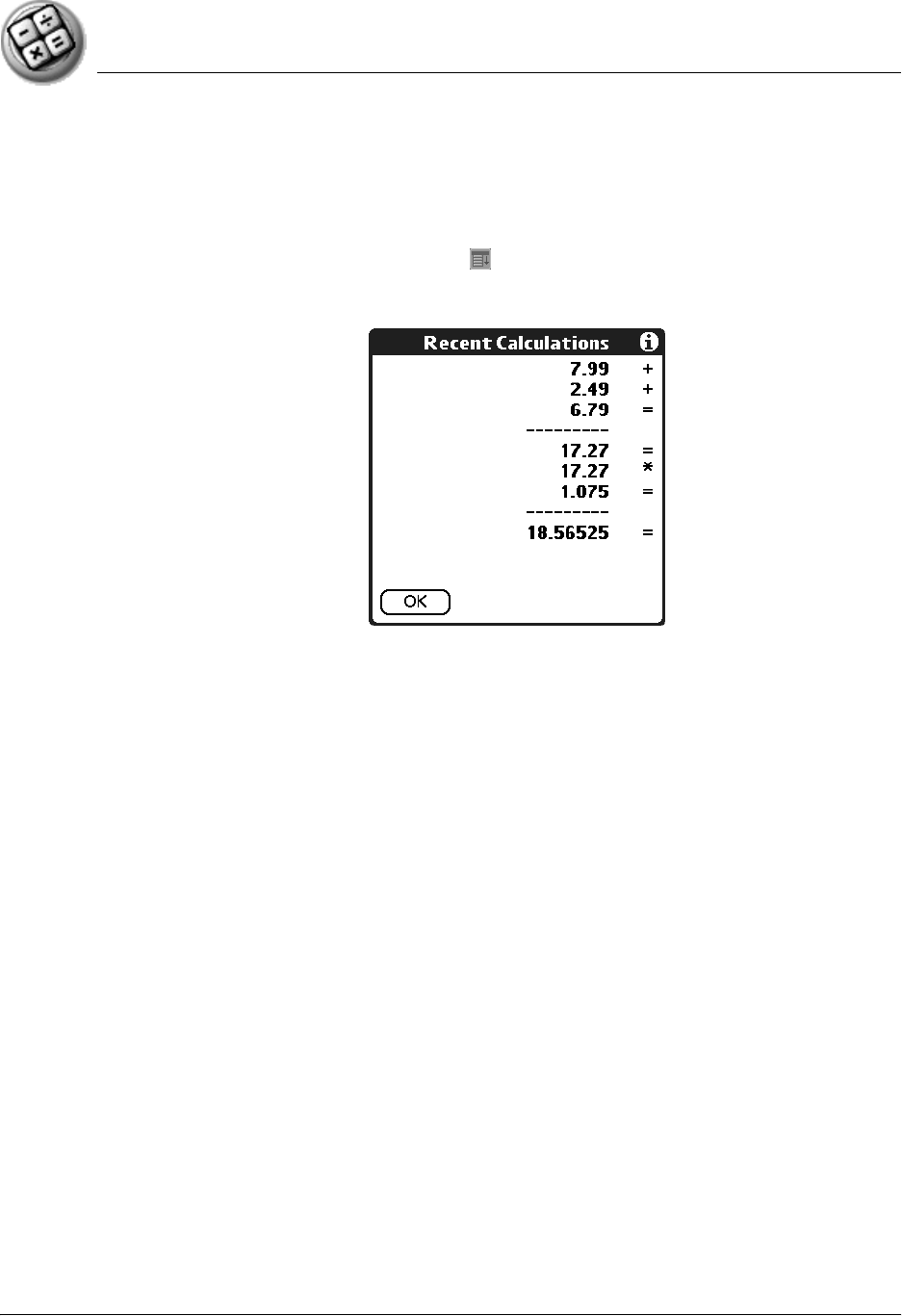
Using Calculator
Displaying recent calculations
Using Your Zodiac Handheld 115
Displaying recent calculations
The Recent Calculations command lets you review the last series of
calculations and helps you confirm a chain of calculations.
1. In Calculator, tap the Menu icon .
2. From the Options menu, select Recent Calculations.
3. After you finish reviewing the calculations, tap OK.

Using Your Zodiac Handheld 116
14
Setting Preferences
The Preferences screens enable you to customize your handheld in a variety of
ways. Your handheld includes the following Preferences screens:
•Bluetooth
•Calibration
•Connection
•Date & Time
•Formats
•General
•Graffiti 2
•Network
•Owner
•Phone
•ShortCuts
•Sound
Opening the Preferences screens
1. Press the Home button .
2. Select the Prefs category .
3. Select the Preferences screen you want to view.
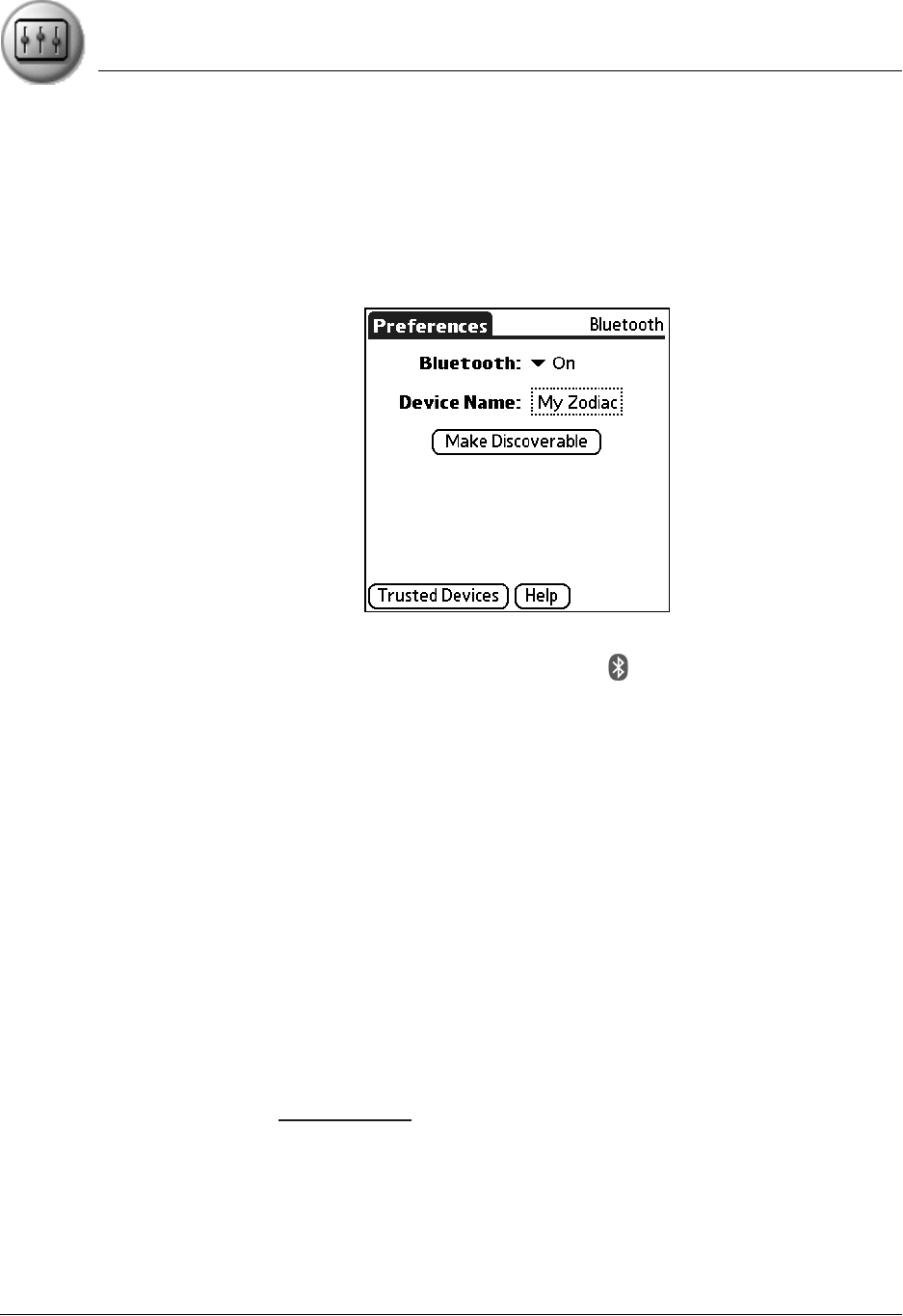
Setting Preferences
Bluetooth
Using Your Zodiac Handheld 117
Bluetooth
The built-in Bluetooth radio enables you to play multi-player games and
exchange data with other devices enabled with Bluetooth technology. The
Bluetooth Preferences settings control the built-in Bluetooth radio, and
include the following:
•Bluetooth. Turn the Bluetooth radio on and off. You can also turn this
option on by pressing the Bluetooth button .
•Device Name. Assign a name to your handheld for Bluetooth
communication. By default the device name is the same as your
HotSync user name.
•Make/End Discoverable. Indicate whether you want your handheld
to automatically connect with devices with which you have previously
formed a trusted pair. You can still refuse invitations from
unrecognized devices.
•Trusted Devices. Create a buddy list of Bluetooth devices from which
your handheld should automatically accept communications. For each
device you must enter an identical passkey on both devices. If a device
without a recognized passkey attempts to communicate with your
handheld, it goes through the discovery and authentication process,
and you can choose to accept or reject the communication.
For additional information about using the Bluetooth features of you
handheld visit tapwave.com.
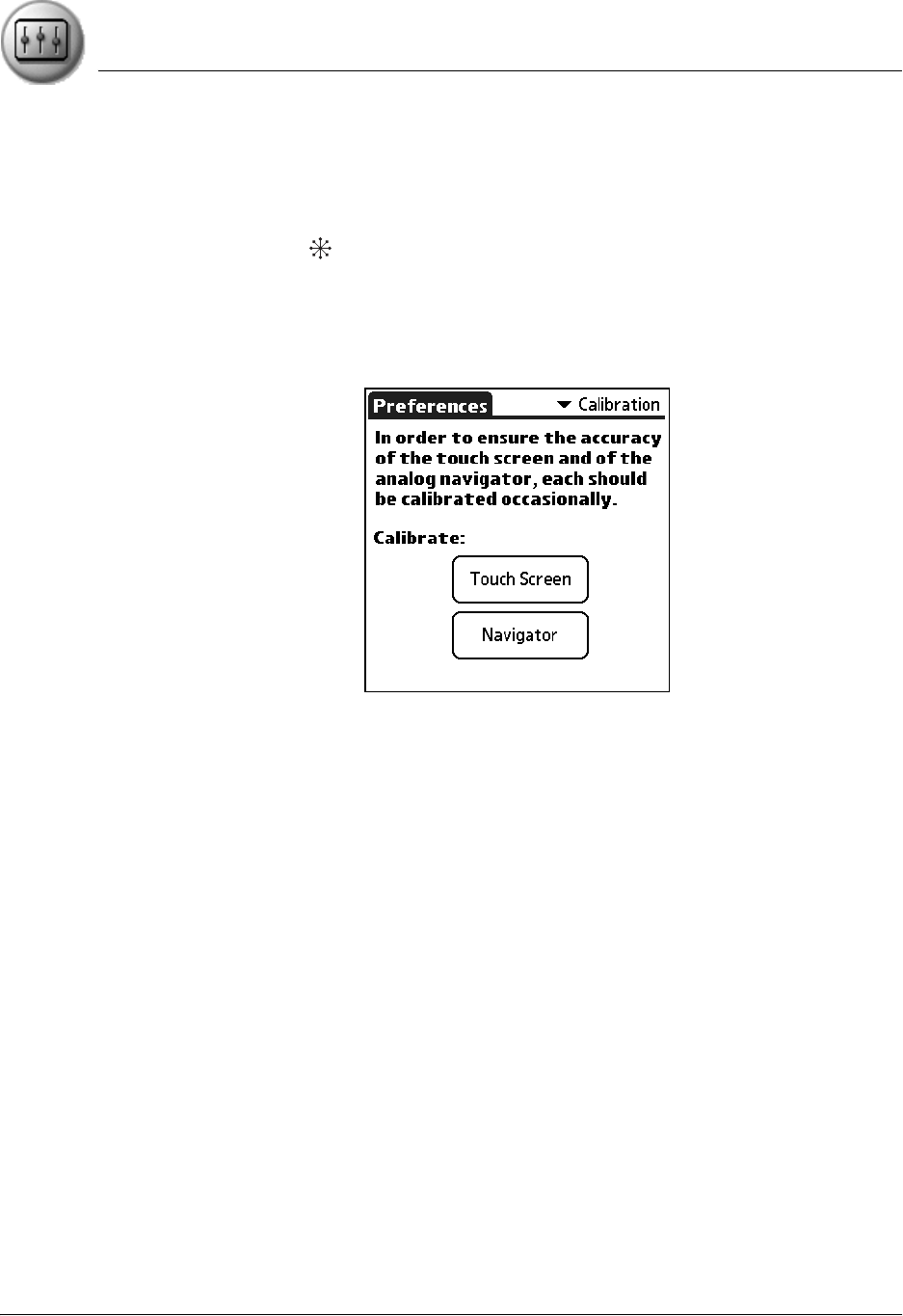
Setting Preferences
Calibration
Using Your Zodiac Handheld 118
Calibration
The Calibration Preferences screen enables you to calibrate your handheld so
that it accurately interprets taps on the touch-screen and movements of the
analog controller . If you tap an option on the screen and it activates a
different option, or if you move the analog controller and the insertion point
moves in the wrong direction, you need to calibrate. To calibrate the screen or
analog controller, simply follow the onscreen instructions and tap the targets
or move the analog controller as indicated.
Connection
The Connection Preferences screen allows you to create configurations that
enable your handheld to use a PC, modem, or GSM mobile phone to
communicate with remote devices such as your ISP or a remote computer---
provided the appropriate hardware is available. The Connection Preferences
screen displays a list of available configurations which is based on the
software installed on your handheld. If necessary you can use the buttons at
the bottom of the screen to add, modify, or delete configurations.
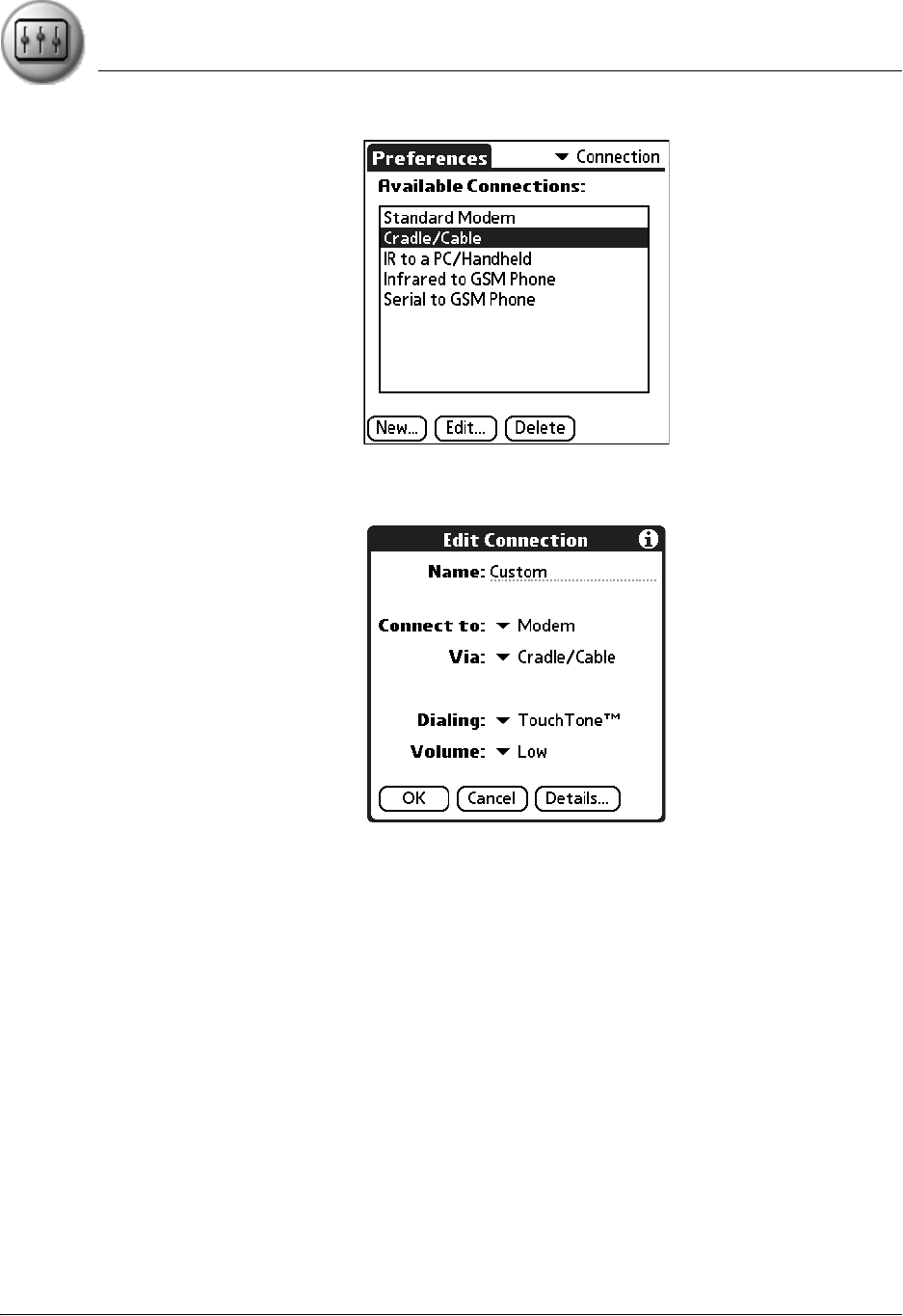
Setting Preferences
Connection
Using Your Zodiac Handheld 119
When you create or modify Connection Preferences, you are presented with
the following choices:
•Name. Assign or modify the configuration name. This is the label that
appears in the list in the Connection Preferences screen.
•Connect to. Select the type of device to which you want to connect
your handheld. The choices are: PC, Modem, Phone, and Local
Network.
•Via. Select the method you are using to connect your handheld and
the selected device. The choices are: Cradle/Cable, Infrared, and
Bluetooth.
•Dialing (modem only). Indicate whether to use Touchtone or Rotary
dialing tones. Select Rotary only if your telephone service does not
support TouchTone dialing.
•Volume (modem only). Indicate how loud you want the dialing tones.
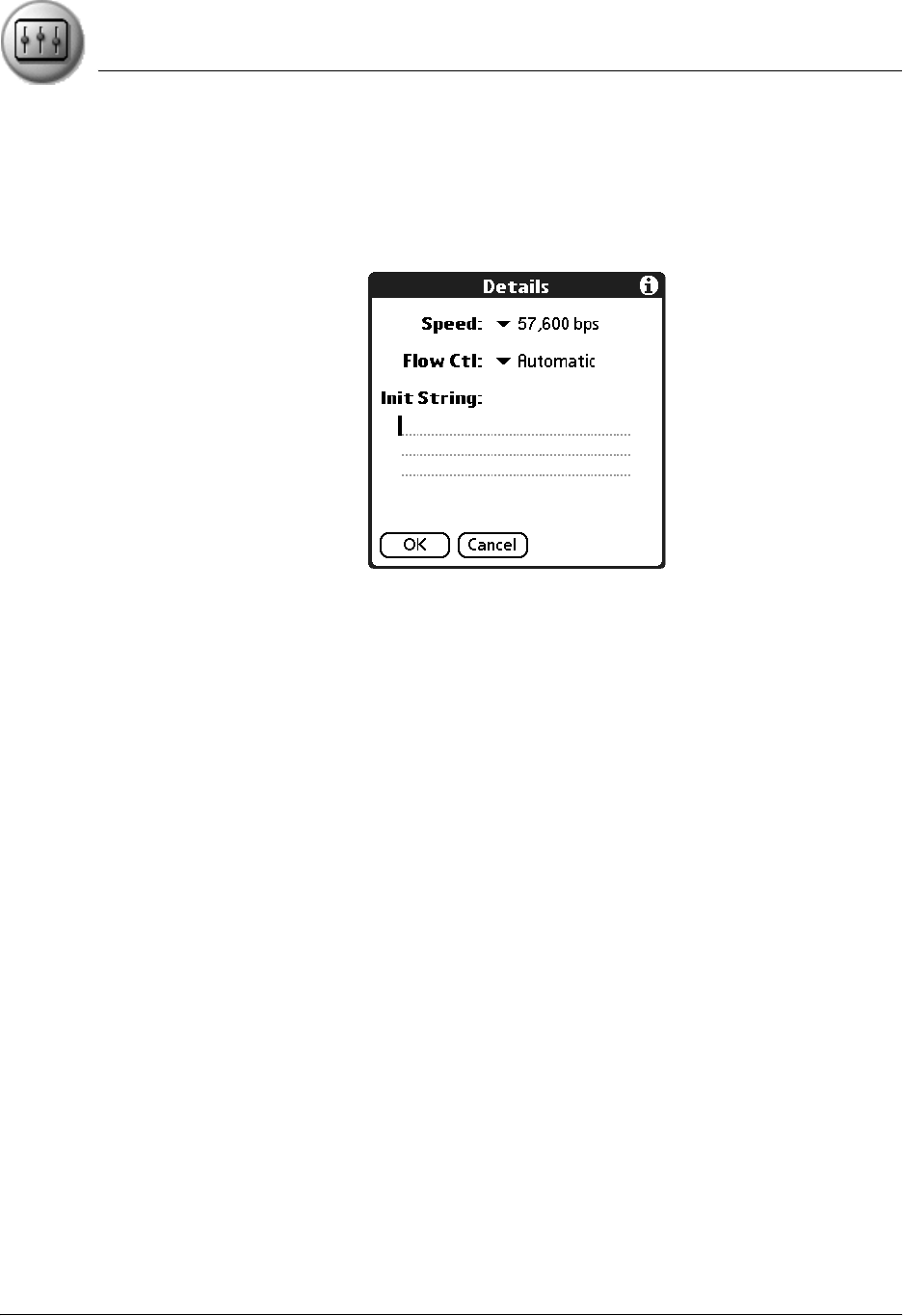
Setting Preferences
Date & Time
Using Your Zodiac Handheld 120
•Model (phone only). Select the model of your phone. If your phone
does not appear in the list, select Standard GSM, or install a phone
driver.
•Details. Provides access to the following additional settings:
–Speed. Select the maximum speed for your modem to
communicate with your handheld. This setting does not control the
speed at which your modem communicates with your telephone
service.
–Flow Ctl (Flow Control). Select a connection option. Options are
Automatic, On (Xon), or Off (Xoff).
–Init String (modem and phone only). Enter or edit text to change
the modem or phone setup string.
Date & Time
The Date & Time Preferences screen is where you set the date, time, time zone,
and Daylight Savings time for your handheld. These settings are used in all the
applications on your handheld which respect the system calendar and clock.
The Date & Time Preferences screen includes the following settings:
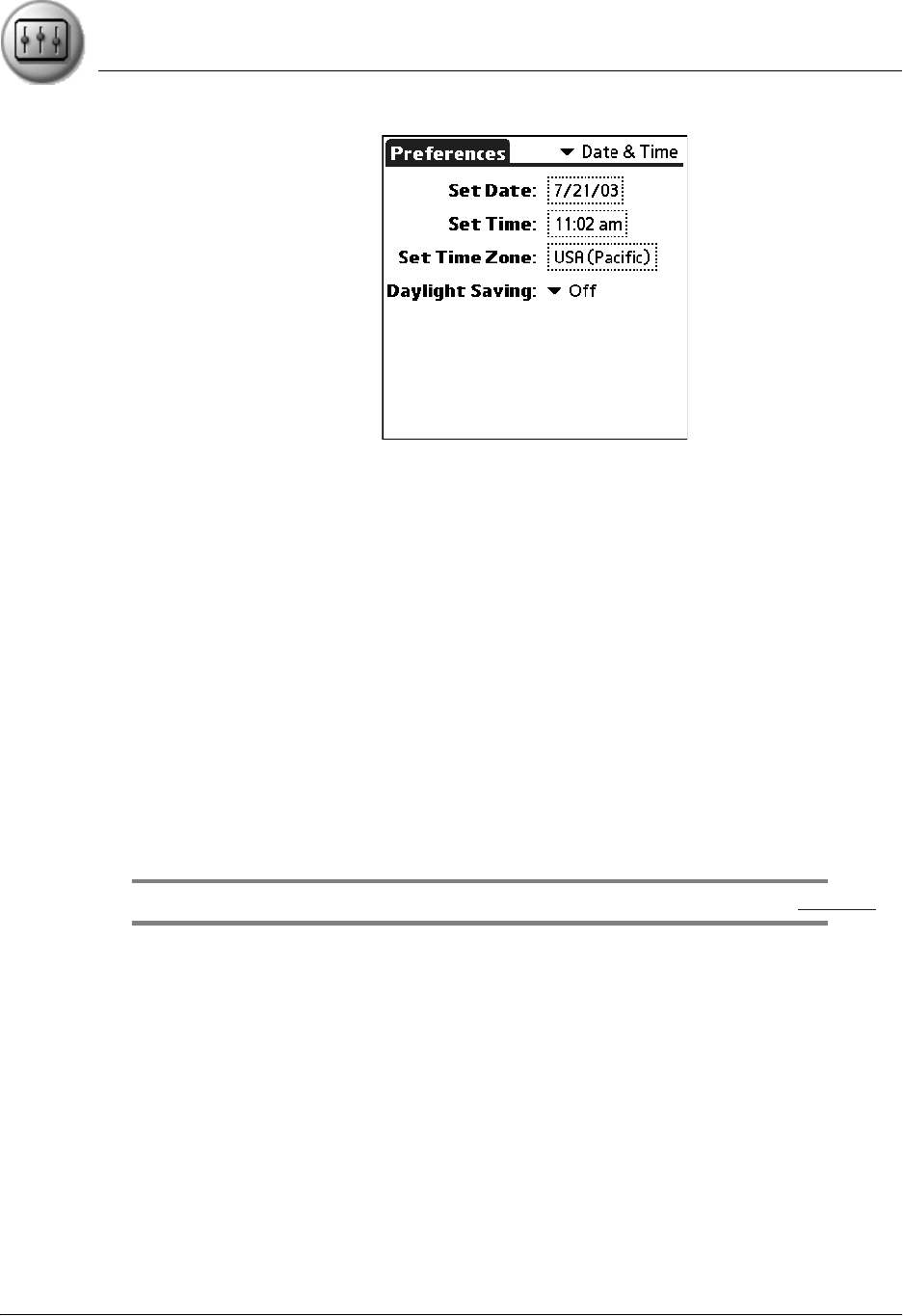
Setting Preferences
Date & Time
Using Your Zodiac Handheld 121
•Set Date. Set the system calendar by selecting the current date.
–Year. Tap the arrows at the top of the Set Date Screen to select the
current year.
–Month. Tap the box for the current month.
–Date. Tap the number for the current date.
–Today. Tap this button to accept your date selection.
•Set Time. Set the system clock by selecting the current time.
–Hour. Tap the hour box and then tap the arrows to change the
hour.
–Minutes. Tap each minute number, and then tap the arrows to
change the number.
–AM/PM. Tap the boxes to choose the AM or PM suffix.
NOTE: To display time based on a 24-hour clock, change the time format. See page 122.
•Set Time Zone. Select the time zone for the system clock. Choose the
time zone from the list that corresponds to where you are. When you
travel, use this dialog to change time zones. If you’re not sure what
time zone you are in, find out what time it is, and select the time zone
which shows the correct new time.
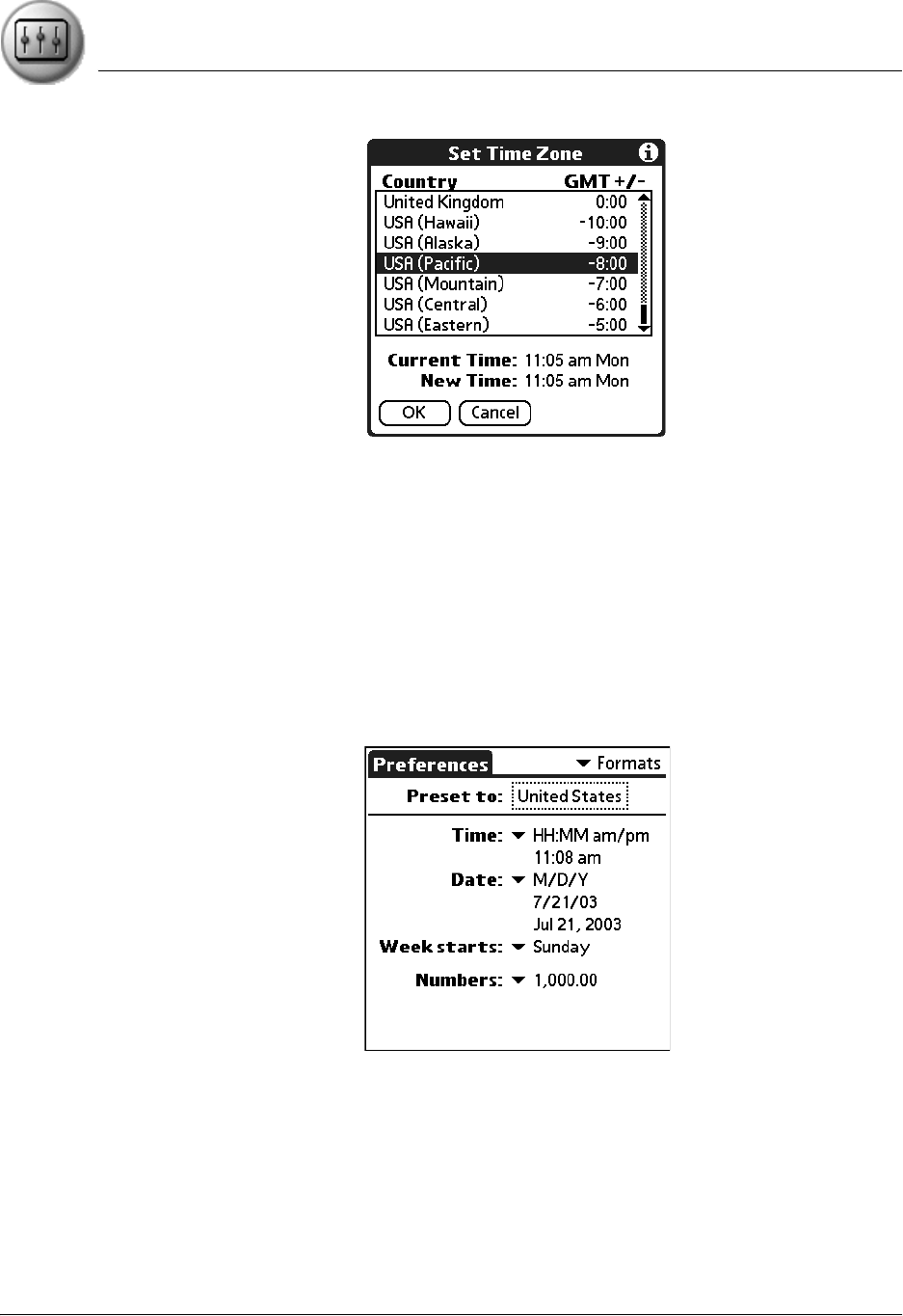
Setting Preferences
Formats
Using Your Zodiac Handheld 122
•Daylight Saving. Indicate whether Daylight Saving is currently
applicable in your area.
Formats
The Formats Preferences screen enables you to choose a default country for
your handheld and to set default formats for times, dates, and numbers. These
formats apply to all the dates, times, and numbers in all the applications on
your handheld. The Formats Preferences screen includes the following
settings:
•Preset To. Select a country name. When you select a country, the other
settings adjust as well. For example, if you select Germany, time is
expressed using a 24-hour clock and the starting day of the week is
Monday; if you select the United States, time is expressed using a 12-
hour clock with an AM or PM suffix and the starting day of the week is
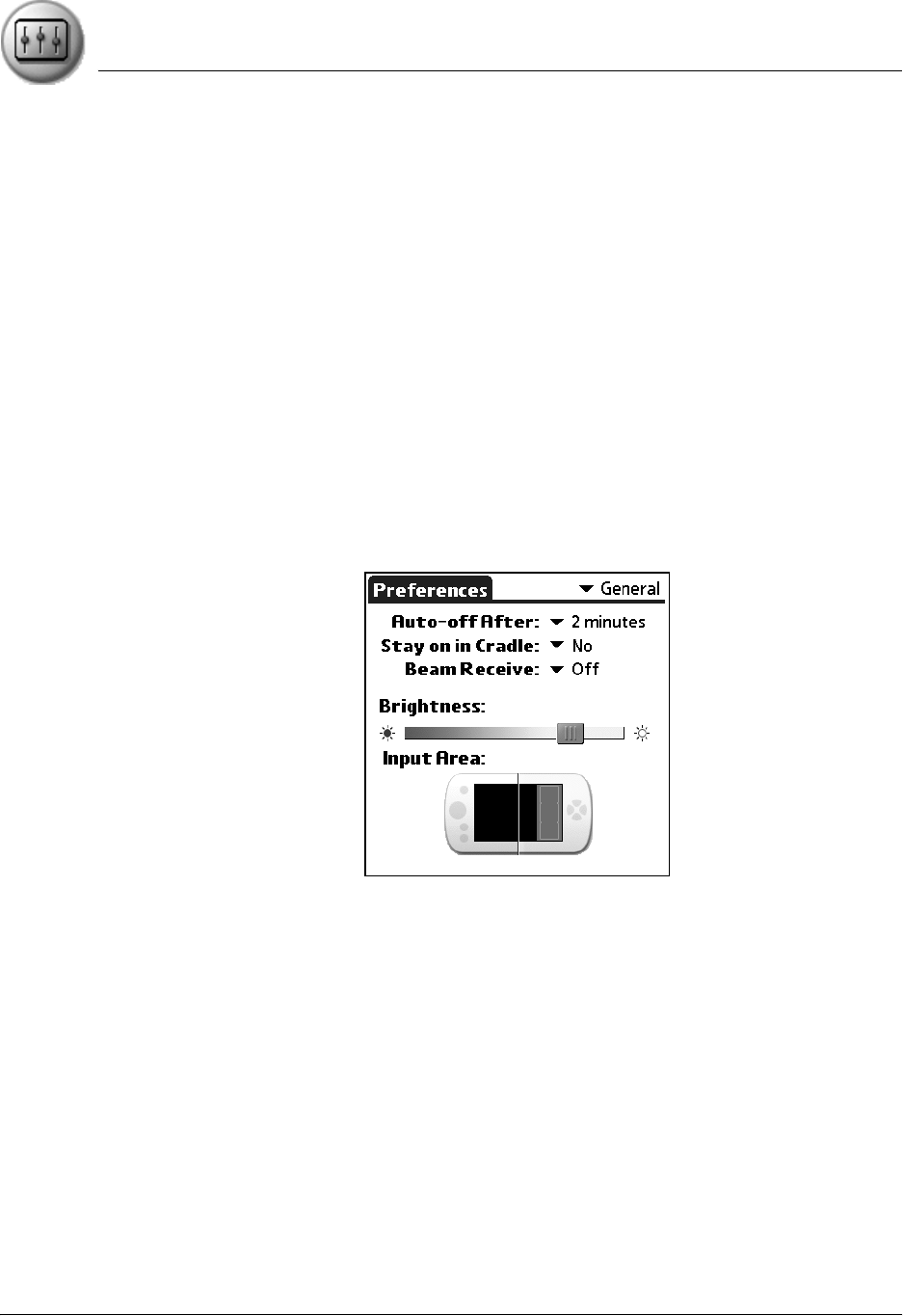
Setting Preferences
General
Using Your Zodiac Handheld 123
Sunday. You can, however, customize the individual settings regardless
of which country you select.
•Time. Select a format. H is hour and M is minute.
•Date. Select a format. D is day, M is month, and Y is year.
•Week starts. Select Sunday or Monday as the first day of the week.
•Numbers. Select the decimal point and thousands separator.
General
The General Preferences screen enables you to adjust various settings in order
to save battery power when your handheld is not connected to a power
outlet, and to set the position of the Input Area. The General Preferences
screen includes the following settings:
•Auto-off after. Set when your handheld automatically shuts off. After
the selected period of inactivity, the power and backlight turn off to
conserve battery power. If you find that your handheld shuts itself off
before you finish reviewing the information on the screen, increase this
setting.
•Stay on in Cradle. Determine whether to keep your handheld on
while it is connected to the HotSync cable or cradle and a power
outlet. Choosing Off causes your handheld to shut off after the Auto-
off interval (also set on this screen) expires.
•Beam Receive. Indicate whether you want to prohibit anyone from
beaming information to your handheld. If you disable beaming, it
saves a little battery power. By default, Beam Receive is enabled.
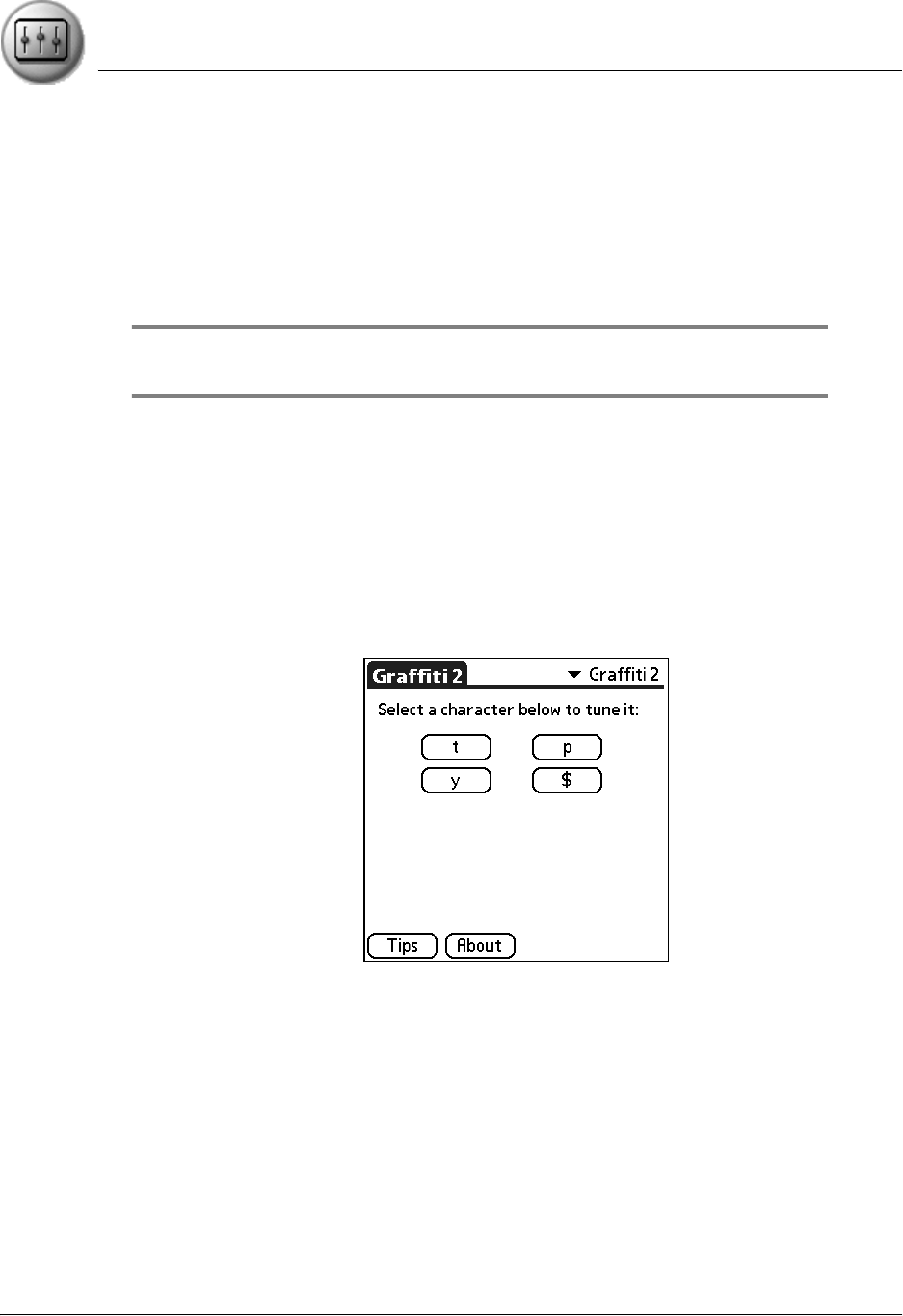
Setting Preferences
Graffiti 2
Using Your Zodiac Handheld 124
•Brightness. Adjust the brightness of the display by dragging the slider
on the screen.
•Input Area Position. Indicate whether you want the Status Bar and
Input Area to appear on the left or right side of the screen when the
display is in landscape mode. This option is designed to facilitate left-
handed data entry.
TIP: Tap the Orientation icon in the Status Bar to switch between portrait
(horizontal) and landscape (vertical) mode.
Graffiti 2
The Graffiti 2 Preferences provides alternate strokes for making the T, P, Y, and
$ characters. For example, you may want to form the letter T by using strokes
similar to a space and an L. But if this technique is difficult to control, you can
turn off this option. You can set preferences by tapping the characters that
appear on the following Graffiti 2 Preferences screen.
Network
Network Preferences let you set a password, telephone number, DNS number,
IP address, as well as create a login script for remote connections. You can use
a preset service template for your ISP or dial-in server, and edit, save, and
reuse settings. Or you can create your own service template.
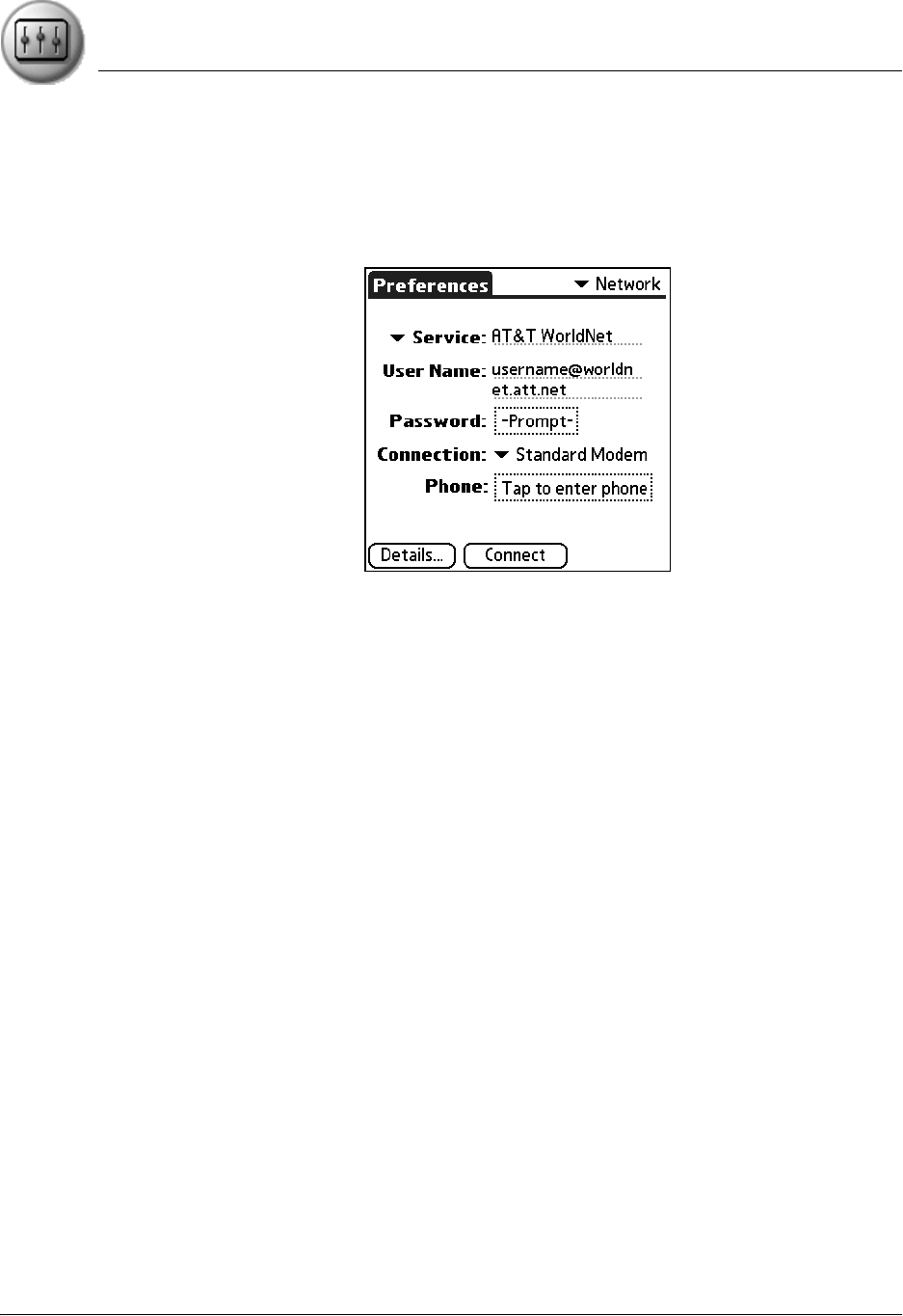
Setting Preferences
Network
Using Your Zodiac Handheld 125
To use the TCP/IP software included in the handheld operating system for
remote connections, you must set Network Preferences, as well as Connection
Preferences.
The Network Preferences screen includes the following settings:
•Service. Select a predefined service template you want to use. If you
use one of the predefined service templates, you probably only need
to enter your user name and telephone number. If the service template
you want does not appear on the list, you can create your own service
templates from scratch or duplicate existing templates and edit the
information using the New and Duplicate commands on the Service
menu.
•User Name. Enter the name you use when logging in to your ISP or
dial-in server. Do not enter spaces unless your dial-in server accepts
them.
•Password. Indicate whether to save your password as part of the
template.
–Prompt. If you’re concerned about security and want to be
prompted for your password when logging in to your ISP or dial-up
server, do not enter anything. Leave “Prompt” in the Password field.
–Assigned. If you do not want to be prompted for a password
during login, tap the Password field and enter your password.
“Assigned” appears in Password the field.
•Connection. Select a configuration. The list includes the
configurations displayed on the Connection Preferences screen.
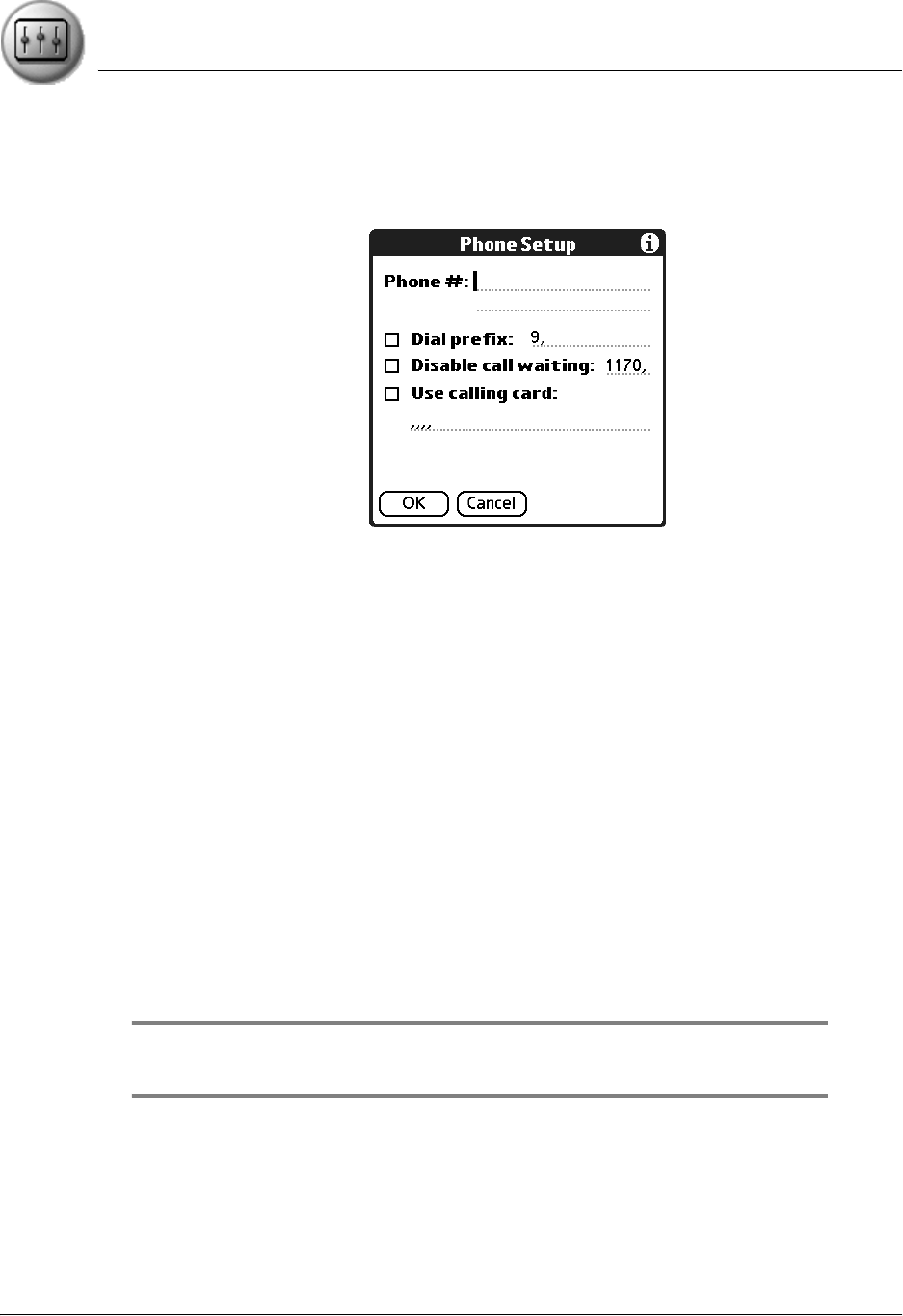
Setting Preferences
Network
Using Your Zodiac Handheld 126
•Phone. Enter the phone number you use to reach your ISP or dial-in
server. When you tap the Phone field, you have the following
additional options:
–Dial prefix. Indicate whether you need to enter a prefix before
dialing the telephone number to access an outside line. For
example, many offices require that you dial “9” to dial a number
outside the building. If you need to use a prefix, check the Dial
Prefix box, and enter the prefix.
–Disable call waiting. Toggle call waiting on and off. Call Waiting
can end your network session if you receive a call while you are
connected. To turn off Call Waiting, check the Disable call waiting
box, and enter the code to turn off Call Waiting. If you don’t know
the code, contact your local telephone company for the
appropriate code.
–Use calling card. Indicate whether you want to put the charges for
the phone call on a calling card. To activate this option, check the
Use Calling Card box, and then on the Use Calling Card line, enter
three commas followed by your calling card number. Each comma
delays transmission of your calling card number for two seconds, to
compensate for the delay before the number is entered.
NOTE: MCI customers must enter the calling card number in the Phone # field, and the
phone number in the Use Calling Card field.
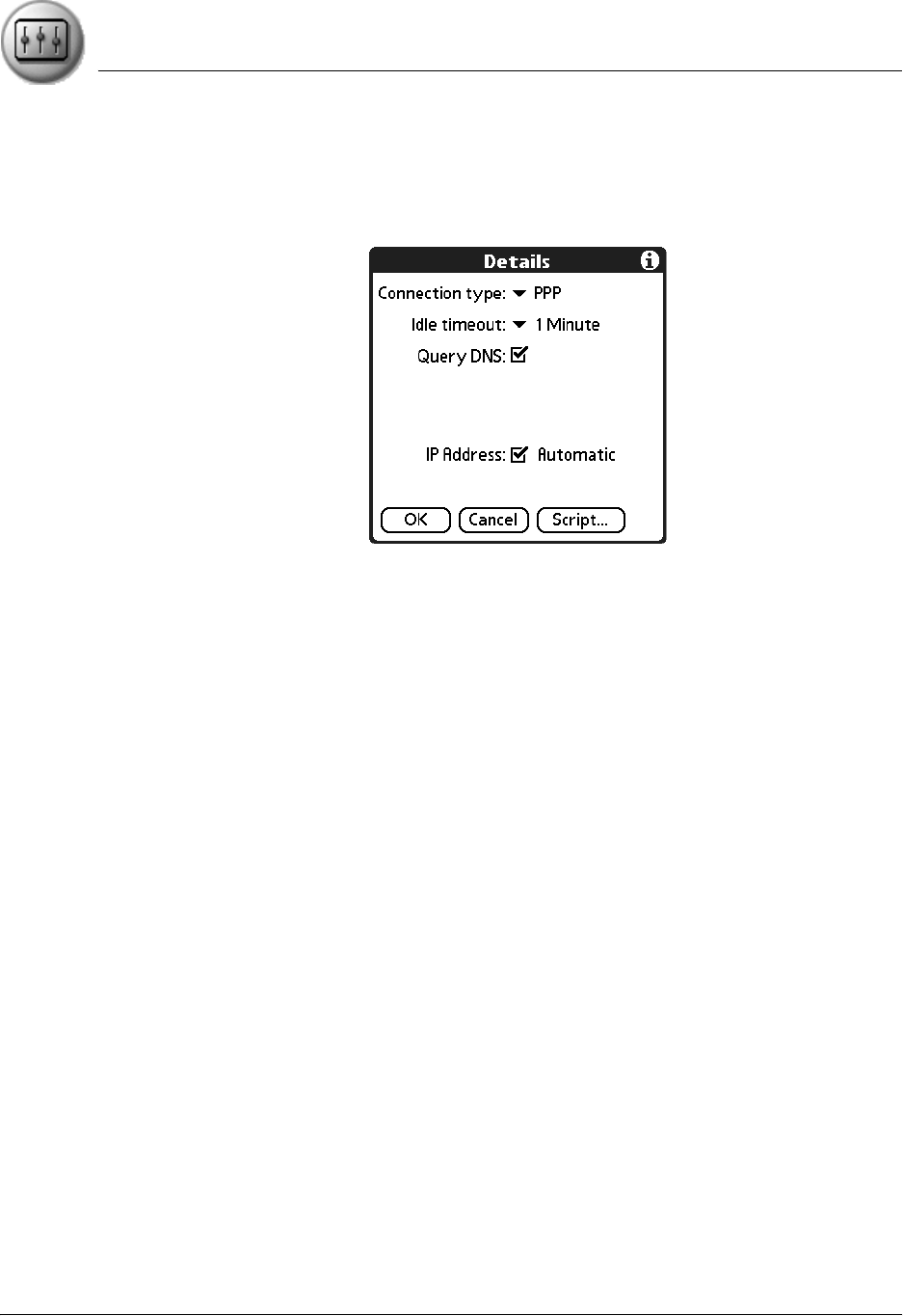
Setting Preferences
Network
Using Your Zodiac Handheld 127
Network Details
The Details dialog box enables you to select TCP/IP settings. When you tap the
Details button, you have the following additional options:
•Connection type. Select the connection protocol you want to use for
this service template:
–PPP for Point-to-Point protocol. Select this type if you’re unsure
which you need. If PPP doesn’t work, ask your ISP or your system
administrator for the correct connection type.
–SLIP. Select this type for Serial Line Internet protocol connections.
–CSLIP. Select this type for Compressed Serial Line Internet protocol
connections.
•Idle timeout. Specify how long your handheld waits to drop your
connection when you exit a TCP/IP application. Options include
Immediate, 1 minute, 2 minutes, 3 minutes, or Never (until the power is
off or your handheld times out).
•Query DNS. Indicate whether a DNS number is required. The Internet
uses the Domain Naming System (DNS) to translate the names of host
computers into IP addresses. A DNS number (or IP address) identifies a
specific server that handles the translation services. Anyone who logs
onto the Internet must have a unique identifier—an IP address. This IP
address can be either temporary—assigned automatically each time
you log on—or permanent. Not all systems require that you enter a
DNS number; check with your system administrator to see if it is
required.
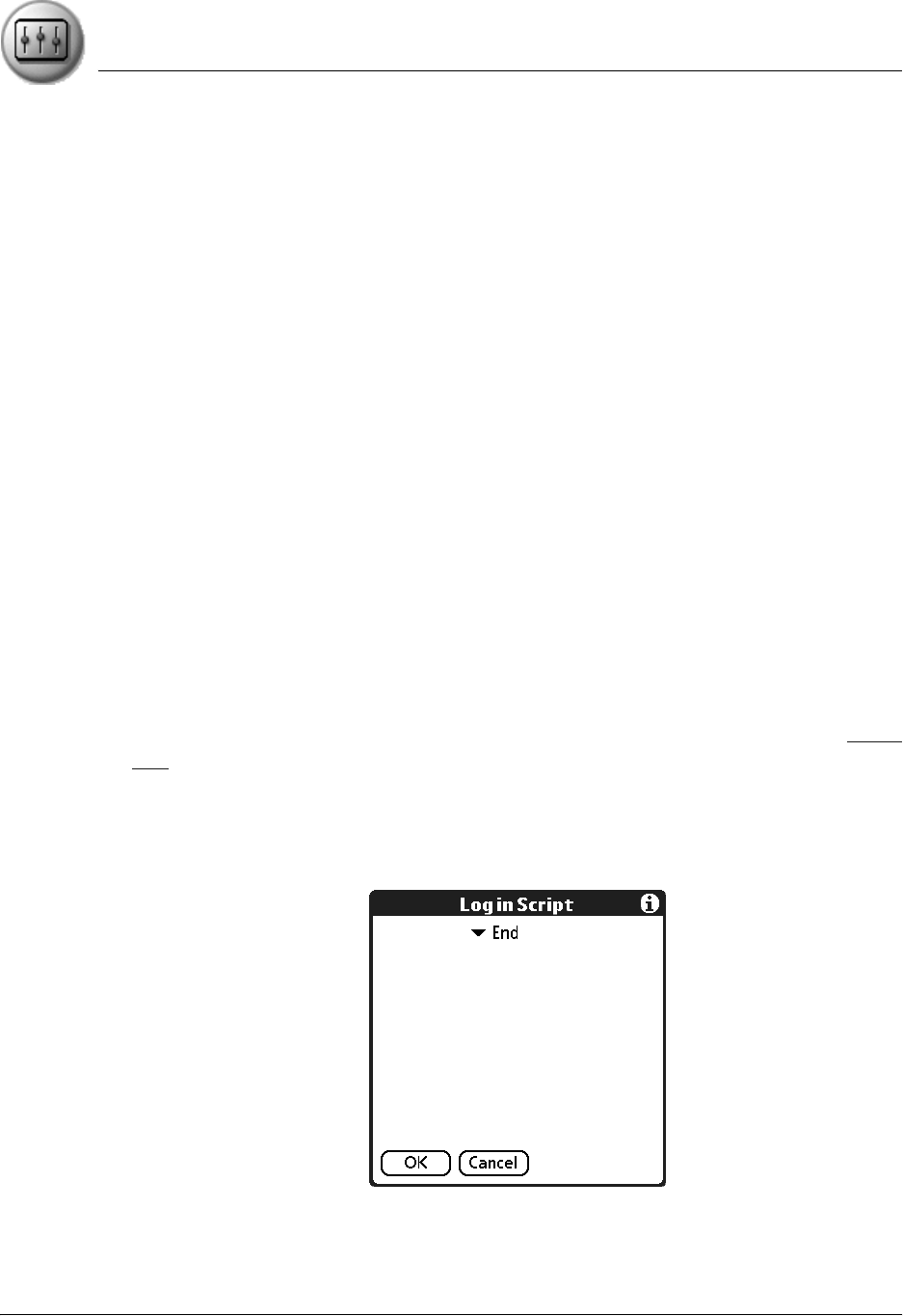
Setting Preferences
Network
Using Your Zodiac Handheld 128
To enter a DNS number, uncheck the Query DNS box (the Primary and
Secondary DNS fields appear). In the Primary DNS number field, tap
the space to the left of the first period in the Primary DNS field and
enter the first section of the IP address using a number only, from 0 to
255; repeat the step for the remaining sections of the field. Use the
same technique to enter the Secondary DNS number.
•IP Address Automatic. Indicate whether your server’s IP address is
temporary or permanent. If your IP address is automatic and
temporary, make sure that the IP Address box is checked. If your IP
address is permanently assigned, uncheck the IP Address box. In the
permanent IP address field, tap the space to the left of the first period,
and enter the first section of the IP address using a number only, from
0 to 255. Repeat the step for the remaining sections of the field.
Login scripts
A login script is a series of commands that automates logging into your ISP or
remote server.
You can create login script files by selecting commands in the Login Script
dialog box. Some commands, such as Send, require additional information
and have a parameter field to add the necessary data.
You can also use non-ASCII and literal characters in your login script. See page
130 for more information.
1. With a service template selected in the Network Preferences screen, tap
Details.
2. In the Details dialog box, tap Script.
S

Setting Preferences
Network
Using Your Zodiac Handheld 129
3. From the End pick list on the Login Script screen, select any of the
following commands and enter additional information if a field appears:
•Wait For. Instruct your handheld to wait for specific characters from
the TCP/IP server before executing the next command.
•Wait For Prompt. Instruct your handheld to use a dynamically
generated challenge-response value from the server. You must enter
the challenge value into your token card. This generates a response
value which you must enter on your handheld. This command requires
two arguments that are separated by a vertical bar (|).
•Send. Transmit specific characters to the TCP/IP server to which you
are connecting.
•Send CR. Transmit a carriage return or LF character to the TCP/IP
server to which you are connecting.
•Send User ID. Transmit the User ID information entered in the User ID
field of the Network Preferences screen.
•Send Password. Transmit the password entered in the Password field
of the Network Preferences screen. If you did not enter a password, this
command prompts you to enter one. The Password command is
usually followed by a Send CR command.
•Delay. Instruct your handheld to wait a specific number of seconds
before executing the next command in the login script.
•Get IP (for SLIP connections). Read an IP address and use it as the IP
address for your handheld.
•Prompt. Open a dialog box that prompts you to enter text of some
kind (for example, a password or a security code).
•End. Identify the last line in the login script.
4. Repeat steps 2 and 3 to complete the login script.
5. Tap OK, and then tap OK in the Details dialog box.

Setting Preferences
Network
Using Your Zodiac Handheld 130
Non-ASCII characters
If you know how to write custom scripts with non-ASCII characters, you can
incorporate the caret (^char) character, carriage returns and line feeds, and
literal characters in your custom login scripts.
•Use the caret (^ char) character to transmit ASCII command characters.
If you send ^char, and the ASCII value of char is between @ and _, then
the character is automatically translated to a single-byte value
between 0 and 31.
For example, ^M is converted to a carriage return. If char is a value
between a and z, then the character sequence is translated to a single-
byte value between 1 and 26. If char is any other value, then the
character sequence is not subject to any special processing. Thus, the
string “Joe^M” transmits Joe, followed by a carriage return.
•You can include carriage return and line feed commands as part of the
login script, when entered in the following format:
<cr>Sends or receives a carriage return
<lf>Sends or receives a line feed
For example, the string “waitfor Joe<cr><lf>” waits to receive Joe,
followed by a carriage return and line feed from the remote computer,
before executing the next command in the script.
•You can use the backslash ( \ ) character to specify that the next
character be transmitted as a literal character, and not be subject to
any special processing ordinarily associated with that character. For
example:
\^Includes a caret as part of the string
\<Includes a < as part of the string
\\Includes a backslash as part of the string
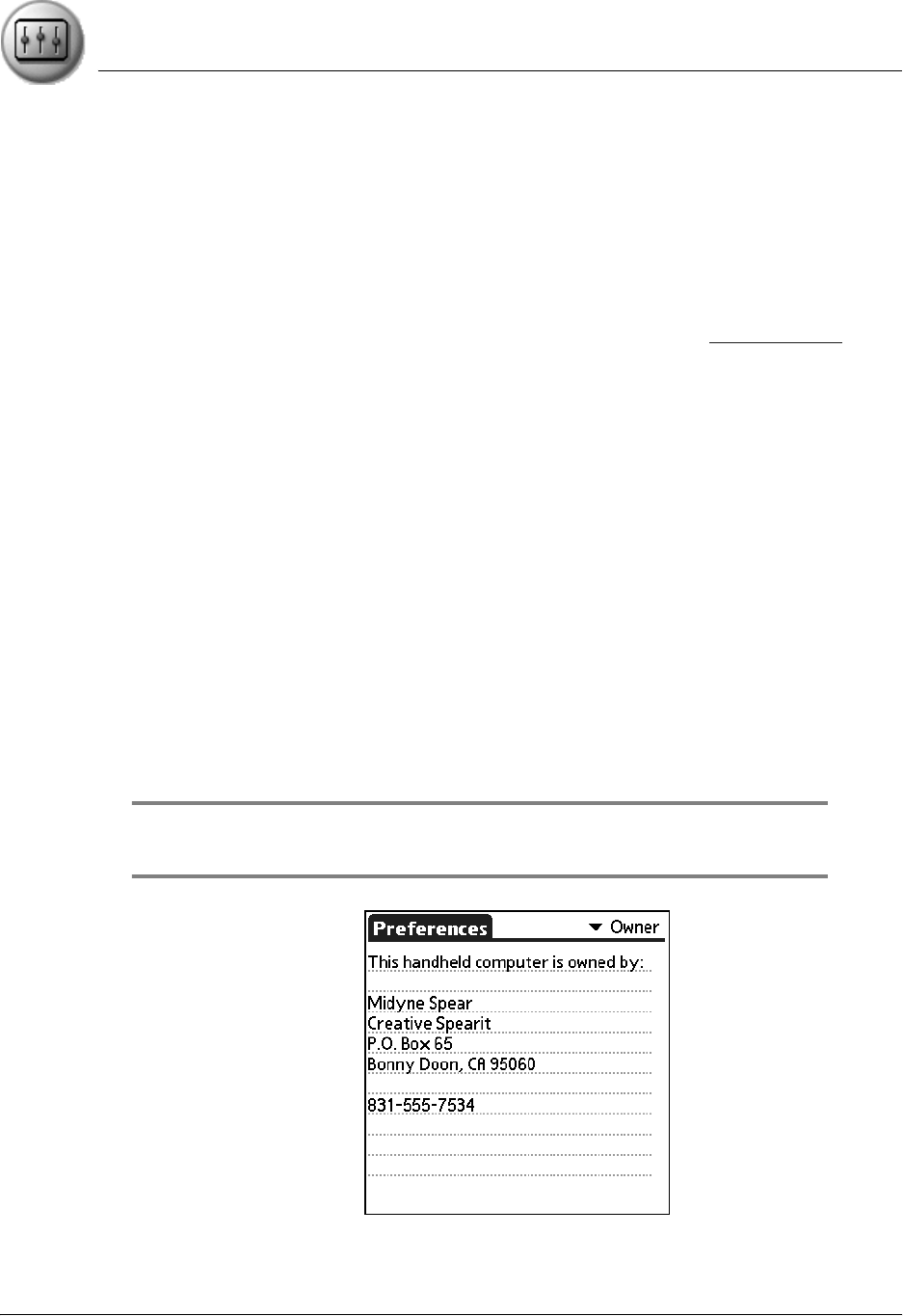
Setting Preferences
Owner
Using Your Zodiac Handheld 131
Connecting to your ISP or dial-in service
After you set Connection and Network Preferences, you can easily connect to
your ISP or dial-in server.
You can make the connection using either Network Preferences commands or
a third-party application. Connecting to an ISP requires a third-party
application, such as a Web browser or news reader. For information on third-
party applications that support TCP/IP, check the Web site tapwave.com.
1. From the Network Preferences screen, tap Connect to dial the current
service and display the Service Connection Progress messages.
2. To see expanded Service Connection Progress messages, press Down
during login.
3. Tap Disconnect to terminate the connection between your handheld and
your service.
Owner
Use Owner Preferences to record a name, company name, phone number, or
any other identification information you want to include on your handheld.
If you use Security to turn off and lock your handheld with a password, the
information that you enter in Owner Preferences appears the next time you
turn on your handheld.
NOTE: If you assign a password to your handheld using Security, you must tap Unlock
and enter your password to change the information on the Owner Preferences screen.
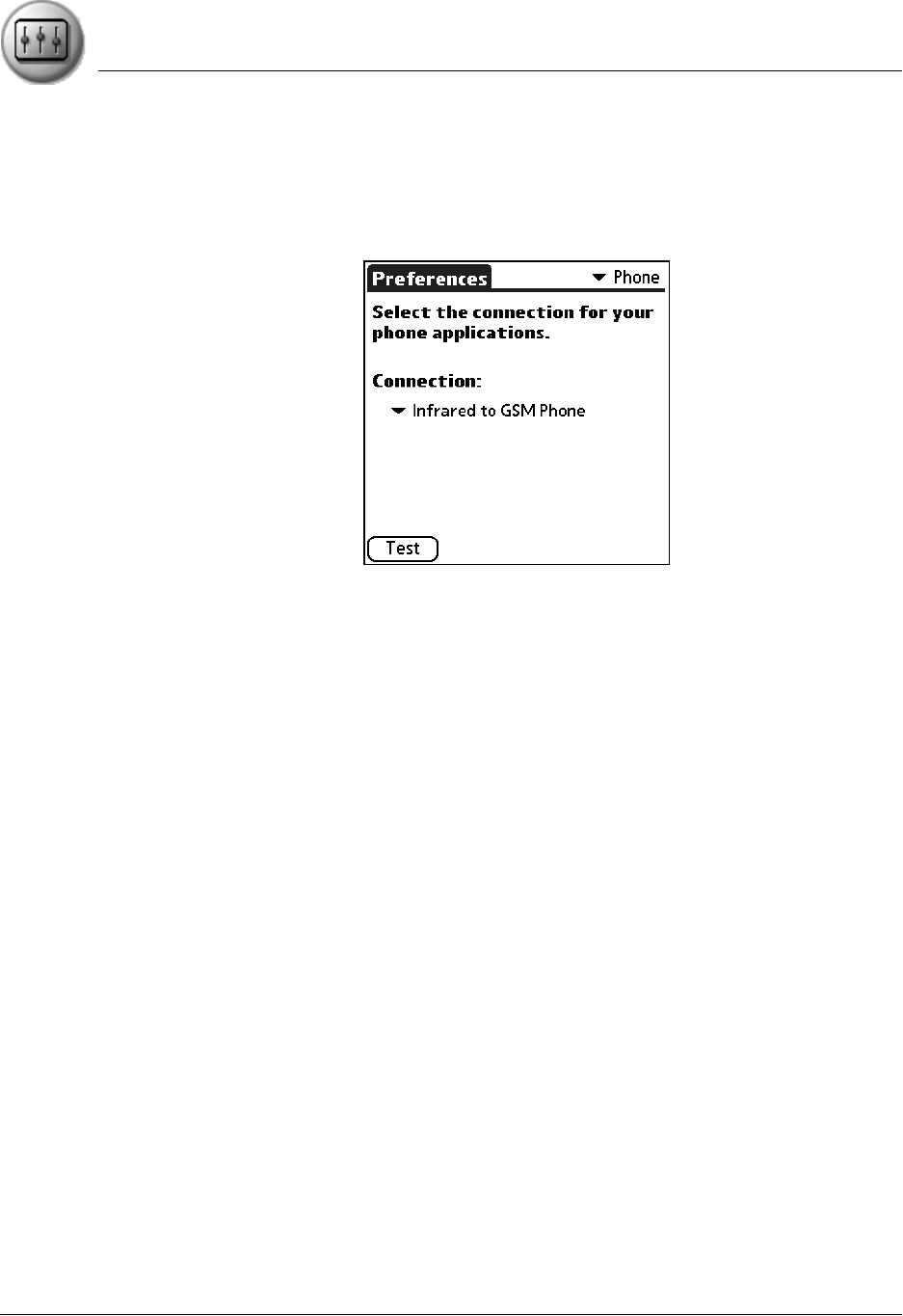
Setting Preferences
Phone
Using Your Zodiac Handheld 132
Phone
Use the Phone Preferences screen to pick a connection profile. These settings
are used by SMS and a variety of third-party applications.
•Connection. Select a Connection configuration for applications that
require a phone connection. Select Infrared to GSM Phone or Serial to
GSM Phone according to your hardware setup. The details of your
connection should already be set up, in the Connection Preferences.
However, you can edit information from this pick list if necessary.
If no connection methods are available, then --None-- appears in the
pick list. This means that no phone drivers exist on your handheld. In
this case you must install the phone driver on your computer and
synchronize with your handheld.
If your phone is enabled and connected, you can test the connection
by tapping the Test button. This initiates a simple query of the phone
to make sure the connection is working and the correct phone is being
used.
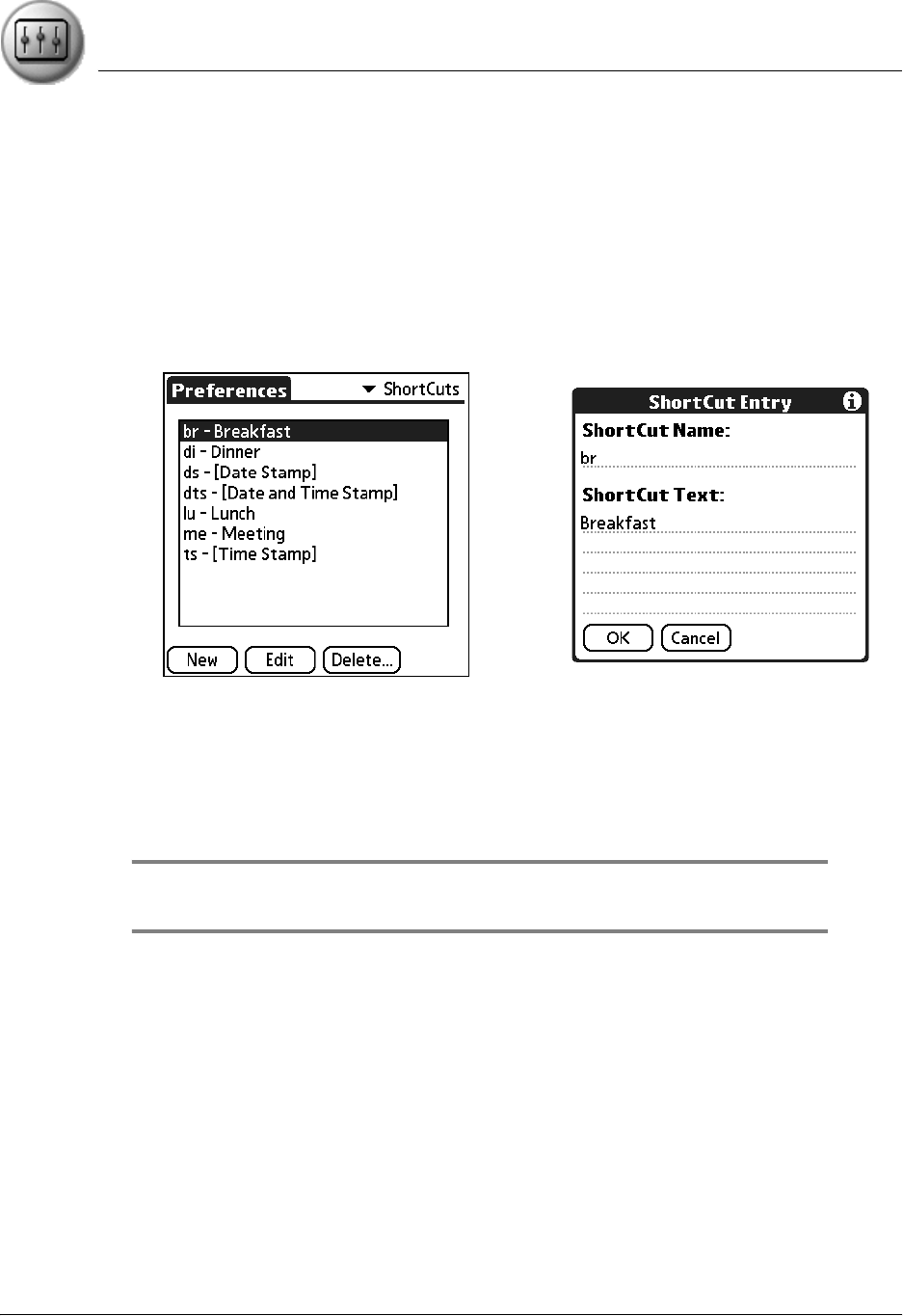
Setting Preferences
ShortCut
Using Your Zodiac Handheld 133
ShortCut
ShortCut Preferences enable you to create ShortCuts for up to 45 characters.
For example, you could create a ShortCut for your name or for the header of a
memo. All ShortCuts you create appear on the list in the ShortCut Preferences
screen, are available in any of your handheld applications, and are backed up
on your computer when you perform a HotSync operation.
The ShortCuts Preferences screen includes the following options:
•New. Define a new shortcut.
–ShortCut Name. Enter the letters you want to use to activate the
ShortCut.
–ShortCut Text. Enter the text that you want to appear when you
write the ShortCut characters.
TIP: You can add a space character after the last word in your ShortCut text so
that a space automatically follows the ShortCut text.
•Edit. Modify an existing ShortCut. From the ShortCut Preferences
screen, tap the ShortCut you want to edit, tap Edit, and then enter your
changes.
•Delete. Remove a ShortCut. From the ShortCut Preferences screen, tap
the ShortCut you want to delete and then tap Delete.
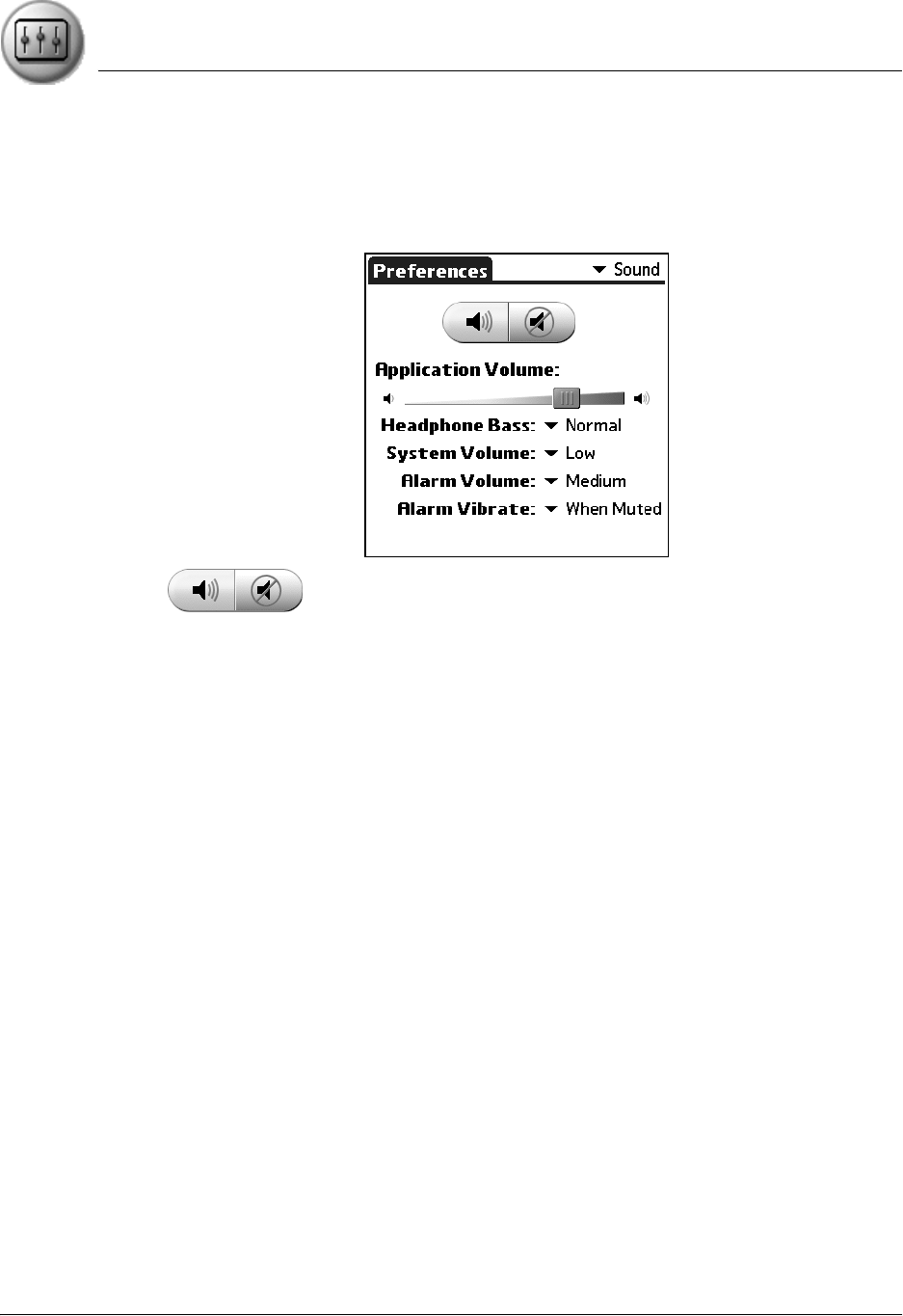
Setting Preferences
Sound
Using Your Zodiac Handheld 134
Sound
The Sound Preferences enable you to adjust the sound and alarm settings
using the following settings:
• Turn all sounds on or mute all sounds. When sound is on,
you have the following options:
–Application Volume. Adjust the volume level for the sounds in
your applications by dragging the slider or tapping to the right
or left of the slider to move it in small increments. Some older
Palm OS® games may not respond to this setting.
–Headphone Bass. Set the bass level for sounds in your
applications. The choices are: Normal or Boost.
–System Volume. Set the volume level for system sounds. The
System Volume level is relative to the Application Volume level. As
you increase or decrease the Application Volume level the System
Volume level follows. Turning off the System Volume also turns off
the chime tones during HotSync operations. The choices are: Off,
Low, Medium, or High.
–Alarm Volume. Set the volume level for alarm sounds. The choices
are: Off, Low, Medium, or High.
–Alarm Vibrate. Turn the vibrate option On or Off. When you enable
the Alarm Vibrate setting, your handheld vibrates to notify you of
alarms. This is useful when you want the Alarm Sound off, but still
want to be notified of alarms.

Setting Preferences
Sound
Using Your Zodiac Handheld 135
When sound is muted, you have the following options:
–Mute Until. Choose how long you want sounds to remain off. The
choices vary based on the current time.
–Always Vibrate when Muted. Indicate whether you want to
automatically activate the Alarm Vibrate option each time you
mute all sound.

Using Your Zodiac Handheld 136
15
Synchronizing Data
HotSync technology lets you synchronize—exchange and update—data
between your Zodiac handheld and Palm Desktop software or another
desktop organizer application such as Microsoft Outlook.
The HotSync process automatically synchronizes data between your
handheld and Palm Desktop software. Changes you make on your handheld
or in Palm Desktop software appear in both places after a HotSync operation.
HotSync technology synchronizes only the needed portions of files, thus
reducing synchronization time.
You can synchronize your data by connecting your handheld to your
computer with the HotSync cable or cradle. If your computer is configured for
infrared communication, you can also use the IR port on your handheld to
perform HotSync operations. This chapter describes how to select HotSync
options and perform a HotSync operation via the cable/cradle or infrared
communication.
If you are a System Administrator preparing several handhelds for a group of
users, you may want to create a user profile. See page 144 before performing
the following steps.
Performing a cable or cradle HotSync operation
The following steps assume that you have already installed the Palm Desktop
software. If you have not installed this software, see page 16 for instructions.
1. Connect your handheld to the HotSync cable or cradle.
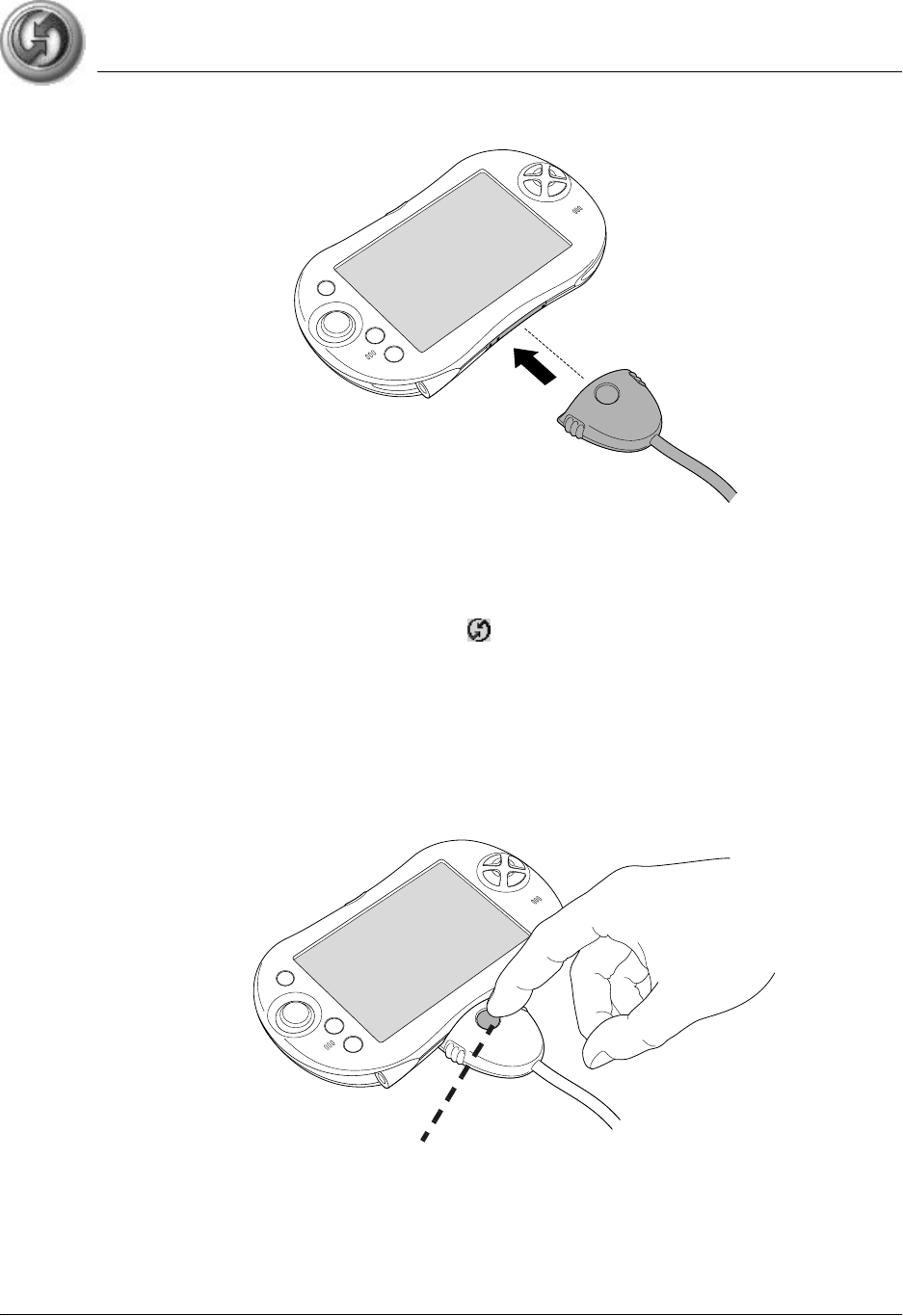
Synchronizing Data
Performing a cable or cradle HotSync operation
Using Your Zodiac Handheld 137
The bottom edge of the handheld should align smoothly with the cable or
cradle when it is properly connected.
2. Make sure the HotSync Manager software is running.
If it is running, the HotSync icon ™ appears in the Windows system tray.
If HotSync Manager is not running, click the Start button on the Windows
desktop and choose Programs. Navigate to the Palm Desktop software
program group and choose HotSync Manager. Alternatively, you can
start the Palm Desktop software which automatically opens HotSync
Manager.
3. Press the HotSync button on the cradle.
HotSync button
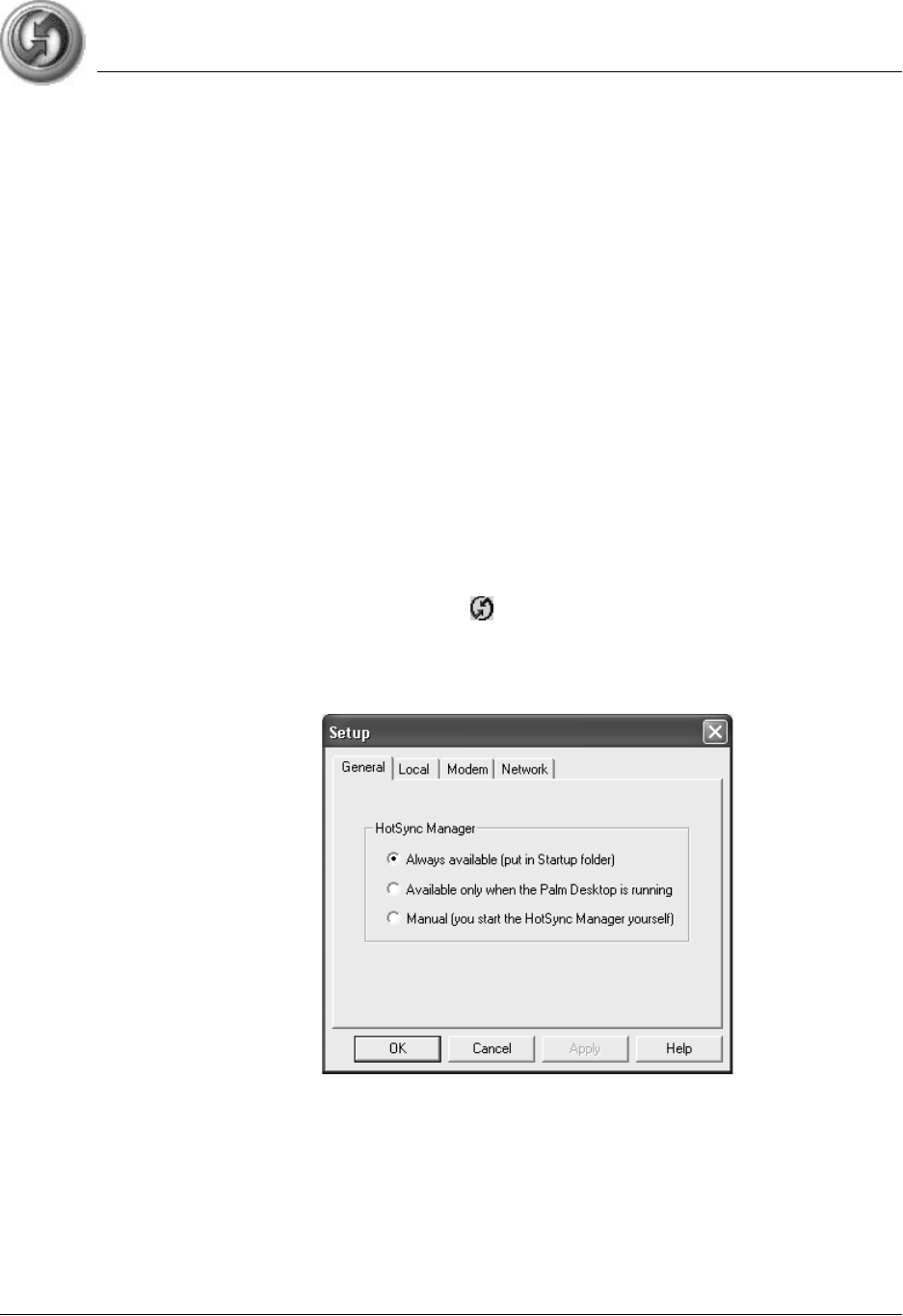
Synchronizing Data
Selecting HotSync setup options
Using Your Zodiac Handheld 138
4. If prompted, select the user name you entered when you installed Palm
Desktop software. The HotSync Progress dialog box appears and
synchronization begins.
Every handheld should have a unique name. To prevent loss of a user’s
records, never try to synchronize more than one handheld to the same
user name.
5. Wait for a message on your handheld indicating that the process is
complete.
When the HotSync process is complete, you can remove your handheld from
the HotSync cable or cradle.
Selecting HotSync setup options
You can choose when you want HotSync Manager to run. If necessary, you can
adjust the other HotSync settings as well.
1. Click the HotSync Manager icon in the Windows system tray.
2. Choose Setup.
3. Click the General tab, and select one of the following options:
•Always Available. Add HotSync Manager to the Startup folder and
constantly monitors the communication port for synchronization
requests from your handheld. With this option, HotSync Manager
synchronizes data even when Palm Desktop software is not running.

Synchronizing Data
Customizing HotSync application settings
Using Your Zodiac Handheld 139
•Available Only When Palm Desktop software Is Running. Start
HotSync Manager and monitors requests automatically when you
open Palm Desktop software.
•Manual. Monitor requests only when you select HotSync Manager
from the Start menu.
If you’re not sure which option to use, keep the default setting, Always
Available.
4. Click OK.
Customizing HotSync application settings
For each application, you can define a set of options that determines how
records are handled during synchronization. These options are called a
“conduit.” By default, a HotSync operation synchronizes all files between the
handheld and Palm Desktop software.
In general, you should leave the settings to synchronize all files. The only
reason you might want to change these settings is to overwrite data on either
your handheld or Palm Desktop software, or to avoid synchronizing a
particular type of file because you don’t use it.
In addition to the conduits for Date Book, Address Book, To Do List, Memo
Pad, Photos, and Music, Palm Desktop software includes High Score, System,
and Install conduits. The High Score conduit synchronizes the high score
database with the Tournament Zone on the Tapwave web site. The System
conduit backs up the system information stored on your handheld, including
Graffiti 2 ShortCuts. The Install conduit installs applications on your handheld.
1. Click the HotSync icon in the Windows system tray (bottom-right
corner of the taskbar).
TIP: You can also click the HotSync command on the Palm Desktop software
menu bar.
2. From the HotSync Manager menu, choose Custom.
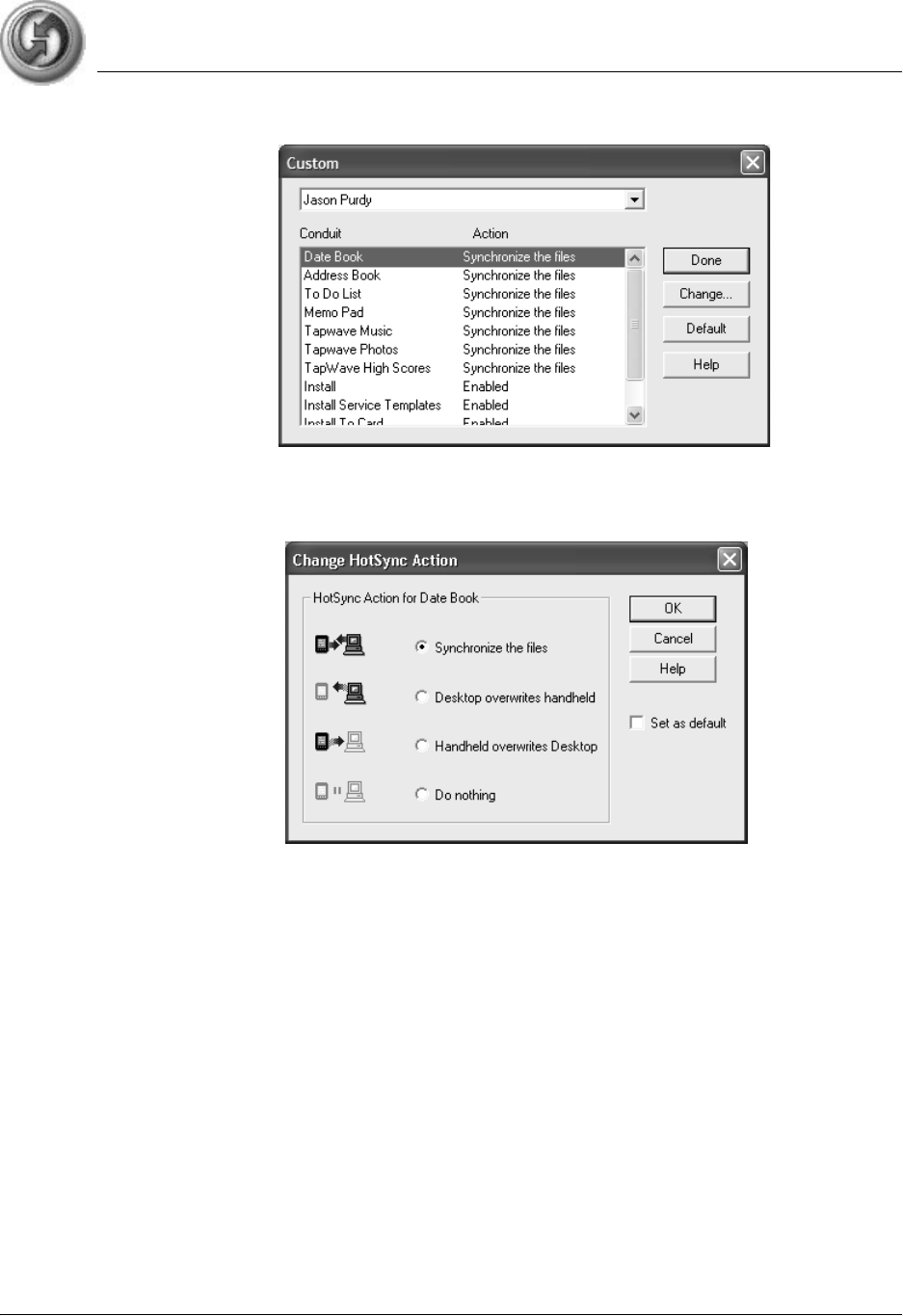
Synchronizing Data
Customizing HotSync application settings
Using Your Zodiac Handheld 140
3. Select the appropriate user name from the list.
4. Select an application in the Conduit list. Click Change.
5. Click the direction in which you want to write data, or click Do Nothing to
skip data transfer for an application.
6. Choose how long the setting remains in effect:
•To affect only the next HotSync operation, deselect Set As Default.
Thereafter, the HotSync Actions revert to their default settings.
•To use a new setting as the default, select the Set As Default option.
Thereafter, whatever you selected as the default setting is used when
you click the Default button in the Custom dialog.
7. Click OK.
8. Repeat steps 4 - 7 to change conduit settings for other applications.
9. Click Done to activate your settings.

Synchronizing Data
IR HotSync operations
Using Your Zodiac Handheld 141
IR HotSync operations
Your organizer is equipped with an infrared (IR) port that supports the
IrCOMM implementation of the standards for infrared communication
established by the Infrared Data Association (IrDA). This means that you can
beam data to any other device that supports the IrCOMM implementation of
the IrDA standards. Most importantly, you can use the IR port to perform
HotSync operations without a HotSync cable or cradle. This is very useful if
you travel with an infrared-enabled laptop. You simply enable infrared
communication on your laptop and handheld, and then follow the steps on
page 143.
Preparing your computer for infrared communication
Before you can perform a HotSync operation using the IR port, the computer
you want to synchronize with must meet the following requirements:
•The computer must support the IrCOMM implementation of the IrDA
standards.
•The computer must have an enabled infrared port built-in, or an
enabled infrared device attached to the computer.
Desktop computers are likely to require an infrared device attached to a
physical serial port. Laptops are likely to have a built-in IR port. Your computer
must also have an installed infrared driver.
1. In the Windows taskbar click Start, choose Settings, and then choose
Control Panel.
2. Double-click Infrared.
3. Click the Options tab.
4. Select Enable infrared communication.
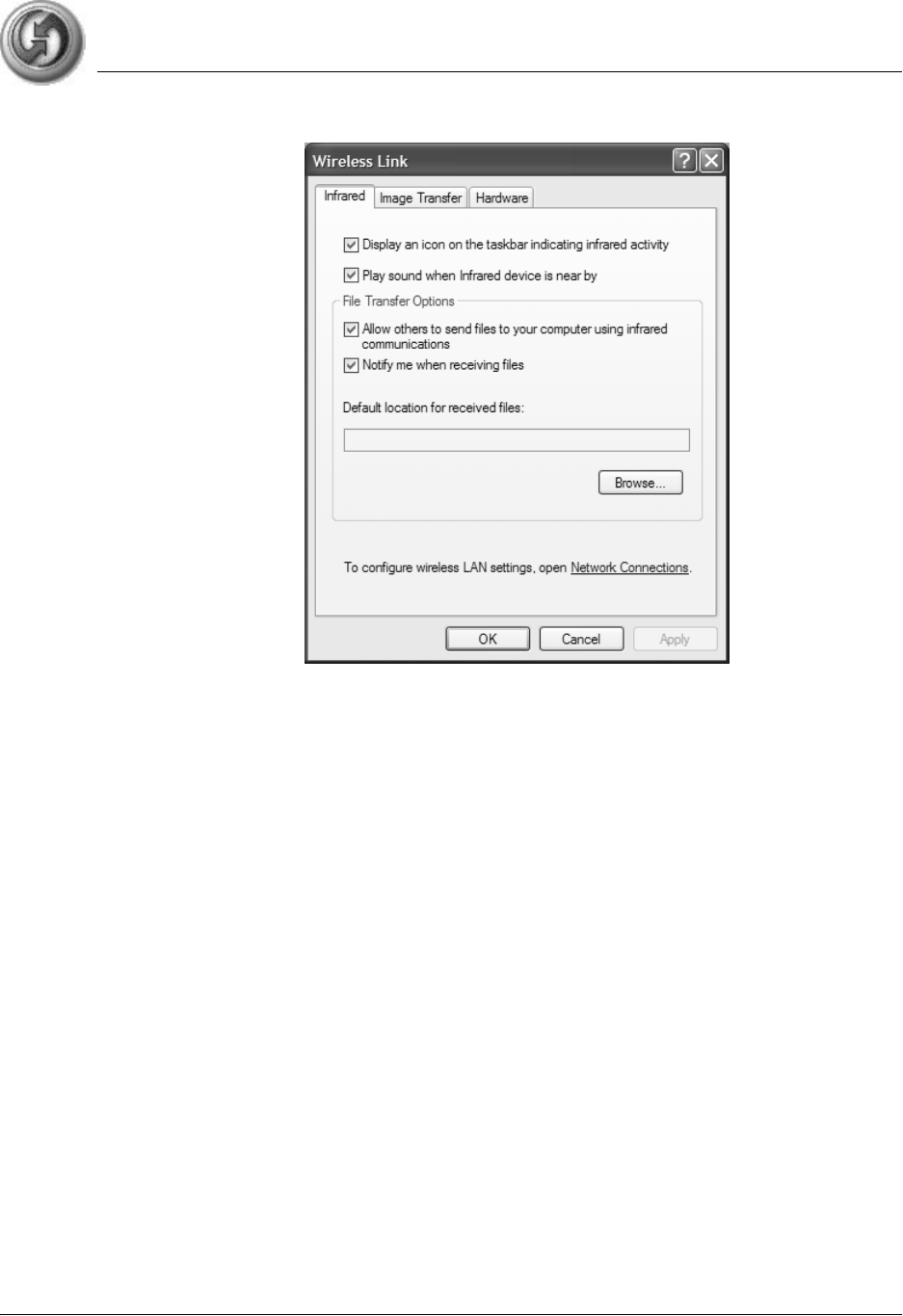
Synchronizing Data
IR HotSync operations
Using Your Zodiac Handheld 142
The COM port displayed in the drop-down box is the port where your
infrared device is attached. It should be different from any port used by
HotSync Manager.
5. Make a note of which port is listed as “Providing application support.”
You need this information to configure HotSync Manager for infrared
communication. This port is the simulated port. It is the channel through
which the actual infrared communication takes place between your
computer and your handheld.
6. Uncheck all other boxes in the Options tab.
7. Click Apply and OK.
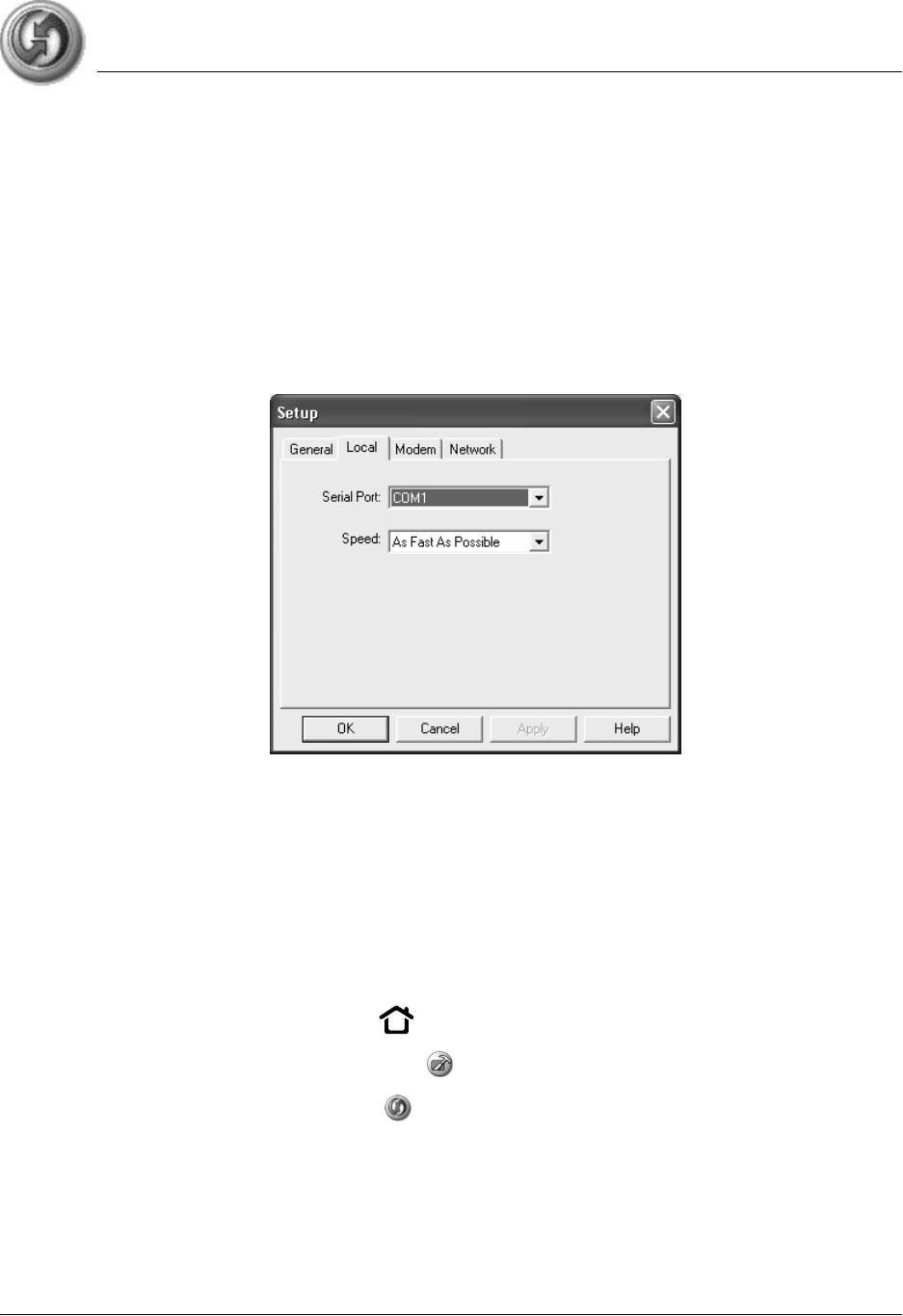
Synchronizing Data
IR HotSync operations
Using Your Zodiac Handheld 143
Configuring HotSync Manager for infrared communication
Next you need to go to HotSync Manager and specify the that the infrared
port should be used for the HotSync operation.
1. Click the HotSync Manager icon in the Windows system tray.
2. Make sure Local is checked on the menu.
3. Choose Setup.
4. Click the Local tab.
5. In the Serial Port drop-down box, select the COM port that was given as
the simulated port in the Options tab of the Infrared Monitor.
6. Click OK.
Performing an IR HotSync operation
After you complete the steps to prepare for an IR HotSync operation it is easy
to perform the actual operation.
1. Press the Home button .
2. Select the Utilities category .
3. Select the HotSync icon .
4. Tap Local.
5. From the pick list below the HotSync icon, select IR to a PC/Handheld.
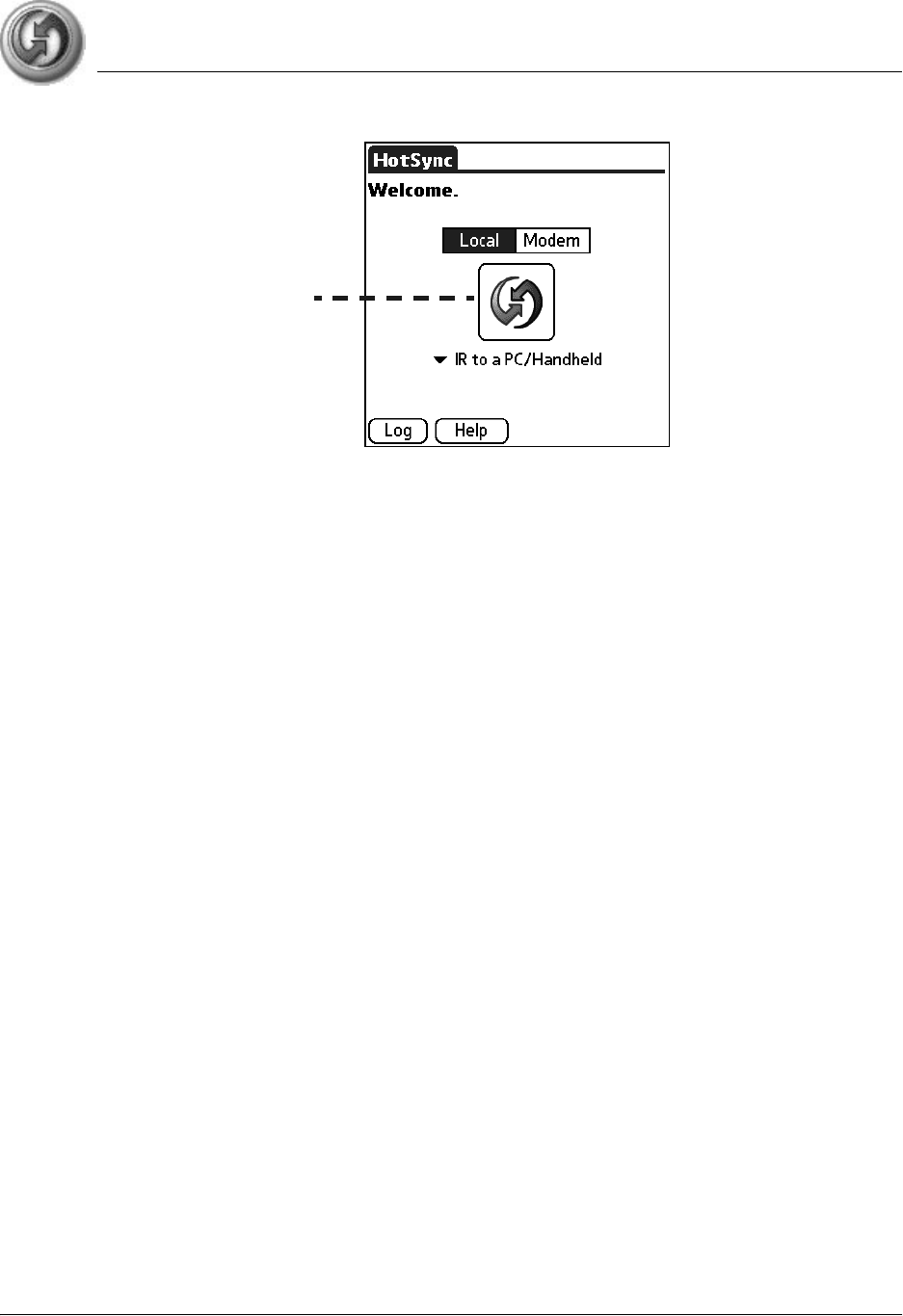
Synchronizing Data
Creating a user profile
Using Your Zodiac Handheld 144
6. Position the IR port of your organizer within a couple of inches of the
infrared port of your computer.
7. Tap the HotSync icon to start the IR HotSync operation.
Returning to using the cradle for HotSync operations
It’s easy to return to using the cradle for HotSync operations.
The next time you want to perform a HotSync operation just press the
HotSync button on the cradle. You can leave the HotSync application on your
handheld set to perform IR HotSync operations and still use the cradle. This is
useful if you perform HotSync operations with both your desktop computer
and a laptop that you travel with. When you travel you don’t have to carry a
cradle or cable. When you are in the office just place your organizer in the
cradle and press the HotSync button.
Creating a user profile
You can create a user profile to load data into an handheld without
associating that data with a user name. This feature lets System
Administrators configure several handhelds with specific information (such as
a company phone list) before distributing them to their actual users.
The User Profile feature is designed only for the first-time HotSync operation,
before you assign a User ID to a particular handheld.
1. Open Palm Desktop software.
2. From the Tools menu, choose Users.
HotSync icon
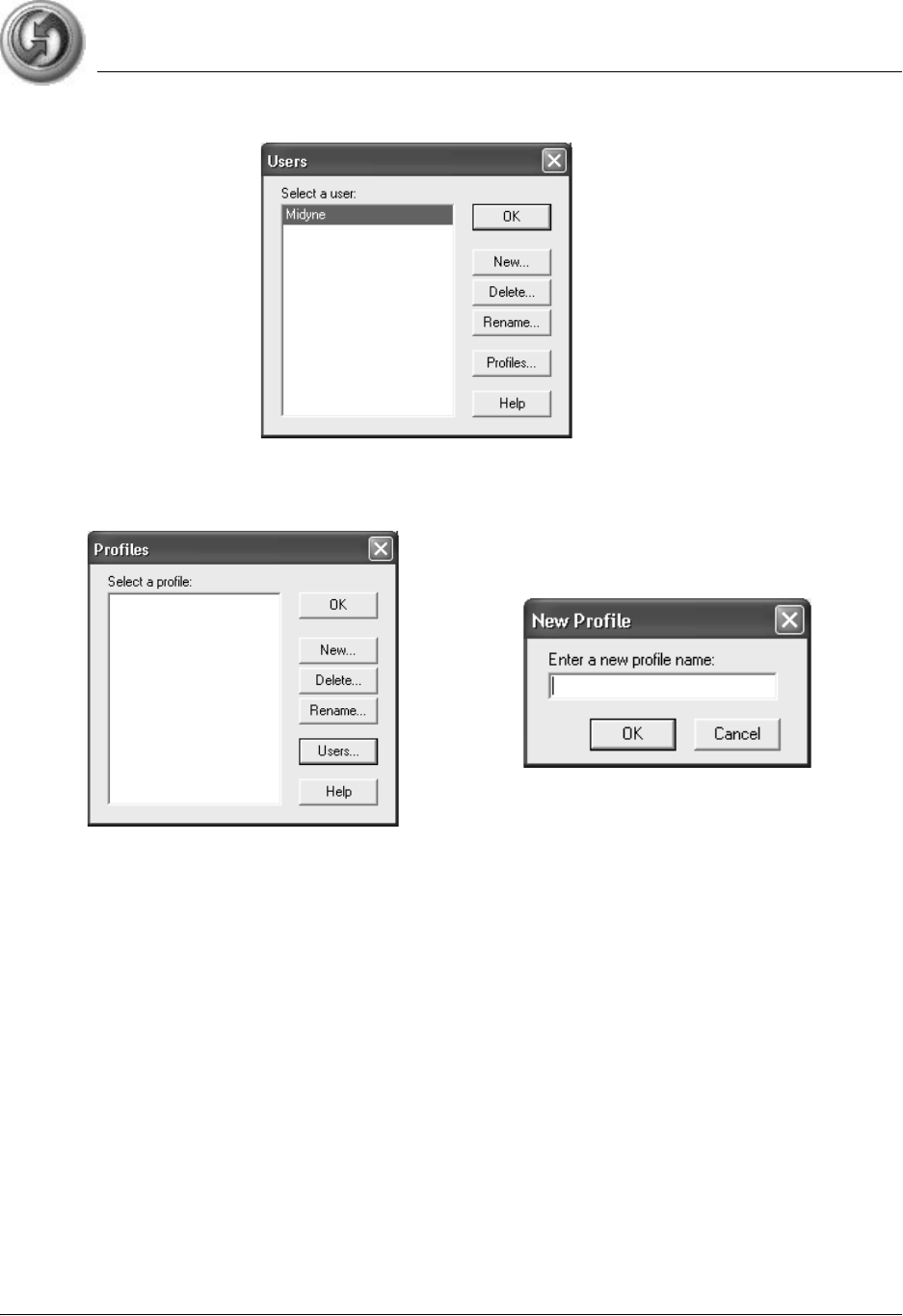
Synchronizing Data
Creating a user profile
Using Your Zodiac Handheld 145
3. Click Profiles.
4. Click New. Enter a unique name for the profile and click OK.
5. Click OK to return to Palm Desktop software.
6. Select the profile from the User list and create the data for the profile (for
example, company phone list, and so on).
Using a profile for the first-time HotSync operation
1. Place the new handheld in the cradle.
2. Press the HotSync button on the cradle.
3. Click Profiles.
4. Select the profile that you want to load on the handheld, and click OK.
5. Click Yes to transfer all the profile data to the handheld.
The next time you perform a HotSync operation, Palm Desktop software
prompts you to assign a user name to the handheld.

Using Your Zodiac Handheld 146
16
Security
Your handheld includes a Security application that lets you set options to
protect entries from unauthorized users in a variety of ways:
Security application lets you:
•Mask or hide entries you have defined as private. The Mask option
displays a gray bar over private records, and the Hide option
completely removes (hides) private records.
•Assign a password to viewing options to enhance security. Assigning a
password requires you to enter a password before private entries can
be viewed; not assigning a password lets you view private entries
when you Show Records from the Security dialog box.
•Lock and turn off your handheld so that a password must be entered
before you can use your handheld again.
•Hide records that you have defined as private, with or without a
password. Without a password, private records are hidden until you set
Security to display them; with a password, you must enter the
password to view the private entries.
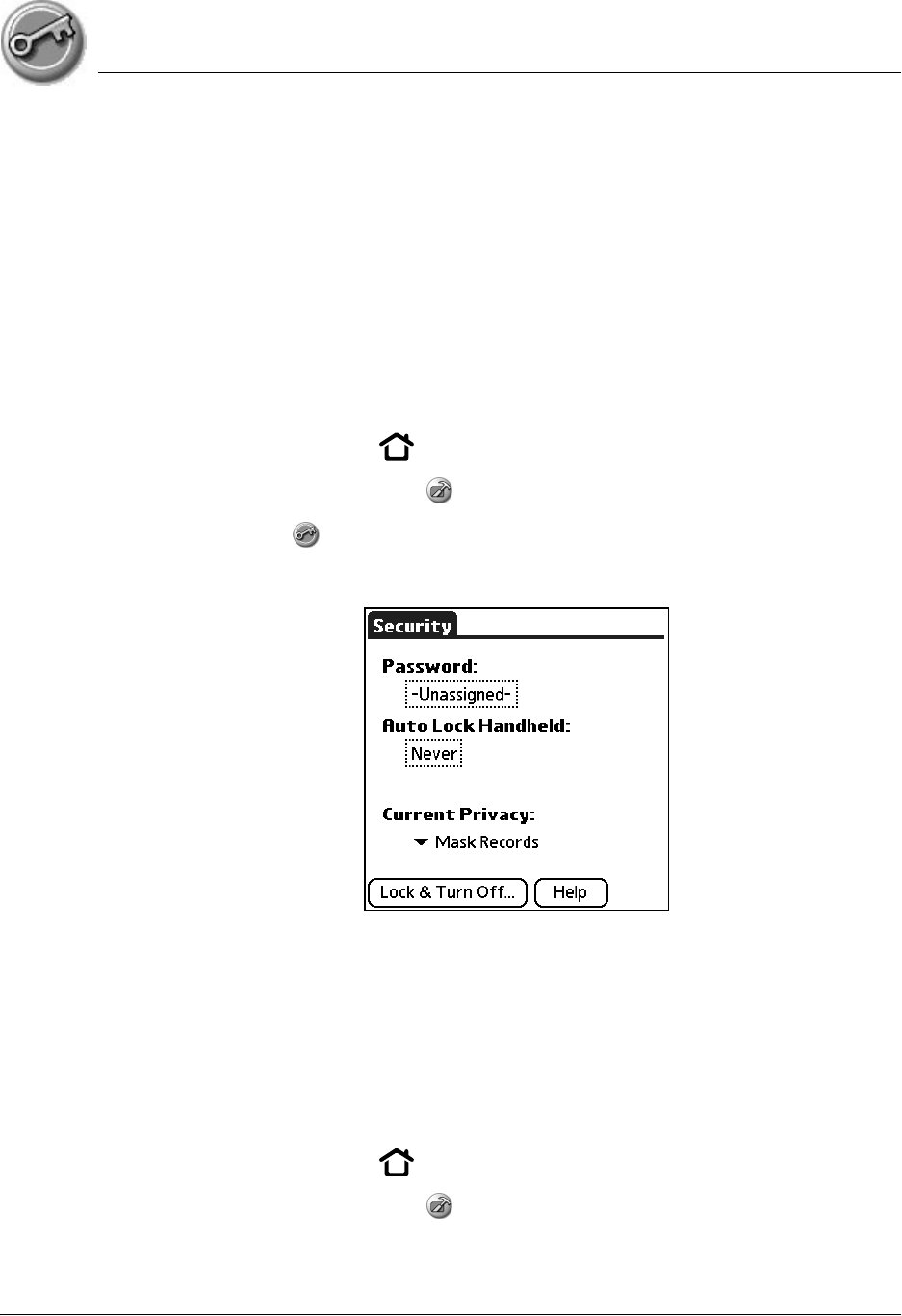
Security
Masking and hiding records
Using Your Zodiac Handheld 147
Masking and hiding records
You can mask or hide private records. When you mask private records, a visual
placeholder appears where the record would normally be displayed; when
you hide records, they are not visible anywhere in the list.
Masking private records
1. Make sure that the record or records you want to mask are defined as
private. To make a record private, select the record, tap Edit, tap Details,
and then check the Private box.
2. Press the Home button .
3. Select the Utilities category .
4. Select Security .
5. From the Current Privacy pick list, select Mask Records.
6. Open one of the Organizer applications and view a record. Records
marked as private are masked with a gray bar.
Hiding private records
1. Make sure that the record or records you want to hide are defined as
private. To make a record private, select the record, tap Edit, tap Details,
and then check the Private box.
2. Press the Home button .
3. Select the Utilities category .
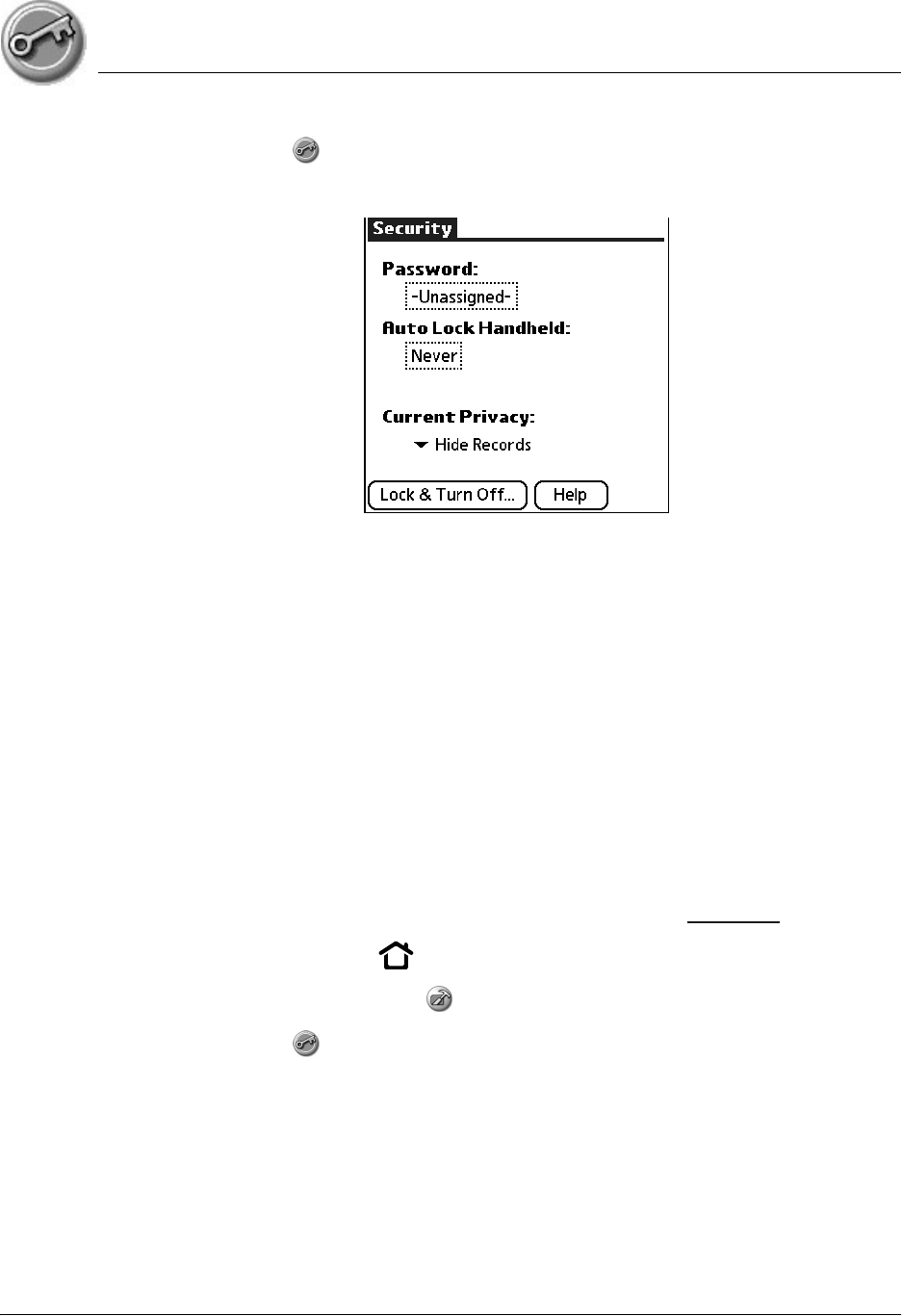
Security
Assigning and editing passwords
Using Your Zodiac Handheld 148
4. Select Security .
5. From the Current Privacy pick list, select Hide Records.
6. When you return to the Organizer applications, records marked as private
are not included in the display.
Note that you can mask or hide records without assigning a password, or you
can assign a password if you want records to remain masked or hidden until a
password is entered.
Assigning and editing passwords
You can assign a password to protect your private records and to lock your
handheld.
Once you define a password, you can change or delete it at any time. You
must enter the current password before you can change or delete it.
If you’ve forgotten your password, you can delete it, see page 150.
1. Press the Home button .
2. Select the Utilities category .
3. Select Security .
4. Tap the Password box.
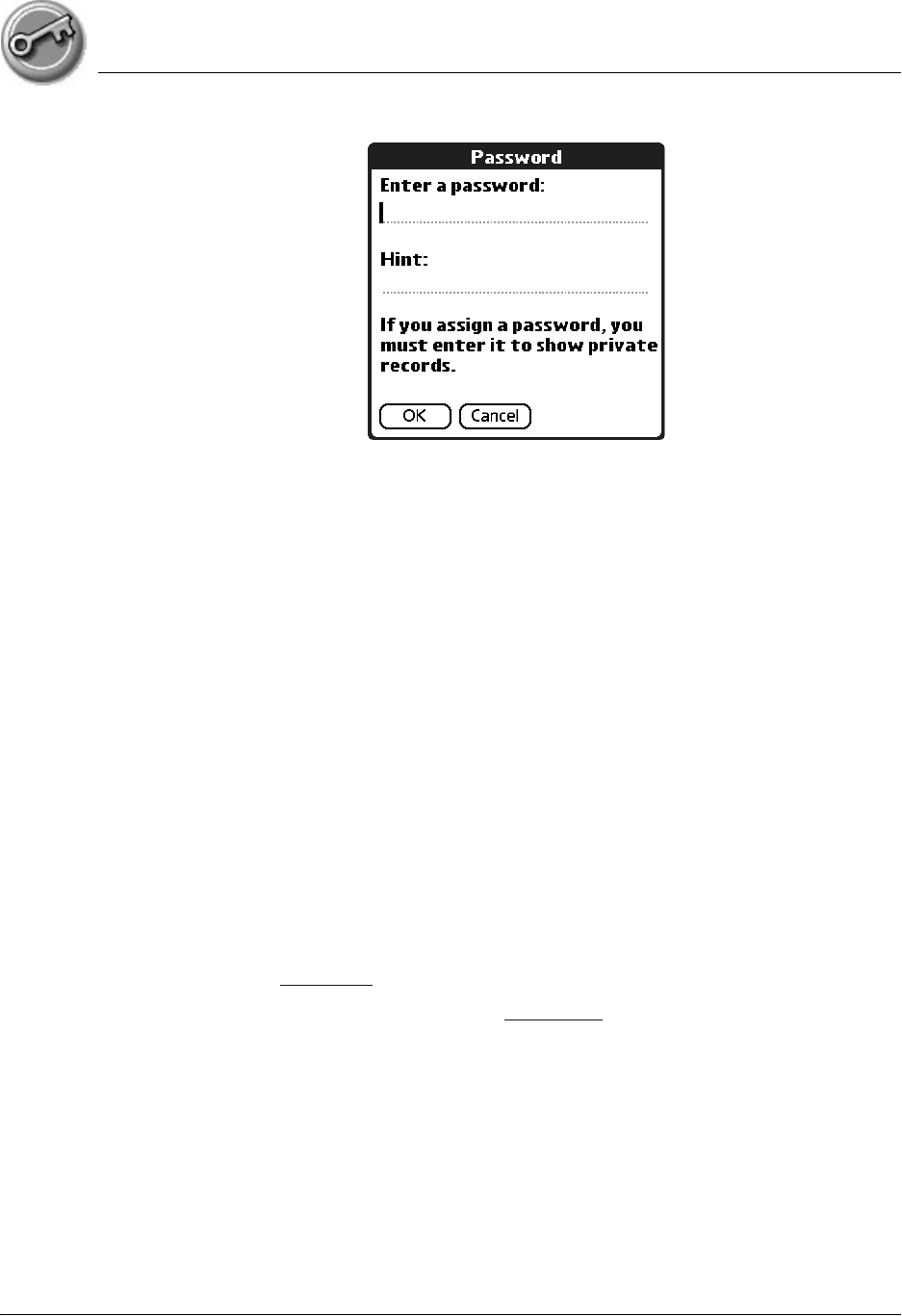
Security
Locking your handheld
Using Your Zodiac Handheld 149
5. Enter a password—either the one you want to assign or your current
password if you want to change or delete it—and tap OK
6. Choose from the following options:
•To assign a password, enter the password again to verify it, and tap OK.
•To change your password, enter a new password and tap OK.
•To delete your password, enter your current password. Tap OK, and
then tap Unassign.
Locking your handheld
You can turn off and lock your handheld with a password to protect
information. You must then enter the password when you turn on your
handheld to gain access to the information on it.
If you forget the password, you must perform a hard reset to resume using
your handheld. Performing a hard reset deletes all the records in your
handheld; however, you can restore all synchronized data at the next HotSync
operation. See page 171 for more information.
1. Assign a password, as described on page 148.
A password is required before using the Turn Off & Lock option.
2. Tap Lock & Turn Off. The System Lockout dialog box appears.
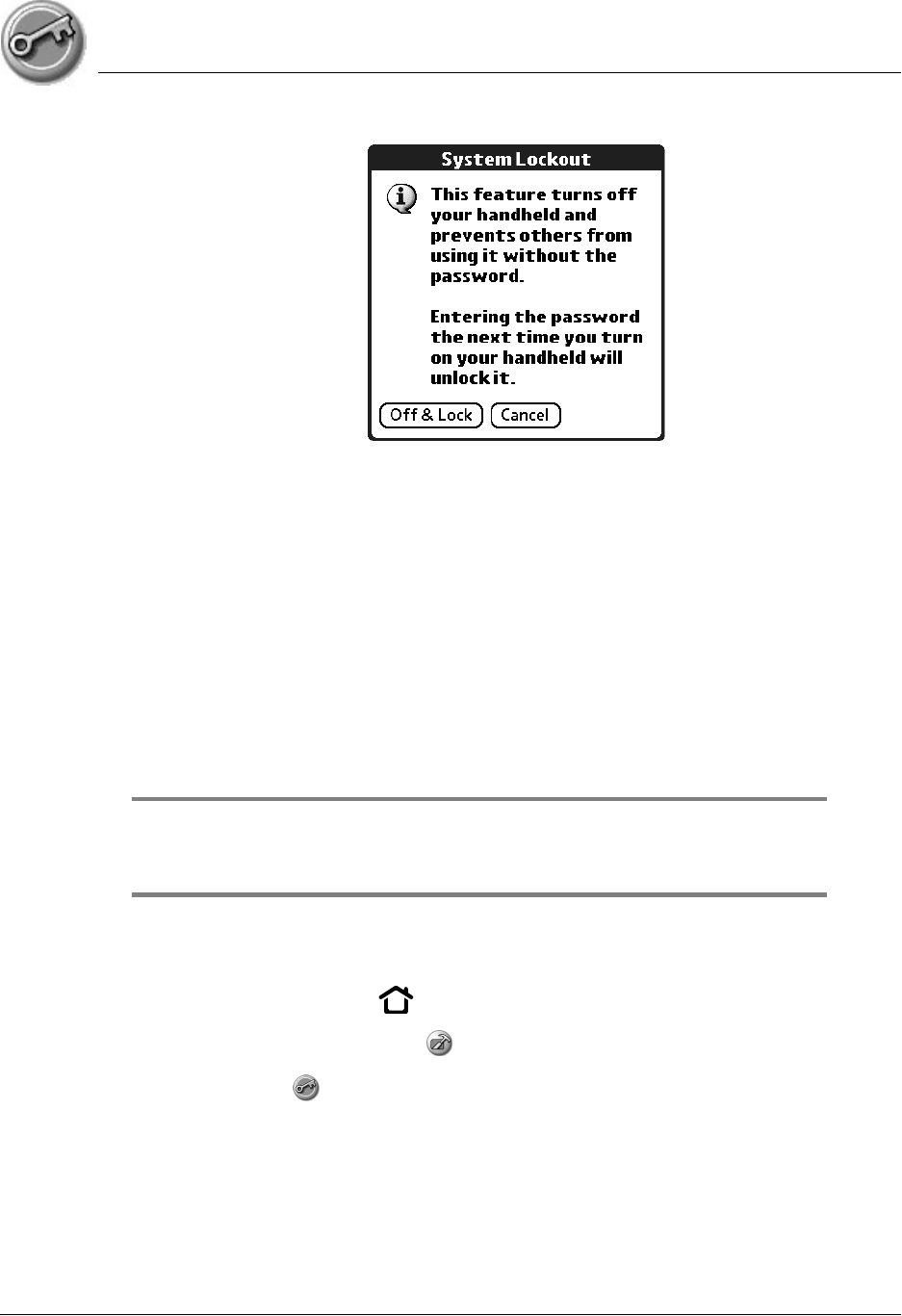
Security
Locking your handheld
Using Your Zodiac Handheld 150
3. Tap Off & Lock. Your handheld turns off and locks.
Turning on and unlocking your handheld
1. Turn on your handheld.
2. Enter your password at the prompt, and then tap OK.
Recovering from a forgotten password
If the Off & Lock option is not active, and you forget your password, you can
delete the forgotten password from your handheld. Deleting a forgotten
password also deletes all entries and files marked as Private.
IMPORTANT: If you synchronize with your computer before deleting a forgotten
password, your handheld restores private entries the next time you perform a
HotSync operation, but does not restore the forgotten password.
Deleting a forgotten password
1. Press the Home button .
2. Select the Utilities category .
3. Select Security .
4. Tap the password box.
5. Tap Lost Password.
6. A message appears; tap Yes to delete the forgotten password.
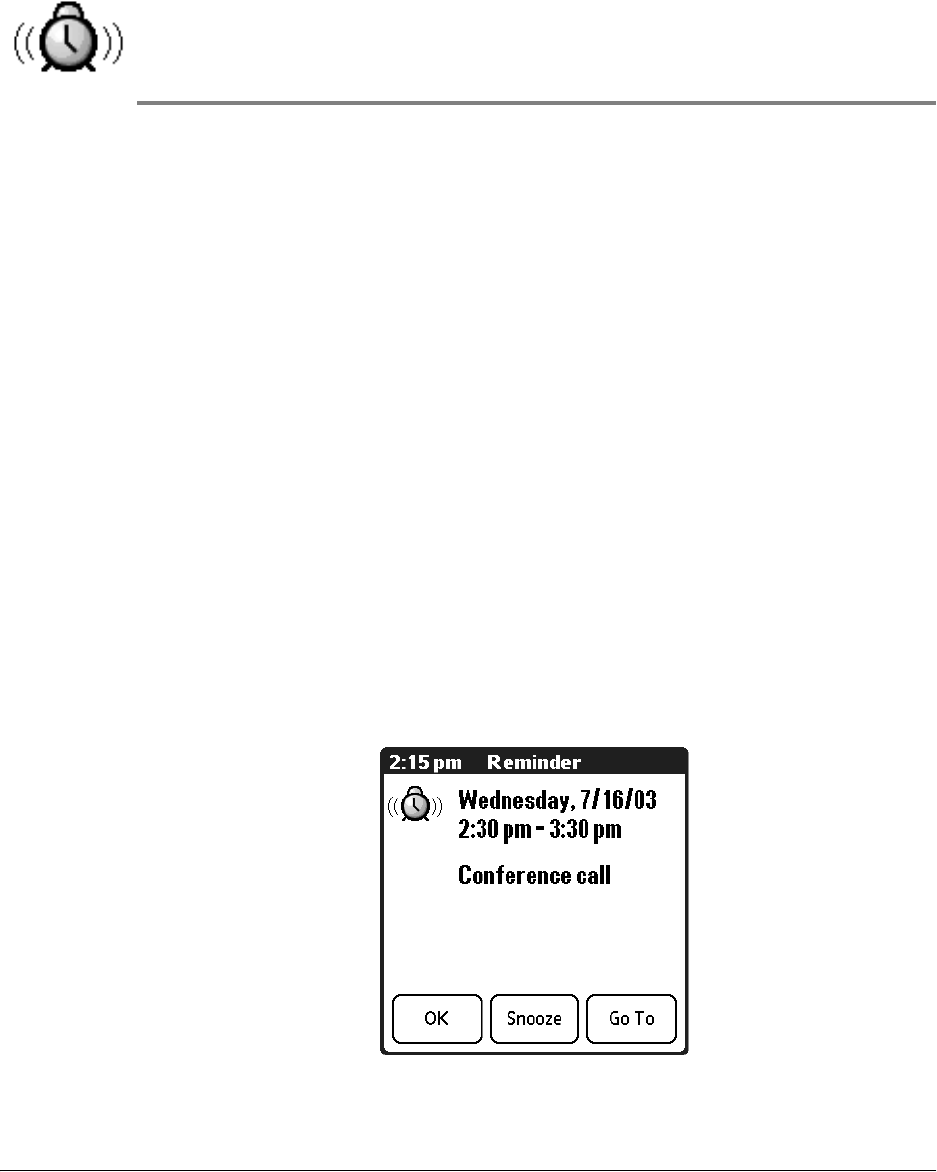
Using Your Zodiac Handheld 151
17
Using the Attention Manager
Many applications (such as Date Book and Clock) want to get your attention
with some sort of alarm. Attention Manager provides a way for you to
conveniently manage all of these notifications in one place. Appointments
and messages can stack up while you are away from your handheld. You can
then use Attention Manager to view them from a single list and selectively
dismiss or follow up on each alarm.
Alarms request your attention at two different levels: insistent and subtle. This
chapter describes both types of requests.
Insistent alarms
Insistent applications open a Reminders dialog screen, and may play a sound,
flash an LED, or vibrate, depending on your hardware configuration. Alarms
continue until you snooze or dismiss them. If the sound can be interrupted,
you can tap anywhere on the screen, or push any button to silence it.
Attention Manager opens immediately when new insistent alarms are posted.
Using the Reminder dialog screen
The Reminder dialog screen has three buttons for responding to an alarm:
•OK: Makes the reminder go away, with no further notification.
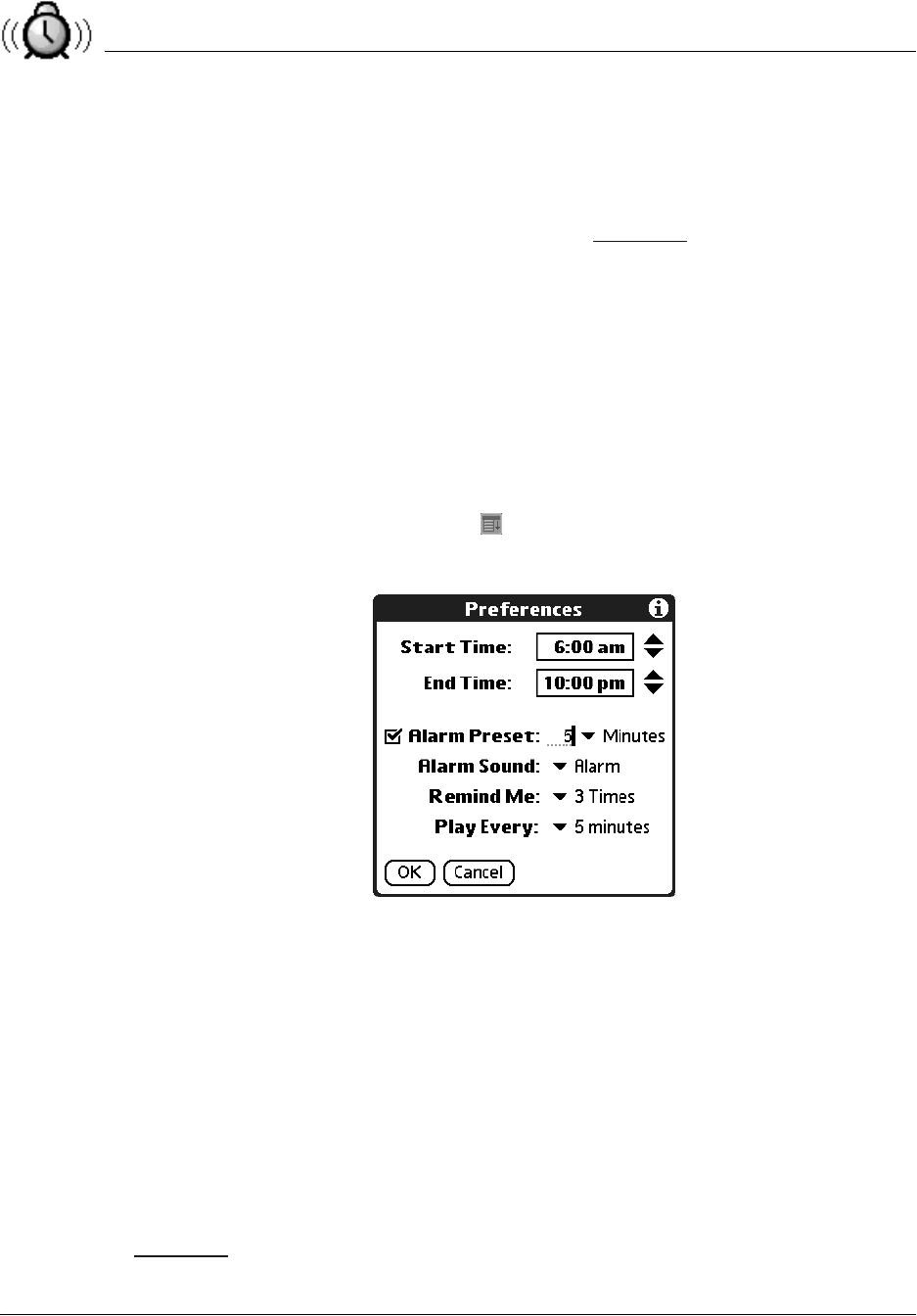
Using the Attention Manager
Insistent alarms
Using Your Zodiac Handheld 152
•Snooze: Switches to the application that was running when the alarm
went off, and returns to the Reminder dialog screen after five minutes.
You can go back to the Reminder dialog screen right away by tapping
the blinking indicator in the upper left corner of the screen. For more
information on the blinking indicator, see page 154.
•Go To: Switches to the application that created the alarm, and shows
the record that caused the alarm, although you may have to navigate
within the application. There is no further notification.
Setting alarm sound effects
Some applications allow you to set the tune or sound effect to use, and how
many times to play it, with a pause in between. For example, to set alarm
preferences for Date Book, do the following:
1. In Date Book, tap the Menu icon .
2. From the Options menu, select Preferences.
3. Check the Alarm Preset box, if you want alarms to sound, then select the
following from the pick lists:
•Alarm Preset. Indicate how soon you want the alarm to sound before
the event.
•Alarm Sound. Choose the alarm tune or sound effect (for example,
Bird or Concerto).
•Remind Me. Specify how many times the alarm repeats before it stops.
•Play Every. Set the pause between each time the alarm sounds.
For information on setting the alarm volume level and vibrate option, see
page 134.
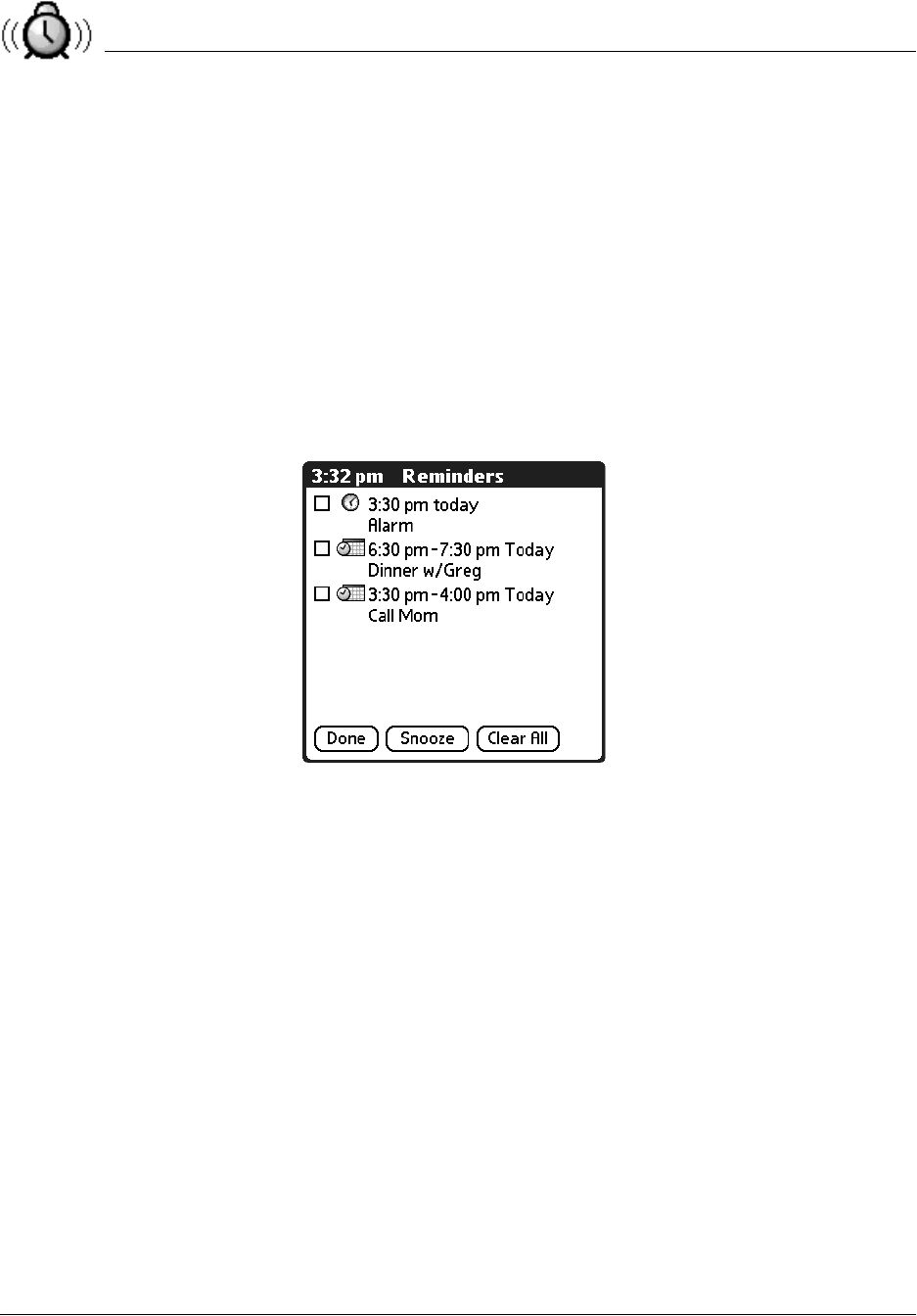
Using the Attention Manager
Insistent alarms
Using Your Zodiac Handheld 153
Using the Reminders list screen
The Reminders dialog screen changes to a list of items that require your
attention under two insistent alarm conditions:
•When a second application attempts to get your attention and the first
has not been dismissed or snoozed.
•When a first application makes a second attempt and the first has not
been dismissed or snoozed.
Each reminder lists the date and time of the alarm. Depending on the
application displaying the reminder, you may see an icon representing the
application, and up to two lines of text.
Tapping the text or icon jumps to that item and deletes the event from the
Reminders list screen.
Checking a box clears that item, similar to a To Do list item. The Attention
Manager draws a line through the text lines, pause for a moment, and them
remove the item from the list, although the original data remains in the
application.
The Reminders list screen displays three buttons that you can use to respond
to the items in the list:
•Done: If the Reminders list appeared because of more than one
insistent alarm, tapping Done closes the Reminders list screen,
although the events remain in the application that created them. The
Reminders list screen does not appear again, unless you tap the
blinking alarm indicator in the menu bar.

Using the Attention Manager
Subtle alarms
Using Your Zodiac Handheld 154
If the Reminders list appeared after you tapped the Snooze button,
then tapped the blinking alarm indicator, then tapped the Done
button, the reminder continues to snooze.
For more detail, see the next section.
•Snooze: Put the Reminders list screen to sleep for five minutes. After
this time interval, the Reminders list screen appears again. You can go
directly to the Reminders list screen without waiting, by tapping the
blinking alarm indicator. For more detail about the blinking indicator,
see page 154.
•Clear All. Remove all of the items from the list, but does not close the
Reminders screen. Tap this button to erase a list of events that have
passed.
Subtle alarms
Some applications provide a visual, and optionally audible indication, but do
not otherwise disrupt your work flow. Subtle alarms do not display a
Reminders screen. Instead, a blinking indicator flashes (in applications that
support it) when an alarm is present.
Understanding the blinking alarm indicator
In applications that allow it, a blinking alarm indicator appears in the Status
Bar under the following conditions:
•While viewing a Reminders dialog screen, you tap the Done or the
Snooze button.
•A subtle alarm is present.
The indicator appears in two different states:
•Off. The indicator is not shown at all when the list is empty.
•Blinking. When there is an item in the list, then the “exclamation
point” indicator blinks on and off until you empty the list.
Tapping the indicator opens the Attention Manager in list mode, even if there
is only one item.
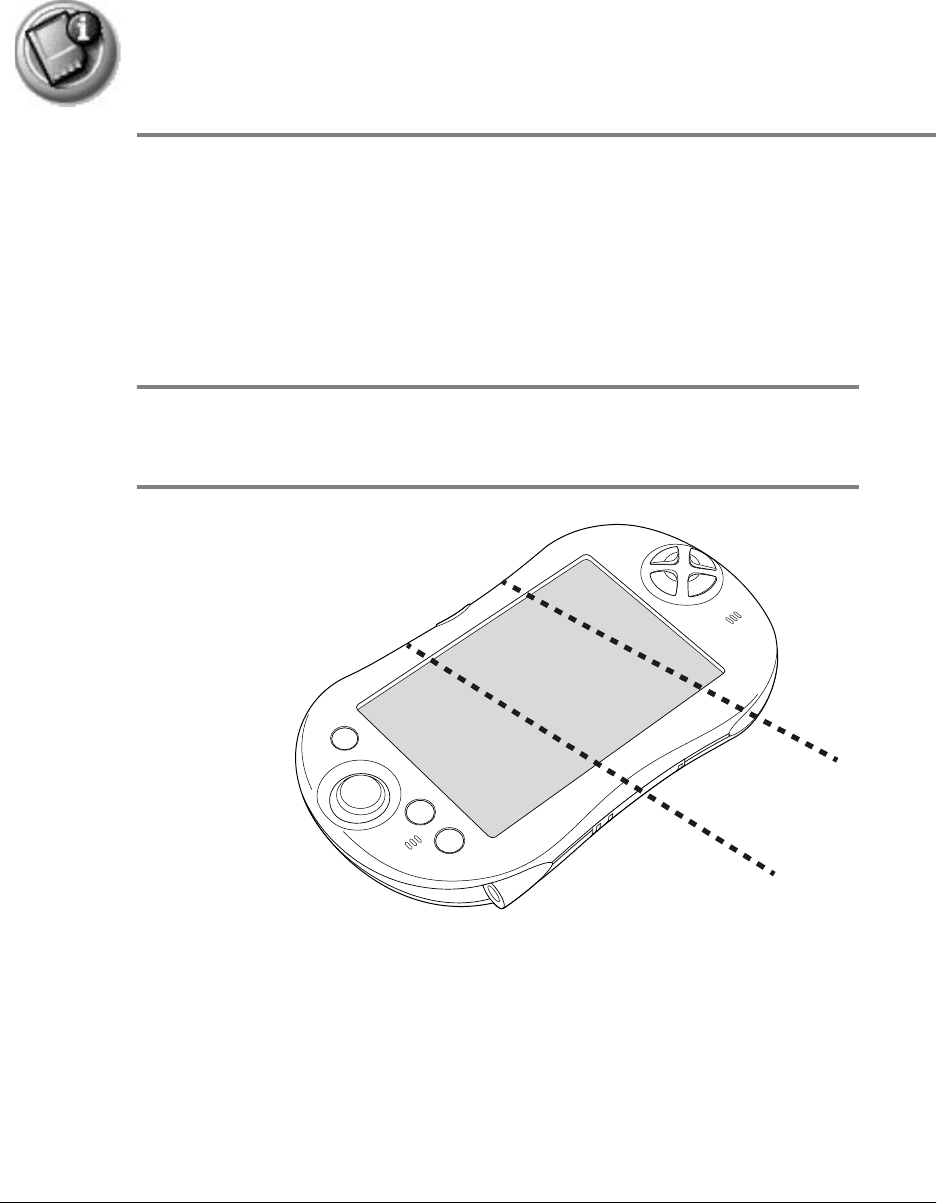
Using Your Zodiac Handheld 155
18
Using Expansion Cards
Zodiac lets you add expansion cards to your handheld. Use expansion cards
to:
•Expand your handheld’s storage capacity
•Share files with other people
•Backup your data
IMPORTANT: On your handheld, expansion slot 1 (left) is compatible with Secure
Digital (SD) and MultiMedia (MMC) expansion cards. Expansion slot 2 (right) also
supports SDIO expansion cards. Remember to use slot 2 for SDIO cards.
Slot 1 for
SD and
MMC
cards
Slot 2 for
SDIO, SD,
and MMC
cards
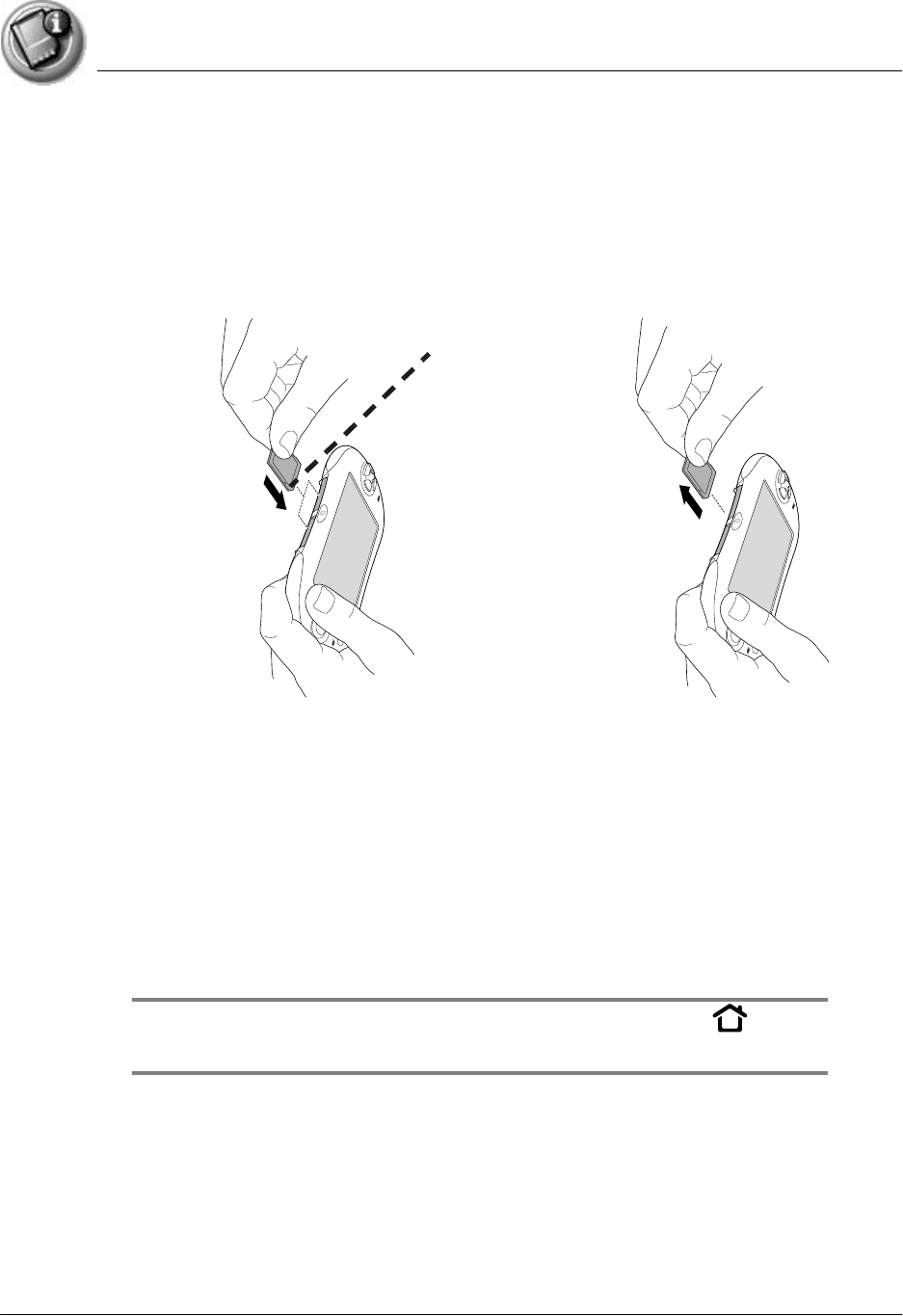
Using Expansion Cards
Inserting and removing an expansion card
Using Your Zodiac Handheld 156
Inserting and removing an expansion card
1. Hold the expansion card with the label facing you and the notch in the
lower-left corner.
2. Hold your handheld with the screen facing you.
3. Slide the expansion card into the slot until you feel it click into place.
4. When you’re done using the card, gently press the top of the card to
release it from the slot and lift it out of the slot.
Accessing applications on an expansion card
When an expansion card is inserted, the card automatically appears as a new
Home category. This category is assigned the name of the expansion card
volume; for example, the name “Card 1” is used throughout this section.
1. Insert an expansion card into an expansion slot.
NOTE: If the Home screen does not appear, press the Home button and select the
card name, such as Card 1.
Notch
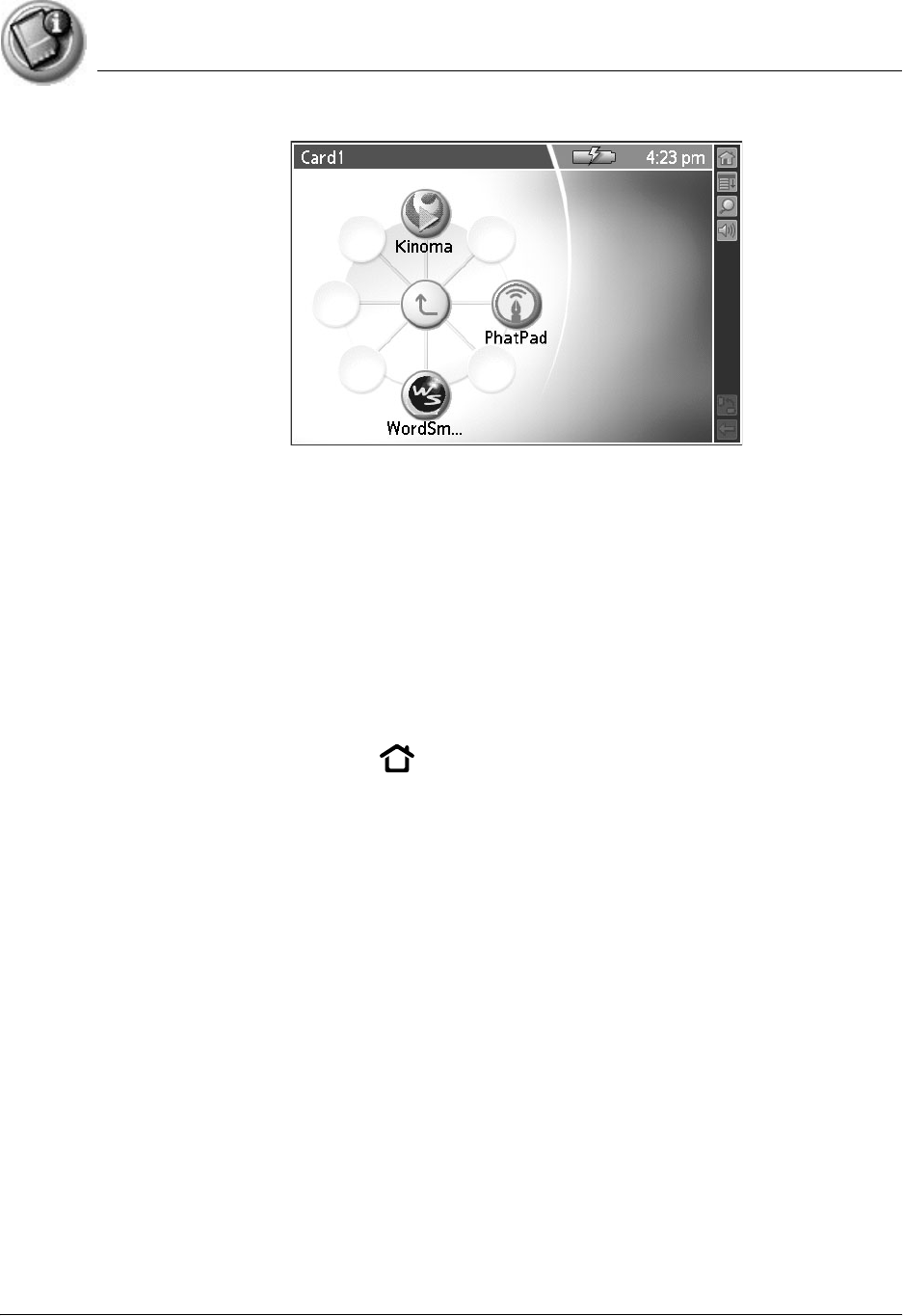
Using Expansion Cards
Displaying information about applications on an expansion card
Using Your Zodiac Handheld 157
The applications on the card appear on the Home screen.
2. Select the application that you want to launch.
The selected application is loaded into memory and launched. If the
application is already resident in main memory, it is not copied again, just
launched.
Displaying information about applications on an expansion card
1. Insert an expansion card into an expansion slot.
2. Press the Home button .
3. Select the card name, such as Card 1.
4. Tap the card name in the title bar to open the menus.
5. From the App menu, select Info.
6. From the Device pick list, select the card name. The screen displays the
size of the applications on the card.
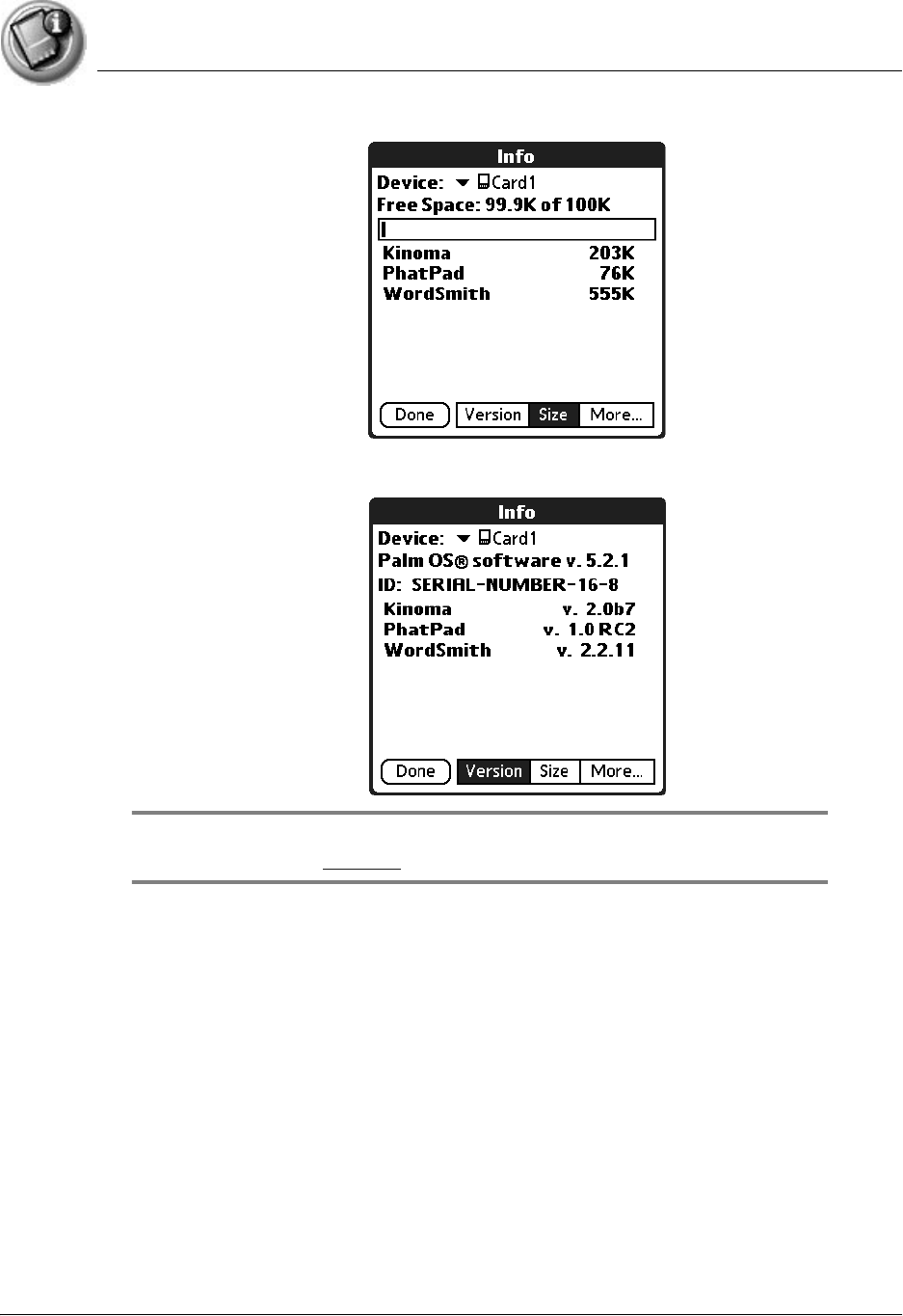
Using Expansion Cards
Copying an application from an expansion card
Using Your Zodiac Handheld 158
7. To display the application version, tap Version.
TIP: When you tap More, you access the CardInfo application, described in the
section that begins on page 161.
Copying an application from an expansion card
You can copy applications from an expansion card to any of the following:
•Another expansion cards
•Your handheld
•Your desktop software
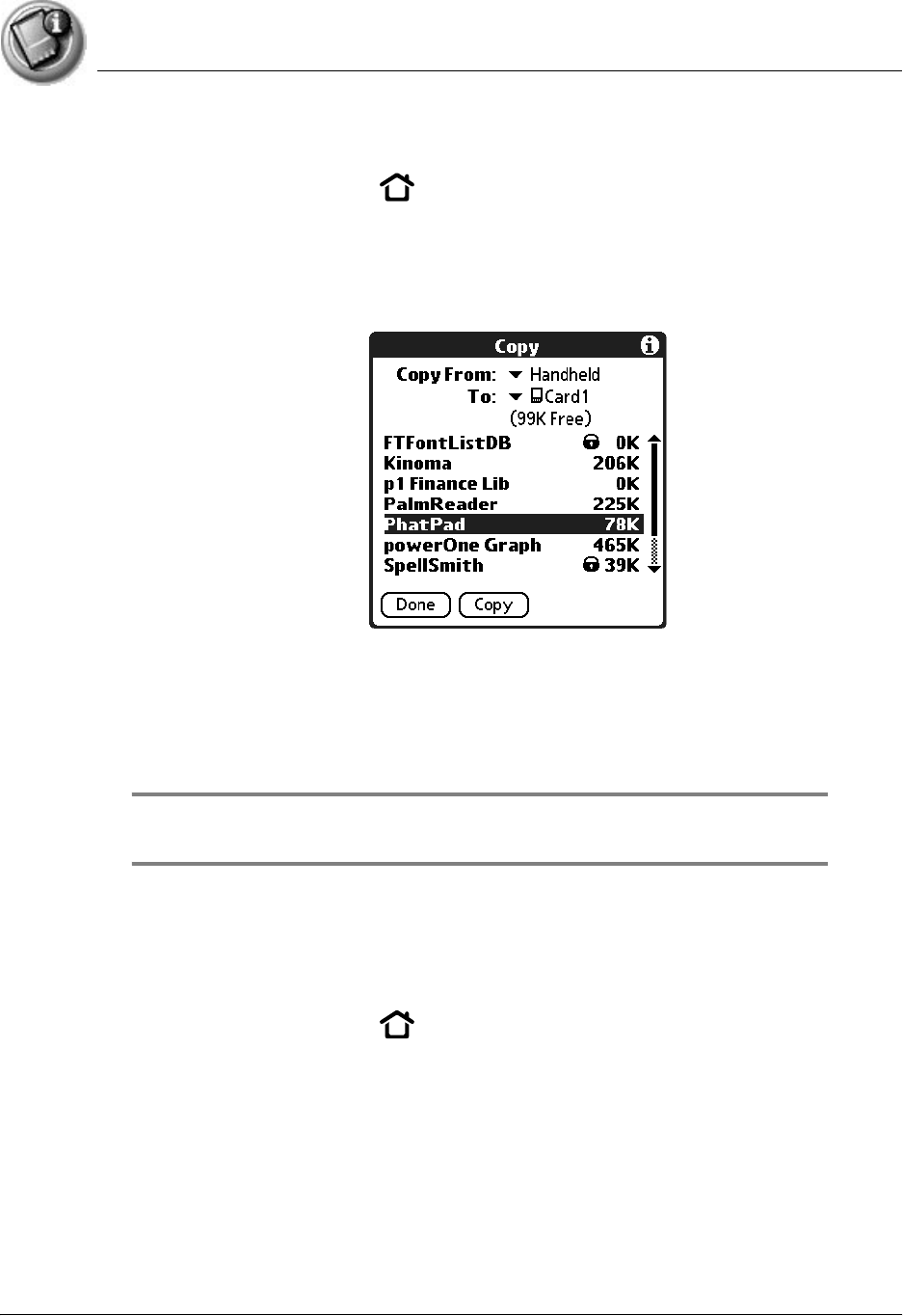
Using Expansion Cards
Beaming or sending applications from an expansion card
Using Your Zodiac Handheld 159
1. Insert an expansion card into an expansion slot.
2. Press the Home button .
3. Select the card name, such as Card 1.
4. Tap the card name in the title bar to open the menus.
5. From the App menu, select Copy.
6. From the Copy From and To pick lists, select the source and the
destination.
7. Select the application and then tap Copy.
The application is copied to the selected destination.
TIP: Some applications and databases are copy-protected and cannot be copied.
These are listed with a lock icon next to them.
Beaming or sending applications from an expansion card
1. Insert an expansion card into an expansion slot.
2. Press the Home button .
3. Select the card name, such as Card 1.
4. Tap the card name in the title bar to open the menus.
5. From the App menu, select Beam or select Send.
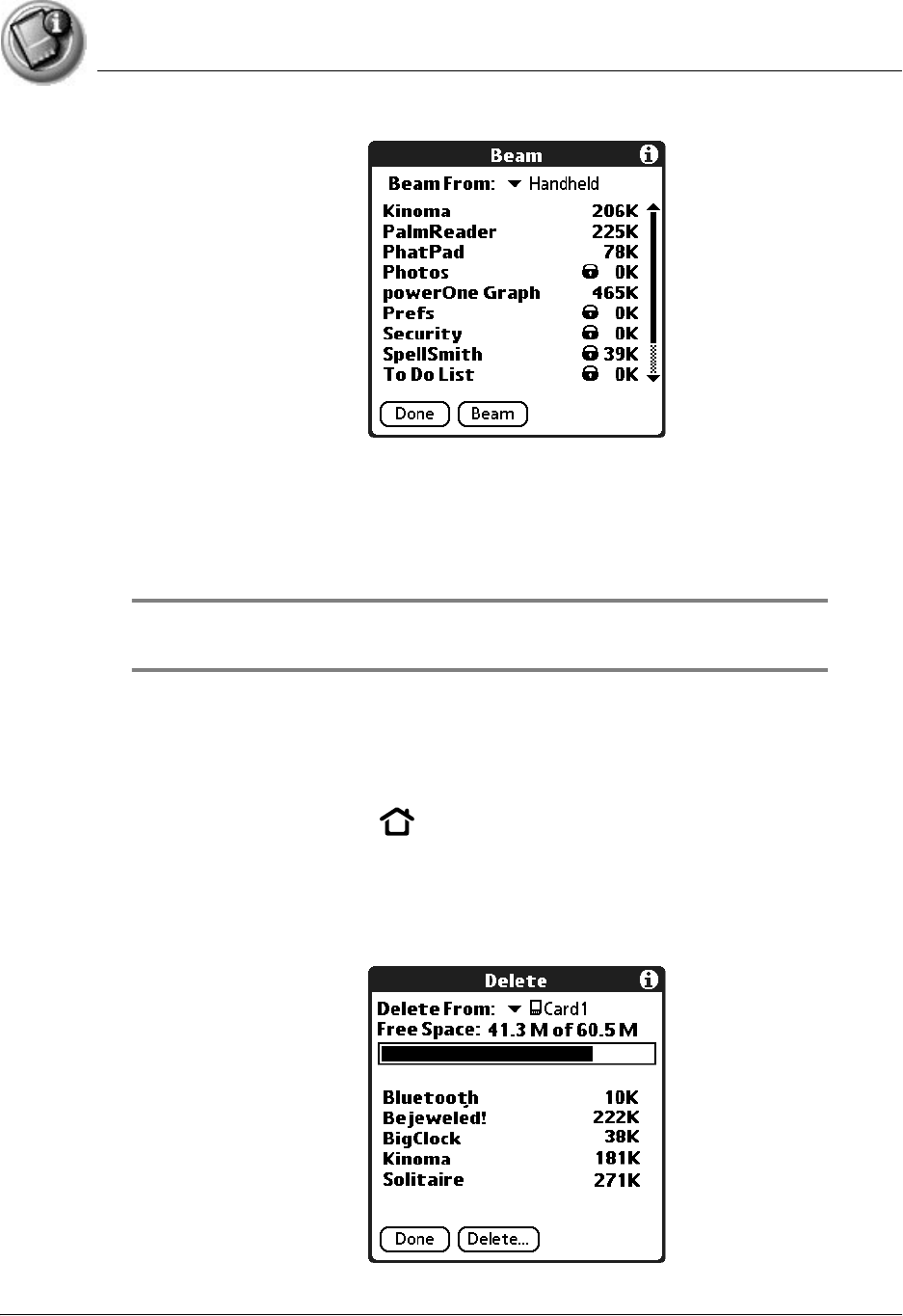
Using Expansion Cards
Deleting applications from an expansion card
Using Your Zodiac Handheld 160
6. From the Beam From (or Send From) pick list, select the card name.
7. Select the application you want to beam or send, then tap Beam or tap
Send.
The application is beamed or sent to the other handheld.
TIP: Some applications and databases are copy-protected and cannot be
beamed. These appear with a lock icon next to them.
Deleting applications from an expansion card
1. Insert an expansion card into an expansion slot.
2. Press the Home button .
3. Select the card name, such as Card 1.
4. Tap your user name in the title bar to open the menus.
5. From the App menu, select Delete.

Using Expansion Cards
Using CardInfo
Using Your Zodiac Handheld 161
6. From the Delete From pick list, select the card name, such as Card 1.
7. Highlight the application you want to delete, then tap Done.
The application is deleted. Applications that are loaded in ROM (for example,
Memo Pad) cannot be deleted, and are not listed.
Using CardInfo
The CardInfo application displays summary information for each known
directory type found on an expansion card.
1. Insert an expansion card into an expansion slot.
2. If the Home screen does not appear, press the Home button .
3. Select the Utilities category .
4. Select the CardInfo icon .
5. From the Card pick list, select the card name, such as Card 1.
The CardInfo screen displays information about the expansion card seated in
the expansion slot.
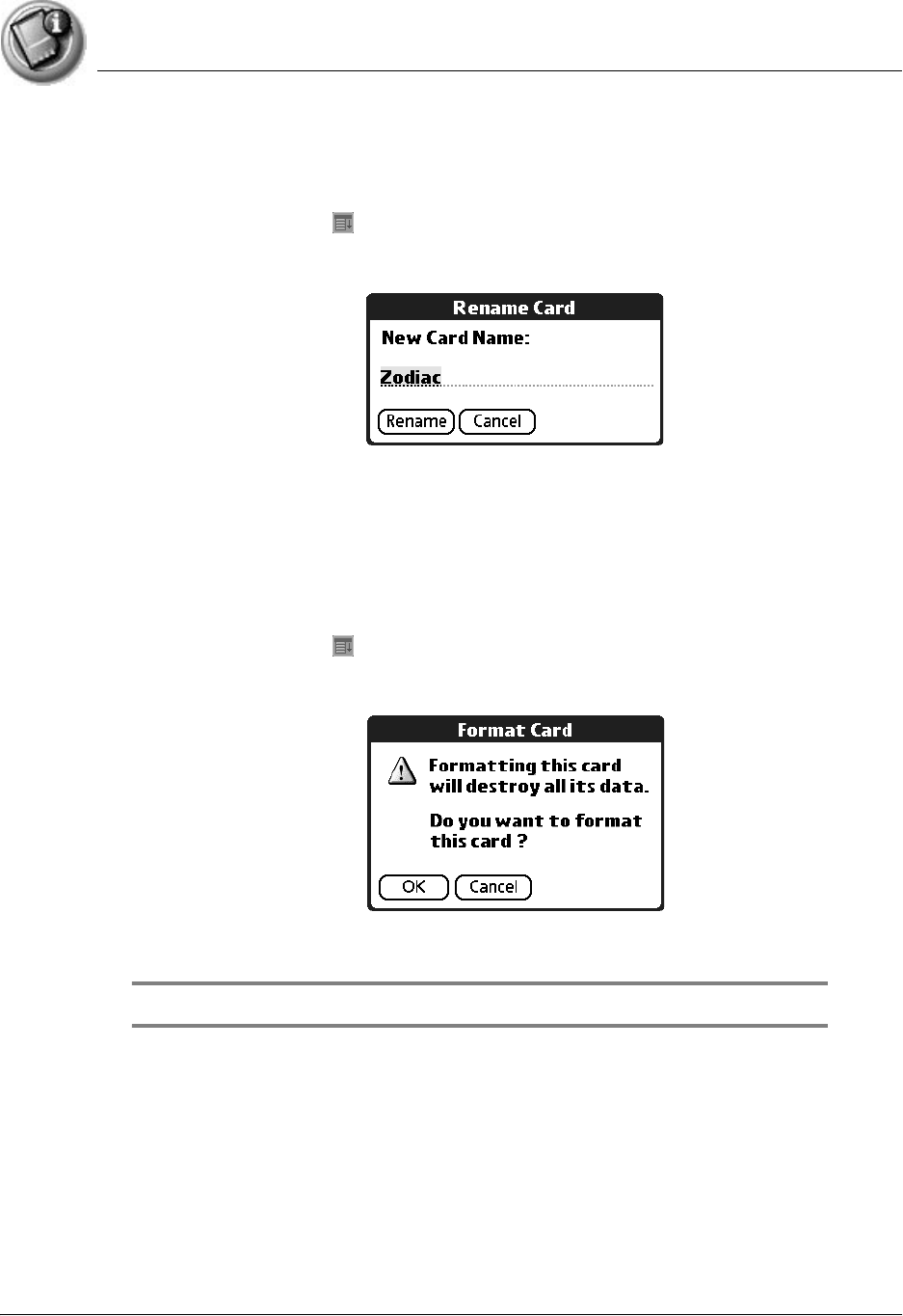
Using Expansion Cards
Using CardInfo
Using Your Zodiac Handheld 162
Renaming an expansion card
1. Open Card Info.
2. Tap the Menu icon .
3. From the Card menu, select Rename Card.
4. Enter the new name in the Rename Card dialog box.
5. Tap Rename.
Reformatting an expansion card
1. Open Card Info.
2. Tap the Menu icon .
3. From the Card menu, select Format Card.
4. Tap OK.
IMPORTANT: Reformatting an expansion card erases all of its data.

Using Your Zodiac Handheld 163
19
Beaming and Sending
Information
Your Zodiac handheld is equipped with an IR (infrared) port that you can use
to beam information to another Palm OS device that’s close by and also has an
IR port. The IR port is located at the top of the handheld, behind the small dark
shield.
Your handheld is also equipped with a Bluetooth radio. If you are within range
of other devices that are enabled with Bluetooth technology, you can use
Bluetooth communication to send them information. The Bluetooth button
is located on the top of your handheld.
Additionally, if you install the optional SMS software from the CD that came
with your handheld and you have a compatible mobile phone, you can use
SMS technology to send information as well.
You can beam or send the following information between Palm Powered
handhelds and other compatible devices:
•The record currently displayed in Photos, Date Book, Address Book, To
Do List, or Memo Pad.
•All records of the category currently displayed in the Photos, Address
Book, To Do List, or Memo Pad applications.
•A special Address Book record that you designate as your business
card, containing information you want to exchange with business
contacts.
•An application installed in your handheld’s internal memory or on an
expansion card seated in one of expansion slots.
NOTE: To prevent music piracy, you cannot beam or send songs from the Music
application.

Beaming and Sending Information
Creating a business card
Using Your Zodiac Handheld 164
For best results while beaming, Zodiac handhelds should be within one foot
of each other, and the path between the two handhelds must be clear of
obstacles. Beaming distance to other Palm OS devices may be different.
TIP: You can also perform HotSync operations using the IR port. See page 141 for
more information.
Creating a business card
1. In the Address List, create a new entry or select an entry that contains the
information you want on your business card. See page 79 for more
information.
2. In Address view, tap the Menu icon .
3. From the Record menu, select Select Business Card.
4. At the prompt, tap Yes.
Beaming a record
1. Locate the record, business card, or category you want to beam.
2. Tap the Menu icon .
3. From the Record menu, select the appropriate command:
•Beam. Beams an individual item.
•Beam Business Card. Beams the record defined as your business card.
In Address Book only.
•Beam Category. Beams all records assigned to the selected category.
TIP: You can use the Graffiti 2 Command stroke /B to beam the current entry.
4. When the Beam Status dialog box appears, point the IR port directly at
the IR port of the receiving handheld.
When the Beam Status dialog box indicates that the transfer is complete,
you can resume working on your handheld.
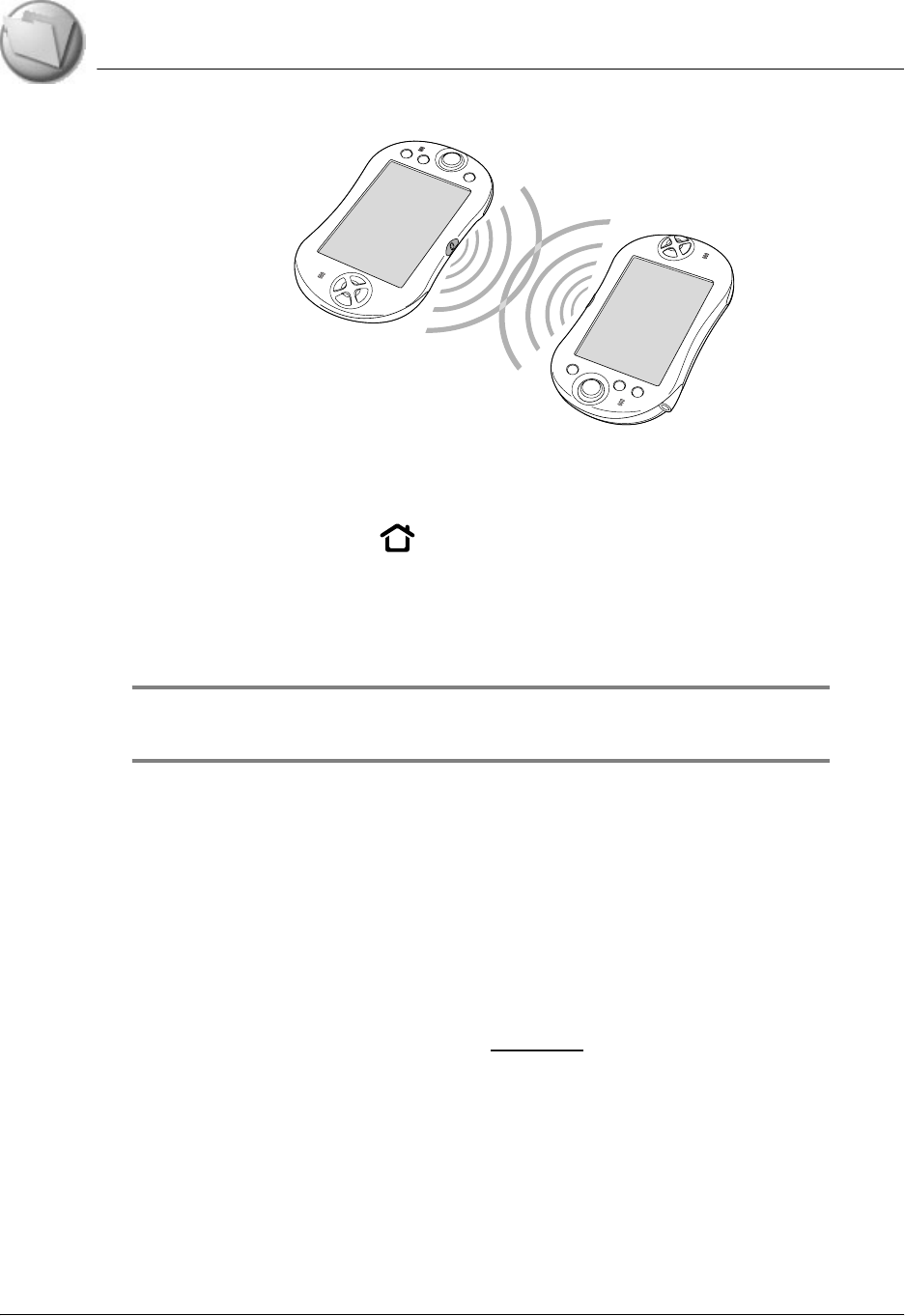
Beaming and Sending Information
Beaming an application
Using Your Zodiac Handheld 165
Beaming an application
1. Press the Home button .
2. Tap the left side of the title bar to access the menus.
3. From the App menu, select Beam.
4. Select the application you want to transfer, and tap Beam.
NOTE: Some applications are copy-protected and cannot be beamed, as indicated by a
lock icon.
5. When the Beam Status dialog box appears, point the IR port directly at
the IR port of the receiving handheld.
When the Beam Status dialog box indicates that the transfer is complete,
you can resume working on your handheld.
Receiving beamed information
To receive beamed information the Beam Receive option in General
Preferences must be turned on. See page 123 for details.
1. Turn on your handheld.
2. Point the IR port directly at the IR port of the transmitting handheld to
open the Beam Status dialog box.
3. Tap Yes.
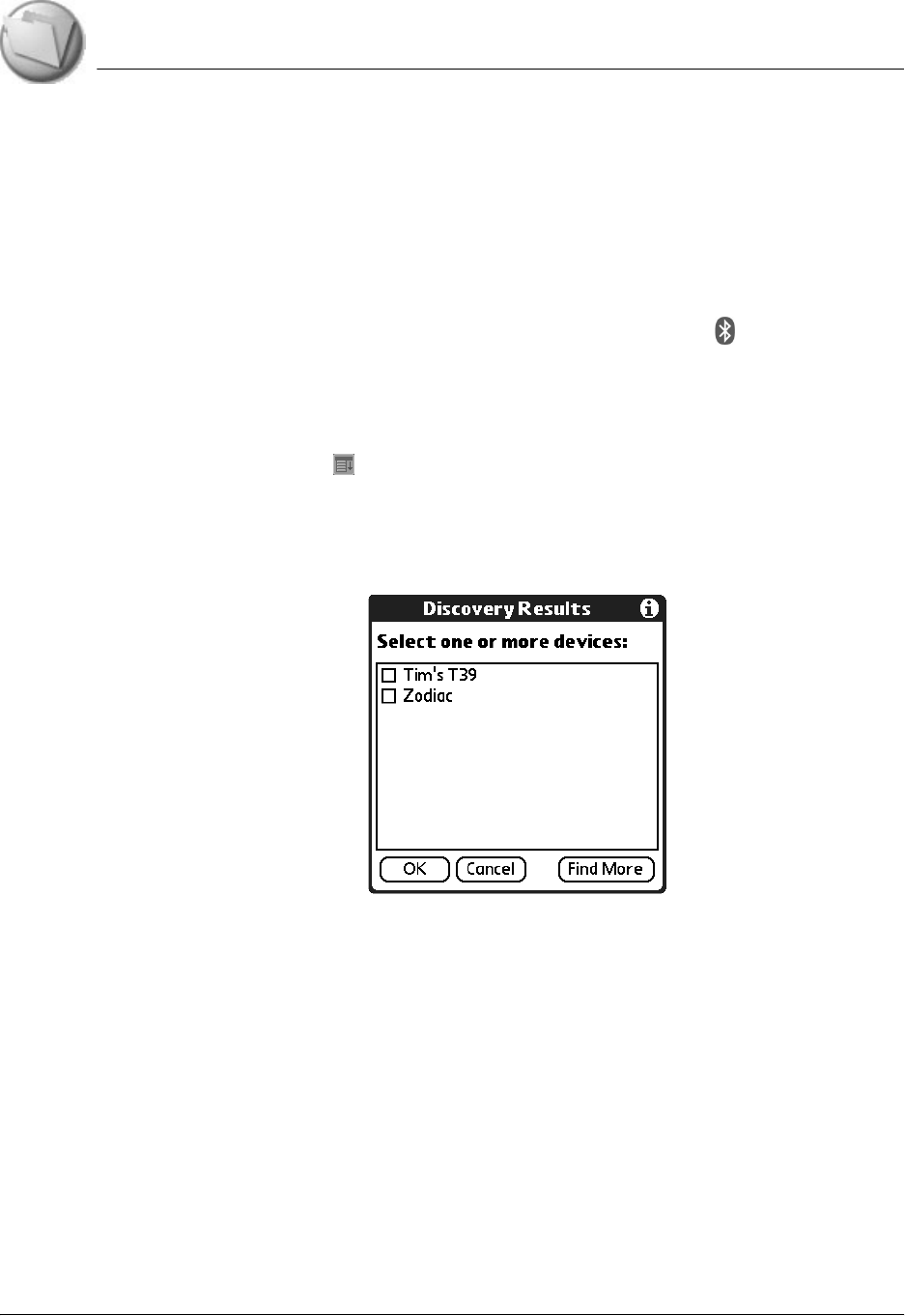
Beaming and Sending Information
Sending information with Bluetooth communication
Using Your Zodiac Handheld 166
4. Wait for the Beam Status dialog box to indicate that the transfer is
complete, and then tap OK to display the new entry.
5. Incoming records are placed in the Unfiled category.
Sending information with Bluetooth communication
1. If the Bluetooth radio is off, press the Bluetooth button to turn it on.
The blue LED turns on or flashes when the radio is on.
2. Display the desired Date Book, Address Book, To Do List, or Memo Pad
record you want to send.
3. Tap the Menu icon .
4. From the Record menu, select the Send command. The command names
vary based on the application (Event, Address, Category, Item, etc.).
5. Wait for the Discovery Results screen to appear.
6. Select the recipient’s user name from the list. If the name does not appear
in the list, and the device is within range, tap Find More.
7. Tap OK.

Using Your Zodiac Handheld 167
20
Maintaining Your Handheld
Upgrade information
If you already own a Palm OS handheld, Tapwave recommends that you install
the version of Palm Desktop software that comes with your new Zodiac
handheld into the same folder as your current Palm Desktop software. All of
your data is preserved when you install the new version in the same folder as
the previous version. If you use another desktop organizer application, such
as Microsoft Outlook, you still must install the most recent HotSync Manager
and conduit software for your desktop organizer from the Palm Desktop
software CD that came with your new handheld.
You can perform HotSync operations on your new handheld in exactly the
same way as you did on your old handheld, allowing you to quickly
synchronize your existing data with your new handheld. Just remember to
synchronize your old handheld with Palm Desktop software before you
synchronize with your new handheld, so you have the latest information.
When you synchronize your new handheld for the first time, select the
Desktop Overwrites Handheld option for all the conduits. For more
information on conduit settings, see page 139.
NOTE: If you used security features (for example, password protection) on your previous
Palm OS handheld, you must upgrade to the most current desktop. The method of storing
passwords has changed with the latest release of the desktop. Therefore, you must
upgrade to synchronize your password-protected information.

Maintaining Your Handheld
Upgrade information
Using Your Zodiac Handheld 168
Upgrading your Palm Desktop software
To upgrade your handheld, follow the steps below:
1. Synchronize your old handheld with your old Palm Desktop software to
ensure that the latest information from your handheld is on your desktop
computer.
2. (Optional) To prevent data loss, go to the folder that stores Palm Desktop
software, copy the folder and its contents, rename it (for example, Palm
Backup), and store the copy outside the Palm Desktop software folder.
3. Follow the installation instructions on page 13, and make sure you install
the new software in the same folder as the old software.
4. To prepare for the first HotSync operation with your new handheld and
new Palm Desktop software, go to HotSync Manager and choose Custom.
NOTE: Select your user name, if it does not already appear in the box.
5. For all conduits, click Change, and select the Desktop overwrites
handheld option. Then click Done. See page 139 for more information.
6. Connect your new handheld to the cable or cradle and press the HotSync
button. If the Select User dialog box appears, select your user name.
NOTE: If you customized the modem setup on your old handheld, you must re-enter the
modem initialization string. Any passwords you select on your old handheld are not
restored during this HotSync operation. Records you previously marked Private remain
marked Private, but you need to reenter a password on your new handheld.
7. Perform a soft reset after completing the upgrade process (see page 170).
Maintaining a unique name for each handheld
After you complete the upgrade process described in the previous section,
you have two handhelds with the same name. However, to prevent
complications and unexpected results during HotSync operations, each
handheld must have a unique name. Therefore, we strongly recommend that
you perform a hard reset on your old handheld as discussed in the next
section.

Maintaining Your Handheld
Caring for your Zodiac
Using Your Zodiac Handheld 169
Caring for your Zodiac
Your Zodiac is a delicate portable electronic device and it should be handled
with the same care you give to other delicate devices such as a digital camera,
cell phone, etc. Please observe the following recommendations:
•If your handheld’s case gets a little soiled, clean it with a damp cloth.
Do not wash or submerge your handheld in any liquid.
•Do not subject your handheld to unnecessary environmental stresses,
including:
– Dropping your handheld
– Stepping on your handheld
– Sitting on your handheld
– Getting your handheld wet
– Using your handheld in sand storms
– Operating your handheld in extremely cold or hot temperatures
•As with any other electronic device, try not to subject your handheld to
unnecessary static electricity. Static electricity in any electronic device
can prematurely destroy that device. Your handheld is designed to
tolerate a given amount of static electricity. Here are some suggestions
to minimize damage from static electricity:
– Before you pick up your handheld, discharge yourself of static
charges by touching any large surface (preferably metal).
– If you are using the optional cradle, discharge yourself of static
charges by touching any large surface (preferably metal) prior to
placing your handheld in the cradle. This is especially important in
very dry environments where static charges can easily accumulate.
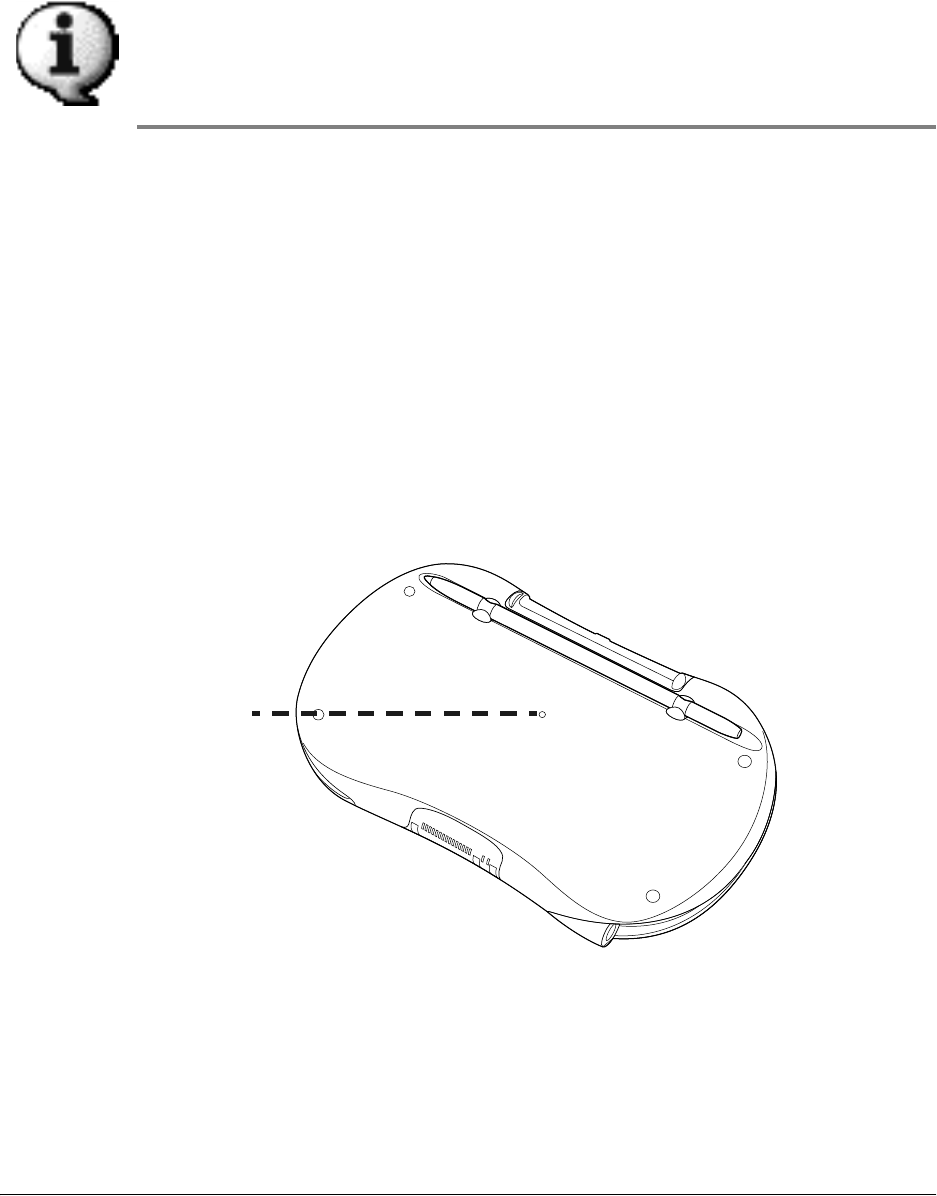
Using Your Zodiac Handheld 170
21
Frequently Asked Questions
Resetting your handheld
You may have to perform a reset if your handheld no longer responds to the
buttons on the screen.
Performing a soft reset
A soft reset allows your handheld to get a fresh start, similar to rebooting a PC.
All records and entries are retained after a soft reset.
To perform a soft reset, use the tip of your stylus (or another object without a
sharp tip such as an unfolded paper clip) to lightly press the reset button
inside the hole on the back panel of your handheld.
Reset
button

Frequently Asked Questions
Installing add-on software
Using Your Zodiac Handheld 171
Performing a hard reset
A hard reset erases all records and entries stored in your handheld. Never
perform a hard reset unless a soft reset does not correct your problem. When
you perform your next HotSync operation, you can restore any data that you
previously synchronized to your computer. To perform a hard reset, do the
following:
1. Hold down the power button on the front of your handheld.
2. While holding down the power button , use the tip of your stylus to
gently press and release the reset button.
3. Release the power button.
4. When a message appears on the handheld screen warning that all data
stored on the handheld is about to be erased, do one of the following:
•Complete the hard reset by pressing the Function button on the front
panel of the handheld. The Digitizer screen appears.
•Press the Home button to perform a soft reset.
NOTE: When you perform a hard reset, the current date and time are retained. Formats,
Preferences, and other settings are restored to their factory default settings.
Installing add-on software
Make sure the file you are trying to install is not a compressed file, such as a
ZIP or SIT file. If the application is compressed, you must decompress the
before installing it.
Troubleshooting TCP/IP connections
If you have problems connecting to a network using TCP/IP, you can display
information to troubleshoot the problem. You can display expanded Service
Connection Progress messages. You can also display the Network Log to see
all communication between your modem and dial-in server during login. This
information can help your ISP or your System Administrator identify where
and why the login communication fails.

Frequently Asked Questions
Troubleshooting TCP/IP connections
Using Your Zodiac Handheld 172
In addition, check with your system administrator whether a DNS number if
required. If a number is required but not entered, the connection may fail. If a
DNS number is required but not entered, logging on to your network may
appear successful. However, the connection fails if you try to use an
application or look up information. See page 127 for information on entering
a DNS number.
Viewing progress messages during login
1. In the Network Preferences screen, tap Connect. See page 131 for more
information on connecting to your ISP or dial-in service.
2. To see expanded Service Connection Progress messages, move the
analog controller Down during login.
Viewing the Network Log
1. In the Network Preferences screen, tap the Menu icon .
2. From the Options menu, select View Log.
3. Tap the Up and Down arrows of the scroll bar to see the entire Network
Log.
4. Tap Done.
For additional troubleshooting information, and answers to frequently asked
questions, visit tapwave.com.

Using Your Zodiac Handheld 173
22
Regulatory Information
Federal Communication Commission Interference Statement
This equipment has been tested and found to comply with the limits for a Class B
digital device, pursuant to Part 15 of the FCC Rules. These limits are designed to
provide reasonable protection against harmful interference in a residential
installation. This equipment generates, uses and can radiate radio frequency energy
and, if not installed and used in accordance with the instructions, may cause harmful
interference to radio communications. However, there is no guarantee that
interference will not occur in a particular installation. If this equipment does cause
harmful interference to radio or television reception, which can be determined by
turning the equipment off and on, the user is encouraged to try to correct the
interference by one of the following measures:
•Reorient or relocate the receiving antenna.
•Increase the separation between the equipment and receiver.
•Connect the equipment into an outlet on a circuit different from that to
which the receiver is connected.
•Consult the dealer or an experienced radio/TV technician for help.
This device complies with Part 15 of the FCC Rules. Operation is subject to the
following two conditions: (1) This device may not cause harmful interference, and (2)
this device must accept any interference received, including interference that may
cause undesired operation.
FCC Caution: Any changes or modifications not expressly approved by the party
responsible for compliance could void the user's authority to operate this
equipment.
Important Note: FCC Radiation Exposure Statement
This equipment complies with FCC radiation exposure limits set forth for an
uncontrolled environment. End users must follow the specific operating instructions
for satisfying RF exposure compliance.
This transmitter must not be co-located or operating in conjunction with any other
antenna or transmitter.

Using Your Zodiac Handheld 174
Index
Numerics
24-hour clock 122
A
accented characters 35
access restrictions 146
accounts 16
Acid Solitaire 59
Action buttons 18
activities 85
adding
categories 44, 69
expansion cards 155
add-on applications 47, 48, 171
Address Book
See also Organizer applications
adding custom fields 83
adding entries to events from 90
adding notes 75
categorizing records for 67
creating records for 64, 79–80
default categories for 68
deleting records from 67
duplicating entries for 81
editing categories for 69
editing entries 81, 82
finding records 70
opening 78
overview 78, 79
setting preferences for 83
sorting records in 73, 83
viewing entries 81
Address Entry Details dialog 82
Address icon 78
Address List view 81, 82
addressing e-mail 81
adjusting
screen orientation 21
volume 21, 51, 134
Agenda view 99
Agenda view icon 99
alarm clock 61
Alarm icon 93
Alarm Preset check box 152
Alarm Vibrate setting 134
alarms
accessing 62
adjusting volume for 62, 134
delaying 94
responding to 151
selecting sounds for 62, 95, 152
setting 93
specifying duration for 95
specifying preferences for 95
specifying repeat intervals for 152
types described 151, 154
alerts 24
See also alarms; reminders
All Day button 88
All view list 22
alphabet 33
alphabetic keyboard 37
alternate writing strokes 124
analog clock 62
analog controller 15, 18
calibrating 118
application buttons 26
applications
See also Organizer applications
adding add-on 47, 171
beaming 159, 165
common tasks for 64
connecting to 132
copying 16, 158
creating categories for 43, 44
default categories for 68
deleting 48, 160
displaying information about 157
documentation for 10
getting information on 46
importing from 39
installing 139
launching from expansion cards 156
locating text in 71, 72
managing 41
navigating through 27
opening 22, 23, 42
shortcuts for 46

Using Your Zodiac Handheld 175
organizing 43
running 15
Applications Launcher. See Home screen
applying fonts 77
appointments 85, 96, 151
archives 67
arranging icons 43
Ascending setting 62
Attention icon 24
Attention Manager 151–154
audible alarms 154
Auto-off after setting 14, 123
Autotext features 36
B
back panel 19
Background preference 45
backgrounds 45
backing up data 155
backing up files 15
backing up shortcuts 139
Backspace stroke 33
battery 13–14
extending life of 14, 53, 123
Beam command 159
Beam Receive setting 14, 123, 165
Beam Status dialog 164, 165
beaming
applications 165
from expansion cards 159
individual records 164
infrared communications and 141
overview 163
tips for 164
turning off 123
blinking alarm indicator 154
blinking cursor 32
Bluetooth button 17, 117
Bluetooth radio
playing multi-player games from 60
sending information with 163, 166
setting preferences 117
turning on/off 14, 117
boilerplates. See shortcuts
Bonus Software applications 16, 47
Box control 26
brightness control 21, 24, 124
buddy lists 117
built-in applications 48
See also Organizer applications
business cards 164
buttons
application 26
back panel 19
Calculator 114
front panel 17
not responding 170
C
calculations
displaying 115
performing 113, 114
storing in memory 114
Calculator 113–115
buttons described 114
Calculator icon 113
calendar 96, 120, 121
See also Date Book
calibrating touch-screen 15, 118
Calibration Preferences screen 118
call waiting 126
calling cards 126
capitalization 64
CardInfo application 161
categories
assigning records to 67, 68
assigning to addresses 82
assigning To Do items to 112
attaching notes to 103
changing 69
creating 44, 69
default application 68
deleting 45, 70
displaying 68, 83
organizing applications in 43
renaming 44, 69
selecting 41
viewing most recent 83
Category command 43, 44, 45

Using Your Zodiac Handheld 176
Category View
opening 43
removing categories from 45, 70
selecting categories in 22, 42
Change Repeat dialog box 91
Change Security dialog 74
changes, undoing 65
changing
addresses 81
categories 69
date/time formats 61
passwords 148, 149
records 65
scheduled events 89, 90, 91
screen orientation 21
shortcuts 133
To Do priorities 110
character sets 25, 30
characters
deleting 33
drawing accented 35
shortcuts for entering 36
writing special 33, 34–35, 130
charging battery 13–14
chime tones 134
clock 120, 121, 122
Clock application 61–63
Clock icon 61
COM port 142
command toolbar 28
communications 118, 136, 141
company names 80, 83, 131
company phone lists 144
Compress Day View option 101
conduit (defined) 139
configurations 118, 132, 143
multiple handsets 144
conflicting events 100
Connection Preferences screen 118–120
connection protocol 127
connection software 17
connections
automatic 117
external keyboards 39
requirements for 11
selecting configurations for 132
selecting network 125
setting device type for 119
setting ISP 131
setting preferences 118–120
setting up HotSync 12
setting up remote 124, 128
terminating 131
testing 132
troubleshooting 171–172
conserving battery power 14, 53, 123
contact information 80, 131
contacts. See Address Book
continuous events
changing 91
defined 86
scheduling 85, 91, 92
controller. See analog controller
Copy command 66, 159
Copy dialog box 159
copying
applications 16, 158
photos 57
text 66
correcting interference 173
country information 122
CPUs 19, 38, 118, 144
system requirements for 11
cradle 12, 123, 144, 169
creating
business cards 164
categories 44, 69
login scripts 128
memos 104
records 64
shortcuts 133
song lists 51
untimed events 90
user profiles 144–145
current dates 62, 121
customizing
handheld device 116
Home screen 43
HotSync Manager 139–140
Cut command 65

Using Your Zodiac Handheld 177
D
data
backing up 155
editing 36
entering 26, 30, 39
shortcuts for 36, 133
importing 39
overwriting 139
paging through 27
preserving 15, 167
restoring 171
selecting all 66
synchronizing 38, 136, 150
transferring 163
databases 39, 139, 159, 160
Date & Time Preferences screen 120–122
Date Book
See also Organizer applications
adding addresses to events from 90
changing views 96, 100
creating records for 64
displaying conflicting events 100
finding records in 70, 72
opening 85
overview 85
purging records from 67
removing repeating events 66
rescheduling events for 90, 91
scheduling events 86–90, 91
tips for 92
setting alarms for 93, 95, 152
setting preferences for 101
Date Book icon 85
date formats 61, 123
dates
displaying current 62
displaying photo 56
selecting event 89, 92
setting 61, 110, 121
shortcuts for entering 36
sorting on 111
day events 86
Day view 87
setting display options for 100, 101
Daylight Saving option 122
defaults 68, 122, 171
Delete command 66, 160
Delete dialog box 49, 161
deleting
applications 48, 160
categories 45, 70
characters 33
events 153
notes 76
Palm Desktop software 49
passwords 148, 149, 150
pictures 57
records 66, 67
repeating events 66
shortcuts 133
songs 52
text 65
desktop organizers 17, 38, 167
Desktop Overwrites Handheld option 167
desktop setup 13
desktop software. See Palm Desktop
Details dialog 120, 127
dialing mode 119
dialing preferences 119, 126
dialog boxes 29
dial-up connections 118, 119, 120, 131
digitizer 15
Discovery Results screen 166
Display Options command 100
Display Options dialog 101
displaying
addresses 81
applications 22
appointments 96
calculations 115
categories 68, 83
conflicting events 100
current date 62
Home screen 24
international keyboard 38
memos 105
menus 43
onscreen keyboard 37
photos 55
priorities 108, 112
private records 74, 75, 82
song lists 51

Using Your Zodiac Handheld 178
tips 29
videos 14
DNS numbers 127, 128
documentation 10
Domain Naming System (DNS) 127
downloading records 79
drivers 132
due dates 110, 112
Duplicate Record command 81
E
Edit Categories dialog 44, 45
Edit Categories option 69
edit line 65
Edit menu 65
edit mode 65
editing 65, 81, 82, 133
See also changing
editing commands 36
e-mail 81
Enable infrared communication option 141
Enable Quick Launch preference 46
End Time setting 102
entering data 26, 30, 39
shortcuts for 36
entering passwords 74, 131
escape characters 130
events
adding addresses to 90
changing preferences for 101
creating untimed 90
deleting 153
displaying conflicting 100
displaying time bars for 101
entering descriptions for 87, 90
rescheduling 89, 90, 91
scheduling 86–90, 91
tips for 92
setting alarms for 93, 95
setting duration for 86, 87, 88
types described 85
Expand/Collapse icon 24
expansion cards
accessing applications on 156
adding 155
beaming from 159
copying from 158
copying pictures to 57
displaying information for 157, 161
reformatting 162
removing songs from 52
renaming 162
viewing songs on 51
expansion slots 19
extending battery life 14, 53, 123
external keyboards 39
F
FAQs 170
file formats 39
files
backing up 15
caution for copying 16
importing from 39
sharing 155
synchronizing 139
Find dialog box 71
Find icon 24
finding records 70–72
Font command 77
fonts 77
forgetting passwords 150
Format Card command 162
formats 39, 61
specifying default 122
Formats Preferences screen 122–123
formatting expansion cards 162
freeing memory 48
front panel 17
Full-Screen mode 55
Function button 18
G
games
adjusting volume for 134
installing third-party 47
playing 59
General Preferences screen 123–124
gestures 36

Using Your Zodiac Handheld 179
Go to Date dialog box 89
Graffiti 2 area. See Input Area
Graffiti 2 demo 30
Graffiti 2 Help command 66
Graffiti 2 Help file 35
Graffiti 2 Preferences screen 124
Graffiti 2 ShortCuts 36
backing up 139
Graffiti handwriting software 30–37
editing commands for 36
tips for 32
grouping applications 43
H
handheld screen. See touch-screen
handwriting software 30–37
editing commands for 36
tips for 32
hard resets 149, 171
Headphone Bass setting 134
headphones 14, 20
help 16, 29
Hide Records setting 148
hiding records 74, 147
High Score Service conduits 139
Hold command 53
Hold state 53
Home button 18, 24, 156
Home category 156
Home screen
customizing 43
displaying menus in 43
managing applications from 41–43
opening 24
overview 22
setting preferences for 45
horizontal orientation (screen) 21, 24
HotSync button 137
HotSync cables 12, 123
HotSync command 139
HotSync connector 19
HotSync Manager
configuring for infrared devices 143
customizing 139–140
desktop organizers and 17, 49
running 137, 138
HotSync operations
creating user profiles for 144–145
disabling chime tones for 134
initializing 136
IR ports and 141
multiple devices and 168
performing 38, 136–138, 141, 144
setting defaults for 140
setting options for 138–139
setting up connections for 12
upgrades and 167
HotSync technology 11, 136
I
icons 22, 43
displaying alphabetical list of 45
idle 127
image files 54, 56
importing data 39
Info command 46, 157
Info dialog box 157
Info screen 46
infrared communications 136, 141
infrared devices 142, 143
Input Area 24, 25, 124
entering data in 31
Input Area Position setting 124
insistent alarms 151, 153
Install conduits 139
Install Tool dialog 47, 48
installation
applications 47, 139, 171
caution for 173
Palm Desktop 16, 167
system requirements for 11
installer 16
interference 173
international keyboard 38
Internet
connecting to 118, 127, 131
creating login scripts for 128
creating service templates for 125
IP addresses 127, 128

Using Your Zodiac Handheld 180
IR port
beaming from 163, 164, 165
location of 19
performing HotSync operations with 136, 141–
144
ISPs 118, 125, 131
creating login scripts for 128
J
joystick. See analog controller
K
keyboard
connecting to external 39
entering data from 25, 38
opening onscreen 37, 66
Keyboard command 66
keyboard shortcuts 28
L
landscape orientation 21, 24
laptops 141, 144
launching applications 157
LED display 13
lines, selecting entire 65
locating records 70–72
Lock & Turn Off option 149
lock icons 159, 160, 165
locking handheld device 148, 149
Login Script dialog 128
login scripts 128–130
Look Up option 70
Lost Password setting 150
lowercase letters 31
M
macros. See shortcuts
maintenance 169
Mask records setting 74, 147
mathematical calculator 113
Media category icon 54
meetings 85
Memo List 104, 105
Memo Pad 103–105
See also Organizer applications
categorizing records for 67
creating records for 64
default categories for 68
deleting records from 67
editing categories for 69
finding records in 70, 72
manually arranging records in 73
reviewing entries in 105
setting preferences for 105
sorting records in 73
Memo Pad icon 103
memory 48, 67, 104
memory cards. See expansion cards
memos 103, 104, 105
sorting 105
menu bar 24
Menu command stroke 36
Menu icon 24
menus
arranging icons on 22, 43
choosing commands 27, 28
displaying 24, 43
messages 103, 151
Microsoft Outlook 17, 136
mobile phones 118, 163
modems 118, 119, 120
Month view 98
setting display options for 100, 101
Month view icon 98
moving
applications 43
icons 43
MP3 files. See Music application
MP3 player 50
multi-player games 60
multi-stroke characters 31
music, listening to 14
Music application
beaming from 163
creating song lists for 51
removing songs from 52
running 50–52
Music icon 50

Using Your Zodiac Handheld 181
Mute icon 21, 24
My Stuff category 61
N
naming
categories 44, 69
handheld device 168
user profiles 145
navigating 23, 27
navigational controls 27
Navigator. See analog controller
Network Log 172
Network Preferences screen 124–131
networks
connecting to 119, 125, 127
setting login scripts for 128–130
setting preferences for 124
troubleshooting connections for 172
new lines 104
news readers 131
non-ASCII characters 130
note icon 76
notes 75, 76, 103
See also Memo Pad
notifications 151
numbers
entering 30, 31, 37
formatting 123
shortcuts for 36
tips for writing 33
numeric keyboard 37
O
online help 16
onscreen keyboard 25, 37–38
opening 66
Open to All Applications preference 45
opening
Address Book 78
applications 22, 23, 42
shortcuts for 46
Calculator 113
Category View 43
Clock application 61
Date Book 85
Home screen 24, 156
Info screen 46
Memo Pad 103
onscreen keyboard 37, 66
Photos application 54
Stroke Lookup screen 66
To Do List 106
options 45, 101, 138, 146
Organizer applications 38, 64, 75
changing font styles for 77
organizing applications 43
orientation (screen) 21
Orientation icon 21, 24
outdated records 67
Outlook 17, 136
overlapping events 100
overwriting data 139
Owner Preferences screen 131
P
paging through data 27
Palm Desktop
compatibility with 15
importing from 39
installing 11, 16, 167
removing 49
synchronizing with 136, 139
upgrades and 167
Palm OS devices 163
Palm Powered handheld devices 163
passkeys 117
passwords
entering 74, 131
recovering 150
saving 125
setting 148, 149
upgrades and 167
Paste command 66
PCs 19, 38, 118, 144
system requirements for 11
pen. See stylus
personal information 80, 131
phone book. See Address Book
phone drivers 132

Using Your Zodiac Handheld 182
phone lists 144
Phone Lookup command 72
Phone Lookup option 71, 90, 104, 107
phone numbers. See telephone numbers
Phone Preferences screen 132
Photos application 54–58
ordering pictures in 55
Photos icon 54
Pick list control 26
picture lists 55, 57
pictures
copying 57
deleting 57
managing 54
rotating 56
viewing location of 56
PIM. See Organizer applications
Play/Pause button 51
playback 51
playing games 59
portrait orientation 21
ports 19, 136, 142
Power button 18
preferences 45, 116
Preferences command 45
Prefs category 116
preserving data 15, 167
printing 15
prioritizing To Do items 108, 110
Private check box 74
private records 74, 75, 110, 147
caution for deleting passwords and 150
profiles 136, 144, 145
naming 145
progress messages 172
punctuation marks 34
Purge command 67
purging records 67, 109
Q
Quick Launch 46
quick strokes 28
R
radial menu 22, 43
radiation exposure 173
radio. See Bluetooth radio
rearranging icons 43
reboots 149, 170, 171
receiving information 14
Recent Calculations command 115
recharging battery 13
Record Completion Date option 112
records
assigning passwords to 148
attaching notes 75
beaming 164
categorizing 67–68
caution for deleting passwords and 150
creating 64
defined 64
deleting 66
displaying private 74, 75, 82
downloading 79
duplicating 81
editing 65
finding 70–72
hiding 74, 147
manually arranging 73
marking as private 74, 110
purging 67, 109
receiving 166
saving 67
sorting 72–73
recovering passwords 150
recurring events. See repeating events
reminders
creating 106
responding to 151, 153
setting alarms for 93, 95
viewing 153
Reminders dialog box 151, 153
closing temporarily 154
remote computers 118
remote connections 124, 128, 171
removing. See deleting
Rename Card command 162
Rename Custom Fields command 83

Using Your Zodiac Handheld 183
Rename Custom Fields dialog 84
renaming
categories 44, 69
expansion cards 162
Repeat button 51
Repeat check box 91
repeat intervals 92, 152
Repeating Event dialog 92
repeating events
changing 91
defined 86
displaying 101
removing 66
scheduling 85, 91, 92
replacing stylus 23
replaying songs 50, 51
rescheduling events 89, 90, 91
Reset button 19, 170
resets 149, 170, 171
responding to alarms 151
responding to reminders 153
restoring data 171
restricting access 146
Rotate icon. See Orientation icon
rotating photos 56
S
Save Archive check box 67
Save Archive Copy on PC check box 67
saving
passwords 125
records 67
schedules 85, 100
scheduling events 86–90, 91
tips for 92
screen
adjusting brightness 21, 124
adjusting orientation of 21
calibrating 15, 118
described 18
enlarging 24
navigating through 23
replacing backgrounds for 45
restrictions for 23
scroll bar slider 27
scrolling 27, 51, 70
Search icon. See Find icon
searches, halting 71
searching 24, 70, 72
security 74, 125, 131, 167
Security application 146–150
Security command 74, 75
security options 146
Select All command 66
Select Business Card command 164
Send command 159
sending information 163, 166
See also beaming
Service Connection Progress messages 131, 172
service templates 125, 127, 128
Set Time & Date command 61
Set Time dialog 87, 88, 89
setting
alarms 93, 95
passwords 148, 149
preferences 45, 116
setup instructions 15
sharing files 155
Shift command 34, 35
Shift indicator arrow 34
Shift stroke 34, 35
ShortCut Preferences screen 133
ShortCut symbol 37
shortcuts 28, 29, 36
backing up 139
creating 133
Show Categories option 112
Show Completed Items option 109, 112
Show Daily Repeating Evts option 101
Show Due Dates option 110, 112
Show Only Due Items option 112
Show Priorities option 108, 112
Show Records option 75
Show Time Bars option 101
Show Timed Events option 101
Show Untimed Events option 101
Shuffle button 51, 55
silent alarms 93
Slide Duration pick list 56

Using Your Zodiac Handheld 184
slide shows 55, 56
slider arrows 27
SMS software 163
Snooze button 94, 152, 154
soft resets 170
song list
creating 51
removing songs from 52
scrolling through 51
songs
assigning to alarms 62
deleting 52
replaying 50, 51
selecting 51
sorting
addresses 83
memos 105
records 72–73
To Do List items 111
Sound icon 21, 24
Sound Preferences screen 134–135
sound tracks 50
sounds
disabling 134
interrupting 151
setting for alarms 62, 95, 152
speakers 14, 18, 21, 51
special characters 34–35, 130
spreadsheets 39
start dates (events) 92
Start Time setting 102
start times (events) 88, 101
starting Zodiac handheld 15
static electricity 169
Status Bar 24, 124
Stay on in Cradle setting 123
stopwatch 61, 62, 63
storage 155
storing songs 51
Stroke Lookup screen 30, 66
Stunt Car Extreme 59
stylus 19, 20, 23
replacing 23
stylus channel 19
subtle alarms 154
symbols 30, 31, 34
synchronizing data 38, 136, 150
See also HotSync operations
System conduits 139
System Lockout dialog 149, 150
system requirements 11
system sounds 134
T
tapping 23
Tapwave web site 139
tasks. See To Do List
TCP/IP settings 127, 131
TCP/IP software 125
telephone numbers
See also Address Book
adding to phone lists 144
dialing 126
entering 71, 131
selecting 81
temporarily storing 103
telephones
selecting model 120
setting modem connections for 119–120
setting network connections for 126
templates. See shortcuts
testing connections 132
text
editing 36
entering 30, 31, 37, 107
creating shortcuts for 133
locating 71, 72
replacing 72
selecting 65, 66
temporarily storing 103
third-party applications 47
thumbnails 55
time 61, 87, 121
See also clock
time bars 101
time formats 61, 123
time zones 121
timed events
changing to untimed 90
defined 86

Using Your Zodiac Handheld 185
displaying 101
scheduling 85, 87, 89
timeouts 127
timer 61, 62, 63
timestamps 37, 56
Tips icon 29
To Do Item Details dialog 110
To Do List
See also Organizer applications
categorizing records for 67
checking completed items 99, 109
creating items for 64, 107, 108
default categories for 68
displaying items 112
editing categories for 69
finding records in 70, 72
hiding items in 110
opening 106
overview 106
purging records from 67, 109
setting preferences 111–112
setting priorities 108, 110
sorting items 72, 111
To Do List icon 106
To Do Preferences dialog 112
toolbar 28
See also Status Bar
touch-screen
adjusting brightness 21, 124
adjusting orientation of 21
calibrating 15, 118
described 18
enlarging 24
navigating through 23
replacing backgrounds for 45
restrictions for 23
transferring data 163
See also beaming
travel setup 13
Trigger buttons 17
troubleshooting 170
turning off handheld device 14, 18, 123
turning on Zodiac handheld 18
U
ultra-light setup 13
unauthorized users 146
Undo command 65
Unfiled category 67, 166
uninstalling desktop software 49
unlocking handheld device 150
untimed events
defined 86
displaying 101
scheduling 85, 89
setting silent alarms for 93
upgrades 12, 167–168
uppercase letters 31
user accounts 16
user names 16, 125, 131
user profiles
creating 144–145
multiple handhelds and 136
selecting 145
Users command 144
Utilities category 161
V
Version button 158
vertical orientation (screen) 21
vibrating alarms 134
videos 14
viewing
addresses 81
applications 22
appointments 96
calculations 115
categories 68
conflicting events 100
current date 62
Home screen 24
international keyboard 38
memos 105
menus 43
onscreen keyboard 37
photos 55
priorities 108, 112
private records 74, 75, 82
song lists 51

Using Your Zodiac Handheld 186
tips 29
videos 14
visual alarms 154
volume
adjusting 21, 51, 134
caution for 14, 20
setting alarm 62, 134
volume control 24
W
Web browsers 131
web site (Tapwave) 139
Week view 96–97
Week view icon 96
weekly events 85
Welcome application 30
Windows system requirements 11
writing area. See Input Area
writing strokes
demo for 30
enabling alternate 124
guidelines for 31
special characters and 34
tips for 33
Z
Zodiac handheld
adding expansion cards for 155
components described 17–19
configuring 118, 144
connecting to 125
customizing 116
deleting applications from 160
installing applications for 139
locking/unlocking 148, 149, 150
maintaining 169
overview 11
providing contact information for 80
resetting 149, 170, 171
running multiple 168
selecting user profiles for 145
setting idle timeout for 127
setting up 13, 15
starting 15
supported file formats for 39
turning off 14, 18, 123
upgrading 12, 167–168